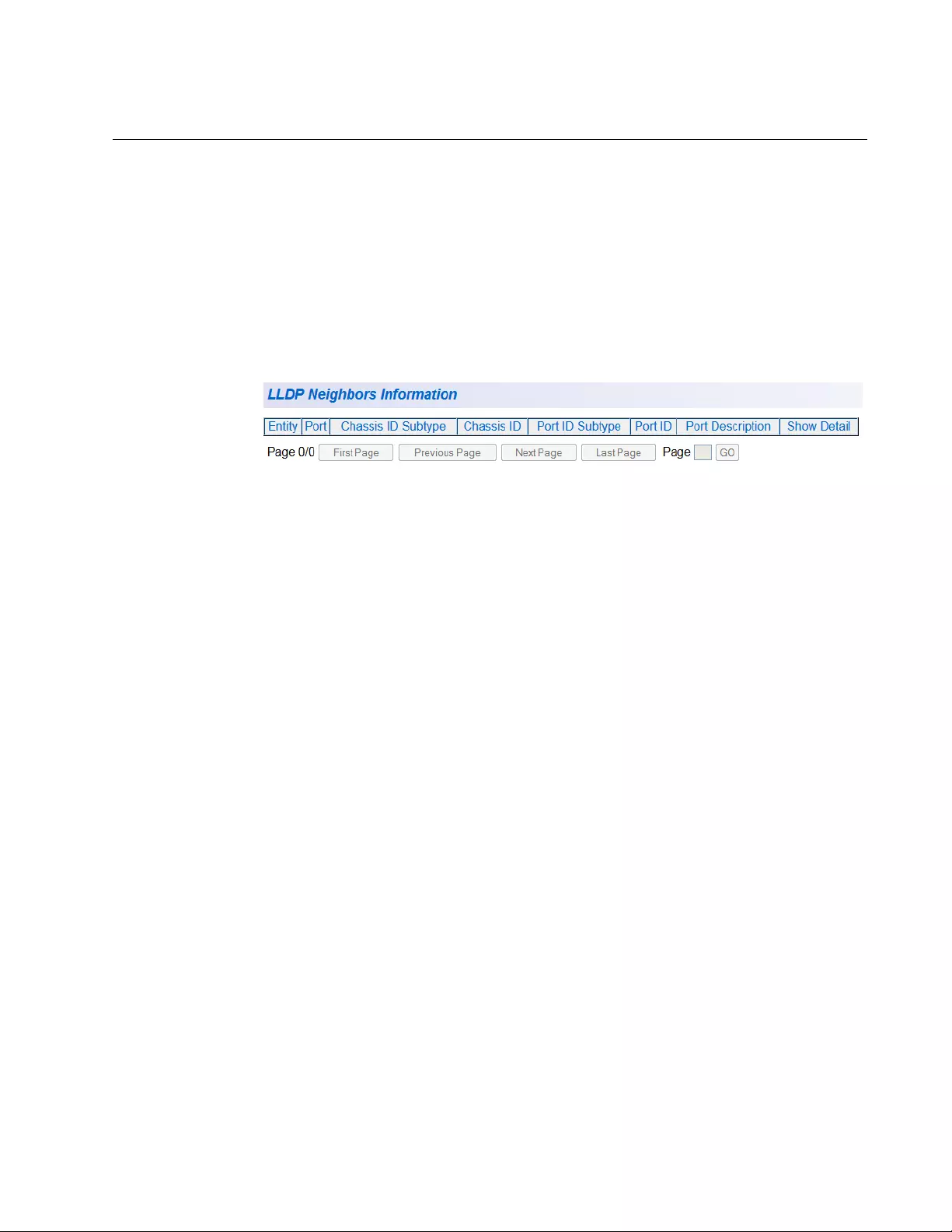Table of Contents
- Preface
- Section I
- Getting Started
- Chapter 1
- Chapter 2
- System Configuration
- System Management Information
- Configuration of IPv4 Address, Subnet Mask and Gateway Address
- IPv6 System Configuration
- IPv6 Neighbor Configuration
- IP Access List Configuration
- User Name and Password Configuration
- User Interface Configuration
- System Time
- SSL Settings
- DHCP and ATI Web Discovery Tool
- DHCP Client Configuration
- DHCP Auto Configuration
- System Information Display
- System Log Configuration
- System Configuration
- Getting Started
- Section II
- Section III
- Section IV
- Appendix A
- Appendix B
Allied Telesis AT-FS750/52-10 User Manual
Displayed below is the user manual for AT-FS750/52-10 by Allied Telesis which is a product in the Network Switches category. This manual has pages.
Related Manuals

613-002110 Rev. A
FS750 Series
FAST ETHERNET WEBSMART SWITCHES
AT-FS750/20
AT-FS750/28
AT-FS750/28PS
AT-FS750/52
Web Interface User’s Guide

Copyright 2015 Allied Telesis, Inc.
All rights reserved. No part of this publication may be reproduced without prior written permission from Allied Telesis, Inc.
Microsoft and Internet Explorer are registered trademarks of Microsoft Corporation. Netscape Navigator is a registered
trademark of Netscape Communications Corporati on. All oth er product names, company names, logos or other
designations mentioned herein are trademarks or registered trademarks of their respective owners.
Allied Telesis, Inc. reserves the right to make changes in specifications and other informa t ion contained in this document
without prior written notice. The information provided herein is subject to change without notice. In no event shal l Allied
Telesis, Inc. be liable for any incidental, special, indirect, or consequential damages whatsoever, including but not limited to
lost profits, arising out of or related to this manual or the information contained herein, even if Allied Telesis, Inc. has be en
advised of, known, or should have known, the possibility of such damages.

1
Contents
Preface ................................................................................................................................................15
Document Conventions.............................................................................................................................. 16
Allied Telesis Contact Information.............................................................................................................. 17
Section I: Getting Started ..............................................................................................................19
Chapter 1: Starting a Web Browser Session ............................................................................................ 21
Establishing a Remote Connection to the Web Browser Interface ............... ................. ... ... ... ... .... ... ... ... ... 22
Web Browser Tools.................... ... ... ... ................ .... ... ... ... .... ... ... ... .... ... ................ ... ... .... ... ......................... 25
Quitting a Web Browser Management Session ......................................................................................... 26
Chapter 2: System Configuration .............................................................................................................. 27
System Management Information .............................................................................................................. 28
Configuration of IPv4 Address, Subnet Mask and Gateway Address............... ... ... ... .... ... ... ... ... .... ... ... ... ... 30
IPv6 System Configuration......................................................................................................................... 32
IPv6 Neighbor Configuration...................................................................................................................... 34
Create an IPv6 Neighbor List .............................................................................................................. 34
Delete an IPv6 Neighbor Entry............................................................................................................ 35
Find an IPv6 Neighbor......................................................................................................................... 36
IP Access List Configuration ................... ... ... ... ... .... ... ... ... .... ................ ... ... ... .... ... ... ... .... ... ... ...................... 39
Create an IP Access List ..................................................................................................................... 39
Delete an IP Address List Entry........................................................................................................... 40
User Name and Password Configuration................................................................................................... 42
Add New User Name and Password ................................................................................................... 42
Modify User Name and Password....................... ... ............................................................................. 43
Delete User Name and Password ................ .... ... ... ... .... ... ... ... .................... ................... ... ................... 44
User Interface Configuration ......... ... ... ....................................................................................................... 46
SNMP Interface ................................................................................................................................... 46
User Interface Timeout........ ... ... ... .... ... ... ... ... .... ... ... ... .... ... ................... ... .................... ......................... 47
Group Interval...................................................................................................................................... 48
System Time .... ... ... ... .... ... ... ... .... ................ ... ... ... .... ... ... ... ................. ... ... ... ... .... ... ... ................................... 49
Manually Setting System Time..................... .... ... ... ... .... ... ... ... .... ... ................... ... .................... ............ 49
Setting SNTP................... .... ... ... ... .... ... ... ................ ... .... ... ... ... .... ... ... ... ................ .... ... ... ...................... 50
Setting Daylight Savings Parameters.................. ................................................................................ 52
SSL Settings .............................................................................................................................................. 53
Configuring SSL .................................................................................................................................. 53
DHCP and ATI Web Discovery Tool .......................................................................................................... 55
DHCP Client Configuration ........................................................................................................................ 56
Guidelines............................................................................................................................................ 56
Activate or Deactivate DCHP for IPv4................................................................................................. 56
Activate or Deactivate DCHP for IPv6................................................................................................. 57
DHCP Auto Configuration .......................................................................................................................... 59
System Information Display ............. ... .... ... ... ... ... .... ................................................................................... 61
System Log Configuration................ ... .... ... ... ... ... .... ... ... ............................................................................. 64

Contents
2
Section II: Bridge Configuration ..................................................................................................67
Chapter 3: Port Configuration .....................................................................................................................69
Overview.....................................................................................................................................................70
Displaying and Configuring Ports . .... ... ... ... .... ... ... ... ... .... ... ... ... .... ... ... ... .... ... ... ................... .... ... ...................71
Chapter 4: STP and RSTP ...........................................................................................................................75
Overview.....................................................................................................................................................76
Bridge Priority and the Root Bridge......................................................................................................77
Forwarding Delay and Topology Changes...........................................................................................79
Mixed STP and RSTP Networks..........................................................................................................81
Spanning Tree and VLANs ..................................................................................................................82
STP and RSTP Global Settings..................................................................................................................84
STP and RSTP Port Settings .....................................................................................................................87
Chapter 5: Multiple Spanning Tree Protocol .............................................................................................91
MSTP Global Settings ................................................................................................................................92
Generic MSTP Port Settings ......................................................................................................................95
MST Settings....... ... ... ... ... ................. ... ... ... .... ... ... ... ................ .... ... ... ... .... ... ... ................ .............................98
Open MST Settings Page ....................................................................................................................98
Specify Region and Revision Level......................................................................................................98
Create VLAN Mapping to MST Instance..............................................................................................99
Modify MST Instance ................. ... ................ ... ... .... ... ... ... .... ................ ... ... ... .... ... ... ... ........................100
Delete MST Instance. .... ... ... ... .... ................ ... ... ... .... ... ... ... .... ... ................ ... ... .... ... ... ... .... ... .................100
MST Port Settings ........ ... .... ................ ... ... .... ... ... ... ... ................. ... ... ... .... ... ... ... ... .....................................101
Instance Information......................... ... ... ... .... ... ... ... ... .... ... ... ... .... ................................ ... ... ........................103
Chapter 6: Static Port Trunking ................................................................................................................105
Overview...................................................................................................................................................106
General Guidelines ... .... ... ... ... .... ................ ... ... ... .... ... ... ... .... ... ................ ... ... .... ... ... ... .... ... .................107
Create a Port Trunk..................................................................................................................................109
Modify a Port Trunk ... ... ... .... ... ... ... .... ................ ... ... ... .... ... ... ... .... ... ................ ... ... .... ... ... ... ........................111
Disable a Port Trunk.................................................................................................................................113
Chapter 7: LACP Port Trunks ...................................................................................................................115
Overview...................................................................................................................................................116
System Priority .........................................................................................................................................117
Port Priority Value............ .... ... ................ ... .... ... ... ... ... .... ... ... ................ .... ... ... ... ... .... ... ... ...........................118
General Guidelines for LACP ........................ ...........................................................................................119
Displaying Group Status...........................................................................................................................121
LSCP Configuration Example...................................................................................................................122
Port Priority Configuration ......... ... .... ... ... ..................................................................................................124
Chapter 8: Port Mirroring ..........................................................................................................................127
Overview...................................................................................................................................................128
Port Mirroring Configuration ......... .... ... ... ... .... ... ... ... ... .... ... ... ... .... ... ... ... .................... .................................129
Disable Port Mirroring...............................................................................................................................131
Chapter 9: Loopback Protection ...............................................................................................................133
Loopback Configuration............................................................................................................................134
Status of Loopback Detection...................................................................................................................137
Chapter 10: MAC Address Table ..............................................................................................................139
Overview...................................................................................................................................................140
Static Unicast MAC Address Configuration ..............................................................................................142
Modify Static Unicast Address... ................................................. ... ... ... .... ... ... ... ... .... ... ... ... .... ....................145

AT-FS970M Switch Command Line User’s Guide
3
Delete Static Unicast Address.................................................................................................................. 147
Static Multicast Address Configuration ...................... ... ... .... ... ................... ... .... ... ................... ... .............. 148
Modify Static Multicast Address .... ... ... .... ... ... ... ... .... ... ... ... .... ... ... ... .................... ................... ... ................. 151
Delete Static Multicast Address ............................................................................................................... 153
Chapter 11: IGMP Snooping ..................................................................................................................... 155
Overview .................................................................................................................................................. 156
IGMP Snooping Configuration ................................................................................................................. 158
IGMP Snooping Router Port Modification ................................................................................................ 161
Chapter 12: Storm Control ....................................................................................................................... 163
Overview .................................................................................................................................................. 164
Ingress Rate Limiting......................................................................................................................... 165
Egress Rate Limiting ......................................................................................................................... 165
Configuration............................................................................................................................................ 166
Ingress Rate Limiting ............................................................................................................................... 169
Egress Rate Limiting..... ... ... ... .... ... ... ........................................................................................................ 171
Chapter 13: Virtual LANs .......................................................................................................................... 173
VLAN Overview........................................................................................................................................ 174
Port-based VLAN Overview............................................................................................................... 175
Tagged VLAN Overview .................................................................................................................... 176
Private VLAN Overview ............. ... .... ... ... ................ ... .... ... ... ... .... ... ... ... ................ .... ... ... ... ... .............. 178
Assign Ports to a VLAN Mode.................................................................................................................. 180
Tagged VLAN Configuration .................................................................................................................... 182
Create a Tagged VLAN ..................................................................................................................... 183
Modify a Tagged VLAN .......... ... ... .... ... ................ ... ... .... ... ... ... .... ... ... ... ... .... ... .................................... 185
Delete a Tagged VLAN.... .... ... ... ... .... ... ................ ... ... .... ... ... ... .... ... ... ... ................ .... ... ... ... ... .............. 187
Tagged VLAN Port Settings..................................................................................................................... 188
Port-Based VLAN Configuration .............................................................................................................. 190
Create a Port-Based VLAN ............................................................................................................... 190
Modify a Port-Based VLAN..... ... ... .... ... ... ... ... .... ... .............................................................................. 191
Delete a Port-Based VLAN................................................................................................................ 192
Select MAC Address Forwarding Table Mode......................................................................................... 194
View Dynamic Forwarding Table ............................................................................................................. 196
Private VLAN Configuration ....................... ... ... ... .... ... ... ... .... ... ................ ... ... .... ... ... ... .... ... ... .................... 198
Enable or Disable Private VLAN....................... ... ................ ... .... ... ... ... ... .... ... ... ................ ... .... .......... 198
Create a Private VLAN ...................................................................................................................... 199
Modify a Private VLAN .... .... ... ................................................................ .... ... ... ... .... ... ... ... ... .............. 200
Delete a Private VLAN....................................................................................................................... 201
View Current VLAN Database.................................................................................................................. 202
Chapter 14: GVRP ..................................................................................................................................... 205
Overview and Guidelines ......................................................................................................................... 206
General Configuration......... ... .... .............................................................................................................. 207
Port Settings........ ................ ... .... ... ... ... .... ... ................ ... ... .... ... ... ... .... ................ ... ... ... .............................. 208
Time Settings ........................................................................................................................................... 210
Chapter 15: Quality of Service and Class of Service ............................................................................. 213
Overview .................................................................................................................................................. 214
Packet Priority ................................................................................................................................... 214
Egress Queue vs Packet Priority Mapping ........................................................................................ 215
Prioritizing Untagged Packets ................... ... .... ................... ... .................... ................... ... ................. 216
Scheduling......................................................................................................................................... 216
Mapping CoS Priorities to Egress Queues............................................................................................... 218
Associate Ports to CoS Priorities ............................................................................................................. 220

Contents
4
Associate DSCP Classes to Egress Queues ...........................................................................................222
Queue Scheduling Algorithm....................................................................................................................224
IPv6 Traffic Class Mapping.......................................................................................................................226
Enable or Disable IPv6 Traffic Class Mapping...................................................................................226
Create IPv6 Traffic Class Entries.. ... ... .... ................ ... ... ... .... ... ... ... ................ .... ... ... ... .... ... ... ..............227
Delete an IPv6 Traffic Class Entry ... ... .... ... ... ... ... .... ... ... ... .... ... ...........................................................228
Section III: Advanced Features .................................................................................................. 229
Chapter 17: SNMPv1 and v2c ...................................................................................................................231
SNMPv1 and SNMPv2c Overview ...........................................................................................................232
Trap Receiver Attributes............... ................. ... ... ... ... .... ... ... ................ .... ... ... ... ... .... ... ..............................233
Activate SNMP Interface ..... ................ ... ... .... ... ... ... ... .... ... ... ................ .... ... ... ... ... .... ... ... ... ........................234
SNMPv1 and SNMPv2c User and Group Names ....................................................................................235
Create User and Group Names .........................................................................................................235
Modify User and Group Names............... ... ... ... ... .... ... ... ... .... ... ... ... .... ... ... ... .................... ... ... ... ...........237
Delete User and Group Names.................. ... ... ... .... ... ... ... .... ... ... ........................................................237
SNMP Community Strings........................................................................................................................238
Create SNMP Community Strings......................................................................................................238
Modify SNMP Community Strings......................................................................................................239
Delete SNMP Community Strings....... .... ... ... ... ... .................... ................... ... .................... .................239
SNMP Traps.............................................................................................................................................241
Create Trap Host Table Entry ............................................................................................................241
Modify a Trap Host Table Entry .........................................................................................................243
Delete a Trap Host Table Entry..........................................................................................................243
Chapter 18: SNMPv3 ..................................................................................................................................245
Overview...................................................................................................................................................246
SNMPv3 Authentication Protocols .....................................................................................................246
SNMPv3 Privacy Protocol..................................................................................................................247
SNMPv3 MIB Views...........................................................................................................................247
SNMPv3 Configuration Process.........................................................................................................248
SNMPv3 User and Group Names ............................................................................................................250
Creating SNMPv3 User and Group Names .......................................................................................250
Modifying SNMPv3 User and Group Names......................................................................................252
Deleting SNMPv3 User and Group Names........................................................................................252
SNMPv3 View Names ..............................................................................................................................253
Creating SNMPv3 View Names .........................................................................................................253
Modifying SNMPv3 View Names .......................................................................................................255
Deleting SNMPv3 View Names..........................................................................................................255
SNMPv3 View Table.................................................................................................................................256
Creating SNMPv3 View Table Entries ...............................................................................................256
Modifying SNMPv3 View Table Entries..............................................................................................257
Deleting SNMPv3 View Table Entries................................................................................................258
SNMPv3 Traps .........................................................................................................................................259
SNMP Engine ID ......................................................................................................................................260
Modifying SNMP Engine ID................................................................................................................260
Resetting SNMP Engine ID................................................................................................................261
Chapter 19: Access Control Configuration .............................................................................................263
Overview...................................................................................................................................................264
Policy Settings..........................................................................................................................................265
Create a Policy...................................................................................................................................265
Change a Policy Status......................................................................................................................269
Modify a Policy.... ... ... .... ... ... ... ................. ... ... ... ... .... ... ... ................ .... ... ... ... ... .... ... ..............................270

AT-FS970M Switch Command Line User’s Guide
5
Delete a Policy. ... .... ... ... ... .... ... ................ ... ... .... ... ... ... .... ................ ... ... ... .... ... ... ... .............................. 272
View Specific Classifier Details .... .... ... ...... ........................................................................................ 272
Rate Control Settings............................................................................................................................... 274
Create a Rate Control Entry .............................................................................................................. 274
Modify the Committed Rate.................... ... ... .... ... .............................................................................. 275
Delete a Rate Control Entry. ... ... ... ................ .... ... ... ... .... ... ... ... .... ... ................ ... ... .... ... ... ... ... .............. 277
Policy Database ....................................................................................................................................... 278
Display Policy Sequence................................................................................................................... 278
Display Specific Policy Information.................................................................................................... 279
Chapter 20: RMON ..................................................................................................................................... 281
Overview .................................................................................................................................................. 282
Enable and Disable RMON........ ... ... ... .... ... ... ... ... .... ... ... ................ .... ... ... ... ... .... ... ... ... .... ... ... ... ................. 283
Port Statistics ......... ... .... ... ... ................ .... ... ... ... ... .... ... ................ ... .... ... ... ... ... .... ....................................... 285
Histories ................................................................................................................................................... 287
Events ...................................................................................................................................................... 289
Alarms...................................................................................................................................................... 291
Configure RMON Alarms................................................................................................................... 291
Chapter 21: Voice VLAN ........................................................................................................................... 295
Overview .................................................................................................................................................. 296
CoS with Voice VLAN............. ... ... .... ... ... ... ... .... ................ ... ... .... ... ... ... ... .... ... ................ ... ... .............. 296
Organization Unique Identifier (OUI) ............ .... ... ... .................... ................... ... ................... .............. 296
Dynamic Auto-Detection vs Static Ports............................................................................................ 297
General Guidelines ... .... ... ... ... .... ................ ... ... ... .... ... ... ... .... ... ................ ... ... .... ... ... ... .... ... ....................... 299
Configuration............................................................................................................................................ 300
OUI Setting............................................................................................................................................... 303
Create OUI Setting ............................................................................................................................ 303
Modify OUI Setting . ... ... ... ................. ... ... ... ... .... ... ... ................ .... ... ... ... ... .... ... ................ ... ................. 304
Delete OUI Setting..... ... ... .... ... ................ ... ... .... ... ... ... .... ... ... ... ................ .... ... ... ... .... ... ... ... ................. 304
Chapter 22: Security ................................................................................................................................. 307
Port Access Control .. .... ... ... ... .... ... ... ... ..................................................................................................... 308
Port Access Control Overview........................................................................................................... 308
Port Access Control Configuration .................................................................................................... 309
RADIUS Client ......................................................................................................................................... 314
RADIUS Overview ............... ... ................ ... ... .... ... ... ... .... ................ ... ... ... .... ... ... ... ................ .............. 314
General Guidelines. ... ................ ... .... ... ... ... ... .... ... ... ................ .... ... ... ... ... .... ... ... ... .... .......................... 314
RADIUS Client Configuration ............................................................................................................ 315
RADIUS Accounting Status............................................................................................................... 316
TACACS+ ................................................................................................................................................ 318
TACACS+ Overview.......................................................................................................................... 318
General Guidelines. ... ................ ... .... ... ... ... ... .... ... ... ................ .... ... ... ... ... .... ... ... ... .... .......................... 318
TACACS+ Configuration.................................................................................................................... 319
Dial-in User— Local Authentication ......................................................................................................... 321
Dial-In User Overview........................................................................................................................ 321
Dial-in User Configuration ................................................................................................................. 321
Destination MAC Filter ............................................................................................................................. 325
Destination MAC Filter Overview....................................................................................................... 325
Destination MAC Filter Configuration ................................................................................................ 325
Delete Destination MAC Filter ...... .... ... ................................................ ... .... ... ... ... .... ... ... ... ... .... .......... 327
Chapter 23: Power Over Ethernet (PoE) .................................................................................................. 329
Overview .................................................................................................................................................. 330
Power Sourcing Equipment (PSE) .................................................................................................... 330
Powered Device (PD) ........................................................................................................................ 330

Contents
6
PD Classes ... ... ... ................ ... .... ... ... ... .... ... ................ ... ... .... ... ... ... .... ................ ... ... ... .... ....................330
Power Budget.....................................................................................................................................330
Port Prioritization........... ................ ... ... .... ... ... ... ... ................. ... ... ... .... ... ... ... ... .....................................331
PoE Configuration ....................................................................................................................................332
Chapter 24: DHCP Snooping ....................................................................................................................335
Overview...................................................................................................................................................336
Trusted Ports......................................................................................................................................336
Untrusted Ports ..................................................................................................................................336
Unauthorized DHCP Servers .............................................................................................................336
DHCP with Option 82................. ... ... ... .... ... ................ ... ... .... ... ... ... .... ................ ... ... ... .... ... ... ..............337
General Guidelines....... ... .... ................ ... ... .... ... ... ... ... .... ... ................ ... .... ... ... ... ... .... ... ... ... ........................338
General Configuration ............ ... ... .... ... ... ... .... ... ... ... ... ...............................................................................339
Enabling DHCP Snooping..................................................................................................................339
Configuring DHCP Snooping General Settings..................................................................................340
VLAN Setting............................................................................................................................................342
Creating a VLAN ........... ... ... ... .... ... ................ ... ... .... ... ... ... .... ................ ... ... ... .... ... ... ... ........................342
Modifying a VLAN ..............................................................................................................................343
Deleting a VLAN.................................................................................................................................343
Trusted and Untrusted Port Configuration................................................................................................344
Binding Database ......................... ................. ... ... ... ... .... ... ... ... .... ................ ... ... ... .... ... ... ... ........................346
Static IP Addresses.................... ... ... ................ ... .... ... ... ... .... ... ... ... ................ .... ... ... ... .... ... .................346
Viewing...............................................................................................................................................347
Chapter 25: LLDP .......................................................................................................................................349
Overview...................................................................................................................................................350
Global Configuration........ .... ... ... ... .... ... ... ... ...............................................................................................351
Enabling or Disabling LLDP ...............................................................................................................352
Displaying System Information...........................................................................................................353
Setting Port States ........... ... ... .... ... ... ... .... ... ................ ... ... .... ... ... ... .... ... ... ................ ... .... ....................353
Neighbors Information ..............................................................................................................................355
Chapter 26: Network Statistics .................................................................................................................357
Overview...................................................................................................................................................358
Traffic Comparison Statistics....................................................................................................................359
Error Group Statistics ...............................................................................................................................363
Historical Status Statistics ........................................................................................................................365
Section IV: Tools ..........................................................................................................................369
Chapter 27: Software/Configuration Updates .........................................................................................371
Overview...................................................................................................................................................372
Upgrade Firmware Image via HTTP.........................................................................................................373
Upgrade Firmware Image via TFTP .........................................................................................................375
Download or Upload a Configuration File via HTTP.................................................................................377
Save a Configuration File onto Your PC Via HTTP....... ... .... ... ................ ... ... .... ... ... ... .... ................ ... .377
Upload a Configuration File to the Switch Via HTTP .........................................................................379
Download or Upload a Configuration File via TFTP .................................................................................381
Download a Configuration File onto a TFTP Server .. ... ... .... ... ... ... .... ................ ... ... ... .... ... ... ... ... .... ....381
Upload a Configuration File onto the Switch Via a TFTP Server .......................................................382
Chapter 28: Cable Diagnostics .................................................................................................................385
Chapter 29: LED ECO Mode ......................................................................................................................387
Enable LED ECO Mode............................................................................................................................388

AT-FS970M Switch Command Line User’s Guide
7
Disable LED ECO Mode .......................................................................................................................... 389
Chapter 30: Energy-Efficient Ethernet .................................................................................................... 391
Enable EEE................................... ... ... .... ... ... ... ... ................. ... ... ... .... ... ... ... ................ .... .......................... 392
Disable EEE........ ... ... .... ... ... ... ................. ... ... ... ... .... ... ... ... .... ................ ... ... ... .... ... ... ... .... .......................... 393
Chapter 31: Rebooting the Switch ........................................................................................................... 395
Reboot the Switch.................................................................................................................................... 396
Configure Factory Default Values ............................................................................................................ 398
Disable Resetting the Switch with the Protection Password.................................................................... 400
Disabling Factory Default Reset Feature........................................................................................... 400
Enabling Factory Default Reset......................................................................................................... 402
Chapter 32: Pinging a Remote System ................................................................................................... 405
Appendix A: MSTP Overview ..................................................................................................................... 407
Overview .................................................................................................................................................. 408
Multiple Spanning Tree Instance (MSTI).................................................................................................. 409
Resolving VLAN Fragmentation ........................................................................................................ 409
Multiple VLANs Assigned to an MSTI................................................................................................ 410
General Guidelines ... .... ... ... ... .... ................ ... ... ... .... ... ... ... .... ... ................ ... ... .... ... ... ... .... ... ....................... 412
VLAN and MSTI Associations.................................................................................................................. 413
Ports in Multiple MSTIs ............................................................................................................................ 414
Multiple Spanning Tree Regions.............................................................................................................. 415
MST Region Guidelines.......... ... ... .... ... ... ... ... .... ... .............................................................................. 417
Common and Internal Spanning Tree (CIST).................................................................................... 417
MSTP with STP and RSTP................................................................................................................ 418
Associating VLANs to MSTIs ........... ................................................. ... ... ... ... .... ... ... ... .... ... ... ... ................. 419
VLANs Across Different Regions ............................................................................................................. 421
Summary of Guidelines................. ... ... .... ... ... ... ... .... ... ... ... ........................................................................ 423
Appendix B: AT-FS750 Default Parameters .............................................................................................. 425

Contents
8

9
Figure 1. Entering a Switch’s IP Address in the URL Field................................................................................................ 22
Figure 2. Entering a Switch’s IP Address in the URL Field................................................................................................ 22
Figure 3. Switch Information Page..................................................................................................................................... 23
Figure 4. The AT-FS750/28 Front Panel Page.................................................................................................................. 24
Figure 5. Management Page ............................................................................................................................................. 28
Figure 6. IPv4 Setup Page ................................................................................................................................................ 30
Figure 7. IPv6 System Settings Page................................................................................................................................ 32
Figure 8. IPv6 Neighbor Settings Page ............................................................................................................................. 34
Figure 9. IPv6 Neighbor Settings Page with Addresses.................................................................................................... 35
Figure 10. Example Search with Neighb or IPv6 Address.................................................................................................. 37
Figure 11. Example Search with Link Layer MAC Address............................................................................................... 37
Figure 12. Example Search with Both Addresses ............................................................................................................. 37
Figure 13. IP Access List Page ......................................................................................................................................... 39
Figure 14. Administration Page ......................................................................................................................................... 42
Figure 15. Administration Page Example .......................................................................................................................... 43
Figure 16. Modify Administration Page.............................................................................................................................. 44
Figure 17. User Interface Page ......................................................................................................................................... 46
Figure 18. System Time Page........................................................................................................................................... 49
Figure 19. SSL Settings Page ........................................................................................................................................... 53
Figure 20. DHCP Auto Configuration Settings Page......................................................................................................... 59
Figure 21. Switch Information Page................................................................................................................................... 61
Figure 22. System Log Configuration Page....................................................................................................................... 64
Figure 23. AT-FS750/28 Physical Interface Page ............................................................................................................. 71
Figure 24. Point-to-Point Ports .......................................................................................................................................... 81
Figure 25. Edge Port ......................................................................................................................................................... 81
Figure 26. STP and VLAN Fragmentation with Untagged Ports........................................................................................ 82
Figure 27. STP and VLAN Compatibility with Tagged Ports.............................................................................................. 83
Figure 28. Spanning T re e Protocol Settings Page ............................................................................................................ 84
Figure 29. Port Settings Page ........................................................................................................................................... 87
Figure 30. Spanning Tre e Protocol Settings Page ............................................................................................................ 92
Figure 31. Port Settings Page ........................................................................................................................................... 95
Figure 32. MST Settings Page .......................................................................................................................................... 98
Figure 33. MST Port Settings Page................................................................................................................................. 101
Figure 34. Instance Information Page ............................................................................................................................. 103
Figure 35. Static Port Trunk Example.............................................................................................................................. 106
Figure 36. Trunking Page................................................................................................................................................ 109
Figure 37. LACP Group Status Page .............................................................................................................................. 121
Figure 38. LACP Group Status Page with No Cables Connected................................................................................... 122
Figure 39. LACP Group Status Page with Three Cables Connected.............................................................................. 123
Figure 40. AT-FS750 Port Priority Page.......................................................................................................................... 124
Figure 41. AT-FS750 Mirroring Page............................................................................................................................... 129
Figure 42. AT-FS750 Loopback Detection Page............................................................................................................. 134
Figure 43. AT-FS750 Static Unicast Address Table Page............................................................................................... 142
Figure 44. Static Unicast Address Table with a Tagged VLAN Example ........................................................................ 143
Figure 45. Modify Static Unicast Address Page .............................................................................................................. 145
Figure 46. Static Multicast Address Table Page.............................................................................................................. 148
Figure 47. Static Multicast Address Table Example ........................................................................................................ 149
Figure 48. Modify Static Multicast Address Page ............................................................................................................ 151
Figure 49. IGMP Snooping Settings Page....................................................................................................................... 158
Figure 50. IGMP Snooping Page with MAC Address ...................................................................................................... 160
List of Figures

Figures
10
Figure 51. IGMP Snooping Router Port Page.................................................................................................................. 161
Figure 52. Modify IGS Static Router Port Page.................................................. ... .......................................................... 161
Figure 53. AT-FS750 Storm Control Page....................................................................................................................... 166
Figure 54. AT-FS750 Ingress Rate Limiting Page ........................................................................................................... 169
Figure 55. AT-FS750 Egress Rate Limiting Page............................................................................................................ 171
Figure 56. AT-FS750/28 VLAN Mode Page..................................................................................................................... 180
Figure 57. AT-FS750/28 Tagged VLAN Page ................................................................................................................. 183
Figure 58. AT-FS750 Modify VL AN Page........................................................................................................................ 185
Figure 59. AT-FS750 VLAN Port Settings Page.............................................................................................................. 188
Figure 60. Port-Based VLAN Page..................... ................................................... ... .. ..................................................... 190
Figure 61. Modify Port-Based VLAN Page ...................................................................................................................... 192
Figure 62. Forwarding Table Mode Page ........................................................................................................................ 194
Figure 63. Dynamic Forwarding Table Page ................................................................................................................... 196
Figure 64. Private VLAN Page........................................ .. ... ......................... ... ................................................................ 198
Figure 65. VLAN Current Database Page........................................................................................................................ 202
Figure 66. GVRP Global Settings Page........................................................................................................................... 207
Figure 67. GVRP Port Settings Page............................................................................................................................... 208
Figure 68. AT-FS750 GVRP Time Settings Page............................................................................................................ 210
Figure 69. CoS Page ....................................................................................................................................................... 218
Figure 70. AT-FS750 Port Priority Page .......................................................................................................................... 220
Figure 71. DSCP Class Mapping Page............... ...................................................... ....................................................... 222
Figure 72. Scheduling Algorithm Pa ge ............................................................................................................................ 224
Figure 73. IPv6 Traffic Class Priority Settings Page........................................................................................................ 226
Figure 74. IPv6 Traffic Class Priority Sett ings Page with Entries .................................................................................... 227
Figure 75. SNMP User/Group Page ................................................................................................................................ 235
Figure 76. Community Table Page .................................................................................................................................. 238
Figure 77. Trap Management Page................................................................................................................................. 241
Figure 78. Trap Management Page Example.................................................................................................................. 242
Figure 79. MIB Tree......................................................................................................................................................... 247
Figure 80. SNMPv3 Table Relationships......................................................................................................................... 249
Figure 81. SNMP User Group, SNMPv3 Example........................................................................................................... 251
Figure 82. SNMP Group Access Table............................................................................................................................ 253
Figure 83. SNMP View Table........................................................................................................................................... 256
Figure 84. SNMP View Table Page Example .................................................................................................................. 257
Figure 85. SNMP Engine ID Settings............................................................................................................................... 260
Figure 86. Policy Settings Page....................................................................................................................................... 265
Figure 87. IPv4 Policy Settings Page............................................................................................................................... 266
Figure 88. IPv6 Policy Settings Page............................................................................................................................... 266
Figure 89. Policy Settings Example ................................................................................................................................. 269
Figure 90. Modify Policy Page......................................................................................................................................... 271
Figure 91. Classifier Detail Page ..................................................................................................................................... 273
Figure 92. Rate Control Settings Page............................................................................................................................ 274
Figure 93. Rate Control Settings Example............. .......................................................................................................... 275
Figure 94. Policy Database Page .................................................................................................................................... 278
Figure 95. Policy Detail Page........................................................................................................................................... 279
Figure 96. RMON Basic Settings Page............................................................................................................................ 283
Figure 97. Ethernet Statistics Settings Page ....................... ... ... ............................ .......................................................... 285
Figure 98. Ethernet Statistics Configuration Example ...... ... ............................ ... ............................ ... .............................. 286
Figure 99. History Control Settings Page......................................................................................................................... 287
Figure 100. History Control Configuration Example ......................................................................................................... 288
Figure 101. RMON Event Settings Page......................................................................................................................... 289
Figure 102. RMON Event Configuration Example........................................................................................................... 290
Figure 103. RMON Alarm Settings Page......................................................................................................................... 292
Figure 104. RMON Alarm Configuration Example........................................................................................................... 293
Figure 105. AT-FS750 Voice VLAN Settings Page.......................................................................................................... 300
Figure 106. Voice VLAN OUI Settings Page.................................................................................................................... 303
Figure 107. Port Access Control Settings Page............................................................................................................... 309
Figure 108. Expanded Port Access Control Settings Page ............................................................................................. 310
Figure 109. RADIUS Page............................................................................................................................................... 315
Figure 110. RADIUS Accounting Global Settings Page................................................................................................... 316

FS750 Series Fast Ethernet WebSmart User’s Guide
11
Figure 111. TACACS+ Page ........................................................................................................................................... 319
Figure 112. Dial-In User Page ......................................................................................................................................... 322
Figure 113. Dial-In User Page Example .......................................................................................................................... 322
Figure 114. Destination MAC Filter Page ........................................................................................................................ 326
Figure 115. Destination MAC Filter Page Exampl e ......................................................................................................... 326
Figure 116. Power Over Ethernet Example..................................................................................................................... 332
Figure 117. General Settings Page ................................................................................................................................. 339
Figure 118. DHCP Snooping VLAN Settings Page ......................................................................................................... 342
Figure 119. AT-FS750 Trusted Interfaces Page.............................................................................................................. 344
Figure 120. AT-FS750 Binding Database Page .............................................................................................................. 346
Figure 121. Binding Database Page Example................................................................................................................. 347
Figure 122. AT-FS750 LLDP Global Settings Page ........................................................................................................ 351
Figure 123. LLDP Neighbors Information Page.... ... ......................... ......................... ......................... ............................. 355
Figure 124. Traffic Comparison Chart Page.................................................................................................................... 359
Figure 125. Traffic Comparison Page Example............................................................................................................... 362
Figure 126. Error Group Chart Page ............................................................................................................................... 363
Figure 127. Historical Status Chart Page ........................................................................................................................ 365
Figure 128. Historical Statistics Page Example............................................................................................................... 367
Figure 129. Firmware Upgrade via HTTP Page .............................................................................................................. 374
Figure 130. Firmware Upgrade via TFTP Page............................................................................................................... 376
Figure 131. Configuration File Backup/Restore via HTTP Page ................. ......................... ... ........................................ 377
Figure 132. Save Configuration File Message....................... ......................... ... ......................... ... .................................. 378
Figure 133. Download Complete Message...................................................................................................................... 378
Figure 134. Select File Field with Path Location.............................................................................................................. 379
Figure 135. Configuration File Restore Finished Message.............................................................................................. 380
Figure 136. Configuration Backup/Restore via TFTP Page............................................................................................. 381
Figure 137. Cable Diagnostics Page............................................................................................................................... 385
Figure 138. LED ECO Mode Page .................................................................................................................................. 388
Figure 139. LED ECO Mode in Enabled State ................................................................................................................ 389
Figure 140. IEEE 802.3az EEE Page.............................................................................................................................. 392
Figure 141. Factory Default Reset/Reboot Page............................................................................................................. 396
Figure 142. Factory Default Reset/Reboot Page with Password Entry........................................................................... 401
Figure 143. Factory Default Rese t Disabled Page .......................................................................................................... 402
Figure 144. Factory Default Reset/Reboot Page with Password Entry........................................................................... 403
Figure 145. Ping Test Settings Page............................................................................................................................... 405
Figure 146. Ping Test Resu lts Page................................................................................................................................ 406
Figure 147. VLAN Fragmentation with STP or RSTP...................................................................................................... 409
Figure 148. MSTP Example of Two Spa nning Tree Instances........................................................................................ 410
Figure 149. Multiple VLANs in an MSTI........................................................................................................................... 410
Figure 150. CIST and VLAN Guideline - Example 1........................................................................................................ 419
Figure 151. CIST and VLAN Guideline - Example 2........................................................................................................ 420
Figure 152. Spanning Regions - Example 1.................................................................................................................... 421
Figure 153. Spanning Regions without Blocking ............................................................................................................. 422

Figures
12

13
List of Tables
Table 1. Web Management Software per Model ................................................................................................................15
Table 2. Valid Port Priority Values ......................................................................................................................................79
Table 3. Default Mappings Priority Levels to Priority Queues ..........................................................................................215
Table 4. Customized Mappings Priority Levels to Priority Queues ...................................................................................215
Table 5. Example of Weighted Round Robin Priority .......................................................................................................217
Table 6. IEEE Powered Device Classes ...........................................................................................................................330
Table 7. PoE Port Priorities ..............................................................................................................................................331
Table 8. Traffic Comp arison Options ................................................................................................................................360
Table 9. Historical Status Options ....................................................................................................................................366
Table 10. MSTP Region ...................................................................................................................................................416
Table 11. Regional Bridge Priority Value Increments .......................................................................................................417
Table 12. Region VLAN Example .....................................................................................................................................422
Table 13. Management Software Default Settings ..........................................................................................................425

List of Tables
14

15
Preface
This guide contains instructions on how to use the Web Interface
Management Software to manage an d monitor the FS750 series swit ches.
The switches included in this series are:
AT-FS750/20
AT-FS750/28
AT-FS750/28PS
AT-FS750/52
The Management software has a web browser interface that you can
access from any management workstation on you r network that has a web
browser application.
Each model has its own Management Software as shown in Table 1.
Note
This manual uses screen images for the AT-FS750/28 switch as
examples. These images apply to all other FS750 series switches.
This preface contains the following sections:
“Document Conventions” on page 16
“Allied Telesis Contact Information” on page 17
Table 1. Web Management Software per Model
Model Management Software Name
AT-FS750/20 AT-S122
AT-FS750/28 AT-S123
AT-FS750/28PS AT-S124
AT-FS750/52 AT-S125

Preface
16
Document Conventions
This document uses the following conventions:
Note
Notes provide additional information.
Caution
Cautions inform you that performing or omitting a specific action
may result in equipment damage or loss of data.
Warning
Warnings inform you that performing or omitting a specific action
may result in bodily injury.

AT-FS750 Series Fast Ethernet WebSmart Switches User’s Guide
17
Allied Telesis Contact Information
If you need assistance with this product, you may contact Allied Telesis
technical support by going to the Support & Services section of the Allied
Telesis web site at www.alliedtelesis.com/support. You can find links for
the following services on this page:
24/7 Online Support - Enter our interactive support
center to search for answers to your questions in our
knowledge database, check support tickets, learn
about RMAs, and contact Allied Telesis technical
experts.
USA and EMEA phone support - Select the phone
number that best fits your location and customer type.
Hardware warranty information - Learn about Allied
Telesis warranties and register your product online.
Replacement Services - Submit a Return Merchandise
Authorization (RMA) request via our interactive support
center.
Documentation - View the most recent installation
guides, user guides, software release notes, white
papers and data sheets for your product.
Software Updates - Download the latest software
releases for your product.
For sales or corporate contact information, go to
www.alliedtelesis.com/purchase and select your region.

Preface
18

28

21
Chapter 1
Starting a Web Browser Session
This chapter contains the procedures for starting, using, and quitting a web
browser management session on the FS750 Series Fast Ethernet
Switches.
This chapter includes the following sections:
“Establishing a Remote Connection to the Web Browser Interface” on
page 22
“Web Browser Tools” on page 25
“Quitting a Web Browser Management Session” on page 26

Chapter 1: Starting a Web Browser Session
22
Establishing a Remote Connection to the Web Browser Interface
The switch is shipped with a pre-assigned IP address of 192.168.1.1. After
your initial login, Allied Telesis suggests that you assign a ne w IP address
to your switch.
To manually assign an IP address to the switch, refer to “Configuration of
IPv4 Address, Subnet Mask and Gateway Address” on page 30. To
configure the switch to obtain its IP configuration from a DHCP server,
refer to “DHCP Client Configuration” on page 56.
Whether you use the pre-assigned IP address or assign a new one, you
must set your local PC to the same subnet as the switch.
To start a web browser management session, perform the following
procedure:
1. Start your web browser.
2. In the URL field of the browser, enter 192.168.1.1. See Figure 1.
Figure 1. Entering a Switch’s IP Address in the URL Field
3. The Management Software displays the login dialog box as shown in
Figure 2.
Figure 2. Entering a Switch’s IP Address in the URL Field
4. Enter the default login user name and password:
Default user name: manager
Default password: friend
The login name and password are case-sensitive.
Switch’s IP Address

FS750 Series Fast Ethernet WebSmart Switches User’s Guide
23
5. Press OK.
The Switch Information page is displayed. See Figure 3 as an
example.
Note
To change the user name and password, refer to “User Name and
Password Configuration” on page 42.
Figure 3. Switch Information Page
The main menu appears on the left side and is common for all of the
management pages discussed in this guide. It consist s of the following
folders and web pages:
Switch Info
Front Panel
System
Physical Interface
Bridge
SNMP
Access Control Config
RMON
Voice VLAN
Security
LLDP
Statistics Chart
Tools
Save Settings to Flash
6. To see the front panel of the switch, select Front Panel from the main
menu on the left side of the page.
The Management software displays the front of the switch. Ports are
green that have a link to an end nod e. Ports without a link are gray. To
view the status of the ports for an MSTP instance, select the instance
from the MST Instance ID drop-down menu. The AT-FS750/28 switch
front panel page is shown as an example in Figure 4.

Chapter 1: Starting a Web Browser Session
24
Figure 4. The AT-FS750/28 Front Panel Page
A web browser management se ssion remains active even if you link to
other sites. You can return to the management web pages anytime as
long as you do not quit your browser session or the management
session does not time out. The default time-out is 10 minutes.

FS750 Series Fast Ethernet WebSmart Switches User’s Guide
25
Web Browser Tools
You can use the web browser tools to move around the management
pages. Selecting Back on your browser’s toolbar returns you to the
previous display. You can also use the browser’s Bookmark feature to
save the link to the switch.

Chapter 1: Starting a Web Browser Session
26
Quitting a Web Browser Management Session
To exit a web browser management session, close the web browser.

27
Chapter 2
System Configuration
This chapter provides procedures to configure basic system parameters
for the switch and contains information for the following sections:
“System Management Information” on page 28
“Configuration of IPv4 Address, Subnet Mask and Gateway Address”
on page 30
“IPv6 System Configuration” on page 32
“IPv6 Neighbor Configuration” on page 34
“IP Access List Configuration” on page 39
“User Name and Password Configuration” on page 42
“User Interface Configuration” on page 46
“System Time” on page 49
“SSL Settings” on page 53
“DHCP and ATI Web Discovery Tool” on page 55
“DHCP Client Configuration” on page 56
“DHCP Auto Configuration” on page 59
“System Information Display” on page 61
“System Log Configuration” on page 64

Chapter 2: System Configuration
28
System Management Information
This section explains how to assign a name, location, and contact
information for the switch. This information helps in identifying each
specific switch among other switches in the same local area network.
Entering this information is optional.
Note
Allied Telesis recommends that you assign a name to the switch.
Naming each switch can help you identify the specific switch you
want to manage among others.
To set a switch’s administration information, perform the following
procedure:
1. From the main menu on the left side of the page, click the System
folder.
The System folder expands.
2. From the System folder, select Management.
The Management Page is displayed as shown in Figure 5.
Figure 5. Management Page
3. Configure the following parameters as necessary:
System Description - Indicates the Allied Telesis switch model. You
cannot change this parameter.
System Object ID - Indicates the unique SNMP MIB object identifier
that identifies the switch model. You cannot change this parameter.
System Name - Specifies a name for the switch, for example, Sales.
The name is optional and may contain up to 15 characters.

FS750 Series Fast Ethernet WebSmart User’s Guide
29
System Location - Specifies the location of the switch. The location is
optional and may contain up to 30 characters.
System Contact - Specifies the name of the network administrator
responsible for managing the switch. This contact name is optional and
may contain up to 30 characters.
4. Click Apply.
5. From the main menu on the left side of the page, click on Switch Info
to confirm the settings you made.
The Switch Information page is displayed. See “Switch Information
Page” on page 23 for more information.
6. To save your changes permanently, go to the main menu on the left
side of the page and select Save Settings to Flash.
The Save Settings to Flash page is displayed.
7. Click the Save Settings to Flash button to save your changes to the
switch’s flash memory.
Caution
If you do not select Save Settings to Flash, your changes revert to
its original setting when you power cycle or reboot the switch.

Chapter 2: System Configuration
30
Configuration of IPv4 Address, Subnet Mask and Gateway Address
This procedure explains how to change the IP add ress, subnet mask, and
gateway address of the switch. Before performing the procedure, note the
following:
A gateway address is only required if you want to remotely
manage the device from a management station that is separated
from the switch by a router.
To configure the switch to automatically obtain its IP configuration
from a DHCP server on your network, go to “DHCP Client
Configuration” on page 56.
To change the switch’s IPv4 configuration, perform the following
procedure:
1. From the main menu on the left side of the page, click the System
folder.
The System folder expands.
2. From the System folder, select IPv4 Setup.
The IPv4 Setup Page is displayed. See Figure 6.
Figure 6. IPv4 Setup Page
3. Change the IPv4 configuration parameters by observing or entering
new information in the following fields:
System MAC Address - This p arameter displays the MAC address of
the switch. You cannot change this parameter.
System IP Addres s - Displays the current IP address of the switch. To
change the IP address, enter a new IP address.
When DHCP is enabled, you cannot change this parameter.

FS750 Series Fast Ethernet WebSmart User’s Guide
31
System Subnet Mask - Displays the current subnet mask of the
switch. To change the subnet mask, enter a new subnet mask.
When DHCP is enabled, you cannot change this parameter.
System Default Gateway - Displays the default gateway of the switch.
To change the default gateway, enter a new gateway.
When DHCP is enabled, you cannot change this parameter.
System IP Mode - Displays the current mode of the switch. To change
the mode, select Static, DHCP, or BootP. If the DHCP or BootP mode
is selected, you cannot change the System IP Address, System
Subnet Mask, and System Default Gateway parameters because
these parameters are automatically retrieved by the DHCP or BootP
server. For information about setting the DHCP mode, refer to “DHCP
Client Configuration” on page 56.
4. Click Apply.
Note
Changing the IP address ends your management session. To
resume managing the device, enter the new IP address of the switch
in the web browser’s URL field, as shown in Figure 1 on page 22.
5. Log on to the switch with the new IP address.
6. Select Save Settings to Flash from the main menu on the left side of
the page to save the new IP address to memory.
The Save Settings to Flash page is displayed.
7. Click the Save Settings to Flash button to save your changes to the
switch’s flash memory.
Caution
If you do not select Save Settings to Flash, your changes revert to
its original setting when you power cycle or reboot the switch.

Chapter 2: System Configuration
32
IPv6 System Configuration
This procedure explains how to enable IPv6 and configure IPv6 system
settings.
To enable IPv6 and configure the switch’s IPv6 settings, perform the
following procedure:
1. From the main menu on the left side of the page, click the System
folder.
The System folder expands.
2. From the System folder, select IPv6 System Settings.
The IPv6 System Settings Page is displayed. See Figure 7.
Figure 7. IPv6 System Settings Page
3. Select Enabled or Disabled from the IPv6 State pull-down menu.
4. Select Enabled or Disabled from the DHCPv6 pull-down menu.

FS750 Series Fast Ethernet WebSmart User’s Guide
33
5. Change the IPv6 system settings by observing or entering new
information in the following fields:
IPv6 Unicast Address/Prefix Length - Displays the current IPv6
unicast address and prefix length of the switch. To change the address
and prefix length, enter a new IPv6 unicast address and prefix length.
When DHCP is enabled, you cannot change this parameter.
IPv6 Static Gateway - Displays the current IPv6 static gateway of the
switch. To change the gateway, enter a new IPv6 static gateway. When
DHCP is enabled, you cannot change this parameter.
IPv6 Dynamic Gateway - This parameter displays the IPv6 Dynamic
Gateway of the switch. You cannot change this parameter.
6. Click Apply.
7. To change the Neighbor Solicitation (NS) retransmit time, enter the
new time in the field next to NS Retransmit Time.
The range is from 1 to 3600 seconds.
8. Change the link local address settings as follows:
Automatic Link Local Address - Select Enabled to automatically
assign a link local address. Select Disabled to manually assign the
link local address.
Link Local Address/Prefix length - To change the link local address
and prefix length, enter a new address and prefix length. When
Automatic Link Local Address is enabled, you cannot change this
parameter.
9. Click Apply.
10. To save your changes permanently, go to the main menu on the left
side of the page and select Save Settings to Flash.
The Save Settings to Flash page is displayed.
11. Click the Save Settings to Flash button to save your changes to the
switch’s flash memory.
Caution
If you do not select Save Settings to Flash, your changes revert to
its original setting when you power cycle or reboot the switch.

Chapter 2: System Configuration
34
IPv6 Neighbor Configuration
You can configure the switch’s IPv6 neighbors manually if a router is
unavailable.
The procedures in this section describe how to add IPv6 neighbors or
remove them from the list and how to find IPv6 neighbors in the list.
See the following sections:
"Create an IPv6 Neighbor List"
“Delete an IPv6 Neighbor Entry” on page 35
“Find an IPv6 Neighbor” on page 36
Create an IPv6
Neighbor List To create a list of IPv6 neighbors, perform the following procedure:
1. From the main menu on the left side of the page, click the System
folder.
The System folder expands.
2. From the System folder, select IPv6 Neighbor Settings.
The IPv6 Neighbor Settings Page is displayed. See Figure 8.
Figure 8. IPv6 Neighbor Settings Page
3. Enter an IPv6 address in the Neighbor IPv6 Address field.
The format is xxxx:xxxx:xxxx:xxxx:xxxx:xxxx:xxxx:xxxx format, where
each x is a hexadecimal digit representing 4 bits.
4. Enter a link layer MAC address in the Link Layer MAC Address field.
5. Click Add.
The IPv6 address and link layer MAC address are added to the list.
See Figure 9 on page 35.

FS750 Series Fast Ethernet WebSmart User’s Guide
35
Figure 9. IPv6 Neighbor Settings Page with Addresses
6. To save your changes permanently, go to the main menu on the left
side of the page and select Save Settings to Flash.
The Save Settings to Flash page is displayed.
7. Click the Save Settings to Flash button to save your changes to the
switch’s flash memory.
Caution
If you do not select Save Settings to Flash, your changes revert to
its original setting when you power cycle or reboot the switch.
Delete an IPv6
Neighbor Entry To delete an IPv6 neighbor entry or multiple entries, perform the following
procedure:
1. From the main menu on the left side of the page, click the System
folder.
The System folder expands.
2. From the System folder, select IPv6 Neighbor Settings.
The IPv6 System Settings Page is displayed. Se e Figure 9 on page 3 5.
3. Click the Delete button next to the IPv6 neighbor entry that you want to
remove.
The IP address is removed from the list.
You can also delete multiple entries by using the top row of the table:
– To delete all entries, select All from the drop-down menu un der
State, then click the Delete button under Action.

Chapter 2: System Configuration
36
– To delete all static entries, select Static from the drop-down
menu under State, then click the Delete button under Action.
– To delete all dynamic entries, select Dynamic from the
drop-down menu under State, then click the Delete button
under Action.
4. To save your changes permanently, go to the main menu on the left
side of the page and select Save Settings to Flash.
The Save Settings to Flash page is displayed.
5. Click the Save Settings to Flash button to save your changes to the
switch’s flash memory.
Caution
If you do not select Save Settings to Flash, your changes revert to
its original setting when you power cycle or reboot the switch.
Find an IPv6
Neighbor To find an IPv6 neighbor or multiple neighbors, perform the following
procedure:
1. From the main menu on the left side of the page, click the System
folder.
The System folder expands.
2. From the System folder, select IPv6 Neighbor Settings.
The IPv6 System Settings Page is displayed as shown in Figure 9 on
page 35.
3. Enter the search criteria using the top row of the table.
To find a specific IPv6 neighbor, do one of the following:
– Type the IPv6 neighbor address in the Neighbor IPv6
Address field and type an asterisk in the Link Layer MAC
Address field. The asterisk serves as a wildcard character.
See Figure 10 on page 37 for an example.

FS750 Series Fast Ethernet WebSmart User’s Guide
37
Figure 10. Example Search with Neighbor IPv6 Address
– Type an asterisk in the Neighbor IPv6 Address fie ld and type
the link layer MAC address in the Link Layer MAC Address
field. See Figure 11 for an example.
Figure 11. Example Search with Link Layer MAC Address
– Type the IPv6 neighbor address in the Neighbor IPv6
Address field and type the link layer MAC address in the Link
Layer MAC Address field. See Figure 12 for an example.
Figure 12. Example Search with Both Addresses
To find all static IPv6 neighbors, type asterisks in the Neighbor
IPv6 Address and Link Layer MAC Address fields, then select
Static from the drop-down menu under State.

Chapter 2: System Configuration
38
To find all dynamic IPv6 neighbors, type asterisks in the Neighbor
IPv6 Address and Link Layer MAC Address fields, then select
Dynamic from the drop-down menu under State.
4. Click the Find button under Action. The entry or entries a re displayed
in the table.
5. To view all of the IPv6 entries created in the list, refres h the page by
selecting IPv6 Neighbor Settings from the System folder.
6. To save your changes permanently, go to the main menu on the left
side of the page and select Save Settings to Flash.
The Save Settings to Flash page is displayed.
7. Click the Save Settings to Flash button to save your changes to the
switch’s flash memory.
Caution
If you do not select Save Settings to Flash, your changes revert to
its original setting when you power cycle or reboot the switch.

FS750 Series Fast Ethernet WebSmart User’s Guide
39
IP Access List Configuration
When the IP Access List feature is enabled, remote access to the
management software is restricte d to the IP a ddresses entered in to the IP
Access List.
The procedures in this section describe how to enable or disable the IP
Access List feature and how to add or remove IP addresses from the list.
See the following sections:
"Create an IP Access List"
“Delete an IP Address List Entry” on page 40
Note
To modify an IP address that has already been created, it must first
be deleted and then re-created using the following procedures.
Create an IP
Access List To create a list of accessible IP addresses, perform the following
procedure:
1. From the main menu on the left side of the page, click the System
folder.
The System folder expands.
2. From the System folder, select IP Access List.
The IP Access List Page is displayed. See Figure 13.
.
Figure 13. IP Access List Page

Chapter 2: System Configuration
40
3. Enter an IP address one of the IP Address fields:
For an IPv4 address, click the IPv4 radio button then enter the
address using xxx.xxx.xxx.xxx format.
For an IPv6 address, click the IPv6 radio button then enter the
address using xxxx:xxxx:xxxx:xxxx:xxxx:xxxx:xxxx:xxxx format,
where each x is a hexadecimal digit representing 4 bits.
4. Click Add.
The IP address is added to the IP Access List table in the Accessible
IP column.
Note
You can add up to 10 IP addresses to the IP Access List table.
5. From the IP Restriction Status field, select one of the following
choices from the pull-down menu:
Enabled - This selection restricts the access to the management
software to the IP addresses in the table listed under Accessible
IP.
Disabled - This selection allows unrestricted access to the
management software.
6. Click Apply.
Access to the management software is now restricted to those IP
addresses listed in the IP Access List table.
7. To save your changes permanently, go to the main menu on the left
side of the page and select Save Settings to Flash.
The Save Settings to Flash page is displayed.
8. Click the Save Settings to Flash button to save your changes to the
switch’s flash memory.
Caution
If you do not select Save Settings to Flash, your changes revert to
its original setting when you power cycle or reboot the switch.
Delete an IP
Address List
Entry
To delete an IP address from the IP Access List, perform the following
procedure:
1. From the main menu on the left side of the page, click the System
folder.

FS750 Series Fast Ethernet WebSmart User’s Guide
41
The System folder expands.
2. From the System folder, select IP Access List.
The IP Access List Page is displayed. See Figure 13 on page 39.
3. Click the Delete button next to the IP addre ss that you want to remove.
The IP address is removed from the IP Access List table. If you
remove the last IP address from the table, the IP Restriction Status
field is set to Disabled.
4. To save your changes permanently, go to the main menu on the left
side of the page and select Save Settings to Flash.
The Save Settings to Flash page is displayed.
5. Click the Save Settings to Flash button to save your changes to the
switch’s flash memory.
Caution
If you do not select Save Settings to Flash, your changes revert to
its original setting when you power cycle or reboot the switch.

Chapter 2: System Configuration
42
User Name and Password Configuration
Password protection is always enabled for access to the Management
software. This section explains how to create new user names and
passwords and how to modify or delete existing users for the web
interface. See the following sections:
"Add New User Name and Password"
“Modify User Name and Password” on page 43
“Delete User Name and Password” on page 44
Add New User
Name and
Password
The switch comes with a default user name and password:
Default User Name: manager
Default Password: friend
To add a new User Na me and Passwo rd, perform the followin g procedure:
1. From the main menu on the left side of the page, click the System
folder.
The System folder expands.
2. From the System folder, select Administration.
The Administration Page is displayed. See Figure 14.
Figure 14. Administration Page
3. Select an authentication method from the User Authentication
Method menu: Local, Local & RADIUS, or Local & TACACS+.
4. Click Apply.

FS750 Series Fast Ethernet WebSmart User’s Guide
43
5. Enter a user name in the box next to the User Name field.
The User Name is up to 12 alphanumeric characters and is case
sensitive.
6. Enter a password in the box next to the Password field.
The password is up to 12 alphanumeric characters and is case
sensitive.
7. Retype the password in the box next to the Confirm Password field.
8. Click Add the User Name with the password.
An example of the Administration Page is shown in Figure 15 .
Figure 15. Administration Page Example
9. From the main menu on the left side of the page, select Save Settings
to Flash to permanently save your changes.
Modify User
Name and
Password
To modify a user name password, perform the following procedure:
1. From the main menu on the left side of the page, click the System
folder.
The System folder expands.
2. From the System folder, select Administration.
The Administration Page is shown in Figure 15 on page 43.
3. Identify the user name that you want to change an d click Modify in the
Action column.
The Modify Administration Page is displayed. See Figure 16 on page
44.

Chapter 2: System Configuration
44
Note
The entry number and default user name cannot be modified or
deleted in the Modify Administration page. The entry number is
automatically assigned as an index number in the Administration
page when the entry is originally created. The default password can
be modified.
Figure 16. Modify Administration Page
4. To change a password, enter a password of up to 12 alphanumeric
characters in the box next to the Password field.
5. Retype the password in the box next to the Confirm Password field.
6. Click Apply.
7. To save your changes permanently, go to the main menu on the left
side of the page and select Save Settings to Flash.
The Save Settings to Flash page is displayed.
8. Click the Save Settings to Flash button to save your changes to the
switch’s flash memory.
Caution
If you do not select Save Settings to Flash, your changes revert to
its original setting when you power cycle or reboot the switch.
Delete User Name
and Password To delete a user name that you have previously added, perform the
following procedure.
1. From the main menu on the left side of the page, click the System
folder.
The System folder expands.
2. From the System folder, select Administration.

FS750 Series Fast Ethernet WebSmart User’s Guide
45
The Administration Page is shown in Figure 15 on page 43.
3. Identify the user name that you want to delete and click Delete.
The user name is removed from the Administration table.
Note
The default user name cannot be modified or deleted. The default
password can be modified.
4. To save your changes permanently, go to the main menu on the left
side of the page and select Save Settings to Flash.
The Save Settings to Flash page is displayed.
5. Click the Save Settings to Flash button to save your changes to the
switch’s flash memory.
Caution
If you do not select Save Settings to Flash, your changes revert to
its original setting when you power cycle or reboot the switch.

Chapter 2: System Configuration
46
User Interface Configuration
This procedure explains how to enable and disable the user interfaces on
the switch. With this procedure, you can enable or disable the AT-FS750
SNMP Agent. For more information about SNMP, go to Chapter 17,
“SNMPv1 and v2c” on page 231 and Chapter 18, “SNMPv3” on page 245.
Note
The Web Server Status is displayed as Enabled for your
information only. The Web Server cannot be disabled.
SNMP Interface To enable or disable the AT-FS750 SNMP in terface, perform the following
procedure:
1. From the main menu on the left side of the page, click the System
folder.
The System folder expands.
2. From the System folder, select User Interface.
The User Interface Page is displayed. See Figure 17.
Figure 17. User Interface Page
3. Choose Enabled or Disabled from the pull-down list for the SNMP
Agent parameter.
Enabled - When you enable this p arameter , the SNMP agent is active.
You can manage the AT-FS750 switch with Network Management
Software and the switch’s private MIB.
Disabled - When you enable this parameter, the SNMP agent is
inactive.

FS750 Series Fast Ethernet WebSmart User’s Guide
47
Note
See Chapter 17, “SNMPv1 and v2c” on page 231 and Chapter 18,
“SNMPv3” on page 245 to configure the remaining SNMP
parameters.
4. Click Apply under the Web Server Status field.
5. To save your changes permanently, go to the main menu on the left
side of the page and select Save Settings to Flash.
The Save Settings to Flash page is displayed.
6. Click the Save Settings to Flash button to save your changes to the
switch’s flash memory.
Caution
If you do not select Save Settings to Flash, your changes revert to
its original setting when you power cycle or reboot the switch.
User Interface
Timeout To set the Web Idle Timeout, perform the following procedure:
1. From the main menu on the left side of the page, click the System
folder.
The System folder expands.
2. From the System folder, select User Interface.
The User Interface Page is displayed. See Figure 17 on page 46.
3. Enter the Web Idle Timeout parameter.
The range is from 3 to 60 minutes.
4. To save your changes permanently, go to the main menu on the left
side of the page and select Save Settings to Flash.
The Save Settings to Flash page is displayed.
5. Click the Save Settings to Flash button to save your changes to the
switch’s flash memory.
Caution
If you do not select Save Settings to Flash, your changes revert to
its original setting when you power cycle or reboot the switch.

Chapter 2: System Configuration
48
Group Interval To set the SNMP Group Interval Timeout, perform the following
procedure:
1. From the main menu on the left side of the page, click the System
folder.
The System folder expands.
2. From the System folder, select User Interface.
The User Interface Page is displayed. See Figure 17 on page 46.
3. Enter the Group Interval parameter.
The range is from 0 or 120 to 1225 seconds. 0 disables the interval.
4. To save your changes permanently, go to the main menu on the left
side of the page and select Save Settings to Flash.
The Save Settings to Flash page is displayed.
5. Click the Save Settings to Flash button to save your changes to the
switch’s flash memory.
Caution
If you do not select Save Settings to Flash, your changes revert to
its original setting when you power cycle or reboot the switch.

FS750 Series Fast Ethernet WebSmart User’s Guide
49
System Time
The procedures in this section describe how to configure the system time
by manually entering the time or through SNTP and how to configure the
daylight savings time feature. See the following sections:
"Manually Setting System Time"
“Setting SNTP” on page 50
“Setting Daylight Savings Parameters” on page 52
Manually Setting
System Time To set the system time manually, perform the following procedure:
1. From the main menu on the left side of the page, click the System
folder.
The System folder expands.
2. From the System folder, select System Time.
The System Time Page is displayed. See Figure 18.
Figure 18. System Time Page

Chapter 2: System Configuration
50
3. Use the pull-down menu to set the Clock Mode parameter to
Local time.
4. In the Local Time Settings section, set the Date Setting
(YYYY:MM:DD) to the current date.
5. In the Local Time Settings section, set the Time Settings
(HH:MM:SS) to the current time.
6. Click Apply.
The time takes effect immediately.
7. To save your changes permanently, go to the main menu on the left
side of the page and select Save Settings to Flash.
The Save Settings to Flash page is displayed.
8. Click the Save Settings to Flash button to save your changes to the
switch’s flash memory.
Caution
If you do not select Save Settings to Flash, your changes revert to
its original setting when you power cycle or reboot the switch.
Setting SNTP To configure SNTP, perform the following procedure:
1. From the main menu on the left side of the page, click the System
folder.
The System folder expands.
2. From the System folder, select System Time.
The System Time Page is displayed. See Figure 18 on page 49.
3. Use the pull-down menu to set the Clock Mode parameter to SNTP.
4. Click the IPv4 or IPv6 radio button for SNTP Primary Server.
5. Enter the IP address of the SNTP Primary Server:
The format is xxx.xxx.xxx.xxx for IPv4 and
xxxx:xxxx:xxxx:xxxx:xxxx:xxxx:xxxx:xxx in hexadecimal digits for IPv6.
6. Click the IPv4 or IPv6 radio button for SNTP Secondary Server.
7. Enter the IP address of the SNTP Secondary Server.

FS750 Series Fast Ethernet WebSmart User’s Guide
51
The format is xxx.xxx.xxx.xxx for IPv4 and
xxxx:xxxx:xxxx:xxxx:xxxx:xxxx:xxxx:xxx in hexadecimal for IPv6.
8. Enter the SNTP Poll Interval.
The range is 1 - 60 minutes.
9. Select the local Time Zone from the pull-down menu.
10. Click Apply.
The switch starts polling the SNTP primary server for time information.
11. To save your changes permanently, go to the main menu on the left
side of the page and select Save Settings to Flash.
The Save Settings to Flash page is displayed.
12. Click the Save Settings to Flash button to save your changes to the
switch’s flash memory.
Caution
If you do not select Save Settings to Flash, your changes revert to
its original setting when you power cycle or reboot the switch.

Chapter 2: System Configuration
52
Setting Daylight
Savings
Parameters
If you want to configure the switch for daylight savings time, perform the
following procedure:
1. From the main menu on the left side of the page, click the System
folder.
The System folder expands.
2. From the System folder, select System Time.
The System Time Page is displayed. See Figure 18 on page 49.
3. In the Daylight Savings Time Status field, select Enabled.
4. Specify the Month, Day, Hour and Minute when Daylight Savings
takes effect in the From time fields.
5. Specify the Month, Day, Hour and Minute when Daylight Savings ends
in the To time fields.
6. Specify the Daylight Savings offset in the DST Offset field.
You can select either 1 hr or 1/2 hr.
7. To save your changes permanently, go to the main menu on the left
side of the page and select Save Settings to Flash.
The Save Settings to Flash page is displayed.
8. Click the Save Settings to Flash button to save your changes to the
switch’s flash memory.
Caution
If you do not select Save Settings to Flash, your changes revert to
its original setting when you power cycle or reboot the switch.

FS750 Series Fast Ethernet WebSmart User’s Guide
53
SSL Settings
The AT-FS750 switch has a web server for remote management of the
unit for a web browser application from manage ment workstations on you r
network. By default, the server operates in a non-secure HTTP mode and
can be configured to communicate in a secure HTTPS mode with the SSL
protocol.
In many situations, the communication with the switch is in a controlled
environment, and it is acceptable to communicate with the management
software in the HTTP mode.
However, you may find that your management communications are
subject to outside security risks and web sessions conducted in the
non-secure HTTP mode are vulnerable to security issues because the
packets are sent in clear text. Web browser management sessions that
use the secure HTTPS mode with SSL are protected against snooping
because the packets exchanged between the switch and your
management workstations are encrypted. When operating in this mode,
only the AT-FS750 switch switch and the web browser are able to
decipher the packets sent and received between them.
Configuring SSL To enable or disable the SSL protocol feature, perform the following
procedure:
1. From the main menu on the left side of the page, click the System
folder.
The System folder expands.
2. From the System folder, select SSL Settings.
The SSL Settings Page is displayed. See Figure 19.
Figure 19. SSL Settings Page

Chapter 2: System Configuration
54
3. From the SSL Settings field, select one of the following choices from
the pull-down menu:
Enabled - The secure SSL mode is active. You must log into the
switch’s management using the HTTPS mode on your browser.
Disabled - The secure SSL mode is inactive. You must log into the
switch’s management using the HTTP mode on your browser.
4. Click Apply.
The SSL setting that you have selected is now active.
5. To save your changes permanently, go to the main menu on the left
side of the page and select Save Settings to Flash.
The Save Settings to Flash page is displayed.
6. Click the Save Settings to Flash button to save your changes to the
switch’s flash memory.
Caution
If you do not select Save Settings to Flash, your changes revert to
its original setting when you power cycle or reboot the switch.

FS750 Series Fast Ethernet WebSmart User’s Guide
55
DHCP and ATI Web Discovery Tool
The switch is managed through a web browser interface only. The factory
default IP address is 192.168.1.1.
The switch does not have a local console connector, which means that
you must know the switch’s management IP address to access the switch
with a web brower.
When the DHCP feature is enabled, a DHCP server automatically assigns
an IP address to the switch. As a consequence, you do not know the IP
address that has been assigned to the switch.
Note
The new IP address assignment from the DHCP server may take 1
to 2 minutes before the process is completed.
To find out the switch’s IP address, Allied Telesis offers an ATI Web
Discovery Tool to discover the MAC address, IP addres s and other
information of devices that are present on your local area network.
Note
The ATI Web Discovery Tool is available for download on the
AT-FS750 switch product page at alliedtelesis.com.

Chapter 2: System Configuration
56
DHCP Client Configuration
This procedures in this section explain how to ac tivate and deactivate the
DHCP client on the switch. See the following sections:
"Activate or Deactivate DCHP for IPv4"
“Activate or Deactivate DCHP for IPv6” on page 57
Guidelines Here are guidelines for configuring the DCHP client:
By default, the DHCP client is disabled on the switch.
The DHCP client supports DHCP Auto Configuration Settings or
BOOTP. See “DHCP Auto Configuration” on page 59 for more
information.
After you enable DHCP, your current management session ends
because a different IP address is assigned to the switch by the
DHCP server. The new IP address can be discovered using the
ATI Discovery Tool. See “DHCP and ATI Web Discovery Tool” on
page 55 for more information.
Activate or
Deactivate DCHP
for IPv4
When the client is activated, the switch obtains its IP configuration
including an IP address and subnet mask from a DHCP server on your
network.
To activate or deactivate the DHCP client on the switch for IPv4, perform
the following procedure:
1. From the main menu on the left side of the page, click the System
folder.
The System folder expands.
2. From the System folder, select IPv4 Setup.
The IPv4 Setup Page is shown in Figure 6 on page 30.
3. From the pull-down menu next to the System IP Mode field, select
DHCP.
4. Click Apply.
When the DHCP client is selected, the web server connection to the
switch is lost because a different IP address is assigned to the switch
by the DHCP server.
Caution
Selecting DHCP may end your current management session.

FS750 Series Fast Ethernet WebSmart User’s Guide
57
5. Use the ATI Web Discovery Tool to find the new IP address assigned
to the switch by the DHCP server.
See “DHCP and ATI Web Discovery Tool” on page 55 for more
information.
Note
The ATI Web Discovery Tool is available for download on the
AT-FS750 switch switch product page at alliedtelesis.com.
6. Follow the procedure to log on with the new IP ad dress provided by the
DHCP Server as described in “Establishing a Remote Connection to
the Web Browser Interface” on page 22.
7. To save your changes permanently, go to the main menu on the left
side of the page and select Save Settings to Flash.
The Save Settings to Flash page is displayed.
8. Click the Save Settings to Flash button to save your changes to the
switch’s flash memory.
Caution
If you do not select Save Settings to Flash, your changes revert to
its original setting when you power cycle or reboot the switch.
If you enable DHCP and then save your configuration, you are saving
the DHCP setting. The next time the switch boots up, it uses the DHCP
process to establish the IP address used to manage the AT-FS750
switch.
Activate or
Deactivate DCHP
for IPv6
When the client is activated, the switch obtains its IPv6 configuration
including an IPv6 address and prefix length from a DHCPv6 server on your
network.
To activate or deactivate the DHCP client on the switch for IPv6, perform
the following procedure:
1. From the main menu on the left side of the page, click the System
folder
The System folder expands.
2. From the System folder, select IPv6 System Settings.
The IPv6 System Settings Page is shown in Figure 7.
3. From the pull-down menu next to the DHCPv6 Client field, select
Enabled.

Chapter 2: System Configuration
58
4. Click Apply.
5. Follow the procedure to log on with the new IPv6 address p rovided by
the DHCPv6 Server as described in “Establishing a Remote
Connection to the Web Browser Interface” on page 22.
6. To save your changes permanently, go to the main menu on the left
side of the page and select Save Settings to Flash.
The Save Settings to Flash page is displayed.
7. Click the Save Settings to Flash button to save your changes to the
switch’s flash memory.
Caution
If you do not select Save Settings to Flash, your changes revert to
its original setting when you power cycle or reboot the switch.

FS750 Series Fast Ethernet WebSmart User’s Guide
59
DHCP Auto Configuration
If you need to automatically update the switch’s configuration files via a
remote server, the DHCP Auto Configuration feature is available for this
purpose via the DHCP server.
To configure this feature on the switch, perform the following procedure:
Note
You must configure your DHCP server to include the configuration
file name (option 67) and the server address (option 54). Note that
the switch is expecting the TFTP server to reside on the same IP
address of the DHCP server.
1. From the main menu on the left side of the page, click the System
folder.
The System folder expands.
2. From the System folder, select System.
The DHCP Auto Configuration Settings Page is shown in Figure 20.
Figure 20. DHCP Auto Configuration Settings Page
3. From the Auto Configuration State field, select one of the following
choices from the pull-down menu:
Enabled - The DHCP Auto Configuration feature is active.
Note
You must enable the DHCP client so that this feature can operate
with the DHCP server. See “DHCP Client Configuration” on page 56
for more information.
Disabled - The DHCP Auto Configuration feature is inactive.
4. Click Apply.
The DHCP Auto Configuration setting that you have selected is now
active.

Chapter 2: System Configuration
60
5. To save your changes permanently, go to the main menu on the left
side of the page and select Save Settings to Flash.
The Save Settings to Flash page is displayed.
6. Click the Save Settings to Flash button to save your changes to the
switch’s flash memory.
Caution
If you do not select Save Settings to Flash, your changes revert to
its original setting when you power cycle or reboot the switch.

FS750 Series Fast Ethernet WebSmart User’s Guide
61
System Information Display
The Switch Information page is initially displayed when you first log into
the switch. To view this information, perform the following procedure:
1. From the main menu on the left side of the page, select Switch Info.
The Switch Information Page is displayed. See Figure 21.
Figure 21. Switch Information Page
The Switch Information Page displays the following information:
System Up For - The number of days, hours, and minutes that the
switch has been running since it was last rebooted.
Runtime Image - The version number of the runtime firmware.
Boot Loader - The version number of the bootloader firmware.

Chapter 2: System Configuration
62
Hardware Information Section:
Version - The hardware version number.
DRAM Size - The size of the DRAM, in megabytes.
Flash Size - The size of the flash memory, in megabytes.
Administration Information Section:
Switch Name - This parameter displays the name assigned to the
switch. To assign the switch a name, refer to “System
Management Information” on page 28.
Switch Location - This parameter displays the location of the
switch. To assign the location, refer to “System Management
Information” on page 28.
Switch Contact - This parameter displays the contact person
responsible for managing the switch. To assign the name of a
contact, refer to “System Management Information” on page 28.
System MAC Address, IPv4 Information Section:
MAC Address - This parameter displays the MAC address of the
switch.
IP Address - This parameter displays the system IP address.
Refer to “Configuration of IPv4 Address, Subnet Mask and
Gateway Address” on page 30 to manually assign an IP address or
“DHCP Client Configuration” on page 56 to activate the DHCP
client.
Subnet Mask - This parameter displays the subnet mask for the
switch. Refer to “Configuration of IPv4 Address, Subnet Mask and
Gateway Address” on page 30 to manually assign a subnet mask
or “DHCP Client Configuration” on page 56 to activate the DHCP
client.
Default Gateway - This parameter displays the default ga teway IP
address. Refer to “Configuration of IPv4 Address, Subnet Mask
and Gateway Address” on page 30 to manually assign a gateway
address or “DHCP Client Configuration” on page 56 to activate the
DHCP client.
IPv6 Information Section:
IPv6 Unicast Address/Prefix Length - This parameter displays
the system IPv6 address and prefix length. Refer to “IPv6 System
Configuration” on page 32 to manually assign an IPv6 address or
“DHCP Client Configuration” on page 56 to activate the DHCP
client.

FS750 Series Fast Ethernet WebSmart User’s Guide
63
IPv6 Default Gateway - This parameter displays the default
gateway IPv6 address. Refer to “IPv6 System Configuration” on
page 32 to manually assign a gateway address or “DHCP Client
Configuration” on page 56 to activate the DHCP client.
Link Local Address/Prefix Length - This parameter displays the
link local address. Refer to “IPv6 System Configuration” on
page 32 to manually or automatically assign a link local address.
Automatic Network Features Section:
IPv4 DHCP Client Mode - This parameter displays the status of
the DHCP client on the switch. For information about setting this
parameter, refer to “DHCP Client Configuration” on page 56.
IPv4 BOOTP Client Mode - This parameter displays the status of
the BootP client on the switch. For information about setting this
parameter, refer to “Configuration of IPv4 Address, Subnet Mask
and Gateway Address” on page 30.
IPv6 DHCP Client Mode - This parameter displays the status of
the DHCPv6 client on the switch. For information about set ting this
parameter, refer to “DHCP Client Configuration” on page 56.

Chapter 2: System Configuration
64
System Log Configuration
The System log is designed to monitor the operation of the switch by
recording the event messages it generates during normal operation.
These events may provide vital information about system activity that can
help in the identification and solutions of system problems.
To configure the System log, perform the following procedure:
1. From the main menu on the left side of the page, click the System
folder.
The System folder expands.
2. From the System folder, select System Log Settings.
The System Log Configuration Page is displayed. See Figure 22.
Figure 22. System Log Configuration Page

FS750 Series Fast Ethernet WebSmart User’s Guide
65
3. From the Syslog Status field, select one of the following choices from
the pull-down menu:
Enabled - The System log is active.
Disabled - The System log is inactive.
4. From the Time Stamp field, select one of the following choices from the
pull-down menu:
Enabled - Each event message recorded in the log has a time stamp
recorded with it.
Disabled - No time stamp is recorded with the event messages.
5. Enter the Messages Buffer Size.
The range is between 1 and 200.
6. Enter the Syslog Server IP Address:
IPv4 addresses: Click IPv4, then enter the address.The format is
xxx.xxx.xxx.xxx. If the address is lef t at the default setting of 0.0.0.0, no
server is specified.
IPv6 addresses: Click IPv6, then enter the address.The format is
xxxx:xxxx:xxxx:xxxx:xxxx:xxxx:xxxx:xxx in hexadecimal digits.
7. In the Facility field, enter the Facility local from the pull-down menu.
The choices range from local0 through local7.
8. Select the Logging Level.
This parameter specifies which level of event messages are logged
into the System log. Your choices are as follows:
Alert - Action must be taken immediately.
Critical - Critical conditions are displayed.
Warning - Warning conditions are displayed.
Info - Informational messages are displayed
9. Click Apply.
The System log is now active.
10. To save your changes permanently, go to the main menu on the left
side of the page and select Save Settings to Flash.
The Save Settings to Flash page is displayed.

Chapter 2: System Configuration
66
11. Click the Save Settings to Flash button to save your changes to the
switch’s flash memory.
Caution
If you do not select Save Settings to Flash, your changes revert to
its original setting when you power cycle or reboot the switch.

75
Section II
Bridge Configuration
This section contains the following chapters:
Chapter 3, “Port Configuration” on page 69
Chapter 4, “STP and RSTP” on page 75
Chapter 5, “Multiple Spanning Tree Protocol” on page 91
Chapter 6, “Static Port Trunking” on page 105
Chapter 7, “LACP Port Trunks” on page 115
Chapter 8, “Port Mirroring” on page 127
Chapter 9, “Loopback Protection” on page 133
Chapter 10, “MAC Address Table” on page 139
Chapter 11, “IGMP Snooping” on page 155
Chapter 12, “Storm Control” on page 163
Chapter 13, “Virtual LANs” on page 173
Chapter 14, “GVRP” on page 205
Chapter 15, “Quality of Service and Class of Service” on page 213

76

Chapter 3: Port Configuration
70
Overview
This chapter describes how to display and modify the physical
characteristics of an AT-FS750 switch. You can display and modify the
settings of all the ports on one web page . The port cha racte ristics that a re
displayed are:
Trunk Group Number
Port type
Link Status
Admin Status
Duplex Mode
Jumbo frame
Flow control
EAP Pass
BPDU frame
These characteristics are described in the next section.

FS750 Series Fast Ethernet WebSmart User’s Guide
71
Displaying and Configuring Ports
This procedure explains how to configure the ports on the AT-FS750
switch using the Port Configuration Page. This page allows you to view
and configure the paramete r settings of individual or all the switch ports at
one time.
To configure the ports, perform the following procedure:
1. From the main menu on the left side of the page, select Physical
Interface.
Figure 23. AT-FS750/28 Physical Interface Page
2. To enable or disable t he Jumbo Frame, click the Enabled rad io button
or the Disabled radio button.
Enabled -This parameter indicates the port is permitted to accept
jumbo frames. You may want to activate jumbo frames when your
switch transmits video and audio frames.
Disabled -This parameter indicates the port is not permitted to accept
jumbo frames.
Note
When QoS is enabled on a port, the Jumbo frame parameter cannot
be enabled. To enable or disable QoS, see “Mapping CoS Priorities
to Egress Queues” on page 218 and “CoS Page” on page 218.
3. Click Apply.
The change is activated.

Chapter 3: Port Configuration
72
4. Adjust the port settings as needed. Not all parameters are adjustable.
The parameters are defined as follows:
Port - Specifies the port number. The All value indicates all ports on
the AT-FS750 switch. You cannot change this parameter.
Note
You can use the All row value in the Port column to set the Admin
Status, Mode, Flow Ctrl, EAP, and BPDU fields to the same values
for all ports at the same time. In the All row when you select Ignore,
Enable or Disable in one of these columns, it applies to all of the
AT-FS750 switch ports.
Trunk - This p arameter indicates the trunk group number. A number in
this column indicates that the port has been added to a trunk. This
parameter can not be configured on this page. However, for
information about configuring a trunk, refer to Chapter 6, “Static Port
Trunking” on page 105.
Link Status - This parameter indicates the status of the link between
the port and the end node connected to the port. The options are:
Up -This parameter indicates a valid link exists between the port
and the end node.
Down -This parameter indicates the port and the end node have
not established a valid link.
Admin Status -This parameter indicates the operating status of the
port. You can use this parameter to enable or disable a port. You may
want to disable a port and prevent packets from being forwarded if a
problem occurs with the node or cable connected to the port. You can
enable the port to resume normal operation after the problem has
been fixed. You can also disable an unused port to secure it from
unauthorized connections. The possible values are:
Ignore -This parameter applies to the All row only and indicates
that the Admin. Status field must be set individually for each port.
Enabled - This parameter indicates the port is able to send and
receive Ethernet frames.
Disabled - This parameter indicates the port is not able to send
and receive Ethernet frames.
Mode -This parameter indicates the speed and duplex mode settings
for the port. You can use this parameter to set the speed and duplex
mode of a port. The possible settings are:
Ignore -This parameter indicates that the All setting does not
apply to the Mode field. In other words, each port is set
individually.

FS750 Series Fast Ethernet WebSmart User’s Guide
73
Auto -This parameter indicates the port is using Auto-Negotiation
to set the operating speed and duplex mode. The actual operating
speed and duplex mode of the port are displayed in parentheses
(for example, “1000F” for 1000 Mb ps f ull duplex mode ) after a port
establishes a link with an end node.
Auto (1000F) -This parameter indicates the port is configured for
1000Mbps operation in Auto-Negotiation mode.
1000/Full -This parameter indicates the port is configured for
1000Mbps operation in full-duplex mode.
100/Full -This parameter indicates the port is configured for
100Mbps operation in full-duplex mode.
10/Full -This parameter indicates the port is configured for 10Mbps
operation in full-duplex mode.
100/Half -This parameter indicates the port is configured for
100Mbps operation in half-duplex mode.
10/Half -This parameter indicates the port is configured for 10Mbps
operation in half-duplex mode.
When selecting a Mode setting, the following points apply:
When a twisted-pair port is set to Auto-Negotiation, the end node
should also be set to Auto-Negotiation to prevent a duplex mode
mismatch. A switch port using Auto-Negotiation defaults to half-
duplex if it detects that the end node is not using Auto-Negotiation.
This can result in a mismatch if the end no de is operating at a fixed
duplex mode of full-duplex. To avoid this problem when connecting
an end node with a fixed duplex mode of full-duplex to a switch
port, disable Auto-Negotiation on the port and set the port’s speed
and duplex mode manually.
The only valid setting for the SFP ports is Auto-Negotiation.
Flow Control - This parameter reflects the current flow control setting
on the port. The switch uses a special pause packet to notify the end
node to stop transmitting for a specified period of time. The possible
values are:
Ignore - This parameter indicates that the All setting does not
apply to the Flow Control field. In other words, each port is set
individually.
Enabled - This parameter indicates that the port is permitted to use
flow control.
Disabled - This parameter indicates that the port is not permitted
to use flow control.

Chapter 3: Port Configuration
74
EAP - This parameter reflects the current Extensible Authentication
Protocol (EAP) setting on the port. The possible values are:
Ignore - This parameter indicates that the All setting does not
apply to the EAP Pass field. In other words, each port is set
individually.
Enabled - This parameter indicates that the port is able to send
and receive EAP packets.
Disabled - This paramet er indicates that the port is disabled and is
not able to send or receive EAP packets.
BPDU - This parameter reflects the current BPDU setting on the
port.The possible values are:
Ignore - This parameter indicates that the All setting does not
apply to the BPDU field. In other words, each port is set
individually.
Enabled - This parameter indicate s that the switch will pass BPDU
frames through the switch and broadcast them through all other
ports.
Disabled - This parameter indicates that the switch will not pass
BPDU frames through the switch. With RSTP or STP enabled, the
switch will receive BPDU frames and process them according to
the spanning tree protocol.
5. To save your changes permanently, go to the main menu on the left
side of the page and select Save Settings to Flash.
The Save Settings to Flash page is displayed.
6. Click the Save Settings to Flash button.
Your changes are saved to the switch’s flash memory.
Caution
If you do not select Save Settings to Flash, your changes revert to
its original setting when you power cycle or reboot the switch.

75
Chapter 4
STP and RSTP
This chapter provides background information about the Spanning Tree
Protocol (STP) and the Rapid Spanning Tree Protocol (RSTP). In addition,
there are procedures to configure STP and RSTP. The sections in the
chapter include:
“Overview” on page 76
“STP and RSTP Global Settings” on page 84
“STP and RSTP Port Settings” on page 87
For detailed information about STP, refer to IEEE Std 8 02.1D. For detailed
information about RSTP, refer to IEEE Std 802.1w.
Note
To permanently save your new settings or any changes to the
configuration file, select Save Settings to Flash from the main
menu on the left side of the page.

Chapter 4: STP and RSTP
76
Overview
The performance of an Ethernet network can be negatively impacted by
the formation of a data loop in the network topology. A data loop exists
when two or more nodes on a network can transmit data to each other
over more than one data path. The problem that data loops pose is that
data packets can become caught in repeating cycles, referred to as
broadcast storms, that needlessly consume network bandwidth and can
significantly reduce network performance.
STP and RSTP prevent data loops from forming by ensuring that only one
path exists between the end nodes in your network. Where multiple paths
exist, these protocols place the extra paths in a standby or blocking mode,
leaving only one main active path.
In addition, STP and RSTP can activate a redunda nt path if th e main pa th
goes down. So not only do these protocols guard against multiple links
between segments and the risk of broadcast storms, but they can also
maintain network connectivity by activating a backup redundant path in
case a main link fails.
Where the two protocols differ is in the time each takes to complete the
process referred to as convergence. With the convergence process, when
a change is made to the network topology, such as the addition of a new
bridge, a spanning tree protocol must determine whether there are
redundant paths that must be blocked to prevent data loops, or activated
to maintain communications between the various network segments.
With STP, convergence can take up to a minute or more to complete in a
large network. This can result in the loss of communication between
various parts of the network during the convergence process and the
subsequent lost of data packets.
RSTP is much faster. It can complete a convergence in seconds, and as
such, greatly diminish the possible impact the process can have on your
network. The STP implementation in the Management software complies
with the IEEE 802.1d standard.
Only one spanning tree at a time can be active on the switch. The default
protocol is RSTP. The RSTP implementation complies with the IEEE
802.1w standard.
The following subsections provide a basic overview on how STP and
RSTP operate and define the different parameters that you can adjust.

FS750 Series Fast Ethernet WebSmart User’s Guide
77
Bridge Priority
and the Root
Bridge
The first task that bridges perform when a spanning tree protocol is
activated on a network is the selection of a root bridge. A root bridge
distributes network topology information to the other network bridges and
is used by the other bridges to determine if there are redundant paths in
the network.
A root bridge is selected by the bridge priority number, also referred to as
the bridge identifier, and sometimes the bridge’s MAC addre ss. The bridge
with the lowest bridge prio rity number in the network is selected as the root
bridge. If two or more bridges have the same lowest bridge priority
number, the one with the lowest MAC address is designated as the root
bridge.
You can change the bridge priority number in the Management software.
You can designate which switch on your network is the root bridge by
giving it the lowest bridge priority number. You may also consider which
bridge should function as the backup root bridge in the event you need to
take the primary root bridge off line and assign that bridge the second
lowest bridge identifier number.
The bridge priority has a range of 0 to 61440 in increments of 4096. To
make this easier for you, the Management software divides the range into
increments. You specify the increment that represents the desired bridge
priority value. The range is divided into the following sixteen increments:
0
4096
8192
12288
16384
20480
24576
28672
32768
36864
40960
45056
49152
53248
57344
61440

Chapter 4: STP and RSTP
78
Path Costs and Port Costs
After the root bridge has been selected, the bridges determine if the
network contains redundant paths and, if one is found, select a preferred
path while placing the redundant paths in a backup or blocking state.
Where there is only one path between a bridge and the root bridge, the
bridge is referred to as the designated bridge , and the port through which
the bridge is communicating with the root bridge is referred to as the root
port.
If redundant paths exist, the bridges that are a part of the paths must
determine which path is the primary, active path, and which path(s) are
placed in the standby, blocking mode. This is accomplished by a
determination of path costs. The path offering the lowest cost to the root
bridge becomes the primary path and all other redundant paths are placed
into a blocking state.
Path cost is determined by evaluating port costs. Every port on a bridge
participating in STP has a cost associated with it. The cost of a port on a
bridge is typically based on port speed. The faster the port, the lower the
port cost. The exception to this is the ports on the root bridge, where all
ports have a port cost of 0.
Path cost is the sum of the port costs between a bridge and the root
bridge.
The port cost of a port on the switch is adjustable through the
Management software. For STP and RSTP, the range is from 0 to
200,000,000.
Port Priority
If two paths have the same port cost, the bridges must select a preferred
path. In some instances this can involve the use of the port priority
parameter which is used as a tie breaker when two paths have the same
cost.
The range for port priority is 0 to 240. As with bridge priority, this range is
broken into increments, in this case multiples of 16. To select a port
priority for a port, you enter the desired value. Table 2 on page 79 lists the
values that are valid.

FS750 Series Fast Ethernet WebSmart User’s Guide
79
.
Forwarding
Delay and
Topology
Changes
If there is a change in the network topology due to a failure, removal, or
addition of any active components, th e active topolog y also changes. This
may trigger a change in the state of some blocked ports. However, a
change in a port state is not activated immediately.
It may take time for the root bridge to notify all bridges that a topology
change has occurred, especially if it is a large network. A temporary data
loop could occur if a topology change is made before all bridges have
been notified and that could adversely impact network performance.
To forestall the formation of temporary data loops during topology
changes, a port designated to change from blocking to forwarding passes
through two additional states - listening and learning - before it begins to
forward frames. The amount of time a port spends in these states is set by
the forwarding delay value. This value states the amount of time that a port
spends in the listening and learning states prior to changing to the
forwarding state.
Table 2. Valid Port Priority Values
Step Port
Priority
10
216
332
448
564
680
796
8112
9 128
10 144
11 160
12 176
13 192
14 208
15 224
16 240

Chapter 4: STP and RSTP
80
The forwarding delay value is adjustable in the Management software.
The appropriate value for this parameter depends on a number of
variables; the size of your network is a primary factor. For large networks,
you should specify a value large enough to allow the root bridge sufficient
time to propagate a topology change throughout the entire network. For
small networks, you should specify a smaller value so that the time for a
topology change is optimized for minimum data loss.
Note
The forwarding delay parameter applies only to ports on the switch
that are operating in STP mode.
Hello Time and Bridge Protocol Data Units (BPDU)
The bridges that are part of a spanning tree domain communicate with
each other using a bridge broadcast frame that contains a special section
devoted to carrying STP or RSTP information. This portion of the frame is
referred to as the bridge protocol data unit (BPDU). When a bridge is
brought online, it issues a BPDU in order to determine whether a root
bridge has already been selected on the net work, and if not, whether it has
the lowest bridge priority number of all the bridges and should therefore
become the root bridge.
The root bridge periodically transmits a BPDU to determine whether there
have been any changes to the network topology and to inform other
bridges of topology changes. The frequency with which the root bridge
sends out a BPDU is called the hello time. This is a value that you can set
in the management software. The interval is measured in seconds.
Consequently, if the switch is selected as the root bridge of a spanning
tree domain, it transmits a BPDU every two seconds.
Point-to-Point and Edge Ports
This section applies only to RSTP. Part of the task of configuring RSTP is
defining the port types on the bridge, which is directly related to the
device(s) connected to the port. With the port types defined, RSTP can
reconfigure a network much quicker than STP when a change in network
topology is detected.
There are two possible selections:
Point-to-point port
Edge port
If a bridge port is connected to another bridge or router port, it normally
operates in full-duplex mode and is functioning as a point-to-point port.
Figure 24 on page 81 illustrates two switches that are connected with one
data link. This link is operating between two point-to-point ports.

FS750 Series Fast Ethernet WebSmart User’s Guide
81
Figure 24. Point-to-Point Ports
A port operates as an edge port when it is connected to a network terminal
device such as a workstation or a server. An edge port on a bridge should
not have any STP or RSTP devices connected to it either directly or
through another device connected to that port. In this configuration, since
the port has no STP or RSTP devices connected to it, it will always forward
network traffic. Figure 25 illustrates a port functioning as an edge port.
Figure 25. Edge Port
Mixed STP and
RSTP Networks RSTP IEEE 802.1w is fully compliant with STP IEEE 802.1d. Your network
can consist of bridges running both protocols. STP and RST P in the same
network can operate together to create a single spanning tree domain.
If you decide to activate spanning tree on the switch, Allied Telesis
recommends RSTP instead of STP, even when all of other switches in the
network are running STP. The AT-FS750 switch can combine RSTP with
the STP of the other switches. The switches monitors the traffic on each
port for BPDU packets. Ports that receive RSTP BPDU packets operate in
RSTP mode, while ports receiving STP BPDU packets operate in STP
mode.
Point-to-Point Ports
Edge Port
Workstation

Chapter 4: STP and RSTP
82
Spanning Tree
and VLANs The spanning tree implementation in the Management software can be a
single-instance spanning tree as described in this chapter. If you choose
to define multiple spanning trees on this switch, go to Chapter 5, “Multiple
Spanning Tree Protocol” on page 91.
The single spanning tree encompasses all ports on the switch. If the ports
are divided into different VLANs, the spanning tree crosses the VLAN
boundaries. This can pose a problem in networks containing multiple
VLANs that span two bridges and are connected with untagged ports. In
this situation, spanning tree blocks a data link because it detects a
suspected data loop. This can cause fragmentation of your VLANs.
This issue is illustrated in Figure 26 on page 82. VLANs 1 – 3 span two
switches. One link consisting of untagged ports connect each VLAN. If
STP or RSTP is activated on the switches, two of the links are disabled.
As a direct result, two VLANs are disconnected between the bridges. In
this example, the ports (on the non-root switch) that link the two parts of
the VLANs 2 - 3 are changed to the blocking state, which disrupts these
VLAN connections.
Figure 26. STP and VLAN Fragmentation with Untagged Ports
You can avoid this problem by connecting the switches using tagged
instead of untagged ports when you plan to have STP or RSTP enabled
on your network. If each port connecting the two bridges is a tagged
member of all three VLANs, then traffic for each of the VLANs can still flow
through one of the data links if the other two are blocked by Spanning
Tree. The second and third data links act as redundant links in case the
primary, unblocked data link becomes disabled. See Figure 27 on page 83
for an example of this solution.
U
U
U
U
U
U
Ports blocked by STP
Blocked Data Links

FS750 Series Fast Ethernet WebSmart User’s Guide
83
Figure 27. STP and VLAN Compatibility with Tagged Ports
Note
For information about tagged and untagged ports, refer to Chapter
13, “VLAN Overview” on page 174.
T
T
T
T
T
T
Ports blocked by STP
Blocked Data Links
VLAN
1-3 VLAN
1-3
VLAN
1-3
VLAN
1-3 VLAN
1-3
VLAN
1-3
Blocked Data Links

Chapter 4: STP and RSTP
84
STP and RSTP Global Settings
To configure the global (non port-specific) STP and RSTP settings,
perform the following procedure:
1. From the main menu on the left side of the page, select Bridge.
The Bridge folder expands.
2. From the Bridge folder, select the Spanning Tree folder.
The Spanning Tree folder expands.
3. From the Spanning Tree folder, select Protocol Settings.
The Spanning Tree Protocol Page is displayed. See Figure 28.
Figure 28. Spanning Tree Protocol Settings Page

FS750 Series Fast Ethernet WebSmart User’s Guide
85
The Spanning Tree Protocol Settings page allows you to configure
global STP or RSTP protocols, as well as to view current settings of
the feature.
4. In the upper portion of the page, set the following parameters:
Global STP Status - Use this menu to activate or de-activate the STP
or RSTP feature on the switch. From the Global STP Status pull-down
menu at the top of the page, select one of the following choices:
Enable - The STP or RSTP feature is active. The other parameters
on the web page become active and are eligible for data to be
entered.
Disable - The STP or RSTP feature is inactive. The other
parameters on the web page become inactive and are greyed out
so that data cannot be entered.
Protocol Version - Select STP or RSTP to set STP or RSTP on the
switch. You can also select MSTP. For information on MSTP, refer to
Chapter 5, “Multiple Spanning Tree Protocol” on page 91.
Bridge Priority - The priority number for the bridge. This number is
used to determine the root bridge for RSTP. The bridge with the lowest
priority number is selected as the root bridge. If two or more bridges
have the same priority value, that is, the lowest value of all the other
bridges, then the bridge with the numerically lowest MAC address
becomes the root bridge. When a root bridge goes offline, the bridge
with the lowest priority number automatically takes over as the root
bridge. The bridge priority has a range of 0 to 61440 in increments of
4096, with 61440 being the highest priority.
Maximum Age - The length of time after which stored bridge protocol
data units (BPDUs) are deleted by the bridge.
Hello Time - This is the time interval between generating and sending
configuration messages by the bridge. This parameter is active only
when the switch is the root bridge.
Forward Delay - This is the time interval between generating and
sending configuration messages by the bridge.
Transmit Hold Count - Applies only to MSTP. For information on
MSTP, refer to Chapter 5, “Multiple Spanning Tree Protocol” on page
91.
Max Hop Count - Applies only to MSTP. For information on MSTP,
refer to Chapter 5, “Multiple Spanning Tree Protocol” on page 91.
5. Once you have configured the parameters, click Apply.
Clicking this button activates STP or RSTP and the above parameters
on the switch.

Chapter 4: STP and RSTP
86
At the bottom section of the page, the following fields are listed:
Note
You cannot change these fields.
Root Bridge - The Root Bridge is the MAC address of the bridge.
The root bridge identifier is used as a tie breaker in the selection of
the root bridge when two or more bridges have the same bridge
priority. You cannot change this parameter.
Root Cost - The sum of all root port costs of all bridges between
the switch’s root port and the root bridge including the switch’s root
port cost.
Root Maximum Age - The parameter displays the maximum
amount of time that BPDUs are stored before being deleted on the
root bridge.
Root Forward Delay - The parameter displays the time interval
between generating and sending configuration messages by the
root bridge.
Root Port - The active port on the switch that is communicating
with the root bridge. If the switch is the root bridge for the LAN,
then there is no root port, and the root port parameter is set to 0.
6. To save your changes permanently, go to the main menu on the left
side of the page and select Save Settings to Flash.
The Save Settings to Flash page is displayed.
7. Click the Save Settings to Flash button.
Your changes are saved to the switch’s flash memory.
Caution
If you do not select Save Settings to Flash, your changes revert to
its original setting when you power cycle or reboot the switch.

FS750 Series Fast Ethernet WebSmart User’s Guide
87
STP and RSTP Port Settings
To configure the STP or RSTP port-specific settings, pe rform the following
procedure:
1. From the main menu on the left side of the page, select Bridge.
The Bridge folder expands.
2. From the Bridge folder, select the Spanning Tree folder.
The Spanning Tree folder expands.
3. From the Spanning Tree folder, select Port Settings.
The Port Settings Pag e is displayed. See Figure 29 for a partial view of
this page.
Figure 29. Port Settings Page
This page displays the following information about the ports:
Port - Indicates the port numbers on the AT-FS750 switch. You
can select the All row to apply the same setting to all ports of your
switch.
STP Status - Indicates if spanning tree protocol (either RSTP or
STP) is active or not on the port. Select one of the following
choices from the pull-down menu:
Enabled - The spanning tree protocol (RSTP or STP) is enabled
on the port.
Disabled - The spanning tree protocol (RSTP or STP) is
disabled on the port.
Priority - Indicates the port priority. See “Port Priority” on page 78
for more information.

Chapter 4: STP and RSTP
88
Admin Cost - Indicates the path cost assigned to each port. For
STP, the range is from 0 to 65,535. For RSTP, the range is from
0 to 200,000,000. A setting of 0 indicates Auto (path cost is based
on link negotiation). The path cost is described in “Path Costs and
Port Costs” on page 78.
External Cost - Applies only to MSTP. For information on MSTP,
refer to Chapter 5, “Multiple Spanning Tree Protocol” on page 91.
State - Indicates one of the following port states:
Blocking - A blocking state does not allow network traffic to be
sent or received on a the port, except for BPDU da ta. A port with
a higher path cost to the root bridge than another on the switch
will cause a switching loop and is placed in the blocking state by
the Spanning Tree algorithm. The port’s state may change to
the forwarding state if the other links in use fail, and the
Spanning Tree algorithm determines the port may transition to
the forwarding state.
Listening - This state occurs on a port during the convergence
process. The port in the listening state processes BPDUs and
awaits new information that would cause the po rt to return to the
blocking state.
Learning - While the port d oes not yet forward frames (packets)
in this state, the port does learn source addresses from frames
received and adds them to the filtering (switching) database.
Forwarding - A port that both receives and sends data. This
indicates normal operation. STP continues to monitor the port
for incoming BPDUs that indicate the port should return to the
blocking state to prevent a loop.
Disabled - This state is not strictly part of STP. However, a
network administrator can manually disable a port.
Edge - This parameter applies to RSTP o nly. Indicates whether or
not a port is connected to an edge device in the network topology.
Auto - Automatic identification of edge ports. By default, Auto is
enabled. With the Auto setting, the port looks for BPDUs for 3
seconds: If there are no BPDUs, the port is connected to an
edge device and is in a forwarding state. If BPDUs are detected,
the port is not connected to an edge device.
ForceTrue - The port is connected to an edge device, and the
port will always be in a forwarding state.
ForceFalse - The port is not connected to an edge device.

FS750 Series Fast Ethernet WebSmart User’s Guide
89
P2P - This parameter applies to RSTP only. Indicates if the port is
connected to another network device (point-to-point) in the network
topology.
Auto - Automatically determines whether or not the port is
connected to a network device in the network topology. By
default, Auto is enabled.
ForceTrue - The port is connected to a network device in the
network topology.
ForceFalse - The port is not connected to a network device in
the network topology.
Restricted Role - Applies only to MSTP. For information on
MSTP, refer to Chapter 5, “Multiple Spanning Tree Protocol” on
page 91.
Restricted TCN - Applies only to MSTP. For information on MSTP,
refer to Chapter 5, “Multiple Spanning Tree Protocol” on page 91.
Migrate - Clicking the Restart button under the Migrate field in the
All row restarts the protocol migration process for all ports on the
switch. Clickin g the Restart button under the Migrate field for a
specific port restarts the protocol migration process for that port
only.
4. Click Apply for the port you are configuring.
5. To configure all of the ports to the same settings, in the All row,
configure any or all settings.
6. Click Apply.
7. To save your changes permanently, go to the main menu on the left
side of the page and select Save Settings to Flash.
The Save Settings to Flash page is displayed.
8. Click the Save Settings to Flash button.
Your changes are saved to the switch’s flash memory.
Caution
If you do not select Save Settings to Flash, your changes revert to
its original setting when you power cycle or reboot the switch.

Chapter 4: STP and RSTP
90

91
Chapter 5
Multiple Spanning Tree Protocol
This chapter provides the procedures for configuring Multiple Spanning
Tree Protocol (MSTP). You can find an overview and configuration
guidelines for this feature in “MSTP Overview” on page 407.
When you configure MSTP, the information should be entered in order on
the following web pages:
“MSTP Global Settings” on page 92
“Generic MSTP Port Settings” on page 95
“MST Settings” on page 98
“MST Port Settings” on page 101
“Instance Information” on page 103 to view the settings

Chapter 5: Multiple Spanning Tree Protocol
92
MSTP Global Settings
To configure the MSTP global settings, perform the following procedure:
1. From the main menu on the left side of the page, select Bridge.
The Bridge folder expands.
2. From the Bridge folder, select the Spanning Tree folder.
The Spanning Tree folder expands.
3. From the Spanning Tree folder, select Protocol Settings.
The Spanning Tree Protocol Settings Page is displayed. See Figure
30.
Figure 30. Spanning Tree Protocol Settings Page
The Spanning Tree Protocol Settings page allows you to configure
global MSTP parameters, as well as to view current settings of the
feature.

FS750 Series Fast Ethernet WebSmart User’s Guide
93
4. In the upper portion of the page, you can set the following parameters:
Global STP Status - Use this menu to activate or de-activate the
MSTP feature on the switch. From the Global STP Status pull-down
menu at the top of the page, select one of the following choices:
Enabled - The MSTP feature is active. The other parameters on
the web page become active and are eligible for data to be
entered.
Disabled - The MSTP feature is inactive . The other parameters o n
the web page become inactive and are greyed out so that data
cannot be entered.
Caution
Enabling or disabling MSTP causes the switch to temporarily stop
switching Ethernet network traffic.
Note
BPDU Passthrough must be disabled before you enable MSTP.
Refer to “Displaying and Configuring Ports” on page 71.
Protocol Version - Select MSTP.
Bridge Priority - This parameter specifies the priority used in
determining the regional root for a particular MSTI. For more
information about Bridge Priority, see Table 11 on page 417.
Maximum Age - The Maximum Age defines the amount of time a port
will wait for STP/RSTP information. MSTP uses this parameter when
interacting with STP/RSTP domain s on the boundary ports. It s range is
6 - 40 seconds.
Hello Time - This is the time interval between generating and sending
configuration messages by the bridge. This parameter is active only
when the switch is the root bridge.
Forward Delay - The Forward Delay defines the time that the bridge
spends in the listening and learning states. Its range is
4 - 30 seconds.
Transmit Hold Count - The Transmit Hold Count specifies the
maximum number of BPDUs that the bridge can send per second. Its
range is 1 - 10.
Max Hop Count - The Maximum Hop Count is a parameter set in a
BPDU packet when it originates. It is decremented by 1 each time it is
retransmitted by the next bridge. When the Hop Count value reaches
zero, the bridge drops the BPDU packet. Its range is 6 - 40 hops.

Chapter 5: Multiple Spanning Tree Protocol
94
5. Once you have configured the parameters, click Apply. Clicking this
button activates MSTP and the above parameters on the switch.
At the bottom section of the page, the following fields are listed:
Note
You cannot change these fields.
Root Bridge - The Ro ot Bridge is the MAC address of t he bridge. The
root bridge identifier is used as a tie breaker in the selection of the ro ot
bridge when two or more bridges have the same bridge priority.
Root Cost - The sum of all root port costs of all bridges between the
switch’s root port and the root bridge including the switch’s root port
cost.
Root Maximum Age - Displays the maximum amount of time that
BPDUs are stored before being deleted on the root bridge.
Root Forward Delay - Displays the time interval between generating
and sending configuration messages by the root bridge.
Root Port - The active port on the switch that is communicating with
the root bridge. If the switch is the root b ridge for the LAN, then there is
no root port, and the root port parameter is set to 0.
6. To save your changes permanently, go to the main menu on the left
side of the page and select Save Settings to Flash.
The Save Settings to Flash page is displayed.
7. Click the Save Settings to Flash button.
Your changes are saved to the switch’s flash memory.
Caution
If you do not select Save Settings to Flash, your changes revert to
its original setting when you power cycle or reboot the switch.

FS750 Series Fast Ethernet WebSmart User’s Guide
95
Generic MSTP Port Settings
To configure the generic MSTP parameters for each of the ports, perform
the following procedure:
1. From the main menu on the left side of the page, select Bridge.
The Bridge folder expands.
2. From the Bridge folder, select the Spanning Tree folder.
The Spanning Tree folder expands.
3. From the Spanning Tree folder, select Port Settings.
The Port Settings Pag e is displayed. See Figure 31 for a partial view of
this page.
Figure 31. Port Settings Page
You may choose a port and configure its MSTP parameters on this
page. The following information is displayed:
Port - Indicates the port numbers on the AT-FS750 switch. You
can select the All row to apply the same setting to all ports of your
switch.
STP Status - Specifies if MSTP is Enabled or Disabled.
Enabled - MSTP is active on the port.
Disabled - MSTP is inactive on the port.
Priority - Specifies the spanning tree port priority.
Admin Cost - Specifies the cost of a port to the root.

Chapter 5: Multiple Spanning Tree Protocol
96
External Cost - Indicates the operating cost of a port connected to
a device outside its region.
State - Indicates one of the following port states:
Blocking - A blocking state does not allow network traffic to be
sent or received on a port, except for BPDU data. A port with a
higher path cost to the root bridge than another on the switch
will cause a switching loop and is placed in the blocking state by
the Spanning Tree algorithm. The port’s state may change to
the forwarding state if the other links in use fail, and the
Spanning Tree algorithm determines the port may transition to
the forwarding state.
Listening - This state occurs on a port during the convergence
process. The port in the listening state processes BPDUs and
awaits new information that would cause the po rt to return to the
blocking state.
Learning - While the port d oes not yet forward frames (packets)
in this state, the port does learn source addresses from frames
received and adds them to the filtering (switching) database.
Forwarding - A port that both receives and sends data. This
indicates normal operation. STP continues to monitor the port
for incoming BPDUs that indicate the port should return to the
blocking state to prevent a loop.
Disabled - This state is not strictly part of STP. However, a
network administrator can manually disable a port.
Edge - Specifies whether or not a port is connected to an edge
device in the network topology. See “Point-to-Point and Edge
Ports” on page 80 for more information.
Auto - The switch automatically determines the port type.
ForceTrue - The port is connected to an edge device, and the
port will always be in a forwarding state.
ForceFalse - The port is not connected to an edge device.
P2P - Specifies if the port is connected to another network device
(point-to-point) in the network topology. See “Point-to-Point and
Edge Ports” on page 80 for more information.
Auto - The switch automatically determines the port type.
ForceTrue - The port is connected to a network device in the
network topology.
ForceFalse - The port is not connected to a network device in
the network topology.

FS750 Series Fast Ethernet WebSmart User’s Guide
97
Restricted Role - This parameter prevents the port from becoming
a root port.
True - The port is prevented from being a root port or a port that
is used to communicate with the root bridge.
False - This switch can only operate with RSTP and MSTP
packets.
The net effect of setting all ports on the switch to True is that it
forces the switch into the role of the root bridge regardless of other
path costs in the network.
Restricted TCN - The Restricted TCN parameter does not allow
Topology Change Notification (TCN) BPDUs to be processed on
the port.
True - The port cannot process receive/transmit TCN BPDUs.
False - The port can process receive/transmit TCN BPDU
packets.
Migrate - A switch running MSTP supports a built-in protocol
migration mechanism that enables it to inter-operate with legacy
802.1D switches. Clicking the Restart button under the Migrate
field in the All row restarts the protocol migration process for all
ports on the switch. Clicking the Restart button under the Migrate
field for a specific port restarts the protocol migration process for
that port only.
4. Click Apply in the Action column.
5. If you choose to change the MSTP port configuration for other ports,
repeat Step 3 and Step 4.
6. To save your changes permanently, go to the main menu on the left
side of the page and select Save Settings to Flash.
The Save Settings to Flash page is displayed.
7. Click the Save Settings to Flash button.
Your changes are saved to the switch’s flash memory.
Caution
If you do not select Save Settings to Flash, your changes revert to
its original setting when you power cycle or reboot the switch.

Chapter 5: Multiple Spanning Tree Protocol
98
MST Settings
You can create, modify and delete MST instance settings with the
procedures in the following sections:
”Open MST Settings Page”
“Specify Region and Revision Level” on page 98
“Create VLAN Mapping to MST Instance” on page 99
“Modify MST Instance” on page 100
“Delete MST Instance” on page 100
Open MST
Settings Page To open the MST Settings page, perform the following procedure:
1. From the main menu on the left side of the page, select Bridge.
The Bridge folder expands.
2. From the Bridge folder, select the Spanning Tree folder.
The Spanning Tree folder expands.
3. From the Spanning Tree folder, select MST Settings.
The MST Settings Page is displayed. See Figure 32.
Figure 32. MST Settings Page
Specify Region
and Revision
Level
To specify the region and revision level, perform the following procedure:
1. Define the region and revision:

FS750 Series Fast Ethernet WebSmart User’s Guide
99
Configuration Name - This parameter specifies the region’s name
where the bridge is a member. This name must be identical to the
regional names specified on other switches in the same MSTP region.
See “Multiple Spanning Tree Regions” on page 415 for more
information.
Revision Level - The parameter indicates the region’s revision and
must be identical to the regional names specified on other switches in
the same MSTP region. See “Multiple Spanning Tree Regions” on
page 415 for more information.
2. Click Apply.
3. To save your changes permanently, go to the main menu on the left
side of the page and select Save Settings to Flash.
The Save Settings to Flash page is displayed.
4. Click the Save Settings to Flash button.
Your changes are saved to the switch’s flash memory.
Caution
If you do not select Save Settings to Flash, your changes revert to
its original setting when you power cycle or reboot the switch.
Create VLAN
Mapping to MST
Instance
To create VLAN mapping to an MST instance, perform the following
procedure:
1. Enter the instance ID in the MSTI ID field (1-31).
2. Enter an existing VLAN ID or a range of existing VLAN IDs in the VID
List field that you want to associate with the MSTI ID entered in
Step 1.
3. Select the instance priority that determines the regional root using the
Priority drop-down menu.
4. Click Add.
The Instance ID and the Mapped VLAN or VLANs will be displayed in
the table on the page.
5. To save your changes permanently, go to the main menu on the left
side of the page and select Save Settings to Flash.
The Save Settings to Flash page is displayed.
6. Click the Save Settings to Flash button to save your changes to the
switch’s flash memory.

Chapter 5: Multiple Spanning Tree Protocol
100
Caution
If you do not select Save Settings to Flash, your changes revert to
its original setting when you power cycle or reboot the switch.
Modify MST
Instance To modify an MST instance, perform the following procedure:
1. In the VID List field, enter the VLAN ID(s) for the MST Instance that
you want to modify.
2. Use the Priority drop-down menu to select the MST instance priority.
3. In the Action column of the table, click Apply.
4. To save your changes permanently, go to the main menu on the left
side of the page and select Save Settings to Flash.
The Save Settings to Flash page is displayed.
5. Click the Save Settings to Flash button.
Your changes are saved to the switch’s flash memory.
Caution
If you do not select Save Settings to Flash, your changes revert to
its original setting when you power cycle or reboot the switch.
Delete MST
Instance To delete an MST instance, perform the following procedure:
1. In the Action column of the table, click Delete for the MST Instance
that you want to delete.
The instance is deleted along with the mapped associations to the
VLANs that are listed.
2. To save your changes permanently, go to the main menu on the left
side of the page and select Save Settings to Flash.
The Save Settings to Flash page is displayed.
3. Click the Save Settings to Flash button.
Your changes are saved to the switch’s flash memory.
Caution
If you do not select Save Settings to Flash, your changes revert to
its original setting when you power cycle or reboot the switch.

FS750 Series Fast Ethernet WebSmart User’s Guide
101
MST Port Settings
To configure the MST port settings, perform the following procedure:
1. From the main menu on the left side of the page, select Bridge.
The Bridge folder expands.
2. From the Bridge folder, select the Spanning Tree folder.
The Spanning Tree folder expands.
3. From the Spanning Tree folder, select MST Port Settings.
The MST Port Settings Page is displayed. See Figure 33.
Figure 33. MST Port Settings Page
You may choose a port and configure its MSTP parameters on this
page. The following information is displayed:
Port - You can select one of the ports on the AT-FS750 switch
using the Port drop-down menu.
MSTI ID - Indicates the MSTP Instance associated with this port.
Designated Bridge - Indicates the bridge providing the least-cost
path to the root bridge from a network segment.
Internal Path Cost - Indicates the operating cost of a port when it
is connected to a bridge in the same MSTP region.
Admin Path Cost - Specifies the cost of a port to the root.
Priority - Select the spanning tree port priority using the Priority
drop-down menu.
State - Indicates the port state:
Enabled - Allows the port to forward packets.

Chapter 5: Multiple Spanning Tree Protocol
102
Disabled - Does not allows the port to forward packets.
Role - Indicates whether or not the port is prevented from being a
root port.
Enabled - The port is prevented from being a root port or a port
that is used to communicate with the root bridge.
Disabled - This switch can only operate with RSTP and MSTP
packets.
4. Once you have configured the parameters, click Apply in the Action
column.
5. If you choose to change the MSTP port settings for other ports, repeat
Step 3 and Step 4.
6. To save your changes permanently, go to the main menu on the left
side of the page and select Save Settings to Flash.
The Save Settings to Flash page is displayed.
7. Click the Save Settings to Flash button.
Your changes are saved to the switch’s flash memory.
Caution
If you do not select Save Settings to Flash, your changes revert to
its original setting when you power cycle or reboot the switch.

FS750 Series Fast Ethernet WebSmart User’s Guide
103
Instance Information
To view MST instance information, perform the following:
1. From the main menu on the left side of the page, select Bridge.
The Bridge folder expands.
2. From the Bridge folder, select the Spanning Tree folder.
The Spanning Tree folder expands.
3. From the Spanning Tree folder, select Instance Information.
The Instance Information Page is displayed. See Figure 34.
Figure 34. Instance Information Page
The following information displayed on this page shows the current
status of each MST instance:
MSTI ID - MST instance ID.
Internal Root Co st - Ope rating cost of a port when it is con nected
to a bridge in the same MSTP region.
Root Port - Active port on the switch that is communicating with
the root bridge.
Regional Root Bridge - The root bridge of the MST instance.
Designated Bridge - The bridge providing the least-cost path to
the root bridge from a network segment.
Instance Priority - Regional root for a particular MST instance.

Chapter 5: Multiple Spanning Tree Protocol
104

105
Chapter 6
Static Port Trunking
This chapter contains a description of port trunkin g and the procedures for
creating, modifying, and deleting a static port trunk. The following topics
are discussed:
“Overview” on page 106
“Create a Port Trunk” on page 109
“Modify a Port Trunk” on page 111
“Disable a Port Trunk” on page 113
Note
For information about Link Aggreg ation Control Protocol (LACP) port
trunking, see Chapter 7, “LACP Port Trunks” on page 115.
Note
To permanently save your new settings or any changes to the
configuration file, select Save Settings to Flash from the main
menu on the left side of the page.

Chapter 6: Static Port Trunking
106
Overview
A port trunk is an economical way for you to increase the bandwidth
between the Ethernet switch and another networking device, such as a
network server, router, workstation, or another Ethernet switch. A port
trunk is a group of ports that have been grouped together to function as
one logical path. A port trunk increases t he bandwidt h betwe en the switch
and another network device and is useful in situations where a single
physical link between the devices is insufficient to handle the traffic load.
A static port trunk consists of 2 or more ports on the switch that function as
a single virtual link between the switch and another device. A static port
trunk improves performance by distributing the traffic across multiple ports
between the devices and enhances reliability by reducing the reliance on a
single physical lin k.
A static trunk is easy to configure. You designate the ports on the switch
that are in the trunk, and the Management software on the switch
automatically groups them together.
The example in Figure 35 illustrates a static port trunk of four links
between two AT-FS750 switches.
Figure 35. Static Port Trunk Example
Static Trunk

FS750 Series Fast Ethernet WebSmart User’s Guide
107
Network equipment vendors tend to employ different techniques to
implement static trunks. Consequently, a static trunk on one device may
be incompatible with the same feature on a device from a different
manufacturer. For this reason, static trunks are typically employed only
between devices from the same vendor. That is not to say that an Allied
Telesis Layer 2 managed switch cannot form a static trunk with a device
from another manufacturer; however, the implementations of static
trunking on the two devices may be incompatible.
Also, note that a static trunk does not provide for redundancy or link
backup. If a port in a static trunk loses its link, the trunk’s total bandwidth is
diminished. Although the traffic carried by the lost link is shifted to one of
the remaining ports in the trunk, the bandwidth remains reduced until the
lost link is re-established or you reconfigure the trunk by adding another
port to it.
General
Guidelines Following are the guidelines for creating a static trunk:
Allied Telesis recommends setting static port trunks be tween Allied
Telesis networking devices to ensure compatibility.
A static trunk can contain up to 10 ports.
The ports of a static trunk must be of the same medium type. They
can be all twisted-pair ports or all fiber optic ports, but not a
combination of the two.
The ports of a trunk can be either consecutive (for example, ports 2
through 4) or nonconsecutive (for example, ports 3, 5, and 7).
Before creating a port trunk, verify that the settings are the same
for all ports in the trunk including speed (1000/Full), duplex mode,
flow control, back pressure settings and VLAN membership. If
these settings are not the same, then the switch does no t allow you
to create the trunk.
Note
When a trunk group is formed with only combo ports as members, all
port members are configured to the forced port mode at 1000/Full.
The trunk ports on the connecting network switch should also be
configured for 1000/Full to insure speed and duplex compatibility
between the switches.
After you have created a port trunk, a cha nge to the sp eed, du plex
mode, flow control, or back pressure of any port in the trunk
automatically implements the same change on all the other
member ports.
A port can belong to only one static trunk at a time.
The ports of a static trunk can be configured to be members of
more than one VLAN.

Chapter 6: Static Port Trunking
108
The ports of a static trunk can be either tagged or untagged
members of the same VLAN.
The switch selects a port in the trunk to handle broadcast packets and
packets of unknown destination. The switch makes this choice based on a
hash algorithm, depending upon the source and destination MAC
addresses.

FS750 Series Fast Ethernet WebSmart User’s Guide
109
Create a Port Trunk
This procedure explains how to create a static port trunk.
Caution
Do not connect the cables of a port trunk to the ports on the switch
until you have configured the ports on both the switch and the end
nodes. Connecting the cables prior to configuring the ports can
create loops in your network to pology. Loops can result in broadcast
storms which can severely limit the effective bandwidth of your
network.
To create a port trunk, perform the following procedure:
1. Select the Bridge folder.
The Bridge folder expands.
2. From the Bridge folder, select the Trunk Config folder.
The Trunk Config folder expands.
3. From the Trunk Config folder, select Trunking.
A partial view of the Trunking Page is displayed in Figure 36.
Figure 36. Trunking Page

Chapter 6: Static Port Trunking
110
If the switch does not cont ain a port trunk, all o f the port s on the switch
are unchecked. If there is a port trunk, the ports in the trunk are
checked.
4. Click the check boxes of the ports that will make up the port trunk.
A check in a box indicates the port is a member of the trunk. No check
means the port is not a member. A port trunk can contain up to 10
ports.
5. Change the trunk mode from Disable to another setting using the pull-
down menu. The choices are the following:
Active - The specific aggregator will broadcast and respond to LACP
Data Unit (LACPDU) packets. This setting enables the LACP feature
for the trunk.
Passive - The specific aggregator will not broadcast LACPDU
packets, but it will respond to them. This setting disables the LACP
feature for the trunk.
Manual - Enables static port trunking and disables the LACP feature
for the trunk.
Disable - Disables the st atic port trunk and disables the LACP feature
for the trunk.
6. Click Apply.
If you did not select the trunk mode, Disable, the trunk is now
operational on the switch.
7. To save your changes permanently, go to the main menu on the left
side of the page and select Save Settings to Flash.
The Save Settings to Flash page is displayed.
8. Click the Save Settings to Flash button.
Your changes are saved to the switch’s flash memory.
Caution
If you do not select Save Settings to Flash, your changes revert to
its original setting when you power cycle or reboot the switch.
9. Configure the port trunk on the other switch.
10. Connect the Ethernet cables between trunk ports on the AT-FS750
switch and the trunk ports on the other switch.

FS750 Series Fast Ethernet WebSmart User’s Guide
111
Modify a Port Trunk
This procedure explains how to change the status of a port trunk and add
or remove ports from a port trunk.
Caution
Before you disable or modify a port trunk, disconnect all of the
cables from the ports of the trunk. Leaving the cables connected
during the reconfiguration of a trunk can create loops in your
network topology. Loops can result in broadcast storms which can
severely limited the effective bandwidth of your network.
To add or remove ports from a trunk, perform the following procedure:
1. Disconnect all of the Ethernet cables from the ports of the trunk.
2. Select the Bridge folder.
The Bridge folder expands.
3. From the Bridge folder, select the Trunk Config folder.
The Trunk Config folder expands.
4. From the Trunk Config folder, select Trunking.
The Trunking Page is shown in Figure 36 on page 109.
5. Click the pull-down menu of the port trunk you want to modify and
change the status to one of the following options:
Disable - Disables the port trunk.
Active - The aggregator will broadcast and respond to LACPDU
packets. This setting enables the LACP feature.
Passive - The aggregator will not broadcast LACPDU packets, but it
will respond to them. This setting enables the LACP feature.
Manual - Enables static port trunking and disables the LACP feature.
6. To add or remove a port from a trunk, click the check box for the port in
the corresponding trunk row.
A check in a box indicates the port is a membe r of the trunk. No check
means the port is not a member. A port trunk can contain up to
10 ports.
7. Click Apply.

Chapter 6: Static Port Trunking
112
8. To save your changes permanently, go to the main menu on the left
side of the page and select Save Settings to Flash.
The Save Settings to Flash page is displayed.
9. Click the Save Settings to Flash button.
Your changes are saved to the switch’s flash memory.
Caution
If you do not select Save Settings to Flash, your changes revert to
its original setting when you power cycle or reboot the switch.
10. Configure the port trunk on the other switch with the same parameters.
11. Connect the Ethernet cables between trunk ports on the AT-FS750
switch and the trunk ports on the other switch.

FS750 Series Fast Ethernet WebSmart User’s Guide
113
Disable a Port Trunk
This procedure explains how to disable a port trunk.
Caution
Before you disable or modify a port trunk, disconnect all of the
cables from the ports of the trunk. Leaving the cables connected
during the reconfiguration of a trunk can create loops in your
network topology. Loops can result in broadcast storms which can
severely limit the effective bandwidth of your network.
To disable a port trunk, perform the following procedure:
1. Disconnect all of the Ethernet cables from the ports of the trunk.
2. Select the Bridge folder.
The Bridge folder expands.
3. From the Bridge folder, select the Trunk Config folder.
The Trunk Config folder expands.
4. From the Trunk Config folder, select Trunking.
The Trunking Page is shown in Figure 36 on page 109.
5. To disable a port trunk, select Disable from the pull-down menu next
to the trunk that you want to disable.
6. Click Apply.
7. To save your changes permanently, go to the main menu on the left
side of the page and select Save Settings to Flash.
The Save Settings to Flash page is displayed.
8. Click the Save Settings to Flash button.
Your changes are saved to the switch’s flash memory.
Caution
If you do not select Save Settings to Flash, your changes revert to
its original setting when you power cycle or reboot the switch.
9. Modify the port trunk configuration in the same way on the other
switch.

Chapter 6: Static Port Trunking
114

FS750 Series Fast Ethernet WebSmart User’s Guide
115
Chapter 7
LACP Port Trunks
This chapter contains overview information about LACP port trunks and
the procedures for setting this feature. This chapter contains the following
sections:
“Overview” on page 116
“System Priority” on page 117
“Port Priority Value” on page 118
“General Guidelines for LACP” on page 119
“Displaying Group Status” on page 121
“LSCP Configuration Example” on page 122
“Port Priority Configuration” on page 124
Note
For information about port trunking, see Chapter 6, “Static Port
Trunking” on page 105.
Note
To permanently save your new settings or any changes to the
configuration file, select Save Settings to Flash from the main
menu on the left side of the page.

Chapter 7: LACP Port Trunks
116
Overview
LACP (Link Aggregation Control Protocol) port trunks perform the same
function as static trunks. They increase the bandwidth between network
devices by distributing the traffic load over multiple physical links. The
advantage of an LACP trunk over a static port trunk is its flexibility. While
implementations of static trunking tend to be vendor-specific, the
Management software implementation of LACP is compliant with the IEEE
802.3ad standard, making it interoperable with equipment from other
vendors that also comply with the standard. Therefore, you can create an
LACP trunk between an Allied Telesis device and network devices from
other manufacturers.
Another advantage is that ports in an LACP trunk can function in a
standby mode. This adds redundancy and resiliency to the trunk. If a link
in a static trunk goes down, the overall bandwidth of the trunk is reduced
until the link is re-established or another port is added to the trunk. In
contrast, an LACP trunk can automatically activate ports in a standby
mode when an active link fails so that the maximum p ossible bandwidth of
the trunk is maintained.
For example, assume you create an LACP trunk of ports 1 to 9 o n a switch
and the switch is using ports 1 to 4 as the active ports and 9 as reserve. If
an active port loses its link, the switch automatically activates one of the
reserve ports to maintain maximum bandwidth of the trunk.
The main component of an LACP trunk is an aggregator which manages a
group of ports on the switch. On the AT-FS750 switch, the ports assigned
to a trunk group are automatically assigned to an aggregator. Only one
aggregator can be assigned to each trunk group. With LACP activated,
each active trunk group is referred to as an aggregate trunk.
An aggregate trunk can consist of any number of ports on a switch, but
only a maximum of eight ports can be active at a time. If an aggregate
trunk contains more ports than can be active at once, the extra ports are
placed in a standby mode. Ports in the standby mo de do not pass network
traffic, but they do transmit and accept LACP Data Unit (LACPDU)
packets, which the switch uses to search for LACP compliant devices.
Only ports that are part of an aggregator transmit LACPDU packets. A port
that is part of an aggregator assumes that the other port is not part of an
LACP trunk if it does not r eceive LACPDU packets from its corresponding
port on the other device. Instead, it functions as a port in standby mode
and does not forward network traffic. However, it does continue to send
LACPDU packets. If it begins to receive LACPDU packets, it automatically
transitions to an active or standby mode as part of an aggregate trunk.

FS750 Series Fast Ethernet WebSmart User’s Guide
117
System Priority
It is possible for two devices interconnected by an aggregate trunk to
encounter a conflict when they form the trunk. For example, the two
devices might not support the same number of active ports in an
aggregate trunk or might not agree on which ports are active and which
are in standby mode.
If a conflict does occur, the two devices need a mechanism for resolving
the problem and deciding whose LACP settings take precedence. This is
the function of the system LACP priority value. This value is used
whenever the devices encounter a conflict creating a trunk - the lower the
number, the higher the priority. As a result, the se tting s on the device with
the higher priority take precede nce over the settings on the other device. If
both devices have the same system LACP priority value, the settings on
the switch with the lowest MAC address take precedence. In the
Management software, the MAC address is called the System ID.
The LACP System Priority is pre-assigned, and you cannot alter this
parameter.

Chapter 7: LACP Port Trunks
118
Port Priority Value
The switch uses a port’s LACP priority to determine which ports are active
and which are in the standby mode in situations where the number of ports
in the aggregate trunk exceeds the highest allowed number of active
ports. This parameter is a value in a range of 1 to 65535, based on the
port number. The lower the number, the higher the priority. Ports with the
highest priorities are designated as the active ports in an aggregate trunk.
For example, if both 802.3ad-compliant devices supp ort up to eigh t active
ports and there are a total of nine o r more ports in the trunk, the eight ports
with the highest priorities (lowest priority values) are designated as the
active ports, and the others are placed in the standby mode. If an active
link goes down on an active port, the standby port with the next-highest
priority is automatically activated to take its place.
The selection of the active links in an aggregate trunk is dynamic and
changes as links are added, removed, lost, or re-established. For
example, if an active port loses its link and is replaced by another port in
the standby mode, the re-establishment of the link on the originally active
port causes the port to return to the active state by virtue of having a
higher priority value than the replacement port, which returns to the
standby mode.
Two conditions must be met for a port in an aggregate trunk to function in
the standby mode. First, the number of p orts in the trunk must exceed the
highest allowed number of active ports, and second, the port must be
receiving LACPDU packets from the other device. A port functioning in the
standby mode does not forward network traffic. However, it continues to
send LACPDU packets. If a port that is part of an aggregator does not
receive LACPDU packets, it functions as a normal Ethernet port and
forwards network packets along with LACPDU packets.
Note
You can adjust the value of a port’s priority.

FS750 Series Fast Ethernet WebSmart User’s Guide
119
General Guidelines for LACP
The following guidelines apply when creating aggregators:
LACP must be activated on both the AT-FS750 switch and its
partner device.
The other device must be 802.3ad-compliant.
The Management software supports up to eight active ports in an
aggregate trunk at a time.
The AT-FS750 Fast Ethernet Switch can support up to eight static
and LACP aggregate trunk groups at a time (for example, four
static trunks and four LACP trunks). An LACP trunk is counted
against the maximum number of trunks only when it is active.
The ports of an aggregate trunk must b e the same medium type: all
twisted pair ports or all fiber optic ports.
The ports of a trunk can be consecutive (for example ports 1-5) or
nonconsecutive (for example, ports 2, 4, 6, 8).
A port can belong to only one aggregator at a time.
A port cannot be a member of an aggregator and a static trunk at
the same time.
The ports of an aggregate trunk mu st be untagged members of the
same VLAN.
Twisted pair ports must be set to Auto-Negotiation or 1000 Mbps,
full-duplex mode. LACP trunking is not supported in half-duplex
mode.
1000Base-X fiber optic ports must be set to full-duplex mode.
You can create an aggregate trunk of transceivers with
1000Base-X fiber optic ports.
Only those ports that are members of an aggregator transmit
LACPDU packets.
A member port of an aggregator functions as part of an aggregate
trunk only if it receives LACPDU packets from the remote device. If
it does not receive LACPDU packets, it functions as a regular
Ethernet port, forwarding network traffic, while also continuing to
transmit LACPDU packets.
The port with the highest priority in an aggregate trunk carries
broadcast packets and packets with an unknown destination.

Chapter 7: LACP Port Trunks
120
Prior to creating an aggregate trunk between an Allied Telesis
device and another vendor’s device, refer to the vendor’s
documentation to determine the maximum number of active ports
the device can support in a trunk. If the number is less than eight,
the maximum number for the AT-FS750 switch, you should assign
the other vendor’s device a higher system LACP priority than your
AT-FS750 switch. This can help avoid a conflict between the
devices if some ports are placed in the standby mode when the
devices create the trunk. For background information, refer to
“System Priority” on page 117.
LACPDU packets are transmitted as untagged packets.

FS750 Series Fast Ethernet WebSmart User’s Guide
121
Displaying Group Status
To display the LACP Group Status, perform the following procedure:
1. Select the Bridge folder.
The Bridge folder expands.
2. From the Bridge folder, select the Trunk Config folder.
The Trunk Config folder expands.
3. From the Trunk Config folder, select LACP Group Status.
The LACP Group Status Page is displayed. See Figure 37 for a partial
view of this page.
Figure 37. LACP Group Status Page
Note
Go to “Create a Port Trunk” on page 109 to directly change the
parameters on this page:
The System Priority is a pre-assigned value that you cannot alter.
This value applies to the switch. See “System Priority” on page 117.
The System ID is a MAC address value assigned to the individual
switch. You cannot change this value.
Group 1 to 8 indicates the ID number of the trunk (aggregation grou p).

Chapter 7: LACP Port Trunks
122
LSCP Configuration Example
The following procedure provides an example for an LACP group
configuration:
1. Use the procedure given in “Create a Port Trunk” on page 109:
Configure Trunk ID 1 as Active with ports 1 - 9.
The LACP Group Status Page is updated. This configuration is sh own
in Figure 38 before the Ethernet cables are connected.
Figure 38. LACP Group Status Page with No Cables Connected
2. Physically connect the network cables between the switch and a
second LACP device.
Note
The second device should be pre-configured with an LACP
activated trunk of nine or more ports.
The LACP Group Status Page is updated. An example of these
updates is shown in Figure 39 on page 123 after nine trunking cables
are installed and the ports have Link-Up status.

FS750 Series Fast Ethernet WebSmart User’s Guide
123
Figure 39. LACP Group Status Page with Three Cables Connected
You can now see that each port has been grouped under a single
aggregator since the ports are now in a Link-Up status.

Chapter 7: LACP Port Trunks
124
Port Priority Configuration
To select a priority for an LACP port, perform the following procedure:
1. Select the Bridge folder.
The Bridge folder expands.
2. From the Bridge folder, select the Trunk Config folder.
The Trunk Config folder expands.
3. From the Trunk Config folder, select Port Priority.
The AT-FS750 Port Priority Page is displayed. See Figure 40 for a
partial view of this page.
Figure 40. AT-FS750 Port Priority Page
The System Priority is a preassigned value that you cannot alter. This
value applies to the switch. See “System Priority” on page 117.
The System ID is a MAC address value assigned to the switch. You
cannot change this value.
4. To set the port priority, select a value from 0 to 65535 in the Priority
column for the port you want to alter. For more information, see “Port
Priority Value” on page 118
5. Select Apply.
6. To save your changes permanently, go to the main menu on the left
side of the page and select Save Settings to Flash.
The Save Settings to Flash page is displayed.

FS750 Series Fast Ethernet WebSmart User’s Guide
125
7. Click the Save Settings to Flash button.
Your changes are saved to the switch’s flash memory.
Caution
If you do not select Save Settings to Flash, your changes revert to
its original setting when you power cycle or reboot the switch.

Chapter 7: LACP Port Trunks
126

127
Chapter 8
Port Mirroring
This chapter describes the Port Mirroring feature and the procedure for
setting up port mirroring. Port mirroring allows you to unobtrusively monit or
the ingress and egress traffic on a port by having the traffic copied to
another port. This chapter contains the following sections:
“Overview” on page 128
“Port Mirroring Configuration” on page 129
“Disable Port Mirroring” on page 131
Note
To permanently save your new settings or any changes to the
configuration file, select Save Settings to Flash from the main
menu on the left side of the page.

Chapter 8: Port Mirroring
128
Overview
The port mirroring feature allows you to unobtrusively monitor the traffic
received and transmitted on one or more ports by copying the traffic to
another switch port. You can connect a data analyzer to the port where the
traffic is copied and monitor the traffic on the other ports without impacting
network performance or speed.
A port mirror has two compon ent ports. The port or po rts whose traffic you
want to mirror is ca lled the source p ort(s). The port where the traffic will be
copied to is called the mirroring port.
Observe the following guidelines when you create a port mirror:
You can select more than one source port at a time. However, the
more ports you mirror, the less likely the mirroring port is able to
handle all the traffic. For example, if you mirror the traffic of six
heavily active ports, the destination port is likely to drop packets,
meaning that it does not provide an accurate mirror of the traffic of
the six source ports.
The source and mirror ports must be located on the same switch.
You can mirror the ingress or egress traffic of the source ports or
both.
While the Mirroring feature is enabled, the mirroring port is
dedicated to monitoring the traffic from the source ports and
cannot be used for regular network operations.

FS750 Series Fast Ethernet WebSmart User’s Guide
129
Port Mirroring Configuration
To configure Port Mirroring, perform the following procedure:
1. Select the Bridge folder.
The Bridge folder expands.
2. From the Bridge folder, select Mirroring.
The Mirroring Page is displayed. See Figure 41.
Figure 41. AT-FS750 Mirroring Page
3. Click the pull-down menu next to the Status field and select one of the
following choices:
Enabled - This p arameter activates the Port Mirroring feature, and the
rest of the configuration parameters become active on the page.
Disabled - This parameter de -activates the Port Mirroring feature, and
the rest of the configuration parameters become inactive on the page.
4. Click Mirroring Port and from the pull-down menu, select the port.
5. For the source port, select the port(s) whose ingress, egress, or both
ingress and egress traffic you want to monitor.
To select all ports for an ingress or egress, click the All button.
(The All button changes to Clear.)
To de-select all ports for an ingress or egress, click the Clear
button.
A check in a box indicates the Ingress or Egress traffic for a port
has been selected.

Chapter 8: Port Mirroring
130
6. Click Apply on the right-hand side of the page.
The Port Mirroring configuration is implemented immediately on the
AT-FS750 switch.
You can connect a data analyzer to the mirroring port to monitor the
Ethernet traffic on the source port(s).
7. To save your changes permanently, go to the main menu on the left
side of the page and select Save Settings to Flash.
The Save Settings to Flash page is displayed.
8. Click the Save Settings to Flash button.
Your changes are saved to the switch’s flash memory.
Caution
If you do not select Save Settings to Flash, your changes revert to
its original setting when you power cycle or reboot the switch.

FS750 Series Fast Ethernet WebSmart User’s Guide
131
Disable Port Mirroring
To disable Port Mirroring, perform the following procedure:
1. Select the Bridge folder.
The Bridge folder expands.
2. From the Bridge folder, select Mirroring.
The Mirroring page is shown in Figure 41 on page 129.
3. Next to the Status field, select Disabled and click Apply.
Port mirroring is immediately disabled on the switch, and the
parameters on the web page become inactive. You can now use the
mirroring port for regular network operations.
4. To save your changes permanently, go to the main menu on the left
side of the page and select Save Settings to Flash.
The Save Settings to Flash page is displayed.
5. Click the Save Settings to Flash button.
Your changes are saved to the switch’s flash memory.
Caution
If you do not select Save Settings to Flash, your changes revert to
its original setting when you power cycle or reboot the switch.

Chapter 8: Port Mirroring
132

133
Chapter 9
Loopback Protection
This chapter explains how to configure the Loopback Protection feature for
specific ports on the AT-FS750 switch. If the Tx and Rx pairs on the same
port are connected, then this feature detects this condition and disables
the port for a pre-configured amount of time.
This chapter contains the following topics:
“Loopback Configuration” on page 134
“Status of Loopback Detection” on page 137
Note
To permanently save your new settings or any changes to the
configuration file, select Save Settings to Flash from the main
menu on the left side of the page.

Chapter 9: Loopback Protection
134
Loopback Configuration
To configure the Loopback Detection feature, perform the following
procedure:
1. From the main menu on the left side of the page, select Bridge.
The Bridge folder expands.
2. From the Bridge folder, select Loopback Detection.
The AT-FS750 Loopback Detection Page is displayed. See Figure 42
for a partial view of this page.
Figure 42. AT-FS750 Loopback Detection Page
3. For the Loopback Detection State field at the top of the page, select
one of the following radio buttons:
Enabled: This selection enables the Loopback Detection feature
across the switch. This state must be enabled for the individual port
Loopback Detection State to be effective.
Disabled: This selection disables the Loopback Detection feature on
the switch.

FS750 Series Fast Ethernet WebSmart User’s Guide
135
4. Under the Loopback Detection Global Settings, configure the
following parameters:
Interval: This parameter sets the interval of time that the ports are
tested. The range is 1 to 32767 seconds.
Recover Time: This parameter sets the amount of time that the port
will take to recover once the loopback condition has been removed.
The range is 60 to 1000000 seconds.
If the Recover Time is set to 0, the port recovery is disabled until it is
manually reset. It can be reset by re-configuring the Recover Time to
its normal operating range or by disabling the Loopback Detection
feature on the switch.
5. Click the Apply button just above the Action column in the table at the
bottom of the page.
The Loopback Detection Global Settings parameters become
active.
6. In the table at the bottom of the page, select one of the Loopback
Detection State choices from the pull-down menu:
Ignore: This parameter indicates that the setting in the All row does
not apply to the Loopbac k Detection State field. In other words, each
port is set individually.
Enabled: This selection enables the Loopback Detection feature for
each port. This state must be enabled along with the State field at the
top of the page before this feature can be active on the selected port.
Disabled: This selection disables the Loopback Detection feature on
the selected port.
Note
In the All row when you select Enable or Disable instead of Ignore,
the selection applies to all of the AT-FS750 switch ports.
7. Click the Apply button in the Action column of the table.
8. Repeat Step 6 and Step 7 for other individual port settings.
9. To save your changes permanently, go to the main menu on the left
side of the page and select Save Settings to Flash.
The Save Settings to Flash page is displayed.
10. Click the Save Settings to Flash button.
Your changes are saved to the switch’s flash memory.

Chapter 9: Loopback Protection
136
Caution
If you do not select Save Settings to Flash, your changes revert to
its original setting when you power cycle or reboot the switch.

FS750 Series Fast Ethernet WebSmart User’s Guide
137
Status of Loopback Detection
The status of the Loopback Detection is given in the Loop Status column
of the table at the bottom of the Loopback Detection page. See Figure 42
on page 134. The status is one of the following states:
Normal: This status indicates that the port does not have the Tx to Rx
pairs connected.
Disabled: This status indicates that the port does not have the Tx to
Rx pairs connected. The Disabled state will be reset to Normal after
two conditions are both met:
The loopback condition does not exist anymore.
The specified Recovery Time has elapsed.
Note
If the Recover Time is set to 0, the port recovery is disabled until it
is manually reset. It can be reset by re-configuring the Recover
Time to its normal operating range or by disabling the Loopback
Detection feature on the switch.

Chapter 9: Loopback Protection
138

139
Chapter 10
MAC Address Table
This chapter provides a description of the static unicast and multicast MAC
address features and the procedures for configuring them. This chapter
includes the following sections:
“Overview” on page 140
“Static Unicast MAC Address Configuration” on page 142
“Modify Static Unicast Address” on page 145
“Delete Static Unicast Address” on page 147
“Static Multicast Address Configuration” on page 148
“Modify Static Multicast Address” on page 151
“Delete Static Multicast Address” on page 153
Note
To permanently save your new settings or any changes to the
configuration file, select Save Settings to Flash from the main
menu on the left side of the page.

Chapter 10: MAC Address Table
140
Overview
The AT-FS750 switch has a MAC address table, which stores the MAC
addresses of the network nodes connected to its ports and the port
number where each address is learned. The storage capacities are:
Up to 8,000 MAC address entries for the AT-FS750/20,
AT-FS750/28, and AT-FS750/28PS models
Up to 16,000 MAC address entries for the AT-FS750/52 model
There are two types of MAC addresses, dynamic and static. Dynamic
MAC addresses are addresses that the switch learns automatically by
examining the source MAC addresses of the frames received by the ports.
This type of MAC address is not stored indefinitely in the MAC address
table. The switch deletes a dynamic MAC addr ess from the table if it does
not receive any frames f rom the node after a specified period of time . The
switch assumes that the node is no longer active and that its MAC address
can be purged from the table. This prevents the MAC address table from
becoming filled with addresses of nodes that are no longer active.
The MAC address table can also store a sta tic MAC address which is a
MAC address of an end node that you assign to a switch p ort manually. A
static MAC address remains in the table indefinitely and is never deleted
by the switch, even when the end node is inactive. You can only delete a
static MAC address by manually configuring the switch with the
Management Software.
There are two reasons to enter static MAC addresses. You may want to
enter end nodes the switch does not learn in its normal dynamic learning
process. Or, you want a MAC address to remain perma nently in the table ,
even when the end node is inactive.
Static multicast addresses are a subset of the static MAC addresses. With
the Static Multicast Address feature, you can add static multicast
addresses to the MAC address table. You can then assign the static
MAC address to a port or ports which are called Group Members in the
interface. Each port has a maximum limit of 256 static multicast
addresses.
In some network environments that are confined to one LAN (such as an
industrial application with a server, a switch and many controllers), there
may be various multicast streams that need to be distributed to some
network nodes, but not others. If the data sent in these streams are
time-sensitive and cannot be delayed because of the configuration time
associated with the IGMP Snooping feature, then static multicast
addresses may be the solution.

FS750 Series Fast Ethernet WebSmart User’s Guide
141
If a multicast address and its asso ciated ports of t he switch are predefined
within the network design and they will not change over time, then they
can be manually entered as static entries into the MAC address table. This
allows the multicast stream to be forwarded immediately to those
predefined ports entered in the MAC table without any configuration
delays or loss of data.

Chapter 10: MAC Address Table
142
Static Unicast MAC Address Configuration
This procedure explains how to set the static unicast feature for each port
on the AT-FS750 switch. Before beginning this procedure, you must
create either an 802.1Q VLAN ID or a Port-Based VLAN Index. For
information about defining these parameters, see:
“Tagged VLAN Configuration” on page 182 regarding the 802.1Q
VLAN parameter.
“Port-Based VLAN Configuration” on page 190 regarding the
Port-Based VLAN parameter.
To add a static MAC address to the switch, perform the following
procedure:
1. From the main menu on the left side of the page, select the Bridge
folder.
The Bridge folder expands.
2. From the Bridge folder, select Static Unicast.
The Static Unicast Address Table Page is displayed. See Figure 43.
Figure 43. AT-FS750 Static Unicast Address Table Page

FS750 Series Fast Ethernet WebSmart User’s Guide
143
3. Select either the 802.1Q VLAN or Port-Based VLAN radio button and
enter the respective VLAN ID (1-4093) or VLAN Index (1 - 52).
Note
An error message is generated when you enter a VLAN ID or VLAN
Index which has not been defined, or when you enter a VLAN ID or
VLAN Index without also clicking on the respective radio button.
4. In the MAC Address field, enter a unicast MAC address.
5. Assign the MAC address a Port Member by selecting the radio button
beside the port number.
Note
You can assign a maximum limit of 256 static unicast addresses on
the switch.
6. Click Apply.
The Static Unicast Address Table is updated and displayed with the
new MAC Address. See Figure 44 for an example of an 802.1Q VLAN.
Figure 44. Static Unicast Address Table with a Tagged VLAN Example
7. To save your changes permanently, go to the main menu on the left
side of the page and select Save Settings to Flash.

Chapter 10: MAC Address Table
144
The Save Settings to Flash page is displayed.
8. Click the Save Settings to Flash button.
Your changes are saved to the switch’s flash memory.
Caution
If you do not select Save Settings to Flash, your changes revert to
its original setting when you power cycle or reboot the switch.

FS750 Series Fast Ethernet WebSmart User’s Guide
145
Modify Static Unicast Address
To modify the port assignment of a unicast MAC address in the MAC
address table, perform the following procedure:
1. From the main menu on the left side of the page, select the Bridge
folder.
2. From the Bridge folder, select Static Unicast.
The Static Unicast Address Table Page is displayed. See Figure 43 on
page 142.
3. Select Modify next to the static unicast MAC address that you want to
change.
The Modify Static Unicast Address Page is displayed. See Figure 45.
Figure 45. Modify Static Unicast Address Page
4. In the Port Member row, click the radio button for the port that you
want to include or remove in the Port Member area.
The selected port is indicated with an active radio button.
Note
To restore the original group member ports, click Restore.
5. Click Apply.
6. To save your changes permanently, go to the main menu on the left
side of the page and select Save Settings to Flash.
The Save Settings to Flash page is displayed.
7. Click the Save Settings to Flash button.

Chapter 10: MAC Address Table
146
Your changes are saved to the switch’s flash memory.
Caution
If you do not select Save Settings to Flash, your changes revert to
its original setting when you power cycle or reboot the switch.

FS750 Series Fast Ethernet WebSmart User’s Guide
147
Delete Static Unicast Address
To delete a unicast MAC address from the MAC address table, perform
the following procedure:
1. From the main menu on the left side of the page, select the Bridge
folder.
2. From the Bridge folder, select Static Unicast.
The Static Unicast Address Table Page is displayed. See Figure 43 on
page 142.
3. Select Delete next to the static unicast address that you want to
remove.
The static unicast addr ess is removed from the Static Unicast Address
Table Page.
To delete all 802.1q address entries, click the Delete All button
above the 802.1Q VLAN table.
To delete all port-based VLAN ad dress entries, click the Delete All
button above Port-Based VLAN table.
4. To save your changes permanently, go to the main menu on the left
side of the page and select Save Settings to Flash.
The Save Settings to Flash page is displayed.
5. Click the Save Settings to Flash button.
Your changes are saved to the switch’s flash memory.
Caution
If you do not select Save Settings to Flash, your changes revert to
its original setting when you power cycle or reboot the switch.

Chapter 10: MAC Address Table
148
Static Multicast Address Configuration
This procedure explains how to set the static multicast feature for each
port on the AT-FS750 switch. Before beginning this procedure, you must
create an 802.1Q VLAN ID or a Port-Based VLAN Index. For information
about defining these parameters, see:
“Tagged VLAN Configuration” on page 182 regarding the 802.1Q
VLAN parameter.
“Port-Based VLAN Configuration” on page 190 regarding the
Port-Based VLAN parameter.
To add a static multicast MAC address to the switch, perform the following
procedure:
1. From the main menu on the left side of the page, select the Bridge
folder.
The Bridge folder expands.
2. From the Bridge folder, select Static Multicast.
The Static Multicast Address Table Page is displayed. See Figure 46.
Figure 46. Static Multicast Address Table Page

FS750 Series Fast Ethernet WebSmart User’s Guide
149
3. Select either the 802.1Q VLAN or Port-Based VLAN radio button and
enter the respective VLAN ID (1-4093) or VLAN Index (1 - 52).
Note
An error message is generated when you enter a VLAN ID or VLAN
Index which has not been defined, or when you enter a
VLAN ID or VLAN Index without also clicking on the respective rad io
button.
4. In the Group MAC Address field, enter a multicast MAC address.
The range is from 01:00:5E:00:01:00 to 01:00:5E:7F:FF:FF.
5. Assign the MAC address a Group Membe r (or members) by selecting
the check box beside each port number.
To select all ports, click the All button under Group Member.
Note
You can assign a maximum limit of 256 static multicast addresses
on the switch.
6. Click Add.
The Static Multicast Address Table is updated with the new MAC
Address. See Figure 47 for a partial view of this page.
Figure 47. Static Multicast Address Table Example

Chapter 10: MAC Address Table
150
Note
The Group MAC Address values that you enter on the Static
Multicast Address Table Page are also displayed on the IGMP
Snooping Page. For more information, see “IGMP Snooping
Configuration” on page 158.
7. To save your changes permanently, go to the main menu on the left
side of the page and select Save Settings to Flash.
The Save Settings to Flash page is displayed.
8. Click the Save Settings to Flash button.
Your changes are saved to the switch’s flash memory.
Caution
If you do not select Save Settings to Flash, your changes revert to
its original setting when you power cycle or reboot the switch.

FS750 Series Fast Ethernet WebSmart User’s Guide
151
Modify Static Multicast Address
To modify the port assignment of a multicast MAC address in the MAC
address table, perform the following procedure:
1. From the main menu on the left side of the page, select the Bridge
folder.
2. From the Bridge folder, select Static Multicast.
The Static Multicast Address Table Page is displayed. See Figure 46
on page 148.
3. Select Modify next to the static MAC address that you want to change.
The Modify Static Multicast Address Page is displayed. See Figure 48.
Figure 48. Modify Static Multicast Address Page
4. In the Group Member row, select the check boxes for the ports that
you want to include or remove in the Group Member area. Selected
ports are indicated with a check mark.
To select all ports, click the All button under Group Member.
Note
To restore the original group member ports, click Restore.
5. Click Apply.
6. To save your changes permanently, go to the main menu on the left
side of the page and select Save Settings to Flash.
The Save Settings to Flash page is displayed.
7. Click the Save Settings to Flash button.

Chapter 10: MAC Address Table
152
Your changes are saved to the switch’s flash memory.
Caution
If you do not select Save Settings to Flash, your changes revert to
its original setting when you power cycle or reboot the switch.

FS750 Series Fast Ethernet WebSmart User’s Guide
153
Delete Static Multicast Address
To delete a multicast MAC address from the MAC address table, perform
the following procedure:
1. From the main menu on the left side of the page, select the Bridge
folder.
2. From the Bridge folder, select Static Multicast.
The Static Multicast Address Table Page is displayed. See Figure 47
on page 149.
3. Select Delete next to the static multicast address that you want to
remove.
The static multicast address is removed from the Static Multicast
Address Table Page.
To delete all 802.1q address entries, click the Delete All button
above the 802.1Q VLAN table.
To delete all port-based VLAN address e ntries, click the Delete All
button above the Port-Based VLAN table.
4. To save your changes permanently, go to the main menu on the left
side of the page and select Save Settings to Flash.
The Save Settings to Flash page is displayed.
5. Click the Save Settings to Flash button.
Your changes are saved to the switch’s flash memory.
Caution
If you do not select Save Settings to Flash, your changes revert to
its original setting when you power cycle or reboot the switch.

Chapter 10: MAC Address Table
154

155
Chapter 11
IGMP Snooping
This chapter contains a description of the IGMP Snooping feature, as well
as procedures for working with IGMP Snooping in the web interface. The
following topics are discussed:
“Overview” on page 156
“IGMP Snooping Configuration” on page 158
“IGMP Snooping Router Port Modification” on page 161
Note
To permanently save your new settings or any changes to the
configuration file, select Save Settings to Flash from the main
menu on the left side of the page.

Chapter 11: IGMP Snooping
156
Overview
IGMP enables IPv4 routers to create lists of nodes that are members of
multicast groups. (A group of end nodes that receive multicast packets
from a multicast application is defined as a multicast group.) The router
creates a multicast membership list by periodically sending out queries to
the local area networks connected to its ports.
A node that wants to become a member o f a multicast group responds to a
query by sending a report which indicates an end node’s desire to become
a member of a multicast group. Nodes that join a multicast group are
referred to as host nodes. After becoming a member of a multicast group,
a host node must continually issue reports on a continuous basis to
remain a member.
After the router has received a report from a host node, it notes the
multicast group that the host node wants to join and the port on the router
where the node is located. Any multicast packets belonging to that
multicast group are then forwarded by the router out the port. If a particular
port on the router has no nodes that want to be members of multicast
groups, the router does not send multicast packets from the port. This
improves network performance by restricting multicast packets only to
router ports where host nodes are located.
There are three versions of IGMP— versions 1, 2, and 3. One of the
differences between the versions is how a host node signals that it no
longer wants to be a member of a multicast group. In version 1, it stops
sending reports. If a router does not receive a report from a host node
after a predefined length of time, referred to as a time-out value, it
assumes that the host node no longer wants to receive multicast frames
and removes it from the membership list of the multicast group.
In version 2, a host node exits from a multicast group by sending a leave
request. After receiving a leave request from a host node, the router
removes the node from appropriate membership list. The rou ter also stops
sending multicast packets from the port if it determines there are no further
host nodes on the port.
Version 3 adds the ability of h ost nodes to join or leave specific sources in
a multicast group.
The IGMP snooping feature on the AT-FS750 switch supports IGMP
versions 1 and 2. The switch monitors the flow of queries from a router
and checks report and leave messages from host nodes to build its own
multicast membership lists. It uses the lists to forward multicast packets
only to its own ports where there are host nodes that are members of
multicast groups. This improves switch performance and network se curity
by restricting the flow of multicast packets only to those ports connected to
host nodes.

FS750 Series Fast Ethernet WebSmart User’s Guide
157
Without IGMP snooping, a switch floods multicast packets from all of its
ports, except the port on which it received the packet. Such flooding of
packets can negatively impact network performance.
The AT-FS750 switch maintains a list of multicast groups through an
adjustable time-out value, which controls how frequently it expects to see
reports from end nodes that want to remain members of multicast groups,
and by processing leave requests.
Note
By default, IGMP snooping is disabled on the switch.

Chapter 11: IGMP Snooping
158
IGMP Snooping Configuration
This procedure explains how to set IGMP snooping and IGMP Snooping
Querier on the switch, and set the IGMP Snooping (V1) age-out timer.
To configure IGMP snooping, perform the following procedure:
1. From the main menu on the left side of the page, select the Bridge
folder.
The Bridge folder expands.
2. From the Bridge folder, select the IGMP Snooping folder.
3. From the IGMP Snooping folder, select IGMP Snooping Settings.
The IGMP Snooping Settings Page is displayed. See Figure 49.
Figure 49. IGMP Snooping Settings Page
4. To enable or disable IGMP Sno oping on th e switch, select Enabled or
Disabled from the pull-down menu next to Status.

FS750 Series Fast Ethernet WebSmart User’s Guide
159
5. To set the Age-Out Timer, type the number of seconds you want the
switch to wait before it purges an inactive dynamic MAC address.
The range of this parameter is from 280 to 420 seconds.
6. To enable the IGMP Snooping Querier, select Enabled from the pull-
down menu next to Querier Status.
If you want to disable the IGMP Snooping Querier, select Disabled.
7. To set the IGMP Snooping Query Interval, set the timer from 60 to
600 seconds.
8. To set the Max. Response Time for query messages, set the timer
from 10 to 25 seconds.
9. To set the robustness value for the VLANs, set the Robustness
Variable from 2 to 255.
The robustness variable is an integer used during IGMP snooping
calculations for IGMP messages to allow for expected packet loss.
10. To set the Last Member Query Interval, type the number of seconds
you want the switch to wait before it removes the group from the
associated VLAN port if no hosts respond to an IGMP query message.
The range of this parameter is from 1 to 25 seconds.
11. To set the aging time of the router port, set the Router Timeout.
The Router Timeout parameter is from 120 to 12000 seconds.
12. Click Apply.
The IGMP Snooping Page is updated with active Multicast Group
addresses.
See Figure 50 on page 160.
Note
The Multicast Group Address table contains MAC addresses of
nodes that are active members of multicast groups. To set a static
Multicast Group Address, see “Static Multicast Address
Configuration” on page 148.

Chapter 11: IGMP Snooping
160
Figure 50. IGMP Snooping Page with MAC Address
13. To save your changes permanently, go to the main menu on the left
side of the page and select Save Settings to Flash.
The Save Settings to Flash page is displayed.
14. Click the Save Settings to Flash button.
Your changes are saved to the switch’s flash memory.
Caution
If you do not select Save Settings to Flash, your changes revert to
its original setting when you power cycle or reboot the switch.

FS750 Series Fast Ethernet WebSmart User’s Guide
161
IGMP Snooping Router Port Modification
This procedure explains how to modify the IGMP snooping router port.
To modify the IGMP snooping router port, perform the following procedure:
1. From the main menu on the left side of the page, select the Bridge
folder.
The Bridge folder expands.
2. From the Bridge folder, select the IGMP Snooping folder.
3. From the IGMP Snooping folder, select IGMP Snooping Router
Port.
The IGMP Snooping Router Port Page is displayed. See Figure 51.
Figure 51. IGMP Snooping Router Port Page
4. Select Modify under the Action column for the entry you want to
modify.
The Modify IGS Static Router Port p age is displayed. See Figure 5 2.
Figure 52. Modify IGS Static Router Port Page

Chapter 11: IGMP Snooping
162
5. In the Static Router Port row, select the check boxes for the ports that
you want to include or remove in the Static Router Port area. Selected
ports are indicated with a check mark.
To select all ports, click the All button under Static Router Port.
Note
To restore the original group member ports, click Restore.
6. Click Apply.
7. To save your changes permanently, go to the main menu on the left
side of the page and select Save Settings to Flash.
The Save Settings to Flash page is displayed.
8. Click the Save Settings to Flash button.
Your changes are saved to the switch’s flash memory.
Caution
If you do not select Save Settings to Flash, your changes revert to
its original setting when you power cycle or reboot the switch.

163
Chapter 12
Storm Control
This chapter contains a description and configuration procedures for the
Storm Control (bandwidth) feature. The following topics are discussed:
“Overview” on page 164
“Configuration” on page 166
“Ingress Rate Limiting” on page 169
“Egress Rate Limiting” on page 171
Note
To permanently save your new settings or any changes to the
configuration file, select Save Settings to Flash from the main
menu on the left side of the page.

Chapter 12: Storm Control
164
Overview
The features available in the Management Software allow you to limit
Ethernet traffic within your switch based on specific criteria. You can use
Storm Control to limit the bandwidth of various types of Ethernet packets.
With Ingress and Egress Rate Limiting, you can limit the traffic volume at
the input or output ports respectively.
The Storm Control feature allows you to regulate the reception rate of
broadcast, multicast, and destination lookup failure (DLF) packets. The
Management Software allows you to set separate limits for each port
beyond which each of the different packet types are discarded. Each
setting can be configured on individual ports or on all of the ports of the
AT-FS750 switch. Traffic is measured in packets per second. See the
following definitions for more information about these settings.
Destination Lookup Failure - The Destination Lookup Failure
(DLF) setting is concerned with comparing the destination MAC
address of a packet received by the switch to the forwarding
database. When the AT-FS750 switch receives a packet, it scans
the forwarding database and looks for a match to the destination
MAC address in the received packet. If the MAC address is not
present, then the packet is flooded according to the VLAN rules.
By default, this setting is disabled on the switch which means that
all DLF packets are automatically forwarded according to the
VLAN rules.
Broadcast Setting - The broadcast setting applies to allowing or
denying broadcast packets on each port.
Multicast Setting - The multicast setting applies to allowing or
denying multicast packets on each port.
Threshold Level - In regards to Bandwidth control, the threshold
level is the number of DLF, broadcast, and multicast packets that
are sent by or received from a port. This value is measured in
packets per second. You can set the threshold level from 1 to
22194 packets per second.
Note
The packet sizes affected by this threshold level can vary in size
from 64 Bytes to 1024 Bytes.

FS750 Series Fast Ethernet WebSmart User’s Guide
165
Ingress Rate
Limiting The Ingress Rate Limiting feature restricts the traffic to a pre-configured
data rate that can flow into a port. This dat a rate limit ca n be config ured in
64 Kbps increments within a range from 64 Kbps to 1000 Mbps. The
formula for calculating the bandwidth limit is as follows:
Bandwidth = 64Kbps x rate limit
The rate limit parameter is an integer ranging from 1 to 15625.
Egress Rate
Limiting The Egress Rate Limiting feature restricts the traffic to a pre-configured
data rate that can flow out of a port. This data rate limit can be configured
in 64 Kbps increments within a range from 64 Kbps to 1000 Mbps. The
formula for calculating the bandwidth limit for the 10/100/1000Base-T ports
is as follows:
Bandwidth = 64Kbps x rate limit
The rate limit parameter is an integer ranging from 1 to 15625.

Chapter 12: Storm Control
166
Configuration
This procedure explains how to set DLF, broadcast, multicast, and
threshold levels for each port on the AT-FS750 switch.
To change the settings of the storm control feature, perform the following
procedure:
1. From the main menu on the left side of the page, select the Bridge
folder.
2. From the Bridge folder, select Bandwidth Control.
The Bandwidth Control folder expand s.
3. From the Bandwidth Control folder, select Storm Control.
The AT-FS750 Storm Control page is displayed. See Figure 53 for a
partial view of this page.
Figure 53. AT-FS750 Storm Control Page
4. To enable or disable the DLF field, select Enable or Disable from the
DLF pull-down menu next to the port that you want to change.
You can select the All row to set all of the ports to the same setting.
The Ignore parameter indicates that the setting in the All row does not
apply to the DLF menu for individual port s. In other words, each p ort is
set individually.
Note
For more information about the Destination Lookup Failure (DLF)
setting, see “Overview” on page 164.

FS750 Series Fast Ethernet WebSmart User’s Guide
167
5. Click Apply.
6. To enable or disable ingress and egress Broadcast packets, select
Enable or Disable from the Broadcast pull-down menu next to the
port that you want to change.
You can select the All row to set all of the ports to the same setting.
The Ignore parameter indicates that the setting in the All row does not
apply to the Broadcast menu for individual ports.
Note
For more information, refer to the Broadcast setting definition in
“Overview” on page 164.
7. Click Apply.
8. To enable or disable ingress and egress Multicast packets, select
Enable or Disable from the Multicast pull-down menu next to the port
that you want to change.
You can select the All row to set all of the ports to the same setting.
The Ignore parameter indicates that the setting in the All row does not
apply to the Multicast menu for individual ports.
Note
For more information, see the Multicast setting definition in
“Overview” on page 164.
9. Click Apply.
10. To set the Threshold field, type in the threshold next to the port that
you want to change. The range is from 1 to 22194 packets per second.
You can select the All row to set all of the ports to the same setting.
The Ignore parameter indicates that the setting in the All row does not
apply to the Threshold menu for individual ports.
Note
For more information, see the Threshold setting definition in
“Overview” on page 164.
11. Click Apply.
12. To save your changes permanently, go to the main menu on the left
side of the page and select Save Settings to Flash.
The Save Settings to Flash page is displayed.
13. Click the Save Settings to Flash button.
Your changes are saved to the switch’s flash memory.

Chapter 12: Storm Control
168
Caution
If you do not select Save Settings to Flash, your changes revert to
its original setting when you power cycle or reboot the switch.

FS750 Series Fast Ethernet WebSmart User’s Guide
169
Ingress Rate Limiting
This procedure explains how to set Bandwidth levels and Status for
Ingress Rate Limiting on each port of the AT-FS750 switch.
To change the settings of the ingress rate limiting feature, perform the
following procedure:
1. From the main menu on the left side of the page, select the Bridge
folder.
2. From the Bridge folder, select Bandwidth Control.
The Bandwidth Control folder expands.
3. From the Bandwidth Control folder, select Ingress Rate Limiting.
The AT-FS750 Ingress Rate Limiting pag e is displaye d. See Figu re 54
for a partial view of this page.
.
Figure 54. AT-FS750 Ingress Rate Limiting Page
4. To set the Bandwidth field on the AT-FS750 switch, enter a number in
the range from 1 to 15625.
Note
Refer to “Ingress Rate Limiting” on page 165 for calculating the
bandwidth limit set by the Bandwidth field.
You can select the All row to set all of the ports to the same setting.

Chapter 12: Storm Control
170
5. To enable or disable the ingress rate filter, select Enable or Disable
from the Status pull-down menu next to the port that you want to
change. You can select the All row to set all of the ports to the same
setting.
The Ignore parameter indicates that the setting in the All row does not
apply to the Status menu for individual ports.
6. Click Apply.
7. To save your changes permanently, go to the main menu on the left
side of the page and select Save Settings to Flash.
The Save Settings to Flash page is displayed.
8. Click the Save Settings to Flash button.
Your changes are saved to the switch’s flash memory.
Caution
If you do not select Save Settings to Flash, your changes revert to
its original setting when you power cycle or reboot the switch.

FS750 Series Fast Ethernet WebSmart User’s Guide
171
Egress Rate Limiting
This procedure explains how to set Bandwidth levels and Status for
Egress Rate Limiting on each port of the AT-FS750 switch.
To change the settings of the egress rate limiting feature, perform the
following procedure:
1. From the main menu on the left side of the page, select the Bridge
folder.
2. From the Bridge folder, select Bandwidth Control.
The Bandwidth Control folder expands.
3. From the Bandwidth Control folder, select Egress Rate Limiting.
The AT-FS750 Egress Rate Limiting page is displayed. See Figure 55
for a partial view of this page.
Figure 55. AT-FS750 Egress Rate Limiting Page
To set the Bandwidth field, enter a number in the range of 1 to 156 25.
You can select the All row to set all of the ports to the same setting.
Note
See “Egress Rate Limiting” on page 165 for calculating the
bandwidth limit set by the Bandwidth field.
4. To enable or disable the egress rate filter, select Enable or Disable
from the Status pull-down menu next to the port that you want to
change. You can select the All row to set all of the ports to the same
setting.
The Ignore parameter indicates that the setting in the All row does not
apply to the Status menu for individual ports.
5. Click Apply.

Chapter 12: Storm Control
172
6. To save your changes permanently, go to the main menu on the left
side of the page and select Save Settings to Flash.
The Save Settings to Flash page is displayed.
7. Click the Save Settings to Flash button.
Your changes are saved to the switch’s flash memory.
Caution
If you do not select Save Settings to Flash, your changes revert to
its original setting when you power cycle or reboot the switch.

173
Chapter 13
Virtual LANs
This chapter contains a description of Virtual Lo cal Area Networks
(VLANs) and the procedures for creating, modifying, and deleting both
port-based and tagged VLANs. It also describes setting the mode of the
MAC address forwarding table, viewing the dynamic forwarding table,
configuring private VLANs, and viewing the current VLAN database.
This chapter contains the following sections:
“VLAN Overview” on page 174
“Assign Ports to a VLAN Mode” on page 180
“Tagged VLAN Configuration” on page 182
“Tagged VLAN Port Settings” on page 188
“Port-Based VLAN Configuration” on page 190
“Select MAC Address Forwarding Table Mode” on page 194
“View Dynamic Forwarding Table” on page 196
“Private VLAN Configuration” on page 198
“View Current VLAN Database” on page 202
Note
The Voice VLAN feature is not covered in this section. For more
information, see “Voice VLAN” on page 295.

Chapter 13: Virtual LANs
174
VLAN Overview
A virtual LAN (VLAN) is a group of po rts on an Ethern et switch tha t form a
logical Ethernet segment via the Management software. The ports of a
VLAN form an independent traffic domain where the traffic generated by
the nodes of a VLAN remains within the VLAN.
With VLANs, you can segment your local area network using the
Management software and group nodes with related functions into their
own separate, logical, VLAN segments. These VLAN groupings can be
based on similar data needs or security requirements. For example, you
can create separate VLANs for each department in your company, such
as Sales, Accounting and Engineering.
VLANs offer several important benefits:
Improved network performance
Network performance often suffers as networks grow in size and as
data traf fic increases. The more nodes on each LAN segment vying for
bandwidth, the greater the likelihood overall network performance
decreases.
VLANs improve network performance because traffic stays within the
separate, logical LAN segment of the VLAN. The nodes of a VLAN
receive traffic only from nodes of the same VLAN. This reduces the
need for nodes to handle traffic that is not destined for them. It also
frees up bandwidth within all the logical workgroups.
In addition, because each VLAN constitutes a separate broadcast
domain, broadcast traffic remains within the VLAN and is not shared
with other ports of the switch that are not members of that VLAN.
Because the broadcast traffic is not shared with ports outside of the
VLAN, those non-member ports experience an overall network
performance improvement.
Increased security
Because data traffic generated by a node in a VLAN is restricted only
to the other nodes of the same VLAN, you can use VLANs to control
the flow of packets in your network and prevent packets from being
shared with unauthorized end nodes.
Simplified network management
VLANs can simplify network management. Before VLANs became a
layer 2 feature, physical changes to the network often had to been
made at the switches in the wiring closets. For example, if an
employee changed departments, changing the employee’s LAN
segment assignment might require a change to the cabling of the
switches.

FS750 Series Fast Ethernet WebSmart User’s Guide
175
With VLANS, you can reconfigure the LAN segment assignment of an
end node connected to the AT-FS750 switch’s management software.
Also, you can change the VLAN memberships without moving the
workstations physically or change group member ships without moving
cables from one port to another.
In addition, a virtual LAN can span more than one switch. This means
that the end nodes of a VLAN do not need to be connected to the
same switch, so they are not restricted to being in the same physical
location.
The management software supports the following types of VLANs:
Port-based VLANs
Tagged VLANs
Private VLANs
These types of VLANs are described in the following sections.
Port-based
VLAN Overview As explained in the “VLAN Overview” on page 174, a VLAN consists of a
group of ports on an Ethernet switch that form an independent traffic
domain. This type of VLAN is independent of the header information
including VLAN tags in a frame. Traffic generated by the end nodes of a
VLAN remains within the VLAN and does not cross over to the end nodes
of other VLANs unless there is an in terconnection device, such as a router
or Layer 3 switch.
A port-based VLAN is a group of ports on the switch that form a logical
Ethernet segment. A port-based VLAN can have as many or as few ports
as needed. The VLAN can consist of all ports on an Ethernet switch, or
just a few ports.
There are two components of a port-based VLAN in the Management
software:
VLAN Name
VLAN Index
VLAN Name
To create a port-based VLAN, you must give it a unique name. This name
can reflect the function of the network devices that are VLAN members,
such as Sales, Production, and Engineering.

Chapter 13: Virtual LANs
176
VLAN Index
You must assign a unique number to each VLAN in a network. This
number is called the Port-Based VLAN Index. This number uniquely
identifies a VLAN in the AT-FS750 switch and across the network.
Each port of a port-based VLAN can belong to as many VLANs as
needed. Therefore, traffic can be forwarded to the members of the groups
to which the po rt is assigned. For example, port 1 and port 2 ar e members
of group 1, and ports 1 and 3 are members of group 2. In this case, traffic
from port 1 is forwarded to ports 2 and 3, traffic from port 2 is forwarded
only to port 1, and traffic from port 3 is forwarded only to port 1.
General Rules for Creating a Port-based VLAN
Here is a summary of general rules to observe whe n creating a port-based
VLAN:
Assign a unique name to each port-based VLAN.
Assign a unique VLAN Index to each port-based VLAN. If a
particular port-based VLAN spans multiple switches, each part of
the VLAN on the different switches must be assigned the same
VLAN index.
Create up to 52 port-based VLANs.
Tagged VLAN
Overview The second type of VLAN supported by the Management software is the
tagged VLAN. In this type of VLAN, membership is determined by tag
information within the frames that are received on a port and the VLAN
configuration of each port.
The VLAN information within an Ethernet frame is referred to as a tag and
is contained in a tagged header for the frame. A tag, which follows the
source and destination addresse s in a fr ame, con tains the VLAN ID of the
VLAN to which the frame belongs (IEEE 802.3ac standard). This number
uniquely identifies each VLAN in a network.
When a switch receives a frame with a VLAN tag, referred to as a tagged
frame, the switch forwards the frame only to those ports whose VLAN ID
equals the VLAN tag.
A port that receives or transmits tagged frames is referred to as a tagged
port. Any network device connected to a tagged port must be IEEE
802.1Q compliant. This is the standard that outlines the requirements and
standards for VLAN tagging. The device must be able to process the
tagged information on received frames and add tagged information to
transmitted frames.

FS750 Series Fast Ethernet WebSmart User’s Guide
177
A tagged VLAN consists of the following:
“VLAN Index”
“VLAN Name”
“Tagged and Untagged Ports”
“Port VLAN Identifier (PVID)” on page 178
“General Rules for Creating a Tagged VLAN” on page 178
VLAN Index
You must assign a u nique number to each tag ged VLAN in a network. This
number is called the tagged VLAN ID. This number uniquely identifies a
tagged VLAN in the AT-FS750 switch and across the network.
VLAN Name
To create a tagged VLAN, you must give it a unique name. This name can
reflect the function of the network devices that are VLAN members, such
as Sales, Production, and Engineering.
Tagged and Untagged Ports
When you specify that a port is a member of a tagged VLAN, you need to
specify that it is tagged or untagged. By definition, the port is a static
member of a tagged VLAN when it is configured as either a tagged or
untagged port. You can have a combination of tagged and un tagged ports
in the same VLAN.
Note
A port can also be dynamically assigned to a tagged VLAN within a
voice VLAN configuration which is a special configuration of a
tagged VLAN. For more information concerning static and dynamic
membership in a tagged VLAN, see “Overview” on page 296 in the
“Voice VLAN” chapter.
Packet transmission from a tagged port differs from packet transmission
from an untagged port. When a packet is transmitted from a tagged port,
the tagged information within the packet is maintained when it is
transmitted to the next network device. If the pa cket is transmit ted from an
untagged port, the VLAN tag information is removed from the packet
before it is transmitted to the next network device.
The IEEE 802.1Q standard describes how tagging information within a
packet is used to forward or discard traffic throughout the switch. If the
incoming packet has a VLAN tag that matches one of the Group IDs of
which the port is a member, the packet is accepted and forwarded to the
appropriate port(s) within that VLAN. If the incoming packet’s VLAN tag

Chapter 13: Virtual LANs
178
does not match one of the Group IDs assigned to the port, the packet is
discarded.
Port VLAN Identifier (PVID)
When an untagged packet is received on a port in a tagged VLAN, it is
assigned to one of the VLANs of which that port is a member. The
deciding factor in this process is the Port VLAN Identifier (PVID). Both
tagged and untagged ports in a tagged VLAN must have a PVID assigned
to them. The default value of the PVID for each port is 1. The switch
associates a received untagged packet to the VLAN ID that matches the
PVID assigned to the po rt, and the p acket is only forwarded to those ports
that are members.
General Rules for Creating a Tagged VLAN
Here is a summary of the rules to observe when you create a tagged
VLAN:
Assign a unique name to each tagged VLAN.
Each tagged VLAN must be assigned a unique VLAN ID. If a
particular VLAN spans multiple switches, each part of the VLAN on
the different switches must be assigned the same VLAN ID.
A tagged port can be a member of multiple VLANs.
The AT-FS750 Fast Ethernet Switch can support up to 255 tagged
VLANs per switch.
Private VLAN
Overview Private VLANs create spe cial broadcast domains in which the traffic of the
member ports is restricted to source ports. Ports in a private port VLAN
are only allowed to forward traffic to, and receive traffic from, a designated
source port, and are prohibited from forwarding traffic to each other.
An example application of a private port VLAN would be a library in which
user booths each have a computer with Internet access. In this situation, it
would usually be undesirable to allow communication between these
individual PCs. Connecting the computers to ports within a private isolated
VLAN would enable each computer to access the Internet or a library
server via a single connection, while preventing access between the
computers in the booths.
Another application for private port VLANs is to simplify IP address
assignments. Ports can be isolated from each other whil e still belonging to
the same subnet.
A private port VLAN consists of one or more forwa rding ports and a source
port.

FS750 Series Fast Ethernet WebSmart User’s Guide
179
Forwarding Ports
Forwarding ports of a private port VLAN can only forward traffic to, and
receive traffic from, a source port, and are prohibited from forwarding
traffic to each other. A private port VLAN can have any number of
forwarding ports on the switch, up to all the ports, minus the source port.
Forwarding ports cannot be members of static port trun ks or LACP trunks.
A port can be a forwarding port of only one private port VLAN at a time.
Forwarding ports are untagged. VLAN membership is defined by their
PVIDs, which are equivalent to the ID of the VLANs. The devices to which
they are connected should not send tagged packets.
Source Port
The source port can communicate with all of the forwarding ports in its
VLAN. A private port VLAN can have only one source port, but it can be
any port on the switch. A port can be a source port of just one private port
VLAN at a time. The source port cannot be a static port trunk or an LACP
trunk.
The source port is untagged. It does not include tagged VLAN information
in the packets that it forwards to forwarding ports or the device to which it
is connected. Thus, its network counterpart should not send tagged
packets.
General Rules for Creating a Private VLAN
Here is a summary of general rules to observe when creating private port
VLANs:
A private port VLAN can have any number of forwarding ports, up
to all the ports on the switch, minus the source port.
A private port VLAN can have only one source port.
The forwarding and source ports of private port VLANs are
untagged ports, and as such, transmit only untagged traffic.
The switch can support private, port-based, tagged, and MAC
address-based VLANs simultaneously.
The forwarding ports and the source port of a private port VLAN
cannot belong to static port trunks or LACP trunks.
Ports can be forwarding or source ports of only one private port
VLAN simultaneously.
Ports cannot be members of both private port VLANs and port-
based or tagged VLANs simultaneously.

Chapter 13: Virtual LANs
180
Assign Ports to a VLAN Mode
The procedure described in this section allows you to assign ports to
tagged or a port-based VLAN. In addition, it permits you to display the
current VLAN assignment of ports.
However, you can assign ports to a port-based VLAN on ly after you have
created a port-based VLAN with the procedure described in “Port-Based
VLAN Configuration” on page 190.
By default, all of the ports on the switch are assigned as untagged
members to the default tagged VLAN with a VLAN ID of 1. The default
VLAN is permanent and must have at least one unt agged port assigned to
it at any time.
To assign ports to an 802.1Q Tagg ed VLAN or port -based VLAN, perform
the following procedure:
1. From the main menu on the left side of the page, select Bridge.
The Bridge folder expands.
2. From the Bridge folder, select VLAN.
The VLAN folder expands.
3. From the VLAN folder, select VLAN Mode.
The VLAN Mode Page is displayed. See Figure 56.
Figure 56. AT-FS750/28 VLAN Mode Page
4. To add ports to an 802.1Q Tagged VLAN or Port-Based VLAN,
select the ports accordingly on the VLAN Mode Page.
Or

FS750 Series Fast Ethernet WebSmart User’s Guide
181
To add all ports to an 802.1Q Tagged VLAN or Port-Based VLAN,
click the All button.
Note
Before you assign a port as a member of a port-based VLAN, you
must create the port-based VLAN by following the steps defined in
“Port-Based VLAN Configuration” on page 190.
5. Click Apply.
6. If you want to restore the port assignment before saving the
configuration, click Restore.
Note
Once the VLAN assignment has been saved by clicking first on the
Apply button and then saving the configuration, the Restore button
will not be active for those port assignments.
7. To save your changes permanently, go to the main menu on the left
side of the page and select Save Settings to Flash.
The Save Settings to Flash page is displayed.
8. Click the Save Settings to Flash button.
Your changes are saved to the switch’s flash memory.
Caution
If you do not select Save Settings to Flash, your changes revert to
its original setting when you power cycle or reboot the switch.

Chapter 13: Virtual LANs
182
Tagged VLAN Configuration
On a port, the tag information within a frame is examined when it is
received to determine if the frame is qualified as a member of a specific
tagged VLAN. If it is, it is eligible to be switched to other member ports of
the same VLAN. If it is determined that the frame’s tag does not conform
to the tagged VLAN, the frame is discarded.
You can create and delete tagged VLANs by following the procedures in
the following sections:
“Create a Tagged VLAN”
“Modify a Tagged VLAN” on page 185
“Delete a Tagged VLAN” on page 187

FS750 Series Fast Ethernet WebSmart User’s Guide
183
Create a Tagged
VLAN To create a tagged VLAN, perform the following procedure:
1. From the main menu on the left side of the page, select Bridge.
The Bridge folder expands.
2. From the Bridge folder, select VLAN.
The VLAN folder expands.
3. From the VLAN folder, select Tagged VLAN.
The AT-FS750/28 Tagged VLAN Page is displayed. See Figure 57 for
a partial view of this page.
Figure 57. AT-FS750/28 Tagged VLAN Page
4. Assign a VLAN ID by entering a VLAN ID in the VLAN ID field.
The range for this field is 2 to 4,093. You can create a maximum of 255
tagged VLANs.
5. Assign a name for the VLAN by entering a unique name in the VLAN
Name field.

Chapter 13: Virtual LANs
184
You can enter a value of up to 32 characters. For more information
about this field, refer to “VLAN Name” on page 175.
6. Set the Management VLAN to one of the following choices from the
pull-down menu:
Enabled - This p arameter enables management access on this VLAN.
Note
- If you enable management on a VLAN other than 1, you can
access management only through a tagged port of that VLAN.
- You can access management through the tagged port of all VLANs
on which you have enabled management.
- You can still access management through a port that is only an
untagged member of VLAN 1 and not a tagged member of another
VLAN.
Disabled - This parameter disables Management VLAN on this
VLAN. If you change this parameter from Enable to Disable, the
Management VLAN is still enabled on the DefaultVLAN.
Note
The Management VLAN is always Enabled on the untagged ports of
the DefaultVLAN. It cannot be disabled on the DefaultVLAN.
7. To assign ports to the VLAN, click on the port numbers labeled either
Static Tagged or Static Untagged.
Or
To assign all ports to the VLAN as Static Tagged, click All under
Static Tagged.
Or
To assign all ports to the VLAN as Static Untagged, click All under
Static Untagged.
By default, all the ports are assigned to the Not Member category
when a specific VLAN is created. The Not Member ports are either
part of the DefaultVLAN (VLAN ID=1) or another VLAN.
8. Click Apply.
9. To save your changes permanently, go to the main menu on the left
side of the page and select Save Settings to Flash.
The Save Settings to Flash page is displayed.
10. Click the Save Settings to Flash button.

FS750 Series Fast Ethernet WebSmart User’s Guide
185
Your changes are saved to the switch’s flash memory.
Caution
If you do not select Save Settings to Flash, your changes revert to
its original setting when you power cycle or reboot the switch.
Modify a Tagged
VLAN To modify the name or port assignments of a tagged VLAN, perform the
following procedure:
1. From the main menu on the left side of the page, select Bridge.
The Bridge folder expands.
2. From the Bridge folder, select VLAN.
The VLAN folder expands.
3. From the VLAN folder, select Tagged VLAN.
An example of a tagged VLAN is shown in the table at the bottom of
Figure 57 on page 183.
4. In the VLAN Action column, click Modify in the row of the VLAN that
you want to change.
The Modify VLAN Page is displayed. See Figure 58.
Figure 58. AT-FS750 Modify VLAN Page

Chapter 13: Virtual LANs
186
Note
You cannot modify the VLAN ID on this web page. If you want to
delete the VLAN ID, go to “Delete a Tagged VLAN” on page 187 for
more information.
5. To change the VLAN Name, type a new VLAN Name in the VLAN
Name field.
For more information about this field, refer to “VLAN Name” on
page 175.
6. To allow management access on this VLAN, select one of the
following choices from the pull-down menu:
Enable: This parameter enables Management VLAN on this VLAN.
Caution
If you Disable the Management VLAN on a newly assigned VLAN,
and you are connected to a Member port, you may lose your
connection to the Management software. To resto re the co nnection,
change the connection of your PC to an appropriate port or re-boot
the switch.
Disable - This parameter disab les Management VLAN on this VLAN.
If you change this parameter from Enable to Disable, the
Management VLAN will be enabled on the DefaultVLAN
automatically.
Note
The Management VLAN is alwa ys Enabled on the De faultVLAN and
cannot be disabled.
7. To change the port selections, click on the port numbers labeled either
Static Tagged or Static Untagged.
You can also use the All button to select all port s as Static Tagged or
Static Untagged.
8. Click Apply.
9. To save your changes permanently, go to the main menu on the left
side of the page and select Save Settings to Flash.
The Save Settings to Flash page is displayed.
10. Click the Save Settings to Flash button.
Your changes are saved to the switch’s flash memory.

FS750 Series Fast Ethernet WebSmart User’s Guide
187
Caution
If you do not select Save Settings to Flash, your changes revert to
its original setting when you power cycle or reboot the switch.
Delete a Tagged
VLAN To delete a tagged VLAN, perform the following procedure:
1. From the main menu on the left side of the page, select Bridge.
The Bridge folder expands.
2. From the Bridge folder, select VLAN.
The VLAN folder expands.
3. From the VLAN folder, select Tagged VLAN.
An example of the Tagged VLAN Page is shown in Figure 57 on page
183.
4. In the VLAN Action column, click Delete next to the VLAN that you
want to delete.
A confirmation prompt is displayed.
5. Click OK to delete the VLAN or Cancel to cancel the deletion.
Note
You cannot delete the Default VLAN which has a VID of 1.
6. To save your changes permanently, go to the main menu on the left
side of the page and select Save Settings to Flash.
The Save Settings to Flash page is displayed.
7. Click the Save Settings to Flash button.
Your changes are saved to the switch’s flash memory.
Caution
If you do not select Save Settings to Flash, your changes revert to
its original setting when you power cycle or reboot the switch.

Chapter 13: Virtual LANs
188
Tagged VLAN Port Settings
To configure a VLAN port that is a member of a Tagged VLAN, perform
the following procedure:
1. From the main menu on the left side of the page, select Bridge.
The Bridge folder expands.
2. From the Bridge folder, select VLAN.
The VLAN folder expands.
3. From the VLAN folder, select Port Settings.
The AT-FS750 VLAN Port Settings Page is displayed. See Figure 59
for a partial view of this page.
Figure 59. AT-FS750 VLAN Port Settings Page
4. For a selected port, set the PVID field to an existing VLAN ID.
For an explanation of the PVID parameter, see “Port VLAN Identifier
(PVID)” on page 178.
5. Set the Acceptable Frame Types to one of the following choices from
the pull-down menu:
All - This selection allows all incoming ingress frames presented to the
port to enter the switch.
Tagged - This selection allows only tagged frames presented to the
port to enter the switch. Untagged frames are discarded at ingress.

FS750 Series Fast Ethernet WebSmart User’s Guide
189
Untagged and Priority Tagged - This selection allows only untagged
frames and frames with a priority tag that are presented to the port to
enter the switch. Tagged frames are discarded at ingress.
6. For the Ingress Filtering parameter, select one of the following
choices from the pull-down menu:
Enabled - This enables ingress filtering at the selected port.
Disabled - This disables ingress filtering at the selected port.
7. Click Apply.
The port configuration becomes effective.
8. If you need to configure other ports of the switch for the VLAN Port
Settings, repeat Step 4 through Step 7.
9. To save your changes permanently, go to the main menu on the left
side of the page and select Save Settings to Flash.
The Save Settings to Flash page is displayed.
10. Click the Save Settings to Flash button.
Your changes are saved to the switch’s flash memory.
Caution
If you do not select Save Settings to Flash, your changes revert to
its original setting when you power cycle or reboot the switch.

Chapter 13: Virtual LANs
190
Port-Based VLAN Configuration
A port-based VLAN is a group of ports on the switch that form a logical
Ethernet segment. This type of VLAN is independent of the header
information including VLAN tags in a frame.
You can create and delete port-based VLANs by following the procedures
in the following sections:
“Create a Port-Based VLAN”
“Modify a Port-Based VLAN” on page 191
“Delete a Port-Based VLAN” on page 192
Create a Port-
Based VLAN To create a port-based VLAN, perform the following procedure:
1. From the main menu on the left side of the page, select Bridge.
The Bridge folder expands.
2. From the Bridge folder, select VLAN.
The VLAN folder expands.
3. From the VLAN folder, select Port-Based VLAN.
A partial view of the Port-Based VLAN Page is displayed. See Figure
60.
Figure 60. Port-Based VLAN Page

FS750 Series Fast Ethernet WebSmart User’s Guide
191
4. Assign a VLAN Index by entering a VLAN ID in the VLAN Index field.
Choose a value between 1 and 52.
5. Assign a name to a VLAN by entering a name in the VLAN Name field.
You can enter a value of up to 32 characters. For more information
about this field, refer to “VLAN Name” on page 175.
6. To assign individual ports to the VLAN, click on the port numbers
under VLAN Member.
Or
To assign all ports to the VLAN, click All under VLAN Member.
7. Click Apply.
8. To save your changes permanently, go to the main menu on the left
side of the page and select Save Settings to Flash.
The Save Settings to Flash page is displayed.
9. Click the Save Settings to Flash button.
Your changes are saved to the switch’s flash memory.
Caution
If you do not select Save Settings to Flash, your changes revert to
its original setting when you power cycle or reboot the switch.
Modify a Port-
Based VLAN To modify the name or port assignments of a port-based VLAN, perform
the following procedure:
1. From the main menu on the left side of the page, select Bridge.
The Bridge folder expands.
2. From the Bridge folder, select VLAN.
The VLAN folder expands.
3. From the VLAN folder, select Port-Based VLAN.
An example VLAN is shown in the table at the bottom of the Port-
Based VLAN Page. See Figure 60 on page 190.
4. In the VLAN Action column, click Modify next to the VLAN that you
want to change.

Chapter 13: Virtual LANs
192
The Modify Port-Based VLAN page appears as shown in Figure 61.
Figure 61. Modify Port-Based VLAN Page
5. Modify name or port assignments as needed. You cannot modify the
Index number from this page.
6. Click Apply.
7. From the main menu on the left side of the page, select Save Se ttings
to Flash to permanently save your changes.
Delete a Port-
Based VLAN To delete a port-based VLAN, perform the following procedure:
1. From the main menu on the left side of the page, select Bridge.
The Bridge folder expands.
2. From the Bridge folder, select VLAN.
The VLAN folder expands.
3. From the VLAN folder, select Port-Based VLAN.
The Port-Based VLAN Page is shown in Figure 60 on page 190.
4. In the VLAN Action column, click Delete next to the VLAN that you
want to delete.
Note
You cannot delete the Default VLAN which has a VID of 1.
5. To save your changes permanently, go to the main menu on the left
side of the page and select Save Settings to Flash.
The Save Settings to Flash page is displayed.

FS750 Series Fast Ethernet WebSmart User’s Guide
193
6. Click the Save Settings to Flash button.
Your changes are saved to the switch’s flash memory.
Caution
If you do not select Save Settings to Flash, your changes revert to
its original setting when you power cycle or reboot the switch.

Chapter 13: Virtual LANs
194
Select MAC Address Forwarding Table Mode
After you have configured the VL ANs on the swit ch, you can select one of
two modes in which the switch learns MAC a ddresses: Independent VLAN
learning (IVL) or Shared VLAN learning (SVL). IVL is the default mode.
For more information on IVL and SVL, refer to the IEEE 802.1Q standard.
To select the mode in which the switch learns MAC addresses, perform
the following procedure:
1. From the main menu on the left side of the page, select Bridge.
The Bridge folder expands.
2. From the Bridge folder, select VLAN.
The VLAN folder expands.
3. From the VLAN folder, select Forwarding Table Mode.
The Forwarding Table Mode Page is shown in Figure 62.
Figure 62. Forwarding Table Mode Page
4. From the Learning Mode drop-down menu, select one of the
following:
IVL: Independent MAC address forwarding table for each VLAN is
maintained by the switch.
SVL: One MAC addres s forwarding table for all VLANs is maintained
by the switch.
5. Click Apply.
6. To save your changes permanently, go to the main menu on the left
side of the page and select Save Settings to Flash.
The Save Settings to Flash page is displayed.
7. Click the Save Settings to Flash button.
Your changes are saved to the switch’s flash memory.

FS750 Series Fast Ethernet WebSmart User’s Guide
195
Caution
If you do not select Save Settings to Flash, your changes revert to
its original setting when you power cycle or reboot the switch.

Chapter 13: Virtual LANs
196
View Dynamic Forwarding Table
You can view the MAC addresses the switch has stored in the forwarding
table. You can view all of the addresses in the table or only the addresses
learned on a particular port.
To view the MAC address forwarding table, perform the following
procedure:
1. From the main menu on the left side of the page, select Bridge.
The Bridge folder expands.
2. From the Bridge folder, select VLAN.
The VLAN folder expands.
3. From the VLAN folder, select Dynamic Forwarding Table.
The Dynamic Forwarding Table Page is shown in Figure 63.
Figure 63. Dynamic Forwarding Table Page
4. To view all MAC addresses, select All from the Port drop-down menu.
To view MAC addresses for a particular port, select the port from the
Port drop-down menu.
Note
Ports without a “p” before the number indicate switch ports. Ports
with a “p” before the number indicate port trunks. For example, 02
would indicate switch port 2, and po2 would indicate port trunk 2.
The Dynamic Forwarding Table Page displays the following:
ID - ID number of recorded entry in database.
VID - ID number of the VLAN where the port is a member.
Port - Port or port trunk where the address was learned by the
switch.

FS750 Series Fast Ethernet WebSmart User’s Guide
197
MAC Address - MAC address learned by the switch or assigned to
the port.
Type - Dynamic or Static:
Dynamic - MAC address the switch learns automatically and is
not stored indefinitely in the table.
Static - MAC address assigned manually and remains in the
table indefinitely.
VLAN Mode - 802.1Q or Port-Based.

Chapter 13: Virtual LANs
198
Private VLAN Configuration
You can create, modify, and delete private VLANs by following the
procedures in the following sections:
“Enable or Disable Private VLAN”
“Create a Private VLAN” on page 199
“Modify a Private VLAN” on page 200
“Delete a Private VLAN” on page 201
For more information on Private VLANs, refer to “Private VLAN Overview”
on page 178.
Enable or Disable
Private VLAN To enable or disable private VLAN, perform the following procedure:
1. From the main menu on the left side of the page, select Bridge.
The Bridge folder expands.
2. From the Bridge folder, select VLAN.
The VLAN folder expands.
3. From the VLAN folder, select Private VLAN.
The Private VLAN Page is displayed. See Figure 64 for a partial view
of this page.
Figure 64. Private VLAN Page

FS750 Series Fast Ethernet WebSmart User’s Guide
199
4. Use the State radio buttons to select the Private VLAN state:
Enabled - Will activate Private VLAN. The other parameters on the
web page will become active.
Disabled - Will de-activate Private VLAN. Th e other parameters on the
web page will become inactive and will be greyed out so that data
cannot be entered.
5. Click the Apply button at the upper right of the page.
6. To save your changes permanently, go to the main menu on the left
side of the page and select Save Settings to Flash.
The Save Settings to Flash page is displayed.
7. Click the Save Settings to Flash button.
Your changes are saved to the switch’s flash memory.
Caution
If you do not select Save Settings to Flash, your changes revert to
its original setting when you power cycle or reboot the switch.
Create a Private
VLAN To create a private VLAN, perform the following procedure:
Note
Private VLANs must be Enabled before a specific Private VLAN can
be created. See “Enable or Disable Private VLAN” on page 198.
1. From the main menu on the left side of the page, select Bridge.
The Bridge folder expands.
2. From the Bridge folder, select VLAN.
The VLAN folder expands.
3. From the VLAN folder, select Private VLAN.
The Private VLAN Page is displayed. See Figure 64 on page 198 for a
partial view of this page.
4. Use the Source Port drop-down menu to select the source port.
All ports under Forwarding Ports are automatically selected, and the
source port is grayed out.
5. Select the forwarding ports:

Chapter 13: Virtual LANs
200
To select individual ports, click the Clear button, then click one or
multiple check boxes under Forwarding Ports.
Note
You will not be able to select the check box for the source port.
To select all ports except the source port, skip to Step 6.
6. Click the Apply button under the forwarding ports.
The private VLAN is shown in the Port List table. In the Port Map
column, the source port is indicated fir st, followed by a comma and the
forwarding ports. For example, if you selected 02 as a source port, and
06, 07, and 08 as forwarding ports, the port map would indicate 2,6-8.
7. From the main menu on the left side of the page, select Save Se ttings
to Flash to permanently save your changes.
Modify a Private
VLAN To modify a private VLAN, perform the following procedure:
1. From the main menu on the left side of the page, select Bridge.
The Bridge folder expands.
From the Bridge folder, select VLAN.
The VLAN folder expands.
2. From the VLAN folder, select Private VLAN.
The Private VLAN Page is displayed. See Figure 64 on p age 198 for a
partial view of this page.
3. Use the Source Port drop-down menu to select the source port of the
private VLAN to be modified.
4. Select the forwarding ports: Click the check box to add or delete
forwarding ports.
5. Click the Apply button under the forwarding ports.
The modified private VLAN is shown in the Port List table.
6. To save your changes permanently, go to the main menu on the left
side of the page and select Save Settings to Flash.
The Save Settings to Flash page is displayed.
7. Click the Save Settings to Flash button.
Your changes are saved to the switch’s flash memory.

FS750 Series Fast Ethernet WebSmart User’s Guide
201
Caution
If you do not select Save Settings to Flash, your changes revert to
its original setting when you power cycle or reboot the switch.
Delete a Private
VLAN To delete a private VLAN, perform the following procedure:
1. From the main menu on the left side of the page, select Bridge.
The Bridge folder expands.
2. From the Bridge folder, select VLAN.
The VLAN folder expands.
3. From the VLAN folder, select Private VLAN.
The Private VLAN Page is displayed. See Figure 64 on page 198 for a
partial view of this page.
4. Use the Source Port dr op-down menu to select the source port of the
private VLAN to be deleted.
5. Click the Clear button under Forwarding Ports.
6. Click the Apply button under the forwarding ports.
The modified private VLAN is deleted from the Port List table.
7. To save your changes permanently, go to the main menu on the left
side of the page and select Save Settings to Flash.
The Save Settings to Flash page is displayed.
8. Click the Save Settings to Flash button.
Your changes are saved to the switch’s flash memory.
Caution
If you do not select Save Settings to Flash, your changes revert to
its original setting when you power cycle or reboot the switch.

Chapter 13: Virtual LANs
202
View Current VLAN Database
You can view the currently configured 802.1Q Tagged and Port-Based
VLANs on the switch.
To view these VLAN configurations, perform the following procedure:
1. From the main menu on the left side of the page, select Bridge.
The Bridge folder expands.
2. From the Bridge folder, select VLAN.
The VLAN folder expands.
3. From the VLAN folder, select VLAN Current Database.
See Figure 65 for an example of the VLAN Current Database page
with VLAN configurations.
Figure 65. VLAN Current Database Page
The VLAN Current Database Page displays the following:
802.1Q Tagged VLAN table:
VLAN ID - VLAN ID numbers.
VLAN Name - VLAN names.
VLAN FBD ID - VLAN forwarding database ID numbers.
Member Ports - Tagged member ports.
Untagged Ports - Untagged member ports.
Status - Permanent (static) or dynamic.

FS750 Series Fast Ethernet WebSmart User’s Guide
203
Port-Based VLAN table:
VLAN Index - VLAN ID numbers.
VLAN Name - VLAN names.
VLAN Member - VLAN (untagged) member ports.

Chapter 13: Virtual LANs
204

Chapter 14: GVRP
206
Overview and Guidelines
The GARP VLAN Registration Protocol (GVRP) allows network devices to
share VLAN information and to use the information to modify existing
VLANs or create new VLANs, automatically. This makes it easier to
manage VLANs that span more than one switch. Without GVRP, you have
to manually configure your switches to ensure that the various parts of the
VLANs can communicate with each other across the different switches.
With GVRP, which is an application of the Generic Attribute Registration
Protocol (GARP), this is done for you automatically.
Here are the guidelines for GVRP:
GVRP is supported with STP or RSTP or without spanning tree.
Both ports constitute a network link between the switch, and the
other device must be running GVRP.
You cannot modify or delete dynamic GVRP VLANs.
You cannot remove dynamic GVRP ports from static or dynamic
VLANs.
To be detected by GVRP, a VLAN must have at least one active
node or have at least one port with a valid link to an end node.
GVRP cannot detect a VLAN that does not have any active nodes
or valid port links.
Resetting the switch erases all dynamic GVRP VLANs and
dynamic GVRP port assignments. The dynamic assignments are
relearned by the switch as PDUs arrive on the ports from other
switches.
GVRP has three timers: join timer, leave timer, and leave all t imer.
The values for these timers must be identically configured on all
switches running GVRP. Timers with different values on different
switches can result in GVRP compatibility problems.
You can convert dynamic GVRP VLANs and dynamic GVRP port
assignments to static VLANs and static port assignments.
The default port setting on the switch for GVRP is active, meaning
that the ports participate in GVRP. Allied Telesis recommends
disabling GVRP on those ports that are connected to GVRP-
inactive devices, meaning devices that do not feature GVRP.
PDUs are transmitted from only those switch ports in which GVRP
is enabled.

FS750 Series Fast Ethernet WebSmart User’s Guide
207
General Configuration
Perform the following procedure to enable or disable GVRP:
1. From the main menu on the left side of the page, select Bridge.
The Bridge folder expands.
2. From the Bridge folder, select GVRP
The GVRP folder expands.
3. From the GVRP folder, select GVRP Global Settings.
The GVRP Global Settings Page is displayed. See Figure 66.
Figure 66. GVRP Global Settings Page
4. From the GVRP Status field, select one of the following choices from
the pull-down menu:
Enabled - The GVRP feature is active.
Disabled - The GVRP feature is inactive.
5. Click Apply.
The GVRP setting that you have selected is now active.
6. To save your changes permanently, go to the main menu on the left
side of the page and select Save Settings to Flash.
The Save Settings to Flash page is displayed.
7. Click the Save Settings to Flash button.
Your changes are saved to the switch’s flash memory.
Caution
If you do not select Save Settings to Flash, your changes revert to
its original setting when you power cycle or reboot the switch.

Chapter 14: GVRP
208
Port Settings
Perform the following procedure to configure the GVRP port settings:
1. From the main menu on the left side of the page, select Bridge.
The Bridge folder expands.
2. From the Bridge folder, select GVRP.
The GVRP folder expands.
3. From the GVRP folder, select Port Settings.
The AT-FS750 Port Settings Page is displayed. See Figure 67 for a
partial view of this page.
Figure 67. GVRP Port Settings Page
4. The following fields are listed for each port:
Port - This parameter displays the ports on the switch.
Dynamic Vlan Status - This parameter defines the GVRP status of
the port. From the Dynamic Vlan Status field, select one of the
following choices from the pull-down menu:
Ignore - This parameter indicates that the setting in the All row
does not apply to the Dynamic Vlan Status field. In other words,
each port is set individually.
Enabled - The Dynamic Vlan is activated for the port row
selected.
Disabled - The Dynamic Vlan is de-activated for the port row
selected.

FS750 Series Fast Ethernet WebSmart User’s Guide
209
Restricted VLAN Registration - This parameter controls if the VLAN
registration on the port is restricted or not.
Ignore - This parameter indicates that the setting in the All row
does not apply to the Restricted VLAN Registra tion field. In other
words, each port is set individually.
Enabled - The Restricted VLAN Registration is activated for the
port row selected.
Disabled - The Restricted VLAN Registration is de-activated for
the port row selected.
5. Click Apply for the affected port.
6. If you want to configure GVRP for other ports, repeat Step 4 and
Step 5.
7. To save your changes permanently, go to the main menu on the left
side of the page and select Save Settings to Flash.
The Save Settings to Flash page is displayed.
8. Click the Save Settings to Flash button.
Your changes are saved to the switch’s flash memory.
Caution
If you do not select Save Settings to Flash, your changes revert to
its original setting when you power cycle or reboot the switch.

Chapter 14: GVRP
210
Time Settings
Perform the following procedure to configure the GVRP port settings:
1. From the main menu on the left side of the page, select Bridge.
The Bridge folder expands.
2. From the Bridge folder, select GVRP.
The GVRP folder expands.
3. From the GVRP folder, select Time Settings.
The AT-FS750 GVRP Time Settings Page is displayed. See Figure 68
for a partial view of this page.
Figure 68. AT-FS750 GVRP Time Settings Page
Note
The GARPLeaveTimer must be greater than (GARPJoinTimer x2 +
10) and the GARPLeaveAllTimer must be greater than
(GARPLeaveTimer + 10). The acceptable input values are multiple s
of 10. If you try to enter a value that is not a multiple of 10, the value
is rounded down.
4. The following fields are listed for each port:
Port - This parameter displays the ports on the switch.
JoinTime - This parameter is the GARP Join Timer. Its range is 10 -
1073741810 milli-seconds.

FS750 Series Fast Ethernet WebSmart User’s Guide
211
LeaveTime - This p arameter is the GARP Leave T ime r. Its range is 30
- 2147483630 milli-seconds. This timer must be set in relation to the
GVRP Join Timer according to the following equation:
GARPLeaveTimer >= (GARPJoinTimer X 2) + 10
LeaveAllTime - This parameter is the GARP Leave Timer. Its range is
30 - 2147483630 milli-seconds. This timer must be set in relation to the
GVRP Leave Timer according to the following equation:
GARPLeaveAllTimer > (GARPLeaveTimer + 10)
Note
To ensure compatibility between network devices, you must
configure the same values for the GARP Join Timer, GARP Leave
Timer, and GARP Leave All Time r on all participating GVRP devices
in your network.
5. Click Apply for the affected port.
6. If you want to configure the GVRP timers for other ports, repeat Step 4
and Step 5.
7. To save your changes permanently, go to the main menu on the left
side of the page and select Save Settings to Flash.
The Save Settings to Flash page is displayed.
8. Click the Save Settings to Flash button.
Your changes are saved to the switch’s flash memory.
Caution
If you do not select Save Settings to Flash, your changes revert to
its original setting when you power cycle or reboot the switch.

Chapter 14: GVRP
212

213
Chapter 15
Quality of Service and Class of Service
This chapter provides descriptions of both the Quality of Service (QoS)
and Class of Service (CoS) features. The following topics are covered:
“Overview” on page 214
“Mapping CoS Priorities to Egress Queues” on page 218
“Associate Ports to CoS Priorities” on page 220
“Associate DSCP Classes to Egress Queues” on page 222
“Queue Scheduling Algorithm” on page 224
“IPv6 Traffic Class Mapping” on page 226
Note
Before mapping the QoS Priorities and the egre ss queues, you must
disable the Jumbo frame parameter on each port. See the Jumbo
parameter definition in “Displaying and Configuring Ports” on
page 71.
Note
To permanently save your new settings or any changes to the
configuration file, select Save Settings to Flash from the main
menu on the left side of the page.

Chapter 15: Quality of Service and Class of Service
214
Overview
When a port on an Ethernet switch becomes oversubscribed, its egress
queues contain more packets than the po rt can handle in a timely manner.
In this situation, the port may be forced to delay the transmission of some
packets, resulting in the delay of packets reaching their destinations. A
port may be forced to delay transmission of packe ts while it handles other
traffic, and, in some situations, some packets destined to be forwarded to
an oversubscribed port from other switch ports may be discarded.
Minor delays are often of no consequence to a network or its performance.
But there are applications, referred to as delay or time-sensitive
applications, that can be impacted by packet delays. Voice transmission
and video conferences are two examples. If packets carrying data in e ither
of these cases are delayed from reaching their destination, the audio or
video quality may suffer.
This is where Class of Service (CoS) is of value. It allows you to manage
the flow of traffic through a switch by having the switch ports give higher
priority to some packets, such as delay sensitive traffic, over other
packets. This is referred to as prioritizing traffic.
The various aspects of CoS are:
“Packet Priority”
“Egress Queue vs Packet Priority Mapping” on page 215
“Prioritizing Untagged Packets” on page 216
“Scheduling” on page 216
Packet Priority CoS applies primarily to tagged packets. A tagged packet contains
information within it that specifies the VLAN to which the packet belongs.
A tagged packet can also conta in a priority l evel. This priority le vel is used
by network switches and other n etworking device s to know how important
(delay sensitive) that packet is compared to other packets. Packets of a
high priority are handled before packets of a low priority.
CoS, as defined in the IEEE 802.1p standard, has eight levels of priority.
The priorities are 0 to 7, with 0 the lowest priority and 7 the highest.
When a tagged packet is received on a port on the switch, it is examined
by the Management software for its priority. The switch software uses the
priority to determine which ingress priority queue the packet should be
directed to on the ingress port.

FS750 Series Fast Ethernet WebSmart User’s Guide
215
Egress Queue vs
Packet Priority
Mapping
Each port has four egress queues, labeled Low, Medium, High, Highest.
Low is the lowest priority queue and Highest is the highest. A packet in a
high-priority egress queue is typically transmitted sooner than a packet in
a low-priority queue.Table 3 lists the default mappings between the eight
CoS priority levels and the four egress queues of a switch port.
You can change these mappings. For example, you might decide that
packets with a priority of 6 and 7 need to be handled by egress queue
Highest and packets with a priority of 2 and 3 should be handled in
Medium. The result is shown in Table 4.
Table 3. Default Mappings Priority Levels to Priority Queues
IEEE 802.1p
Priority Level Port Priority
Queue
0 Low
1 Low
2 Low
3 Low
4 Low
5 Low
6 Low
7 Low
Table 4. Customized Mappings Priority Levels to Priority Queues
IEEE 802.1p
Priority Level Port Priority
Queue
0 Low
1 Low
2 Medium
3 Medium
4High
5High
6 Highest
7 Highest

Chapter 15: Quality of Service and Class of Service
216
The procedure for changing the default mappings is found in “Associate
Ports to CoS Priorities” on page 220. Note that because all ports must use
the same priority-to-egress queue mappings, these mappings are applied
at the switch level. They cannot be set on a per-port basis.
You can also map an IPv6 packet header’s 8 bit priority field to one of the
switch’s priority queues. IPv6 traffic class priority settings are used by the
switch to differentiate between classes or priorities of IPv6 ports. The
procedure for mapping the IPv6 traffic class priorities is found in “IPv6
Traffic Class Mapping” on page 226.
One last thing to note is that the Management Software does not change
the priority level in a tagged packet. The packet leaves the switch with the
same priority it had when it entered. This is true even if you change the
default priority-to-egress queue mappings.
Prioritizing
Untagged Packets CoS relates primarily to tagged packets rather than untagged packets
because untagged packets do not contain a priority level. However, the
AT-FS750 switch has a priority associated with each individual ingress
port. By default, each port’s priority is Low. You can redefine this
parameter as described in “Associate Ports to CoS Priorities” on
page 220.
Scheduling A switch port needs a mecha nism fo r knowing the order in which it should
handle the packets in its four egress queues. For example, if all the
queues contain packets, should the pa ckets in queue Highest (the high est
priority queue) be processed through the switch before moving on to the
other queues, or should it instead just process a few packets from each
queue in a sequential fashion and, if so, how many?
This control mechanism is referred to as the scheduling algorithm.
Scheduling determines the order in which a port handles the pa ckets in its
egress queues. The management software has two types of scheduling:
Strict priority
Weighted round robin priority
To specify the scheduling, refer to “Associate Ports to CoS Priorities” on
page 220.
Note
Scheduling is set at the switch level. You cannot set this parameter
on a per-port basis.

FS750 Series Fast Ethernet WebSmart User’s Guide
217
Strict Priority Scheduling
With this type of scheduling, a port transmits all packets out of higher
priority queues before transmitting any from the lower priority queues. For
instance, as long as there are packets in the Highest queue, it does not
handle any packets in the High q ueue. The value of this type of scheduling
is that high-priority packets a re always handled be fore low-priority packets
which is required for voice or video data.
The problem with this method is that some low-priority packets might
never be transmitted from the switch because the algorithm might never
have time to process the packets waiting in the lower-priority queues.
Weighted Round Robin Priority Scheduling
The weighted round robin (WRR) scheduling method functions as its name
implies. The port transmits a set number of packets from each queue, in a
round robin fashion, so that each has a chance to transmit traffic.
Normally, the higher the queue’s priority, the more packe ts are transmitted
in as the algorithm cycles through the queues in turn. This method
guarantees that every queue receives some attention from the port for
transmitting packets.
Table 5 shows the WRR settings for the number of packets transmitted
from each queue. These values are permanent, and you cannot change
these values.
Table 5. Example of Weighted Round Robin Priority
Port Egress Queue Maximum Number of
Packets
Highest 8
High 4
Medium 2
Low 1

Chapter 15: Quality of Service and Class of Service
218
Mapping CoS Priorities to Egress Queues
Before mapping the CoS priorities and the egress queues, you must
disable the Jumbo frame parameter on each port. See the Jumbo
parameter definition in “Displaying and Configuring Ports” on page 71.
Note
When Jumbo frames are enabled, CoS cannot be enabled.
To configure CoS mapping, perform the following procedure:
1. From the main menu on the left side of the page, select Bridge.
The Bridge folder expands.
2. From the Bridge folder, select QoS.
The QoS folder expands.
3. From the QoS folder, select CoS.
The CoS Page is displayed. See Figure 69.
Figure 69. CoS Page
4. For each Traffic Class whose queue you wan t to change , click on the
Queue (Low, Medium, High, Highest) radio button that a pplies to your
configuration.
5. After you have completed this mapping process, select Enable in the
QoS Status field.

FS750 Series Fast Ethernet WebSmart User’s Guide
219
6. Click Apply.
7. To save your changes permanently, go to the main menu on the left
side of the page and select Save Settings to Flash.
The Save Settings to Flash page is displayed.
8. Click the Save Settings to Flash button.
Your changes are saved to the switch’s flash memory.
Caution
If you do not select Save Settings to Flash, your changes revert to
its original setting when you power cycle or reboot the switch.

Chapter 15: Quality of Service and Class of Service
220
Associate Ports to CoS Priorities
The Port Priority value is assigned to an untagged frame at the ingress for
internal processing in the switch. This procedure explains how to change
the default mappings of port priorities to the User Priority. This is set at the
switch level. You cannot set this at the per-port level.
To change the port priority mappings, perform the following procedure.
1. From the main menu on the left side of the page, select Bridge.
The Bridge folder expands.
2. From the Bridge folder, select QoS.
The QoS folder expands.
3. From the QoS folder, select Port Priority.
The AT-FS750 Port Priority Page page is displayed. See Figure 70 for
a partial view of this page.
Figure 70. AT-FS750 Port Priority Page
4. For each port whose priority you want to cha nge, select a priority (0-7 )
in the User Priority column.
5. Click Apply for each port.
6. To save your changes permanently, go to the main menu on the left
side of the page and select Save Settings to Flash.
The Save Settings to Flash page is displayed.
7. Click the Save Settings to Flash button.
Your changes are saved to the switch’s flash memory.

FS750 Series Fast Ethernet WebSmart User’s Guide
221
Caution
If you do not select Save Settings to Flash, your changes revert to
its original setting when you power cycle or reboot the switch.

Chapter 15: Quality of Service and Class of Service
222
Associate DSCP Classes to Egress Queues
If you choose to use the DSCP tags in your Access Control policy
configuration, each DSCP value (0-63) that is relevant to your
configuration must be mapped to one of the four egress queues (Low -
Highest). The default queue for all DSCP values is Low.To assign the
queue mappings to the DSCP values, perform the following procedure.
1. From the main menu on the left side of the page, select Bridge.
The Bridge folder expands.
2. From the Bridge folder, select QoS.
The QoS folder expands.
3. From the QoS folder, select DSCP.
The DSCP Class Mapping Page page is shown in Figure 71.
Figure 71. DSCP Class Mapping Page
4. Select Enabled from the DSCP Mapping drop-down menu.

FS750 Series Fast Ethernet WebSmart User’s Guide
223
5. Click Apply under the DSCP Mapping drop-down menu.
Note
You can disable DSCP class mapping by selecting Disabled from
the DSCP Mapping drop-down menu, then clicking Apply under the
DSCP Mapping drop-down menu.
6. For each DSCP In value that is relevant to your configuration, select a
queue (Low, Medium, High, Highest) in the Queue column.
To set all queues in a Queue column to the same value, use the
Queue drop-down menu in the first row to select a queue.
7. After you have completed this mapping process, click Apply.
To return the DSCP class mapping to the default values, click the
Reset to Default button.
8. To save your changes permanently, go to the main menu on the left
side of the page and select Save Settings to Flash.
The Save Settings to Flash page is displayed.
9. Click the Save Settings to Flash button.
Your changes are saved to the switch’s flash memory.
Caution
If you do not select Save Settings to Flash, your changes revert to
its original setting when you power cycle or reboot the switch.

Chapter 15: Quality of Service and Class of Service
224
Queue Scheduling Algorithm
To change the scheduling algorithm for the egress queues, perform the
following procedure.
1. From the main menu on the left side of the page, select Bridge.
The Bridge folder expands.
2. From the Bridge folder, select QoS.
The QoS folder expands.
3. From the QoS folder, select Scheduling Algorithm.
The Scheduling Algorithm Page page is shown in Figure 72.
Figure 72. Scheduling Algorithm Page
4. In the Scheduling Algorithm list, select one of the following
algorithms:
Strict Priority - The port transmits all packets out of higher priority
queues before transmitting any from the lower priority queues.
Weighted Round Robin - The port tra nsmit s a set nu mber of p a cket s
from each queue, in a round robin fashion, so that each has a chance
to transmit traffic. See Table 5 on page 217 for number of packets
versus the port egress queue.
5. Click Apply.
6. To save your changes permanently, go to the main menu on the left
side of the page and select Save Settings to Flash.
The Save Settings to Flash page is displayed.
7. Click the Save Settings to Flash button.
Your changes are saved to the switch’s flash memory.

FS750 Series Fast Ethernet WebSmart User’s Guide
225
Caution
If you do not select Save Settings to Flash, your changes revert to
its original setting when you power cycle or reboot the switch.

Chapter 15: Quality of Service and Class of Service
226
IPv6 Traffic Class Mapping
You can create and delete entries for IPv6 traffic class mapping by
following the procedures in the following sections:
“Enable or Disable IPv6 Traffic Class Mapping”
“Create IPv6 Traffic Class Entries” on page 227
“Delete an IPv6 Traffic Class Entry” on page 228
Before mapping IPv6 traffic class priorities, you must disable the Jumbo
frame parameter on each port. See the Jumbo parameter definition in
“Displaying and Configuring Ports” on page 71.
Note
When Jumbo frames are enabled, IPv6 traffic class mapping cannot
be enabled.
Enable or Disable
IPv6 Traffic
Class Mapping
To enable or disable IPv6 traffic class mapping, perform the following
procedure:
1. From the main menu on the left side of the page, select Bridge.
The Bridge folder expands.
2. From the Bridge folder, select QoS.
The QoS folder expands.
3. From the QoS folder, select IPv6 Traffic Class Priority Settings.
The IPv6 Traffic Class Priority Settings page is shown in Figure 73.
Figure 73. IPv6 Traffic Class Priority Settings Page

FS750 Series Fast Ethernet WebSmart User’s Guide
227
4. Use the State radio buttons to select the IPv6 Traffic Class Priority
state:
Enabled - Will activate IPv6 Traffic Class Priority mapping. The other
parameters on the web page will become active.
Disabled - Will de-activate IPv6 Traffic Class Priority mapping. The
other parameters on the web page will become inactive and will be
greyed out so that data cannot be entered.
5. Click Apply.
Create IPv6
Traffic Class
Entries
To create IPv6 traffic class priority entries, perform the following
procedure:
1. Enter a value for the IPv6 packet header’s 8 bit priority in the IPv6
Traffic Class field.
The range is 0-255.
2. Select a queue (Low, Medium, High, Highest) from the Class ID
drop-down menu.
3. Click the Add button.
The entry appears in the table. See Figure 74.
Figure 74. IPv6 Traffic Class Priority Settings Page with Entries
4. For additional entries, repeat Step 1 through Step 3.
5. To save your changes permanently, go to the main menu on the left
side of the page and select Save Settings to Flash.

Chapter 15: Quality of Service and Class of Service
228
The Save Settings to Flash page is displayed.
6. Click the Save Settings to Flash button.
Your changes are saved to the switch’s flash memory.
Caution
If you do not select Save Settings to Flash, your changes revert to
its original setting when you power cycle or reboot the switch.
Delete an IPv6
Traffic Class
Entry
To delete an IPv6 traffic class priority entry, perform the following
procedure:
1. From the main menu on the left side of the page, select Bridge.
The Bridge folder expands.
2. From the Bridge folder, select QoS.
The QoS folder expands.
3. From the QoS folder, select IPv6 Traffic Class Priority Settings.
4. Under the Action column, click the Delete button to delete the entry
you want to delete.
To delete all entries, click the Delete All button.
5. To save your changes permanently, go to the main menu on the left
side of the page and select Save Settings to Flash.
The Save Settings to Flash page is displayed.
6. Click the Save Settings to Flash button.
Your changes are saved to the switch’s flash memory.
Caution
If you do not select Save Settings to Flash, your changes revert to
its original setting when you power cycle or reboot the switch.

237
Section III
Advanced Features
This section contains the following chapters:
Chapter 17, “SNMPv1 and v2c” on page 231
Chapter 18, “SNMPv3” on page 245
Chapter 19, “Access Control Configuration” on page 263
Chapter 20, “RMON” on page 281
Chapter 21, “Voice VLAN” on page 295
Chapter 22, “Security” on page 307
Chapter 24, “DHCP Snooping” on page 335
Chapter 25, “LLDP” on page 349
Chapter 26, “Network Statistics” on page 357

238

231
Chapter 17
SNMPv1 and v2c
This chapter contains a description of SNMPv1 and SNMPv2c and the
procedures for configuring with these protocols. This chapter contains the
following sections:
“SNMPv1 and SNMPv2c Overview” on page 232
“Trap Receiver Attributes” on page 233
“Activate SNMP Interface” on page 234
“SNMPv1 and SNMPv2c User and Group Names” on page 235
“SNMP Community Strings” on page 238
“SNMP Traps” on page 241
Note
To permanently save your new settings or any changes to the
configuration file, select Save Settings to Flash from the main
menu on the left side of the page.

Chapter 17: SNMPv1 and v2c
232
SNMPv1 and SNMPv2c Overview
You can manage a switch by viewing and configuring the management
information base (MIB) objects on the device with the Simple Network
Management Program (SNMP). This chapter describes how to configure
SNMPv1 and SNMPv2c. A Group Name, IP address of the switch and at
least one community string is the minimum require d to man age the switch
using SNMPv1 and SNMPv2c. To configure SNMPv3, see “SNMPv3” on
page 245 for more information.
In the SNMPv1 and SNMPv2c protocols, the terms agent and manager
may be used. An agent is software which runs on managed equipment
such as the AT-FS750 switch. A manager is a workstation or server that
runs the SNMP Network Management System (NMS) software.
The NMS software is capable of querying status, modifying existing
configurations, and loading new configurations via the agent in the
managed equipment. The NMS and agent communicate with each other
using variables organized into pre-defined hierarchies called Manage ment
Information Bases or MIBs.
To manage a switch using an SNMP application pr ogram, you must do the
following:
Activate SNMP management on your switch. Refer to “User
Interface Configuration” on page 46. By default, the SNMP
manager is enabled.
Compile the Allied Telesis private MIB associated with your switch
with the Network Management Software (NMS) on your
management workstation.
Configure the SNMP interface parameters in the Management
Software.
Note
The MIB file is available from the Allied Telesis web site at
www.alliedtelesis.com/support/software.
Enter your hardware product model in the Search by Product
Name field; for example, enter “AT-FS750.” Links for the latest
product software and documentation are displayed. To obtain the
latest MIB file, click the link of the most recent version of the
Management Software.

FS750 Series Fast Ethernet WebSmart User’s Guide
233
Trap Receiver Attributes
A trap is a message sent by the agent to one or more managers to indicate
the occurrence of a particular event on the device. There are numerous
events that can trigger a trap. For instance, when the switch reboots or
when the Spanning Tree Root Bridge changes. You use traps to monitor
activities on the switch.
Trap receivers are the typically SNMP management stations, that you
want to receive the traps sent by the switch. You specify a trap receiver by
its IP address which is assigned to a specific community string.
The community string name is included wh en the switch sends a trap. The
management station may use the communit y string as a verification of th e
trap source.
If you are not interested in having SNMP stations receive traps, then you
do not need to enter any IP addresses of trap receivers.

FS750 Series Fast Ethernet WebSmart User’s Guide
235
SNMPv1 and SNMPv2c User and Group Names
SNMPv1 and SNMPv2c User Name and Group Name definitions is the
basis for creating SNMP communities. Use the following sections to create
and delete User and Group Names:
“Create User and Group Names,” next
“Modify User and Group Names” on page 237
“Delete User and Group Names” on page 237
A community string has attributes for controlling who can use the string
and what the string allows a network management station to do on the
switch.
The Management Software does not provide any default community
strings. You must first define an SNMP User and Group Name on the
SNMP User/Group page and then define a Community Name on the
SNMP Community Table page.
Create User and
Group Names To create an SNMP User and Group Name, perform the following
procedure:
1. From the main menu on the left side of the page, select the SNMP
folder.
The SNMP folder expands.
2. From the SNMP folder, select SNMP User/Group.
The SNMP User/Group Page is displayed in Figure 75.
Figure 75. SNMP User/Group Page

Chapter 17: SNMPv1 and v2c
236
Note
If you choose to use the default User and Group Names (ReadOnly
and ReadWrite) that are already displayed in the table, proceed to
Step 7 below.
3. Type a new User Name.
Enter a name up to 32 characters in length.
4. Type a previously defined Group Name.
Enter a name up to 32 characters in length.
5. Select either v1 or v2c as the SNMP Version.
Note
The encrypted check-box and Auth-Protocol, Priv-Protocol, and
password fields are intended for SNMPv3 configurations only and
are not used for SNMPv1 or v2c configurations.
6. Click Add.
7. To save your changes permanently, go to the main menu on the left
side of the page and select Save Settings to Flash.
The Save Settings to Flash page is displayed.
8. Click the Save Settings to Flash button.
Your changes are saved to the switch’s flash memory.
Caution
If you do not select Save Settings to Flash, your changes revert to
its original setting when you power cycle or reboot the switch.

FS750 Series Fast Ethernet WebSmart User’s Guide
237
Modify User and
Group Names If you need to modify an entry in the SNMP User/Group page, you must
first delete the entry and then re-enter it:
To delete an entry in this table, see “Delete User and Group
Names,” next.
To create a new entry in this table, see “Create User and Group
Names” on page 235.
Delete User and
Group Names This procedure explains how to delete an entry on the SNMP User/Group
page.
1. From the main menu on the left side of the page, select the SNMP
folder.
The SNMP folder expands.
2. From the SNMP folder, select SNMP User/Group.
The SNMP User/Group Page is displayed. See Figure 75 on p age 235.
3. In the Action column of the table, click Delete for the User Name and
Group Name that you want to remove.
4. To save your changes permanently, go to the main menu on the left
side of the page and select Save Settings to Flash.
The Save Settings to Flash page is displayed.
5. Click the Save Settings to Flash button.
Your changes are saved to the switch’s flash memory.
Caution
If you do not select Save Settings to Flash, your changes revert to
its original setting when you power cycle or reboot the switch.

Chapter 17: SNMPv1 and v2c
238
SNMP Community Strings
A community string has attributes for controlling who can use the string
and what the string will allow a network management station to do on the
switch. The Management Software does not provide any default
community strings. You mu st first define an SNMP User and Gro up Name
on the SNMP User/Group page and then define a Community Name on
the SNMP Community Table page.
Use the following sections to create, mo dify, and delete SNMP community
strings:
“Create SNMP Community Strings,” next
“Modify SNMP Community Strings” on page 239
“Delete SNMP Community Strings” on page 239
Create SNMP
Community
Strings
To create an SNMPv1 or SNMPv2c community string, do the following:
1. From the main menu on the left side of the page, select the SNMP
folder.
The SNMP folder expands.
2. From the SNMP folder, select Community Table.
The Community Table Page is displayed. See Figure 76.
Figure 76. Community Table Page
3. Enter a new Community Na me .
A name can be up to 32 characters in length.
4. Enter a User Name(View Policy) that has been previously defined.

FS750 Series Fast Ethernet WebSmart User’s Guide
239
Note
This name must match one of the User Names displayed on the
SNMP User/Group page. See “Create User and Group Names” on
page 235. If you enter a user name that has not been pre-defined on
the SNMP User/Group page, the Community entry is displayed, but
the agent/manager communication fails.
5. Click Add.
6. To save your changes permanently, go to the main menu on the left
side of the page and select Save Settings to Flash.
The Save Settings to Flash page is displayed.
7. Click the Save Settings to Flash button.
Your changes are saved to the switch’s flash memory.
Caution
If you do not select Save Settings to Flash, your changes revert to
its original setting when you power cycle or reboot the switch.
Modify SNMP
Community
Strings
If you need to modify a Community Table entry, you must first delete the
entry by using the procedure below and then re-enter it with the
modification by creating a new Community table entry. See “SNMPv1 and
SNMPv2c User and Group Names” on page 235.
Delete SNMP
Community
Strings
Use the following procedure to delete a community name of an SNMP
community from the Community Table.
1. From the main menu on the left side of the page, select the SNMP
folder.
The SNMP folder expands.
2. From the SNMP folder, select Community Table.
The Community Table Page is shown in Figure 76 on page 238.
3. To delete a Community Name, click Delete next to the entry in the
table that you want to remove.
The deleted Community Name is no longer displayed in the
Community table. No confirmation message is displayed.
4. To save your changes permanently, go to the main menu on the left
side of the page and select Save Settings to Flash.

Chapter 17: SNMPv1 and v2c
240
The Save Settings to Flash page is displayed.
5. Click the Save Settings to Flash button.
Your changes are saved to the switch’s flash memory.
Caution
If you do not select Save Settings to Flash, your changes revert to
its original setting when you power cycle or reboot the switch.

FS750 Series Fast Ethernet WebSmart User’s Guide
241
SNMP Traps
A Host IP address is used to specify a management device that needs to
receive SNMP traps sent by the switch. This IP address is associated with
the SNMP Version and a valid Community Name in the Host table of the
switch.
Use the following sections to create, modify, and delete trap host table
entries:
“Create Trap Host Table Entry,” next
“Modify a Trap Host Table Entry” on page 243
“Delete a Trap Host Table Entry” on page 243
Create Trap Host
Table Entry Use the following procedure to create a trap Host table entry:
1. From the main menu on the left side of the page, select the SNMP
folder.
The SNMP folder expands.
2. From the SNMP folder, select Trap Management.
The Trap Management Page is displayed. See Figure 77.
Figure 77. Trap Management Page
3. Enable trap management by selecting the radio button next to
Enabled at the top of the page. (By default, trap management is
enabled.)
4. Click Apply.

Chapter 17: SNMPv1 and v2c
242
5. Enter the Host IP Address for the management device that is to
receive the SNMP traps in one of the Host IP Address fields:
For an IPv4 address, click IPv4, then enter the address using
xxx.xxx.xxx.xxx format.
For an IPv6 address, click IPv6, then enter the address using
xxxx:xxxx:xxx x:x xxx:x xxx :xx xx : xx xx :xx xx forma t.
6. Enter the SNMP Version, either v1 or v2c, that is configured for the
host management device.
7. Enter a Community Name that you have defined previously in the
SNMP Community table.
Note
The Community Name must correlate with one of the communities
displayed on the SNMP Community Table page. See “SNMP
Community Strings” on page 238. If you enter a Community Name
that has not been pre-defined, the Trap Host entry is displayed, but
agent/manager communication fails.
8. Click Add.
The new host is added to the table. An example of a host is shown in
the table at the bottom of Figure 78.
Figure 78. Trap Management Page Example
9. To save your changes permanently, go to the main menu on the left
side of the page and select Save Settings to Flash.
The Save Settings to Flash page is displayed.
10. Click the Save Settings to Flash button.

FS750 Series Fast Ethernet WebSmart User’s Guide
243
Your changes are saved to the switch’s flash memory.
Caution
If you do not select Save Settings to Flash, your changes revert to
its original setting when you power cycle or reboot the switch.
Modify a Trap
Host Table Entry If you need to modify an SNMP Trap entry, you must first delete the entry
by using the procedure below and then re-enter it with the modification by
creating a new SNMP trap- see “SNMP Traps” on page 241.
Delete a Trap
Host Table Entry Use the following procedure to delete a Host table entry:
1. From the main menu on the left side of the page, select the SNMP
folder.
The SNMP folder expands.
2. From the SNMP folder, select Trap Management.
3. The Trap Management Page is displayed. Se e Figu re 77 on page 241.
4. To delete an entry in the host table, click Delete next to the entry in the
table that you want to remove.
The Host table entry is removed from the table. No confirmation
message is displayed.
5. To save your changes permanently, go to the main menu on the left
side of the page and select Save Settings to Flash.
The Save Settings to Flash page is displayed.
6. Click the Save Settings to Flash button.
Your changes are saved to the switch’s flash memory.
Caution
If you do not select Save Settings to Flash, your changes revert to
its original setting when you power cycle or reboot the switch.

Chapter 17: SNMPv1 and v2c
244

245
Chapter 18
SNMPv3
This chapter contains a description of SNMPv3 and the procedures for
configuring this protocol. This chapter contains the following sections:
“Overview” on page 246
“SNMPv3 User and Group Names” on page 250
“SNMPv3 View Names” on page 253
“SNMPv3 View Table” on page 256
“SNMPv3 Traps” on page 259
“SNMP Engine ID” on page 260
Note
To permanently save your new settings or any changes to the
configuration file, select Save Settings to Flash from the main
menu on the left side of the page.

Chapter 18: SNMPv3
246
Overview
The SNMPv3 protocol builds on the existing SNMPv1 and SNMPv2c
protocol implementation which is described in Ch apter 17 o n page 23 1 . In
SNMPv3, User-based Security Model (USM) authentication is
implemented along with encryption, allowing you to configure a secure
SNMP environment.
The SNMPv3 protocol uses different terminology than the SNMPv1 and
SNMPv2c protocols. In the SNMPv1 and SNMPv2c protocols, the terms
agent and manager are used. An agent is the software within an SNMP
user, while a manager is an SNMP host. In the SNMPv3 protocol, agents
and managers are called entities. In any SNMPv3 communication, there is
an authoritative entity and a non-authoritative entity. The authoritative
entity checks the authenticity of the non-authoritative entity. And, the non-
authoritative entity checks the authenticity of the authoritative entity.
With the SNMPv3 protocol, you create users, determin e the protoco l used
for message authentication and de termine if data transmitted between two
SNMP entities are encrypted. In addition, you can restrict user privileges
by defining which portions of the Management Information Bases (MIB)
that can be viewed by specific u sers. In this way, you restrict which MIBs a
user can display and modify. In addition, you can restrict the types of
messages, or traps, the user can send. (A trap is a type of SNMP
message.) After you have created a user, you define SNMPv3 message
notification. This consists of determining where messages are sent and
what types of messages can be sent. This configuration is similar to the
SNMPv1 and SNMPv2c configurations because you configure IP
addresses of trap receivers, or hosts.
This section describes the features of the SNMPv3 protocol. The following
subsections are included:
“SNMPv3 Authentication Protocols”
“SNMPv3 Privacy Protocol” on page 247
“SNMPv3 MIB Views” on page 247
“SNMPv3 Configuration Process” on page 248
SNMPv3
Authentication
Protocols
The SNMPv3 protocol supports two authentication protocols— HMAC-
MD5-96 (MD5) and HMAC-SHA-96 (SHA). Both MD5 and SHA use an
algorithm to generate a message digest. Each authentication protocol
authenticates a user by checking the message digest. In addition, both
protocols use keys to perform authentication. The keys for both protocols
are generated locally using the Engine ID and the user password. You can
only modify a key by modifying the user password.

FS750 Series Fast Ethernet WebSmart User’s Guide
247
In addition, you have the optio n of assigning no user authenticatio n. In this
case, no authentication is performed for this user. You may want to make
this configuration for someone with super-user capabilities.
SNMPv3 Privacy
Protocol After you have configured an authentication protocol, you have the option
of assigning a privacy protocol if you have the encrypted version of the
Management software. In SNMPv3 protocol terminology, privacy is
equivalent to encryption. Currently, the DES protocol is the only encryption
protocol supported. The DES privacy protocol requires the authentication
protocol to be configured as either MD5 or SHA.
If you assign a DES privacy protocol to a user, then you are also required
to assign a privacy password. If you choose to not assign a privacy value,
then SNMPv3 messages are sent in plain text format.
SNMPv3 MIB
Views The SNMPv3 protocol allows you to configure MIB views for users and
groups. The MIB tree is defined by RFC 1155 (Structure of Management
Information). See Figure 79.
Figure 79. MIB Tree
The Management softwa re supports the MIB tree, starting with the Internet
MIBs, as defined by 1.3.6.1. There are two ways to specify an MIB view.
You can enter the OID number of the MIB view or its equivalent text name.
For example, to specify MIBs in the Internet view , you can enter the OID
format “1.3.6.1” or the text name, “internet.”

Chapter 18: SNMPv3
248
In addition, you can define an MIB view that the user can access or an
MIB view that the user cannot access. When you want to permit a user to
access an MIB view, you include a particular view. Wh en you want to deny
a user access to an MIB view, you exclude a particular view.
After you specify an MIB subtree view you have the option of further
restricting a view by defining a subtree mask. The relat ionship between an
MIB subtree view and a subtree mask is analogous to the relationship
between an IP address and a subnet mask. The switch uses the subnet
mask to determine which portion of an IP address represents the network
address and which portion represents the node address. In a similar way,
the subtree mask further refines the subtree view and enables you to
restrict an MIB view to a specific row of the OID MIB table. You need a
thorough understanding of the OID MIB table to define a subtree mask.
SNMPv3
Configuration
Process
The SNMPv3 parameters are contained in the following tables for user
configuration:
SNMPv3 User/Group table
SNMPv3 Access table
SNMPv3 View table
SNMPv3 Community table
Trap Management
The SNMPv3 configuration information must be entered in a specific
sequence:
Note
The SNMP Interface must be activated first. See “User Interface
Configuration” on page 46.
1. You create a User Name and associa ted Group Name in the SNMPv3
User/Group table.
2. The View Names are defined in the Access table for each Group
Name.
3. The MIB view is then defined in the SNMPv3 View table for each View
Name.
4. You must enter information in the Community table based on a pre-
defined User Name.
Note
The Community Strings do not have a default value defined and are
initially blank.

Chapter 18: SNMPv3
250
SNMPv3 User and Group Names
An SNMPv3 User Name and Group Name definition is the basis for all
other SNMPv3 tables. You can create and delete View Names by
following the procedures in the following sections:
“Creating SNMPv3 User and Group Names”
“Modifying SNMPv3 User and Group Names” on page 252
“Deleting SNMPv3 User and Group Names” on page 252
Creating
SNMPv3 User
and Group
Names
Use this procedure to create SNMPv3 User Names and Group Names:
1. From the main menu on the left side of the page, select the SNMP
folder.
The SNMP folder expands.
2. From the SNMP folder, select SNMP User/Group.
The SNMP User/Group p age is d isplayed. See Figure 75 on p age 23 5.
Note
There are no default User Names or Group Names defined for
SNMPv3.
3. Type a new User Name.
Enter a name up to 32 characters in length.
4. Type a new Group Name.
Enter a name up to 32 characters in length.
5. From the SNMP Version pull-down menu, select v3.
The encryption check-box becomes active.
6. Check the encryption check-box.
The Auth-Protocol, Priv-Protocol, and associated password fields
become active.
7. Select one of the following choices for the Auth-Protocol field:
MD5: The MD5 authentication protocol. SNMPv3 Users are
authenticated with the MD5 authentication protocol a f ter a me ssage is
received.

FS750 Series Fast Ethernet WebSmart User’s Guide
251
SHA - The SHA authentication protocol. Users are authenticated with
the SHA authentication protocol after a message is received.
8. Enter the password for the Auth-Protocol.
9. Select one of the following choices for the Priv-Protocol field:
DES: Specifies DES encryption scrambles the SNMP data so that
outside observers are prevented from seeing the data content.
none: Specifies no encryption is applied to SNMP data.
Note
If you specify a privacy password, the privacy protocol is set to DES,
and you must also specify an authentication protocol and password.
10. Click Add.
The new User Name and Group Name are displayed on the SNMP
User/Group page. See Figure 81.
Figure 81. SNMP User Group, SNMPv3 Example
11. To save your changes permanently, go to the main menu on the left
side of the page and select Save Settings to Flash.
The Save Settings to Flash page is displayed.
12. Click the Save Settings to Flash button.
Your changes are saved to the switch’s flash memory.

Chapter 18: SNMPv3
252
Caution
If you do not select Save Settings to Flash, your changes revert to
its original setting when you power cycle or reboot the switch.
Modifying
SNMPv3 User
and Group
Names
If you need to modify an entry in the SNMP User/Group page, you must
first delete the entry and then re-enter it:
To delete an entry in this table, see “Deleting SNMPv3
User and Group Names” on page 252.
To create a new entry in this table, see “Creating
SNMPv3 User and Group Names” on page 250.
Deleting SNMPv3
User and Group
Names
This procedure explains how to delete an entry on the SNMP User/Group
page.
1. From the main menu on the left side of the page, select the SNMP
folder.
The SNMP folder expands.
2. From the SNMP folder, select SNMP User/Group.
The SNMP User/Group Page is displayed. See Figure 75 on page
235.
3. In the Action column of the table, click Delete for the User Name and
Group Name that you want to remove.
4. To save your changes permanently, go to the main menu on the left
side of the page and select Save Settings to Flash.
The Save Settings to Flash page is displayed.
5. Click the Save Settings to Flash button.
Your changes are saved to the switch’s flash memory.
Caution
If you do not select Save Settings to Flash, your changes revert to
its original setting when you power cycle or reboot the switch.

FS750 Series Fast Ethernet WebSmart User’s Guide
253
SNMPv3 View Names
The SNMPv3 View names are defined in the SNMP Group Access table
and are based on the User and Group Names.You can create and delete
View Names with the following procedures:
“Creating SNMPv3 View Names”
“Modifying SNMPv3 View Names” on page 255
“Deleting SNMPv3 View Names” on page 255
Creating
SNMPv3 View
Names
Before you can create an SNMPv3 View name, you must define a Group
Name using the SNMP User/Group page. See “Creating SNMPv3 User
and Group Names” on page 250.
Use this procedure to create SNMPv3 View Names.
1. From the main menu on the left side of the page, select the SNMP
folder.
The SNMP folder expands.
2. From the SNMP folder, select Group Access Table.
The SNMP Group Access Table page is displayed. See Figure 82.
Figure 82. SNMP Group Access Table

Chapter 18: SNMPv3
254
3. Enter the Group Name.
Note
This entry must be pre-defined on the SNMP User/Group page.
Refer to “Creating SNMPv3 View Names” on page 253.
4. Enter the Read View Name.
This name is an optional field. It can be up to 32 characters in length.
5. Enter the Write View Name.
This name is an optional field. It can be up to 32 characters in length.
6. Enter the Notify View Name.
This name is an optional field. It can be up to 32 characters in length.
7. From the Security Model pull-down menu, select v3.
8. Enter the Security Level from the pull-down menu. The selection
options are:
NoAuthNoPriv: This sele ctio n is a ppropriate when no Auth-Protocol
or Priv-Protocol (no encryption) are selected on the SNMP User/
Group page.
AuthNoPriv: Choose this selection when encryption has been
enabled, but only the Auth-Protocol has a password assigned, and
the Priv-Protocol has been selected as none on the SNMP User/
Group page.
AuthPriv: When both the Auth-Protocol or Priv-Protocol have been
enabled, choose this selection.
9. Click the Add button.
10. To save your changes permanently, go to the main menu on the left
side of the page and select Save Settings to Flash.
The Save Settings to Flash page is displayed.
11. Click the Save Settings to Flash button.
Your changes are saved to the switch’s flash memory.
Caution
If you do not select Save Settings to Flash, your changes revert to
its original setting when you power cycle or reboot the switch.

FS750 Series Fast Ethernet WebSmart User’s Guide
255
Modifying
SNMPv3 View
Names
If you need to modify an entr y in the SNMP Group Acce ss page, you must
first delete the entry and then re-enter it:
To delete an entry in this table, see “Deleting SNMPv3
View Names” on page 255.
To create a new entry in this table, see “Creating
SNMPv3 View Names” on page 253.
Deleting SNMPv3
View Names This procedure explains how to delete an entry on the SNMP Group
Access Table page.
1. From the main menu on the left side of the page, select the SNMP
folder.
The SNMP folder expands.
2. From the SNMP folder, select SNMP Access Table.
The SNMP Group Access Table page is displayed. See Figure 82 on
page 253.
3. In the Action column of the table, click Delete fo r the Vi ew N am e that
you want to remove.
Note
The views corresponding to the ReadOnly and ReadWrite Group
Names are default values and cannot be removed.
4. To save your changes permanently, go to the main menu on the left
side of the page and select Save Settings to Flash.
The Save Settings to Flash page is displayed.
5. Click the Save Settings to Flash button.
Your changes are saved to the switch’s flash memory.
Caution
If you do not select Save Settings to Flash, your changes revert to
its original setting when you power cycle or reboot the switch.

Chapter 18: SNMPv3
256
SNMPv3 View Table
The SNMPv3 View table specifies the MIB object access criteria for each
View Name. If the View Name is not specified on this page, then it has
access to all MIB objects. You can specify specific areas of the MIB that
can be accessed or denied based on the entries in this table. You can
create and delete entries in the View table by following the procedures in
the following sections:
“Creating SNMPv3 View Table Entries”
“Modifying SNMPv3 View Table Entries” on page 257
“Deleting SNMPv3 View Table Entries” on page 258
Creating
SNMPv3 View
Table Entries
This procedure explains how to create entries in the SNMPv3 View Table.
1. From the main menu on the left side of the page, select the SNMP
folder.
The SNMP folder expands.
2. From the SNMP folder, select View Table.
The SNMP View Table page is displayed. See Figure 83.
Figure 83. SNMP View Table
3. Enter the View Name.
Note
This entry must be pre-defined on the SNMP User/Group page. See
“Creating SNMPv3 View Names” on page 253.
4. Enter the Subtree OID.
5. Enter “1” for the OID Mask.

FS750 Series Fast Ethernet WebSmart User’s Guide
257
6. Enter the View Type. Choose from the following:
Included: This selection allows the specified MIB object to be included
in the view.
Excluded: This selection blocks the view of the specified MIB object.
7. Click the Add button.
The updated view is displayed in the View Table. See Figure 84.
Figure 84. SNMP View Table Page Example
8. To save your changes permanently, go to the main menu on the left
side of the page and select Save Settings to Flash.
The Save Settings to Flash page is displayed.
9. Click the Save Settings to Flash button.
Your changes are saved to the switch’s flash memory.
Caution
If you do not select Save Settings to Flash, your changes revert to
its original setting when you power cycle or reboot the switch.
Modifying
SNMPv3 View
Table Entries
If you need to mod ify an entry in the View Table page , you must first delete
the entry and then re-enter it:
To delete an entry in this table, see “Deleting SNMPv3
View Table Entries”.
To create a new entry in this table, see “Creating
SNMPv3 View Table Entries” on page 256.

Chapter 18: SNMPv3
258
Deleting SNMPv3
View Table
Entries
1. From the main menu on the left side of the page, select the SNMP
folder.
The SNMP folder expands.
2. From the SNMP folder, select View Table.
The SNMP View Table page is displayed. See Figure 83 on page 256.
In the Action column of the table, click Delete for the View table entry
that you want to remove.
Note
The views corresponding to the ReadOnly and ReadWrite Group
Names are default values and cannot be removed.
3. To save your changes permanently, go to the main menu on the left
side of the page and select Save Settings to Flash.
The Save Settings to Flash page is displayed.
4. Click the Save Settings to Flash button.
Your changes are saved to the switch’s flash memory.
Caution
If you do not select Save Settings to Flash, your changes revert to
its original setting when you power cycle or reboot the switch.

Chapter 18: SNMPv3
260
SNMP Engine ID
An SNMP agent has an engine ID to uniquely identify the agent in a
device. In addition, the engine ID uniquely identifies MIB objects within a
domain.
Following the RFC 3411 standard, the engine ID consists of the enterprise
ID and the MAC address for the switch.
You can modify and reset the SNMP engine ID by following the
procedures in the following sections:
“Modifying SNMP Engine ID”
“Resetting SNMP Engine ID”
Modifying SNMP
Engine ID This procedure explains how to modify the engine ID.
1. From the main menu on the left side of the page, select the SNMP
folder.
The SNMP folder expands.
2. From the SNMP folder, select Engine ID.
The SNMP Engine ID Settings page is displayed. See Figure 85.
Figure 85. SNMP Engine ID Settings
3. Type the engine ID in the Engine ID field.
4. Click Apply.
5. To save your changes permanently, go to the main menu on the left
side of the page and select Save Settings to Flash.
The Save Settings to Flash page is displayed.
6. Click the Save Settings to Flash button.
Your changes are saved to the switch’s flash memory.

FS750 Series Fast Ethernet WebSmart User’s Guide
261
Caution
If you do not select Save Settings to Flash, your changes revert to
its original setting when you power cycle or reboot the switch.
Resetting SNMP
Engine ID This procedure explains how to reset the engine ID or reset the engine ID
to the default setting.
1. From the main menu on the left side of the page, select the SNMP
folder.
The SNMP folder expands.
2. From the SNMP folder, select Engine ID.
The SNMP Engine ID Settings page is displayed. See Figure 85 on
page 260.
3. Reset the engine ID:
To reset the engine ID to the previous setting, click Reset.
To reset the engine ID to the default setting, click Reset to Default.
4. To save your changes permanently, go to the main menu on the left
side of the page and select Save Settings to Flash.
The Save Settings to Flash page is displayed.
5. Click the Save Settings to Flash button.
Your changes are saved to the switch’s flash memory.
Caution
If you do not select Save Settings to Flash, your changes revert to
its original setting when you power cycle or reboot the switch.

Chapter 18: SNMPv3
262

263
Chapter 19
Access Control Configuration
This chapter contains a description of the AT-FS750 switch’s Access
Control Configuration feature and the procedures to create, modify, and
delete an Access Control configuration. This chapter contains the following
sections.
“Overview” on page 264
“Policy Settings” on page 265
“Rate Control Settings” on page 274
“Policy Database” on page 278

Chapter 19: Access Control Configuration
264
Overview
Access Control configuration allows you to cont rol different aspects of the
Ethernet traffic as it enters the switch ports and is processed through the
switch. You can specify which traffic is permitted or denied to flow through
the switch by setting up specific filtering criteria at an ingress port. You can
also manage the switching priority of ethernet packets. All of this is done
by specifying policies that define the filtering and priority behavior.
Note
Before you specify the Access Control policies, be sure to configure
the QoS parameters. The QoS entries may have a direct effect on
each policy’s behavior. For more information, see Chapter 15,
“Quality of Service and Class of Service” on page 213.
To define a policy, specify the Access Control configuration. Refer to
“Policy Settings” on page 265. Each policy has a unique index number.
If your configuration requires a Committed Information Rate (CIR), you
must first configure the CIR. Refer to “Rate Control Settings” on page 274.
If you define multiple policies for different ports, you can display the order
that policies are applied to each port. Refer to “Policy Database” on
page 278.

FS750 Series Fast Ethernet WebSmart User’s Guide
265
Policy Settings
The Policy Settings page lets you create one or multiple IPv4 and/or IPv6
policies for filtering and policing Ethernet traffic.
You can create, modify, or delete a policy by following the procedures in
the following sections:
“Create a Policy,” next
“Change a Policy Status” on page 269
“Modify a Policy” on page 270
“Delete a Policy” on page 272
“View Specific Classifier Details” on page 272
Create a Policy To create a policy, perform the following procedure:
1. From the main menu on the left side of the page, select the Access
Control Config folder.
The Access Control Config folder expands.
2. From the Access Control Config folder, select Policy Settings.
The Policy Settings page is displayed. See Figure 86.
Figure 86. Policy Settings Page
3. Select one of the following Policy type buttons:
To create an IPv4 policy, click Add L2+IPv4. The IPv4 Policy Settings
page is displayed. See Figure 87 on page 266.

FS750 Series Fast Ethernet WebSmart User’s Guide
267
4. Enter a number in the Policy Index field.
The Policy Index must be a unique number within the range of
1 - 65535 which identifies the policy. This field is mandatory.
5. Enter a number in the Policy Sequence field.
The Policy Sequence must be a unique number within the range of
1 - 65535. This field is mandatory.
The Policy Sequence identifies the ranking of the specific policy and
defines when it is executed relative to the other policies. A policy with a
Policy Sequence number 1 is executed first, number 2 is executed
second, until the highest Policy Sequence number is reached which is
executed last. For the status of the order of the policies applied to
specific ports, refer to “Policy Database” on page 278.
6. Enter a port or group o f ports in t he Port List field. Th e port list can be
specified as a consecutive list, a non-consecutive list, or a combination
of the two. At least one or more ports must be specified. For example,
you can specify ports 1-3,5,8.
Note
You cannot combine members and non-members of a trunk in a port
list. For example, if ports 3 and 4 are configured and active via the
Trunking page, you would not be able to assign 1-4 in the port list,
but you could assign 3 and 4.
Note
Policy Index, Policy Sequence, and Port List are required
parameters when you create a policy.
7. Configure one or more of the remaining parameters, listed below:
IPv4 Source MAC Address - Source MAC address in
xx.xx.xx.xx.xx.xx format. Applies to IPv4 only.
IPv4 Source MAC Mask Length - Length of the Source MAC Mask
ranging from 1 - 48. Applies to IPv4 only.
IPv4 Destination MAC Address - Destination MAC address in
xx.xx.xx.xx.xx.xx format. Applies to IPv4 only.
IPv4 Destination MAC Mask Length - Length of the Destination MAC
Mask ranging from 1 - 48. Applies to IPv4 only.
VLAN ID - A unique number identifying a VLAN ranging from 1 - 4093.
802.1p Priority - 802.1p priority level of the frame ranging from 0 - 7.

Chapter 19: Access Control Configuration
268
IPv4 Ether Type - Protocol of the ethernet frame protocol ranging from
0000 - FFFF. Applies to IPv4 only.
Protocol - Packet protocol ranging from 0 - 255.
IPv4 Source IP Address - Source IPv4 address. Applies to IPv4 only.
IPv4 Source IP Mask Length - Mask length of the source IPv4
address ranging from 0 - 32. Applies to IPv4 only.
IPv4 Destination IP Address - Destination IPv4 address. Applies to
IPv4 only.
IPv4 Destination IP Mask Length - Mask length of the d estination IPv4
address ranging from 0 - 32. Applies to IPv4 only.
IPv6 Source IP Address - Source IPv6 address. Applies to IPv6 only.
IPv6 Source IP Prefix Length - Prefix length of the source IPv6
address ranging from 1 - 128. Applies to IPv6 only.
IPv6 Destination IP Address - Destination IPv6 address. Applies to
IPv6 only.
IPv6 Destination IP Prefix Length - Prefix length of the destination
IPv6 address ranging from 1 - 128. Applies to IPv6 only.
IPv4 DSCP - The Differentiated Services Code Point (DSCP) value in
the IP header ranging from 0 - 63. Applies to IPv4 only.
IPv6 Traffic Class - The value for the IPv6 packet header’s 8 bit
priority ranging from 0 - 255. Applies to IPv6 only.
Source Layer 4 Port - Source Layer 4 port ranging from 1 - 65535.
Destination Layer 4 Port - Destination Layer 4 port ranging from 1 -
65535.
Policy Action - Use the Policy Ac tion pull-down menu to select one
of the following:
Deny - Drops ingress packets that conform to the Replaced-CoS
or Replaced-DSCP policy setting. When selected, the Replaced-
CoS and Replaced-DSCP fields become disabled.
Permit - Allows ingress packets that conform to the Replaced-
CoS or Replaced-DSCP policy setting. When selected, the
Replaced-CoS and Replaced-DSCP fields become enabled.
Replaced-CoS - CoS priority level ranging from 0 - 7. To set this
parameter, click the Replaced-CoS radio button and enter the level.
Replaced-DSCP - DSCP priority level ranging from 0 - 63. To set this
parameter, click the Replaced-DSCP radio button and enter the level.
Applies to IPv4 only.

FS750 Series Fast Ethernet WebSmart User’s Guide
269
Rate Control Index - Rate Control index number for Committed
Information Rate (CIR) ranging from 1 - 65535.
Note
This field must be pre-defined on the Rate Control Settings page -
refer to “Rate Control Settings” on page 274 for more information.
8. Click Add.
If you want to cancel the settings, click Cancel.
After clicking Add, the policy entry is displayed in at the bottom of the
table. If you do not see your new entry, you may need to navigate to
another page of the table with the First Page, Previous Page, Next
Page, and Last Page butt ons located below the table. An example o f a
policy table entry is shown in Figure 89.
Figure 89. Policy Settings Example
9. To save your changes permanently, go to the main menu on the left
side of the page and select Save Settings to Flash.
The Save Settings to Flash page is displayed.
10. Click the Save Settings to Flash button.
Your changes are saved to the switch’s flash memory.
Caution
If you do not select Save Settings to Flash, your changes revert to
its original setting when you power cycle or reboot the switch.
Change a Policy
Status You can change the sta tus of a policy to Enable or Disable. For example, if
you want to retain the policy configuration for future use, but do not want to
currently implement the policy, you can set the status to Disable.
To change the status of a policy, perform the following procedure:

Chapter 19: Access Control Configuration
270
1. From the main menu on the left side of the page, select the Access
Control Config folder.
The Access Control Config folder expands.
2. From the Access Control Config folder, select Policy Settings.
An example of a policy entry on the Policy Settings page is displayed
in Figure 89 on page 269.
3. From the Policy Settings page, identify which policy whos e status you
want changed and click the Enable or Disable radio button in the
Status column.
Enable - If clicked, a message appears requesting whether you want
to change the st atus to Enable. Click OK to enable or Cancel to cancel
the action.
Disable - If clicked, a message appears requesting whether you want
to change the status to Disable. Click OK to enable or Cancel to
cancel the action.
4. From the main menu on the left side of the page, select Save Se ttings
to Flash to permanently save your changes.
Modify a Policy To modify the entries for a policy, perform the following procedure:
1. From the main menu on the left side of the page, select the Access
Control Config folder.
The Access Control Config folder expands.
2. From the Access Control Config folder, select Policy Settings.
An example of a policy entry on the Policy Settings page is displayed
in Figure 89 on page 269.
3. From the Policy Settings page, identify which policy you want to modify
and click the Modify button in the Action column.
The Modify Policy Settings page is displayed in Figure 90 on page
271.

FS750 Series Fast Ethernet WebSmart User’s Guide
271
Figure 90. Modify Policy Page
4. Change the parameters as required. You cannot change the policy
index number from this page.
Note
See “Create a Policy” on page 265 for definitions of each parameter.
5. Click Apply.
The modified policy entry is displayed in the table at the bottom of the
Policy Settings page.
6. To save your changes permanently, go to the main menu on the left
side of the page and select Save Settings to Flash.
The Save Settings to Flash page is displayed.
7. Click the Save Settings to Flash button.
Your changes are saved to the switch’s flash memory.
Caution
If you do not select Save Settings to Flash, your changes revert to
its original setting when you power cycle or reboot the switch.

Chapter 19: Access Control Configuration
272
Delete a Policy To delete a policy entry, perform the following procedure:
1. From the main menu on the left side of the page, select the Access
Control Config folder.
The Access Control Config folder expands.
2. From the Access Control Config folder, select Policy Settings.
An example of a policy entry on the Policy Settings page is displayed
in Figure 89 on page 269.
3. From the Policy Settings page, identify which policy entry that you
want to delete and click the Delete button in the Action column.
The policy entry is deleted from the policy table.
You can also use the Delete All button to delete all entries from the
policy table.
4. From the main menu on the left side of the page, select Save Se ttings
to Flash to permanently save your changes.
View Specific
Classifier Details To view the details of the packet settings for a specific policy, perform the
following procedure:
1. From the main menu on the left side of the page, select the Access
Control Config folder.
The Access Control Config folder expands.
2. From the Access Control Config folder, select Policy Settings.
The Policy Settings page is displayed. See Figure 89 on page 269 for
an example of an entry in the Policy Settings page.
3. Click the Detail button under the Classifier column for cla ssifier details
of the policy you want to view.
The Classifier Detail page appears. See Figure 91 on page 273.

Chapter 19: Access Control Configuration
274
Rate Control Settings
The Rate Control Settings page lets you set the Committed Information
Rate (CIR) for bandwidth restrictions. The CIR is the fixed bandwidth, in
bits per second, for arriving or departing traffic.
The CIR can be used when different virtual connections share the same
physical path, and certain connections require higher bandwidths than
others. For example, a connection with a high proportion of video signals
could be assigned a higher CIR than other connections requiring less
bandwidth.
You can create, modify, or delete a rate control entry by following the
procedures in the following sections:
“Create a Rate Control Entry,” next
“Modify the Committed Rate” on page 275
“Delete a Rate Control Entry” on page 277
Create a Rate
Control Entry To create a rate control entry, perform the following procedure:
1. From the main menu on the left side of the page, select the Access
Control Config folder.
The Access Control Config folder expands.
2. From the Access Control Config folder, select Rate Control
Settings.
The Rate Control Settings page is displayed. See Figure 92.
Figure 92. Rate Control Settings Page
3. Enter a number in the Index field within the range of 1 - 65535 to
identify the rate control entry.

FS750 Series Fast Ethernet WebSmart User’s Guide
275
4. Enter a number in the Committed Rate field within the range of 1 -
15625 in 64 kbps to specify the bandwidth.
5. Click Add.
The rate control entry is displayed at the bottom of the table. If you do
not see your new entry, you may need to navigate to another page of
the table with the First Page, Previous Page, Next Page, and Last
Page buttons located below the table. An example of a rate control
entry is shown in Figure 93.
Figure 93. Rate Control Settings Example
6. To save your changes permanently, go to the main menu on the left
side of the page and select Save Settings to Flash.
The Save Settings to Flash page is displayed.
7. Click the Save Settings to Flash button.
Your changes are saved to the switch’s flash memory.
Caution
If you do not select Save Settings to Flash, your changes revert to
its original setting when you power cycle or reboot the switch.
Modify the
Committed Rate To modify the committed rate for a rate control entry, perform t he following
procedure:
1. From the main menu on the left side of the page, select the Access
Control Config folder.
The Access Control Config folder expands.
2. From the Access Control Config folder, select Rate Control
Settings.

Chapter 19: Access Control Configuration
276
The Rate Control Settings page is displayed. An example of the page
with an entry is shown in Figure 93.
3. From the Rate Control page, identify which committed rate entry
whose rate you wa nt to modify and enter th e new rate in the 6 4kbps x
field in the Committed Rate column.
4. Click the Apply button in the Action column.
5. To save your changes permanently, go to the main menu on the left
side of the page and select Save Settings to Flash.
The Save Settings to Flash page is displayed.
6. Click the Save Settings to Flash button.
Your changes are saved to the switch’s flash memory.
Caution
If you do not select Save Settings to Flash, your changes revert to
its original setting when you power cycle or reboot the switch.

FS750 Series Fast Ethernet WebSmart User’s Guide
277
Delete a Rate
Control Entry To delete a rate control entry, perform the following procedure:
1. From the main menu on the left side of the page, select the Access
Control Config folder.
The Access Control Config folder expands.
2. From the Access Control Config folder, select Rate Control
Settings.
The Rate Control Settings page is displayed. An example of the page
with an entry is shown in Figure 93 on page 275.
3. From the Rate Control page, identify which committed rate entry that
you want to delete and click the Delete button in the Action column.
The committed rate entry is deleted from the Committed Rate table.
Note
You cannot delete a rate control entry if it is part of a policy’s
configuration. In this case, you must remove the rate control index
from any policy’s configuration that uses this index before you can
delete the rate control entry.
You can also use the Delete All button to delete all entries from the
policy table.
4. To save your changes permanently, go to the main menu on the left
side of the page and select Save Settings to Flash.
The Save Settings to Flash page is displayed.
5. Click the Save Settings to Flash button.
Your changes are saved to the switch’s flash memory.
Caution
If you do not select Save Settings to Flash, your changes revert to
its original setting when you power cycle or reboot the switch.

Chapter 19: Access Control Configuration
278
Policy Database
The Policy Database page displays the st atus of the order that policies are
applied to each port. You can order the display by Policy Index or
Sequence number.
You can also display detailed information for each policy.
You can display a policy’s sequence or detailed information by following
the procedures in the following sections:
“Display Policy Sequence,” next
“Display Specific Policy Information” on page 279
Display Policy
Sequence To display the policy sequence, perform the following procedure:
1. From the main menu on the left side of the page, select the Access
Control Config folder.
The Access Control Config folder expands.
2. From the Access Control Config folder, select Policy Database.
The Policy Database page is displayed in Figure 94.
Figure 94. Policy Database Page
3. Select the switch port from the Select Port pull-down menu that you
want to view.
4. Click either the Index or Sequence radio button to view the defined
policies as follows:
Index - Select this radio button to view the defined
Policies ordered by Policy Index.
Sequence - Select this radio button to view the
sequence in which the Policies are applied.

FS750 Series Fast Ethernet WebSmart User’s Guide
279
Display Specific
Policy
Information
To display information for a specific policy, perform the following
procedure:
1. From the main menu on the left side of the page, select the Access
Control Config folder.
The Access Control Config folder expands.
2. From the Access Control Config folder, select Policy Database.
The Policy Database page is displayed in Figure 94 on page 278.
3. Select the switch port from the Select Port pull-down menu that you
want to view.
4. Click the Detail button under the Policy Info column for details of the
policy you want to view.
The Policy Detail page appears. See Figure 95.
Figure 95. Policy Detail Page
For a description of the d isplayed settings, refer to “Create a Policy” on
page 265.
5. To return to the Policy Database page, click the Back button.

Chapter 19: Access Control Configuration
280

Chapter 20: RMON
282
Overview
The RMON (Remote MONitoring) MIB is used with SNMP applications to
monitor the operations of network devices. The switch supports the four
RMON MIB groups listed here:
Statistic group— This group is used to view port statistics remotely
with SNMP programs. For information about configuring a
Statistics group, refer to “Port Statistics” on page 285.
History group— This group is used to collect histories of port
statistics to identify traffic trends or patterns. For information about
configuring a History group, refer to “Histories” on page 287.
Event group— This group is used with alarms to define t he actions
of the switch when packet statistic thresholds are crossed. For
information about configuring an Event group, refer to “Events” on
page 289.
Alarm group—This group is used to create alarms that trigger
event log messages or SNMP traps when statistics thresholds are
exceeded. For information about configuring an Alarm group, re fer
to “Alarms” on page 291.

FS750 Series Fast Ethernet WebSmart User’s Guide
283
Enable and Disable RMON
You can use your SNMP Network Management System (NMS) software
and the RMON section of the MIB tree to view the RMON statistics, history
and alarms associated with specific ports. Because RMON uses the
SNMP agent for communicating with your NMS software, the SNMP Agent
must be enabled, and the SNMP feature must be configured on your
switch.
Because RMON works in conjunction with the SNMP agent, the SNMP
agent must be enabled for the RMON feature to be active. See “User
Interface Configuration” on page 46 for activating SNMP. For instructions
on how to configure SNMP on your switch, refer to Chapter 17, “SNMPv1
and v2c” on page 231 or Chapter 18, “SNMPv3” on page 245.
Perform the following procedure to activate RMON:
1. From the main menu on the left side of the page, click the RMON
folder.
The RMON fo lder expands.
2. From the RMON folder, select Global Settings.
The RMON Basic Settings Page is displayed. See Figure 96.
Figure 96. RMON Basic Settings Page
3. Select the RMON Status field and select one of the following choices
from the pull-down menu:
Enable: The RMON feature is active.
Disable: The RMON feature is inactive.
Note
Ensure the that the SNMP agent is Enabled.
4. Click Apply.
The RMON setting that you have selected is now active.

Chapter 20: RMON
284
5. To save your changes permanently, go to the main menu on the left
side of the page and select Save Settings to Flash.
The Save Settings to Flash page is displayed.
6. Click the Save Settings to Flash button.
Your changes are saved to the switch’s flash memory.
Caution
If you do not select Save Settings to Flash, your changes revert to
its original setting when you power cycle or reboot the switch.

FS750 Series Fast Ethernet WebSmart User’s Guide
285
Port Statistics
You can remotely view individual port statistics with RMON by using your
SNMP NMS software and the RMON portion of the MIB tree.
Perform the following procedure to configure RMON port statistics for a
specific port:
1. From the main menu on the left side of the page, click the RMON
folder.
The RMON fo lder expands.
2. From the RMON folder, select Statistics.
The Ethernet Statistics Settings Page is displayed. See Figure 97.
Figure 97. Ethernet Statistics Settings Page
3. The following fields are listed:
Index: This parameter specifies the ID number of the new group. The
range is 1 to 65535.
Port: This parameter specifies the port where you want to monitor the
statistical information of the Ethernet traffic.
Owner: This parameter is used to identify the person who created an
entry. It is primarily intended for switches that are managed by more
than one person and is an optional field.
4. Once you have configured the parameters, click Add.
Your entry appears in the table at the bottom of the page. See Figure
98 on page 286.

Chapter 20: RMON
286
Figure 98. Ethernet Statistics Configuration Example
5. If you want to configure RMON statistics for other ports, rep eat Step 3
and Step 4.
6. To save your changes permanently, go to the main menu on the left
side of the page and select Save Settings to Flash.
The Save Settings to Flash page is displayed.
7. Click the Save Settings to Flash button.
Your changes are saved to the switch’s flash memory.
Caution
If you do not select Save Settings to Flash, your changes revert to
its original setting when you power cycle or reboot the switch.

FS750 Series Fast Ethernet WebSmart User’s Guide
287
Histories
RMON histories are snapshots of port statistics. They are taken by the
switch at predefined intervals and can be used to identify trends or
patterns in the numbers or types of ingress packets on the ports on the
switch. The snapshots can be viewed with your SNMP NMS software with
the history group of the RMON portion of the MIB tree.
A history group is divided into buckets. Each bucket stores one snapshot
of statistics of a port. A group can have from 1 to 50 buckets. The more
buckets in a group, the more snapshots it can store.
Perform the following procedure to configure RMON history:
1. From the main menu on the left side of the page, click the RMON
folder.
The RMON fo lder expands.
2. From the RMON folder, select History.
The History Control Settings Page is displayed. See Figure 99.
Figure 99. History Control Settings Page
3. The following fields are listed:
Index: This parameter specifies the ID number of the new group. The
range is 1 to 65535.
Port: This parameter specifies the port where you want to monitor the
statistical information of the Ethernet traffic.
Buckets Requested: This p arameter defines the number of snapshot s
of the statistics for the port. Each bucket can store one snapshot of

Chapter 20: RMON
288
RMON statistics. Different ports can have different numbers of
buckets. The range is 1 to 50 buckets.
Interval: This parameter specifies how frequently the switch takes
snapshots of the port’s statistics. The range is 1 to 3600 seconds (1
hour). For example, if you want the switch to take one snapshot every
minute on a port, you specify an interval of 60 seconds.
Owner: This parameter is used to identify the person who created an
entry. It is primarily intended for switches that are managed by more
than one person and is an optional field.
4. Once you have configured the parameters, click Add.
Your entry appears in the table at the bottom of the page. See Figure
100.
Figure 100. History Control Configuration Example
5. If you want to configure additional RMON histories for other ports,
repeat Step 3 and Step 4.
6. To save your changes permanently, go to the main menu on the left
side of the page and select Save Settings to Flash.
The Save Settings to Flash page is displayed.
7. Click the Save Settings to Flash button.
Your changes are saved to the switch’s flash memory.
Caution
If you do not select Save Settings to Flash, your changes revert to
its original setting when you power cycle or reboot the switch.

FS750 Series Fast Ethernet WebSmart User’s Guide
289
Events
An event specifies the action of the switch when the ing ress packet activity
on a port crosses a statistical threshold defined in an alarm. The choices
are to log a message in the event log of the switch, send an SNMP trap to
an SNMP workstation, or both. Since the re are only three possible actions,
and since events can be used with more than one ala rm, you probably will
not create more than three events - one for each of the three actions.
Perform the following procedure to configure RMON events.
1. From the main menu on the left side of the page, click the RMON
folder.
The RMON fo lder expands.
2. From the RMON folder, select Event.
The RMON Event Settings Page is displayed. See Figure 101.
Figure 101. RMON Event Settings Page
3. The following fields are listed:
Index: This parameter specifies the ID number of the new group. The
range is 1 to 65535.
Description: This parameter specifies a text description of the event
that you are configuring.
Type: This parameter specifies where to log the event when it occurs.
The choices are to log a message in the event log of the switch, send
an SNMP trap to the SNMP NMS software, or both.
Community: This parameter specifie s the community where you want
to send the SNMP trap.

Chapter 20: RMON
290
Owner: This parameter is used to identify the person who created an
entry. It is primarily intended for switches that are managed by more
than one person and is an optional field.
4. Once you have configured the parameters, click Add.
Your entry appears in the table at the bottom of the page. See Figure
102.
Figure 102. RMON Event Configuration Example
5. If you want to configure additional RMON events, repeat Step 3 and
Step 4.
6. To save your changes permanently, go to the main menu on the left
side of the page and select Save Settings to Flash.
The Save Settings to Flash page is displayed.
7. Click the Save Settings to Flash button.
Your changes are saved to the switch’s flash memory.
Caution
If you do not select Save Settings to Flash, your changes revert to
its original setting when you power cycle or reboot the switch.

FS750 Series Fast Ethernet WebSmart User’s Guide
291
Alarms
RMON alarms are used to generate alert messages when packet activity
on designated ports rises above or falls below specified threshold values.
The alert messages can take the form o f messages t hat are entered in the
event log on the switch, traps that are sent to your SNMP NMS software,
or both.
RMON alarms consist of two thresholds: a rising threshold and a falling
threshold. The alarm is triggered if the value of the monitored RMON
statistic of the designated port exceeds the rising threshold . The response
of the switch is to enter a message in the event log, send an SNMP trap, or
both. The alarm is reset if the value of the monitored statistic drops below
the falling threshold.
The frequency with which the switch samples the thresholds of an alarm
against the actual RMON statistic is controlled by a time interval
parameter. You can adjust this interval for each alarm.
Here are the three components that comprise RMON alarms:
RMON statistics group: A port must have an RMON statistics
group configured if it is to have an alarm. When you create an
alarm, you specify the port to which it is to be assigned, not by the
port number, but rather by the ID number of the port’s statistics
group. (As explained in “Port Statistics” on page 285, statistics
groups are also used to remotely view port statistics in the RMON
portion of the MIB tree.)
RMON event: An event specifies the action of the switch when the
ingress packet activity on a port crosses a statistical threshold
defined in an alarm. The choices are to log a message in the event
log of the switch, send an SNMP trap to an SNMP workstation, or
both. Since there are only t hree possible actions, and since events
can be used with more than one alarm, you probably will not create
more than three events.
Alarm: The last component is the alarm itself. It defines the port
statistic to be monitored and the rising and falling thresholds that
trigger the switch to perform an event. The thresholds of an alarm
can have the same event or different events. The switch supports
up to eight alarms.
Configure
RMON Alarms Perform the following procedure to configure RMON alarms.
1. From the main menu on the left side of the page, click the RMON
folder.
The RMON fo lder expands.

Chapter 20: RMON
292
2. From the RMON folder, select Alarm.
The RMON Alarm Settings Page is displayed. See Figure 103.
Figure 103. RMON Alarm Settings Page
3. The following fields are listed:
Index: This parameter specifies the ID number of the new group. The
range is 1 to 65535.
Interval: This parameter specifie s the time (in seconds) over which the
data is sampled. Its range is 1 to 2147483647 seconds.
Variable: This parameter specifies the RMON MIB object that the
event is monitoring.
Sample type: This parameter defines the type of change that has to
occur to trigger the alarm on the monitored statistic. There are two
choices from the pull-down menu - Delta value and Absolute value.
The Delta setting comp ares a threshold against the difference between
the current and previous values of the statistic, while the Absolute
setting compares a threshold against the current value of the statistic.
Rising Threshold: This parameter specifies a specific value or
threshold level of the monitored statistic. When the value of the
monitored statistic beco mes greater than this threshold level, an alarm
event is triggered. The parameter’s range is 1 to 2147483647.
Falling Threshold: This parameter specifies a specific value or
threshold level of the monitored statistic. When the value of the

FS750 Series Fast Ethernet WebSmart User’s Guide
293
monitored statistic becomes less than this threshold level, an alarm
event is triggered. The parameter’s range is 1 to 2147483647.
Rising Event Index: This parameter specifies the event index for the
rising threshold. Its range is 1 to 65535. This field is mandatory and
must match an Event Index that you previously entered in “Events” on
page 289.
Falling Event Index: This parameter specifies the event index for the
falling threshold. Its range is 1 to 65535. This field is mandatory and
must match an Event Index that you previously entered in “Events” on
page 289.
Owner: This parameter is used to identify the person who created an
entry. It is primarily intended for switches that are managed by more
than one person and is an optional field.
4. Once you have configured the parameters, click Apply.
Your entry appears in the table at the bottom of the page. See Figure
104.
Figure 104. RMON Alarm Configuration Example
5. If you want to configure additional RMON alarms, repeat Step 3 and
Step 4.
6. To save your changes permanently, go to the main menu on the left
side of the page and select Save Settings to Flash.
The Save Settings to Flash page is displayed.
7. Click the Save Settings to Flash button.
Your changes are saved to the switch’s flash memory.

Chapter 20: RMON
294
Caution
If you do not select Save Settings to Flash, your changes revert to
its original setting when you power cycle or reboot the switch.

295
Chapter 21
Voice VLAN
This chapter contains a description of the AT-FS750 switch’s Voice VLAN
feature and the procedures to create, modify, and delete a voice VLAN
configuration. This chapter contains the following sections:
“Overview” on page 296
“General Guidelines” on page 299
“Configuration” on page 300
“OUI Setting” on page 303
Note
To permanently save your new settings or any changes to the
configuration file, select Save Settings to Flash from the main
menu on the left side of the page.

Chapter 21: Voice VLAN
296
Overview
The AT-FS750 Voice VLAN feature is specifically designed to maintain
high-quality, uninterrupted voice traffic through the switch. When talking
on a Voice over IP (VoIP) phone, a user expects to have no interruptions
in the conversation and excellent voice quality. The Voice VLAN feature
can be configured to meet these requirements.
CoS with Voice
VLAN The Voice VLAN CoS parameter maintains the voice quality between the
ingress and egress ports of the AT-FS750 switch. CoS must be enabled
for the Voice VLAN CoS priority to take effect. The CoS priority level that
you configure is applied to voice traffic on all ports of the voice VLAN.
Normally, most (non-Voice) Ethernet traffic traverses the AT-FS750 switch
through lower-order egress queues. To avoid delays and interruptions in
the voice data flow, the CoS priority level assigned to the voice VLAN
should be mapped to a higher-order queue, and the scheduling algorithm
should be set to Strict Priority. These settings ensure that the voice data
packets are processed before other types of data so that the voice quality
is maintained as the voice data passes through the AT-FS750 switch.
Note
For more information about ho w to configure these CoS parameters,
see “Mapping CoS Priorities to Egress Queues” on page 218 and
“Queue Scheduling Algorithm” on page 224.
Organization
Unique Identifier
(OUI)
Each IP phone manufacturer can be identified by one or more
Organization Unique Identifiers (OUIs). An OUI is three bytes long and is
usually expressed in hexadecimal format. It is imbedded into the first part
of each MAC address of an Ethernet network d evice. You can find the OUI
of an IP phone in the first three complete bytes of its MAC address.
Typically, you find that all of the IP phones you are installing have the
same OUI.
The AT-FS750 switch identifies a voice data packe t by comparing the OUI
information in the packet’s source MA C address with an OUI table that you
configure when you initially set up the voice VLAN. This is important when
the Auto-Detection feature is set for a dynamic voice VLAN port.
Note
See “Dynamic Auto-Detection vs Static Ports” on p age 297 for more
information about the Auto-Detection feature.

FS750 Series Fast Ethernet WebSmart User’s Guide
297
When you are configuring the voice VLAN parame ters, you must enter the
complete MAC address of at least one of your IP phones. An “OUI Mask”
is automatically generated and applied by the management software to
yield the manufacturer’s OUI. If the OUI of the remaining phones from that
manufacturer is the same, then no other IP phone MAC addresses need to
be entered into the configuration.
However, it is possible that you can find more than one OUI from the same
manufacturer among the IP phones you are installing. It is also possible
that your IP phones are from two or more different manufacturers, in which
case, you find different OUIs for each manufacturer. If you identify more
than one OUI among the IP phones being installed, then one MAC
address representing each individual OUI must be configured in the voice
VLAN. You can enter a total of 10 OUIs.
Dynamic Auto-
Detection vs
Static Ports
Prior to configuring the voice VLAN, you must configure a tagged VLAN
which is the basis for the voice VLAN configuration. The VLAN must be
configured with one or more tagged or untagged ports that serve as the
voice VLAN uplink/downlink. By default, a tagged or untagged port is a
static member of a tagged VLAN.
Note
See “Create a Tagged VLAN” on page 183 for more information
about configuring a tagged VLAN with “Not Member” and Static
ports.
The ports that you choose to configure as dynamic Auto-Detection ports
must be connected directly to an IP phone. When you initially define the
ports of a tagged VLAN for your voice VLAN configuration, they must be
configured as a “Not Member” ports. The “Not Member” ports are eligible
to dynamically join the voice VLAN when voice data is detected with a p re-
defined OUI in the source MAC address. The port leaves the voice VLAN
after a specified timeout period. This port behavior is configured with the
voice VLAN Auto-Detection feature.
Note
See “Organization Unique Identifier (OUI)” on page 296 for more
information concerning OUIs.
For the Auto-Detection feature to function, your IP phone(s) must be
capable of generating 802.1Q packets with imbedded VLAN ID tags . You
must manually configure your IP phone(s) for the same VLAN ID as the
AT-FS750 switch’s voice VLAN ID. When voice data is detected on one of
the “Not Member” ports, the packets from the IP phone contain the voice
VLAN ID so they are switched within the AT-FS750 switch’s voice VLAN.

Chapter 21: Voice VLAN
298
One or more ports in your voice VLAN must be configured as Static
tagged or untagged members. Static VLAN members are permanent
member ports of the voice VLAN, and there is no dependency on the
configuration of the devices connected to the ports. These ports might be
connected to other voice VLAN network nodes, such as other Ethernet
switches, a telephone switch, or a DHCP server. The voice VLAN Auto-
Detection feature cannot be enabled on Static tagged or tagged ports.
Note
Any Static tagged members of the voice VLAN are required to have
the port VLAN ID (PVID) configured to be the same as the voice
VLAN ID. This insures that all untagged packets entering the port
are switched within the voice VLAN as the voice data passes
through the AT-FS750 switch.
If the IP phone(s) that you are installing cannot be conf igured with a VLAN
ID, then the switch ports should be configured as Static tagged ports
within the voice VLAN.
Note
Link Layer Discovery Protocol for Media Endpoint Devices
(LLDP-MED) is not supported on the AT-FS750 switch. Each IP
phone that is VLAN aware should be manually configured for the
VLAN ID that matches your AT-FS750 voice VLAN ID. Each of the
AT-FS750 voice VLAN ports connected to an IP phone should be
configured as “Not Member” ports of the tagged VLAN.

FS750 Series Fast Ethernet WebSmart User’s Guide
299
General Guidelines
Here is a summary of the rules to observe when you create a voice VLAN:
One voice VLAN can be configured on the switch at any time.
A voice VLAN is based on a pre-defined tagged VLAN.
The voice VLAN Auto-Detection feature can only be enabled on
ports that are initially defined as non-members of the tagged
VLAN.
On ports that are configured for the voice VLAN Auto-Detection
feature, each IP phone must be manually configured per the
manufacturer’s instructions for the VLAN ID that matches you r AT-
FS750 voice VLAN ID.
Member ports of a tagged VLAN are static and cannot have the
voice VLAN Auto-Detection feature enabled.
IP phones that are not VLAN aware should be connected to Static
tagged ports of the voice VLAN.
The voice VLAN uplink/downlink port(s) must be configured as
Static tagged or tagged ports.
Any Static tagged members of the voice VLAN are required to
have the port VLAN ID (PVID) configured to be the same as the
voice VLAN ID.
The Organization Unique Ident ifier (OUI) is config ured by en tering
an IP phone’s MAC address into the configuration.
Only one MAC address representing each unique OUI can be
configured at one time.
Up to 10 IP phone MAC addresses/OUIs can be configured at one
time.
Link Layer Discovery Protocol for Media Endpoint Devices (LLDP-
MED) is not supported on the AT-FS750 switch.

Chapter 21: Voice VLAN
300
Configuration
Prior to configuring your voice VLAN, you must first configure a tagged
VLAN. This VLAN is used as a basis for your voice VLAN.
Note
See “Create a Tagged VLAN” on page 183 for more information
about configuring a tagged VLAN with Not Member and Static
tagged ports.
The procedure described in this section allows you to configure a voice
VLAN on the AT-FS750 switch.
To configure a voice VLAN, perform the following procedure:
1. From the main menu on the left side of the page, select Voice VLAN.
The Voice VLAN folder expands.
2. From the Voice VLAN folder, select Voice VLAN Settings.
The AT-FS750 Voice VLAN Settings Page is displayed. See Figure
105 for a partial view of this page.
Figure 105. AT-FS750 Voice VLAN Settings Page

FS750 Series Fast Ethernet WebSmart User’s Guide
301
Before entering any configuration parameters, you must enable the
voice VLAN to activate the other parameter fields in the Voice Vlan
Global Settings section which are greyed out.
3. From the Voice VLAN field at the top of the page, select one of the
following choices by clicking one of the radio buttons:
Enabled - The voice VLAN feature is active. The other parameter
fields in the voice VLAN Global Settings section become active and
are eligible for data to be entered.
Disabled - The voice VLAN feature is inactive. The other parameter
fields in the voice VLAN Global Settings section become inactive and
are grayed out so that data cannot be entered.
4. In the voice VLAN Global Settings section, enter the configuration
information for the following parameters:
VLAN ID - This parameter is the tagged VLAN ID that has been
configured in “Tagged VLAN Configuration” on page 182 that you
intend for the voice VLAN. It is a pull-down menu showing the tagged
VLAN IDs that have been defined.
Aging Time - This parameter indicates the amount of time, in hours,
after the last IP phone's OUI was received on a port, after which this
port is removed from the voice VLAN. The range is 1 to 120 hours.
CoS - This parameter is the CoS priority level assigned to the voice
data packets received on each voice VLAN port.
Note
For the CoS priority to be effective, QoS must be Enabled. See
“Mapping CoS Priorities to Egress Queues” on page 218 for
information about enabling the QoS feature.
5. Click Apply.
The values in the Voice VLAN Global Settings section take effect.
6. In the table at the bottom o f the page, the voice VLAN Auto Detection
status is defined. From the Auto Detection column, select one of the
port rows and then one of the following choices from the pull-down
menu:
Ignore - This parameter indicates that the setting in the All row
does not apply to the Dynamic Vlan Status field. In other words,
each port is set individually.
Enabled - The voice VLAN Auto Detection feature is activated for
the port row selected.

Chapter 21: Voice VLAN
302
Disabled - The voice VLAN Auto Detection feature is de-
activated for the port row selected.
Note
The voice VLAN Auto-Detection feature can only be enabled on “Not
Member” ports of the voice VLAN. Member ports cannot have the
voice VLAN Auto-Detection feature enabled. The Status column
displays Static for the member ports. See “Dynamic Auto-Detection
vs Static Ports” on page 297 for more information.
7. Click Apply in the Action column of the table.
8. To save your changes permanently, go to the main menu on the left
side of the page and select Save Settings to Flash.
The Save Settings to Flash page is displayed.
9. Click the Save Settings to Flash button.
Your changes are saved to the switch’s flash memory.
Caution
If you do not select Save Settings to Flash, your changes revert to
its original setting when you power cycle or reboot the switch.

FS750 Series Fast Ethernet WebSmart User’s Guide
303
OUI Setting
You can create and delete Voice VLAN OUI Settings by following the
procedures in these sections:
“Create OUI Setting”
“Modify OUI Setting” on page 304
“Delete OUI Setting” on page 304
Create OUI
Setting To create a Voice OUI configuration, perform the following procedure:
1. From the main menu on the left side of the page, select Voice VLAN.
The Voice VLAN folder expands.
2. From the Voice VLAN folder, select Voice VLAN OUI Settings.
The Voice VLAN OUI Settings Page is displayed. See Figure 106.
Figure 106. Voice VLAN OUI Settings Page
3. Enter a text description that helps you identify the manufacturer’s OUI
in the User Defined OUI - Description field.
This parameter can be up to 20 characters in length.
4. Enter the MAC address in the User Defined OUI - Telephony OUI
field of one of the IP phones with the manufacturer's OUI described in
Step 3.
5. Click Add.
The new OUI entry is displayed in the table at the bottom of the page.

Chapter 21: Voice VLAN
304
6. If you find more than one OUI among the IP phones you are installing,
enter one MAC address that represents each individual OUI by
following Step 3 through Step 5.
You can enter a total of 10 OUIs.
7. To save your changes permanently, go to the main menu on the left
side of the page and select Save Settings to Flash.
The Save Settings to Flash page is displayed.
8. Click the Save Settings to Flash button.
Your changes are saved to the switch’s flash memory.
Caution
If you do not select Save Settings to Flash, your changes revert to
its original setting when you power cycle or reboot the switch.
Modify OUI
Setting To modify or delete an OUI, it must be first be deleted and then re-entered
by following the procedure in “Create OUI Setting” on page 303.
Delete OUI
Setting To delete an OUI, perform the following procedure:
1. From the main menu on the left side of the page, select Voice VLAN.
The Voice VLAN folder expands.
2. From the Voice VLAN folder, select Voice VLAN OUI Settings.
The Voice VLAN OUI Settings Page is displayed. See Figure 106 on
page 303.
3. To delete a specific OUI that had already been entered in the table at
the bottom of the page, click on Delete in the Action column of the
table.
The specific OUI is deleted from the table.
4. To save your changes permanently, go to the main menu on the left
side of the page and select Save Settings to Flash.
The Save Settings to Flash page is displayed.
5. Click the Save Settings to Flash button.
Your changes are saved to the switch’s flash memory.

FS750 Series Fast Ethernet WebSmart User’s Guide
305
Caution
If you do not select Save Settings to Flash, your changes revert to
its original setting when you power cycle or reboot the switch.

Chapter 21: Voice VLAN
306

307
Chapter 22
Security
This chapter contains information about the Port-based security features
and the procedures for setting this feature.
This chapter includes the following sections:
“Port Access Control” on page 308
“RADIUS Client” on page 314
“TACACS+” on page 318
“Dial-in User— Local Authentication” on page 321
“Destination MAC Filter” on page 325
Note
To permanently save your new settings or any changes to the
configuration file, select Save Settings to Flash from the main
menu on the left side of the page.

Chapter 22: Security
308
Port Access Control
This section contains information and configuration procedures for the
Port-based Access Control. The following information is provided:
“Port Access Control Overview”
“Port Access Control Configuration” on page 309
Note
After configuring the Port-based Network Access Control, you can
choose to use the local authentication server in the management
software for 802.1x authentication, a remote RADIUS server for
802.1x authentication, or TACACS+. See “Dial-in User— Local
Authentication” on page 321, “RADIUS Client” on page 314, or
“TACACS+” on page 318.
Port Access
Control Overview Port-based Network Access Control (IEEE 802.1x) is used to control who
can send traffic through and receive traffic from a switch port. With this
feature, the switch does not allow an end node to send or receive traffic
through a port until the user of the node logs on by entering a user name
and password.
This feature can prevent an unauthorized individual from connecting a
computer to a port or using an unattended workstation to access your
network resources. Only those users to whom you have assigned a user
name and password are able to use the switch to access the network.
This feature can be u sed with one of the followin g authen tication methods:
The RADIUS authentication protocol requires that a remote
RADIUS server is present on your network. The RADIUS server
performs the authentication of the user name and password
combinations. See “Port Access Control Configuration” on
page 309 and “RADIUS Client” on page 314 for more information.
Note
RADIUS with Extensible Authentication Protocol (EAP) extensions
is the only supported authentication server for this feature.
The TACACS+ authentication protocol requires that a TACACS+
server is present on your network. The TACACS+ server performs
the authentication of the user name and password combinations.
Refer to “Port Access Control Configuration” on page 309 and
“TACACS+” on page 318 for more information.

FS750 Series Fast Ethernet WebSmart User’s Guide
309
The Dial-in User (local) authentication method allows you to set up
the authentication parameters internally in the switch without an
external server. In this case, the user name and password
combinations are entered with an optional VLAN when they are
defined. Based on these entries, the authentication process is
done locally by the management software using a standard EAPOL
transaction.
Port Access
Control
Configuration
To configure port-based access control, perform the following procedure:
1. Select the Security folder from the main menu on the left side of the
page.
The Security folder expands.
2. From the Security folder, select Port Access Control.
The Port Access Control Settings Page is displayed. See Figure 107.
Figure 107. Port Access Control Settings Page
3. Configure the following parameters as required:
NAS ID - This parameter assigns an 802.1x iden tifier to the switch that
applies to all ports. The NAS ID can be up to 16 characters. Valid
characters are 0 to 9, a to z, and A to Z. Spaces are allowed.
Specifying an NAS ID is optional.
Port Access Control - This parameter enables or disables Port
Access Control. Select one of the following choices from the pull-down
menu:
Enable: The Port Access Control feature is activated.
Disable: The Port Access Control feature is de-activated.
Authentication Method - This parameter indicates the authentication
method used by the switch. Select one of the following choices:
RADIUS: This parameter configures port security for remote
authentication. After completing Step 4 through Step 6, you must
configure the “RADIUS Client” on page 314.
TACACS+: This parameter configures port security for TACACS+

Chapter 22: Security
310
authentication. After completing Step 4 through Step 6, you must
configure the “TACACS+” on page 318.
Local: This parameter configures port security for local
authentication. After completing Step 4 through Step 6, you must
configure the parameters for “Dial-in User— Local Authentication”
on page 321.
4. Click Apply when you are finished configuring the parameters.
5. To set the advanced configuration parameters, click Settings.
The Port Access Control Settings page is expanded. See Figure 108.
Figure 108. Expanded Port Access Control Settings Page
6. Set the following parameters as needed:
Port: This parameter specifies the port being configured for
authentication.
Authentication Mode: This parameter specifies the port-based
authentication mode. The pull-down menu choices are as follows:
802.1x: 802.1x is specified as the authentication mode. This
setting applies to configuration for RADIUS, TACACS+, or Dial-In
User authentication. For configuration information, see “RADIUS

FS750 Series Fast Ethernet WebSmart User’s Guide
311
Client” on page 314, “TACACS+” on page 318, or “Dial-in User—
Local Authentication” on page 321.
MAC Based: MAC Based authentication mode is specified. For
more information about configuring this mode, see “Destination
MAC Filter” on page 325.
Port Control: This parameter specifies the port-based authentication
role. The pull-down menu choices are as follows:
Forced Unauthorized: This parameter sets the port to the 802.1x
authenticator role, in the unauthorized state. Although the ports are
in the authenticator role, t he switch blocks all au thentication on the
ports, which means that no clients can log on and forward packets
through them.
Auto: Sets the port to the 802.1x port-based authenticator role.
Ports begin in the unauthorized state, forwarding only EAPOL
frames, until a client has successfully logged on.
Forced Authorized: Sets a port to Forced-Au thorized port control.
Ports that are set to the force-authorized state transition to the
authorized state without any authentication exchanges required.
The ports transmit and receive traffic normally without 802.1x
based authentication of the clients.
Re-authentication Status: This parameter activates or de-activates
the reauthentication on the authenticator ports.
Enabled: Configures the port to activate reauthentication on the
authenticator ports. The clients must periodically reauthenticate
according to the time interval set with the Re-aut hentication Period.
Disabled: Configures the port to remove reauthentication from
authenticator ports so that clients do not have to periodically
reauthenticate after the initial authentication. Reauthentication is
still required if there is a change to the status o f the link between a
client and the switch, or the switch is reset or power cycled.
Control Direction: The port authentication is set to “Both” meaning
both transmit and receive p ackets are affected . Y ou cannot change this
parameter.
Supplicant Mode: This paramet er specifies if one or more supplicants
can be authenticated on a port.
Single: The port is set to permit only one supplicant to log on and
forwards only the traffic of tha t supplicant. After one su pplicant has
logged on, the port discards packets from any other supplicant.
Multiple: The port is set to permit multiple clients on an
authenticator port. An authenticator mode forwards packets from
all clients once one client has successfully logged on.

Chapter 22: Security
312
Piggyback Mode: This mode is used in conjunction with the Multiple
Supplicant Mode. This mode is typically used in situations where you
want to add 802.1x port-based network acce ss control to a switch port
that is supporting multiple clients, but do not want to create individual
accounts for all the clients on the RADIUS server. After one client has
successfully logged on, the port permit s the other client s to piggy-b ack
onto the initial client’s logon, so that they can forward packets through
the port without being authenticated.
Enabled: The Piggyback Mode is enabled.
Disabled: The Piggyback Mode is disabled.
VLAN Assignment: This parameter enables the VLAN assignment
that you select with the Guest VLAN ID parameter. Choose from the
following:
Enabled: The VLAN Assignment is enabled.
Disabled: The VLAN Assignment is disabled.
Secure VLAN: This field is inactive.
Guest VLAN ID: This parameter specifies the VLAN ID that is
designated as a Guest VLAN. The range is 0 to 4093, where 0 is
disabled.
When a supplicant account is created on the RADIUS server, a VLAN
identifier must be entered along with a user name and password
combination or MAC address information. If the switch receives a valid
VLAN ID or VLAN name from the RADIUS server, it moves the
authenticator port to the designated Guest VLAN and changes the port
to the authorized state.
Transmission Period: Sets the switch-to-client retransmission time
for EAP request frames. The range is 1 to 65535 seconds.
Quiet Period: Sets the number of seconds that authenticator ports
wait after a failed authentication before accepting authentication
requests again. The range is 1 to 65535 seconds.
Supplicant Timeout: Sets the switch-to-client retransmission time for
EAP request frames. The range is 1 to 65535 seconds.
Maximum Request: Specifies the maximum number of times
authenticator ports transmit EAP Request packets to clients before
timing out authentication sessions. The range is 1 to 10.
Re-authentication Period: Specifies the time interval for
reauthentication of clients on an authenticator port. The range is 1 to
65535 seconds.

FS750 Series Fast Ethernet WebSmart User’s Guide
313
Server Timeout: Sets the length of time the switch waits for a
response from the authentication server. The range is 1 to 65535
seconds.
7. To save your changes permanently, go to the main menu on the left
side of the page and select Save Settings to Flash.
The Save Settings to Flash page is displayed.
8. Click the Save Settings to Flash button.
Your changes are saved to the switch’s flash memory.
Caution
If you do not select Save Settings to Flash, your changes revert to
its original setting when you power cycle or reboot the switch.

Chapter 22: Security
314
RADIUS Client
You can use the RADIUS client with 802.1x port-based access control to
authenticate which packets are forwarded through the switch. This section
explains how to configure the RADIUS client on the switch and contains
the following sections:
“RADIUS Overview”
“General Guidelines”
“RADIUS Client Configuration” on page 315
“RADIUS Accounting Status” on page 316
Note
To activate the RADIUS feature, you must also configure the port-
based network access control feature. See “Port Access Co ntrol” on
page 308.
RADIUS
Overview RADIUS (Remote Authentication Dial In User Services) is an
authentication protocol for enhancing the security of your network. The
protocol transfers the task of authenticating network access from a
network device to an authentication protocol server.
The Management software comes with RADIUS client software. You can
use the client software together with 802.1x port-based access control. To
control which end users and end nodes can send packets through the
switch, you can configure the RADIUS client using “RADIUS Client
Configuration” on page 315.
General
Guidelines The following guidelines apply when using the RADIUS protocol:
You must install RADIUS server software on a network server or
management station. Authentication protocol server software is not
available from Allied Telesis.
The RADIUS server must communicate with the switch through a
port that is an untagged member of the Default VLAN and is
configured for Forced-Authorized (802.1x) port control.
If the RADIUS server is on a different subnet from the switch, be
sure to specify a System Default Gateway in the IP Setup Page, so
that the switch and server can communicate with each other via
the gateway. See “Configuration of IPv4 Address, Subnet Mask
and Gateway Address” on page 30.
You must specify the user name and password combinations when
configuring the RADIUS server software on the authentication
server.

FS750 Series Fast Ethernet WebSmart User’s Guide
315
Note
This guide does not explain how to configure RADIUS server
software. Refer to the documentation that comes with the RADIUS
server software for instructions.
You must activate the RADIUS client software on the switch using
the Management Software and configure the settings. This is
explained in “Port Access Control Configuration” on page 309 and
“RADIUS Client Configuration”.
For more information about the RADIUS authentication protocol,
refer to the RFC 2865 standard.
RADIUS Client
Configuration To configure the RADIUS client, perform the following procedure:
1. From the main menu on the left side of the page, select the Security
folder.
The Security folder expands.
2. From the Security folder, select RADIUS.
The RADIUS Page is displayed. See Figure 109.
Figure 109. RADIUS Page
3. Enter the RADIUS server’s IP address using one of the Server IP
Address fields:
For an IPv4 address, click IPv4, then enter the address using
xxx.xxx.xxx.xxx format.
For an IPv6 address, click IPv6, then enter the address using
xxxx:xxxx:xxxx:xxxx:xxxx:xxxx:xxxx:xxxx hexadecimal format.
4. Type the port number in the Server Port field that you want to assign
to UDP.
You may only assign one port number to this parameter.

Chapter 22: Security
316
5. Type the port number in the Accounting Port field that you want to
assign to UDP.
You may only assign one port number to this parameter.
6. To specify the server’s encryption key, enter the encryption key in the
Shared Secret field.
7. Click Apply to save your changes.
8. To save your changes permanently, go to the main menu on the left
side of the page and select Save Settings to Flash.
The Save Settings to Flash page is displayed.
9. Click the Save Settings to Flash button.
Your changes are saved to the switch’s flash memory.
Caution
If you do not select Save Settings to Flash, your changes revert to
its original setting when you power cycle or reboot the switch.
RADIUS
Accounting
Status
You can enable or disable RADIUS Accounting Request packets. These
packets contain an Account-Status Type attribute that provides
information related to a user’s network access.
To enable or disable RADIUS Accounting Status, perform the following
procedure:
1. From the main menu on the left side of the page, select the Security
folder.
The Security folder expands.
2. From the Security folder, select RADIUS Accounting Settings.
The RADIUS Accounting Global Settings Page is displayed. See
Figure 110.
Figure 110. RADIUS Accounting Global Settings Page

FS750 Series Fast Ethernet WebSmart User’s Guide
317
3. To enable RADIUS Accounting Status, select Enabled from the
RADIUS Accounting Status drop-down menu.
Or
To disable RADIUS Accounting Status, select Disabled from the
RADIUS Accounting Status drop-down menu.
4. Click Apply to save your changes.
5. To save your changes permanently, go to the main menu on the left
side of the page and select Save Settings to Flash.
The Save Settings to Flash page is displayed.
6. Click the Save Settings to Flash button.
Your changes are saved to the switch’s flash memory.
Caution
If you do not select Save Settings to Flash, your changes revert to
its original setting when you power cycle or reboot the switch.

Chapter 22: Security
318
TACACS+
You can use the TACACS+ client with 802.1x port-ba sed access control to
authenticate which packets are forwarded through the switch. This section
explains how to configure TACACS+ on the switch and contains the
following sections:
“TACACS+ Overview”
“General Guidelines”
“TACACS+ Configuration” on page 319
Note
To activate the TACACS+ feature, you must also configure the port-
based network access control feature. See “Port Access Co ntrol” on
page 308.
TACACS+
Overview TACACS+ (Terminal Access Controller Access-Co ntrol System Plus) is an
authentication protocol for enhancing the security of your network. The
protocol transfers the task of authenticating network access from a
network device to an authentication protocol server.
TACACS+ is similar to RADIUS, however, certain differences are as
follows:
TACACS+ separates authentication and authorization in a user
profile, whereas, RADIUS combines authentication and
authorization.
TACACS uses TCP instead of UDP.
The Management software comes with TACACS+ client software. You
can use the TACACS+ software together with 802.1x port-based access
control. To control which end users and end nodes can send packets
through the switch, you can configure the TACACS+ client using
“TACACS+ Configuration” on page 319.
General
Guidelines The following guidelines apply when using the TACACS+ protocol:
You must install TACACS+ server software on a network server or
management station. Authentication protocol server software is not
available from Allied Telesis.
The TACACS+ server must communicate with the switch throu gh a
port that is an untagged member of the Default VLAN and is
configured for Forced-Authorized (802.1x) port control.

FS750 Series Fast Ethernet WebSmart User’s Guide
319
If the TACACS+ server is on a different subnet from the switch, be
sure to specify a System Default Gateway in the IP Setup Page, so
that the switch and server can communica te with each other via the
gateway. See “Configuration of IPv4 Address, Subnet Mask and
Gateway Address” on page 30.
You must specify the user name and password combinations when
configuring the TACACS+ server software on the authentication
server.
Note
This guide does not explain how to configure TACACS+ server
software. Refer to the documentation that comes with the TACACS+
server software for instructions.
You must activate the TACACS+ software on the switch using the
Management Software and configure the settings. This is
explained in “Port Access Control Configuration” on page 309 and
“TACACS+ Configuration”.
TACACS+
Configuration To configure TACACS+, perform the following procedure:
1. From the main menu on the left side of the page, select the Security
folder.
The Security folder expands.
2. From the Security folder, select TACACS+.
The TACACS+ Page is displayed. See Figure 111.
Figure 111. TACACS+ Page

Chapter 22: Security
320
3. Enter the TACACS+ server’s IP address using one of the Server IP
Address fields:
For an IPv4 address, click IPv4, then enter the address using
xxx.xxx.xxx.xxx format.
For an IPv6 address, click IPv6, then enter the address using
xxxx:xxxx:xxxx:x xx x:x xxx :xx xx: xx xx:xx xx hexadecimal format.
4. Type the port number in the Server Port field that you want to assign
to TCP.
You may only assign one port number to this parameter.
5. Type the timeout interval, in seconds, for the TACACS+ server in the
Timeout field.
This parameters determines the interval that the switch waits for
responses from the TACACS+ server before declaring a timeout.
6. To specify the server’s encryption key, enter the encryption key in the
Shared Secret field.
7. Click Apply to save your changes.
8. To save your changes permanently, go to the main menu on the left
side of the page and select Save Settings to Flash.
The Save Settings to Flash page is displayed.
9. Click the Save Settings to Flash button.
Your changes are saved to the switch’s flash memory.
Caution
If you do not select Save Settings to Flash, your changes revert to
its original setting when you power cycle or reboot the switch.

FS750 Series Fast Ethernet WebSmart User’s Guide
321
Dial-in User— Local Authentication
The Dial-in User feature provides the local authentication server for port
security when a remote (RADIUS) or TACACS+ server is not available.
This section includes the following:
“Dial-In User Overview”
“Dial-in User Configuration”
Note
To permanently save your new settings or any changes to the
configuration file, select Save Settings to Flash from the main
menu on the left side of the page.
Dial-In User
Overview The Dial-in User (local) authentication method allows you to set up 802.1x
authentication parameters internally in the switch. In this case, the user
name and password combinations are entered with an optional VLAN
when they are defined. Based on th ese entries, the authentication process
of a supplicant is done locally by the Management software using a
standard EAPOL (EAP over LAN) transaction.
Dial-in User
Configuration The procedures in this section describe how to create, delete, and modify
dial-in users. See the following procedures:
“Add a Dial-in User”
“Modify a Dial-in User” on page 323
“Delete a Dial-in User” on page 323
Add a Dial-in User
To set up a user’s dial-in access, do the following:
1. From the main menu on the left side of the page, select the Security
folder.
The Security folder expands.
2. From the Security folder, select Dial-in User.
The Dial-in User page is displayed. See Figure 112 on page 322.

Chapter 22: Security
322
Figure 112. Dial-In User Page
3. In the User Name field, type a name for the user.
4. In the Password field, type a password for the user.
5. In the Dynamic VLAN field, enter the VID of the VLAN which you
allow the user to access.
If you enter 0, this field will be ignored.
6. Click the Add button.
The Dial-in User page is refreshed. See Figure 113.
Figure 113. Dial-In User Page Example
7. To save your changes permanently, go to the main menu on the left
side of the page and select Save Settings to Flash.
The Save Settings to Flash page is displayed.
8. Click the Save Settings to Flash button.
Your changes are saved to the switch’s flash memory.

FS750 Series Fast Ethernet WebSmart User’s Guide
323
Caution
If you do not select Save Settings to Flash, your changes revert to
its original setting when you power cycle or reboot the switch.
Modify a Dial-in User
To modify the settings for a dial-in user, do the following:
1. From the main menu on the left side of the page, select the Security
folder.
The Security folder expands.
2. From the Security folder, Dial-in User.
The Dial-in User page is displayed. See Figure 112 on page 322.
3. In the list of dial-in users, highlight the user you want to modify.
The user’s information is displayed in fields above.
4. In the Password field, enter the new password.
5. In the Dynamic VLAN field, enter the new VID of the VLAN wh ich you
want the user to access.
6. Click Apply.
7. To save your changes permanently, go to the main menu on the left
side of the page and select Save Settings to Flash.
The Save Settings to Flash page is displayed.
8. Click the Save Settings to Flash button.
Your changes are saved to the switch’s flash memory.
Caution
If you do not select Save Settings to Flash, your changes revert to
its original setting when you power cycle or reboot the switch.
Delete a Dial-in User
To delete a dial-in user, perform the following procedure:
1. From the main menu on the left side of the page, select the Security
folder.
The Security folder expands.

Chapter 22: Security
324
2. From the Security folder, Dial-in User.
The Dial-in User page is displayed. See Figure 112 on page 322.
3. In the list of dial-in users, highlight the user you want to delete.
4. Click Delete.
The user name, password, and dynamic VLAN are removed from the
Dial-in User page.
5. To save your changes permanently, go to the main menu on the left
side of the page and select Save Settings to Flash.
The Save Settings to Flash page is displayed.
6. Click the Save Settings to Flash button.
Your changes are saved to the switch’s flash memory.
Caution
If you do not select Save Settings to Flash, your changes revert to
its original setting when you power cycle or reboot the switch.

FS750 Series Fast Ethernet WebSmart User’s Guide
325
Destination MAC Filter
This section contains an explanation of the Destina tion MAC Filter feature,
as well a procedure for configuring it. This section includes the following
information:
“Destination MAC Filter Overview”
“Destination MAC Filter Configuration”
“Delete Destination MAC Filter” on page 327
Destination MAC
Filter Overview The Destination MAC Filter feature prevents the AT-FS750 switch from
forwarding packets to a specified device. On the Destination MAC Filter
page of the Management software, enter the MAC address of the device
that you want to filter.
After the switch receives a packet, it examines the destination MAC
address of the packet. If the destination MAC address matches a
MAC address set in the filter, the software prevents the switch from
forwarding it and drops the packet.
You may want to block access to a device within your organization. For
instance, you may not want users on the Sales group switch to have
access to a server on the Accounting group switch. You can enter the
MAC address of the Accounting server as a destination MAC address filter
on the Sales group switch. When a packet destined for the Accounting
server is received by the Sales group switch, the switch drops the packet.
The Destination MAC Filter is a subset of the static MAC address. For
more information about MAC addresses, see Chapter 10, “Overview” on
page 140.
Destination MAC
Filter
Configuration
To set the MAC address in the Destination MAC Filter, perform the
following procedure:
1. From the main menu on the left side of the page, select the Security
folder.
The Security folder expands.
2. From the Security folder, select Destination MAC Filter.
The Destination MAC Filter Page is displayed. See Figure 114 on page
326.

Chapter 22: Security
326
Figure 114. Destination MAC Filter Page
3. To enter the MAC address that you want filtered, enter the MAC
address into the MAC Address field.
4. Click the Add button to save your entry.
The Destination MAC Filter Page is updated with the MAC address.
See Figure 115.
Figure 115. Destination MAC Filter Page Example
5. To save your changes permanently, go to the main menu on the left
side of the page and select Save Settings to Flash.
The Save Settings to Flash page is displayed.
6. Click the Save Settings to Flash button.
Your changes are saved to the switch’s flash memory.
Caution
If you do not select Save Settings to Flash, your changes revert to
its original setting when you power cycle or reboot the switch.

FS750 Series Fast Ethernet WebSmart User’s Guide
327
Delete
Destination MAC
Filter
To delete a MAC address from the Destination MAC Filter, perform the
following procedure:
1. From the main menu on the left side of the page, select the Security
folder.
The Security folder expands.
2. From the Security folder, select Destination MAC Filter.
The Destination MAC Filter Page is shown in Figure 115.
3. Select the Delete button next to the MAC address that you want to
delete.
The MAC address is removed from the MAC address table.
4. To save your changes permanently, go to the main menu on the left
side of the page and select Save Settings to Flash.
The Save Settings to Flash page is displayed.
5. Click the Save Settings to Flash button.
Your changes are saved to the switch’s flash memory.
Caution
If you do not select Save Settings to Flash, your changes revert to
its original setting when you power cycle or reboot the switch.

Chapter 22: Security
328

329
Chapter 23
Power Over Ethernet (PoE)
This chapter provides background information about PoE and includes
procedures to configure the PoE feature on each port.
Note
The PoE section is only applicable to the AT-FS750/28 switch.
The sections in this chapter include:
“Overview” on page 330
“PoE Configuration” on page 332

Chapter 23: Power Over Ethernet (PoE)
330
Overview
The AT-FS750/28PS switch features Power over Ethernet (PoE) on the
10/100Base-Tx ports on ports 1 to 24. PoE is used to supply power to
network devices over the same twisted pair cables that carry the network
traffic.
The main advantage of PoE is that it can make installing a network easier.
The selection of a location for a network device is often limited by whether
there is a power source nearby. This constraint limits equipment
placement or requires the added time and cost of having additional
electrical sources installed. However, with PoE, you can install PoE-
compatible devices wherever they are needed without having to worry
about whether there is power source nearby.
Power Sourcing
Equipment (PSE) A device that provides PoE to other network devices is referred to as
power sourcing equipment (PSE). The AT-FS750 switch is a PSE device
which provides DC power to the network cable and functions as a central
power source for other network devices.
Powered Device
(PD) A device that receives power from a PSE device is called a powered
device (PD). Examples include wireless access points, IP phones,
webcams, and even other Ethernet switches.
PD Classes PDs are grouped into five classes. The classes are based on the amount
of power that PDs require. In the AT-FS750/28PS switch, ports 1 to 4
support class 4 and ports 5 to 24 support class 3. All five classes are listed
in Table 6.
Power Budget Power budget is the maximum amount of power that the PoE switch can
provide at one time to the connected PDs. The AT-FS750/28PS can
supply up to 207.9 Watts maximum.
Table 6. IEEE Powered Device Classes
Class Maximum Power Output
from a Switch Port Power Ranges of the PDs
0 15.4W 0.44W to 12.95W
1 4.0W 0.44W to 3.84W
2 7.0W 3.84W to 6.49W
3 15.4W 6.49W to 12.95W
4 34.2W 25.5W to 38.9W

FS750 Series Fast Ethernet WebSmart User’s Guide
331
Port
Prioritization As long as the total power requirements of the PDs is less than the total
available power of the switch, it can supply power to all of the PDs.
However, when the PD power requirements exceed the total available
power, the switch denies power to some ports based on a process called
port prioritization.
The ports on the PoE switch are assigned to one of three priority levels.
These levels and descriptions are listed in Table 7.
Without enough power to support all the ports set to the same priority level
at one time, the switch provides power to the ports based on the port
number, in ascending order. For example, when all of the ports in the
switch are set to the low priority level and the power requirements are
exceeded on the switch, port 1 has the highest priority level, port 2 ha s the
next highest priority level and so forth.
Table 7. PoE Port Priorities
Priority
Level Description
Critical This is the highest priority level. Ports set to the Critical
level are guaranteed to receive power before any of the
ports assigned to the other priority levels.
High Ports set to the High level receive power only when all
the ports assigned to the Critical level are already
receiving power.
Low This is the lowest priority level. Ports set to the Low level
receive power only when all the ports assigned to the
Critical and High levels are already re ceiving power. This
level is the default setting.

Chapter 23: Power Over Ethernet (PoE)
332
PoE Configuration
To configure PoE on the switch, perform the following procedure:
1. From the main menu on the left side of the page, select Power Over
Ethernet.
The Power Over Ethernet page is displayed. See Figure 116.
Figure 116. Power Over Ethernet Example
The Power Over Ethernet page displays the PoE status and allows
you to configure the PoE feature with the following parameters:
Port - Indicates the p ort with a specific PoE status and that you are
configuring.
Admin - To activate or deactivate PoE on a specific port, select
Enabled or Disabled. By default, the PoE feature is enabled on all
switch ports.
You can select the All row to set all of the ports to the same
setting.
Status - The PoE port status is given as follows:
POWER ON - The port is supplying PoE power.
POWER OFF - The port is not supplying PoE power.
Class - The PoE class indicates the class of the PD. N/A is
displayed when the port is not supplying power.
Note
See Table 6 on page 330 for a definition of the PD PoE classes.

FS750 Series Fast Ethernet WebSmart User’s Guide
333
Priority - Indicates the port priority: Low, High, or Critical. For more
details, see “Port Prioritization” on page 331.
Power(mW) - Indicates the power in milliwatts that the port is
supplying to the PD.
Voltage(V) - Indicates the voltage in volts as measured at the port
when the port is supplying power to the PD.
Current(mA) - Indicates the current in milliamps that the port is
supplying to the PD.
2. Click Apply for the applicable port(s).
3. To save your changes permanently, go to the main menu on the left
side of the page and select Save Settings to Flash.
The Save Settings to Flash page is displayed.
4. Click the Save Settings to Flash button.
Your changes are saved to the switch’s flash memory.
Caution
If you do not select Save Settings to Flash, your changes revert to
its original setting when you power cycle or reboot the switch.

Chapter 23: Power Over Ethernet (PoE)
334

FS750 Series Fast Ethernet WebSmart User’s Guide
335
Chapter 24
DHCP Snooping
This chapter contains a description of the DHCP Snooping feature and the
procedures for creating, modifying, and deleting the DHCP Snooping
configuration. This chapter contains the following sections:
“Overview” on page 336
“General Guidelines” on page 338
“General Configuration” on page 339
“VLAN Setting” on page 342
“Trusted and Untrusted Port Configuration” on page 344
“Binding Database” on page 346
Note
To permanently save your new settings or any changes to the
configuration file, select Save Settings to Flash from the main
menu on the left side of the page.

Chapter 24: DHCP Snooping
336
Overview
The DHCP Snooping feature provides security by inspecting ingress
packets for the correct IP and MAC address information. The DHCP
Snooping feature defines the AT-FS750 ports as either trusted or
untrusted. With DHCP Snooping enabled, two network security issues are
addressed:
All ingress DHCP packets are examined on the untrusted ports
and only authorized packets are passed through the switch.
Unwanted ingress DHCP packets are discarded. See
"Unauthorized DHCP Servers" below.
DHCP ingress packets on an untrusted port are inspected to insure
that the source IP Address and MAC Address combination in each
packet is valid when compared to the DHCP Snooping Binding
Table. If a match is not found, the packet is discarded.
Trusted Ports By definition, trusted ports inherently trust all ingress Ethernet traffic.
There is no checking or testing on ingress packets for this type of port. A
trusted port connects to a DHCP server in one of the following ways:
Directly to the legitimate trusted DHCP Server
A network device relaying DHCP messages to and from a trusted
server
Another trusted source such as a switch with DHCP Snooping
enabled
Untrusted Ports The Ethernet traffic on an untrusted port is inherently not trusted. The
ingress packets are consequently tested against specific criteria to
determine if they can be forwarded through the switch or should be
immediately discarded. Untrusted ports are connected to DHCP clients
and to traffic that originates outside of the LAN.
Unauthorized
DHCP Servers Normally in a network, a single DHCP server exists in a local area network
(LAN). The DHCP server supplies network configuration information to
individual devices on the network, including the assigned IP address for
each host. A trusted DHCP server is connected to a trusted port on the
switch.
It is possible that another unauthorized and unwanted DHCP server could
be connected to the network. This situation can occur if a client on the
network happens to enable a DHCP server application on his workstation
or if someone outside the network attempts to send DHCP packets to your
network. These situations pose a security risk.
A network device initially sends out a DHCPDISCOVER packet so that a
DHCP server will respond. It waits for and then accepts the first

FS750 Series Fast Ethernet WebSmart User’s Guide
337
DHCPOFFER packet from the server that it receives. This packet con tains
the DHCP server’s IP address and mask. If the unauthorized DHCP server
responds first, then the network device will use the information from the
unintended DHCP server for the default gateway or DNS server.
Untrusted ports are connected to the DHCP clients and to traffic that
originated outside the LAN. By definition, untrusted ports do not accept
DHCP packets originating form a DHCP server and immediately drop
them when they are detected. The DHCP packets types that are not
accepted are DHCPOFFER and DHCPACK.
However, untrusted ports do accept both DHCP DISCOVER and
DHCPREQUEST packets sent from DHCP clients. This behavior allows
DHCP clients to respond to a trusted DHCP server and not respond to a
DHCP server that is untrusted.
DHCP with
Option 82 You can configu re the AT-FS750 to pass DHCP packets containing Option
82 information through the switch without altering the information within
the packet. You can also configure the AT-FS750 switch to insert DHCP
Option 82 information directly into the DHCP packets as they pass through
the switch.

Chapter 24: DHCP Snooping
338
General Guidelines
Here is a summary of the rules to observe when you configure DHCP
Snooping:
A trusted port is connected to one of the following:
– Directly to the legitimate trusted DHCP Server.
– A network device relaying DHCP messages to and from a
trusted server.
– Another trusted source, such as a switch with DHCP
Snooping enabled.
Untrusted ports are connected to DHCP clients and to traffic that
originates outside of the local area network.
The VLANs to which the DHCP Snooping feature applies must be
specified in the DHCP Snooping VLAN Setting configuration.
Any static IP addresses on the network must be manually added to
the Binding Database.

FS750 Series Fast Ethernet WebSmart User’s Guide
339
General Configuration
You can enable DHCP Snooping and configure DHCP Snooping general
settings on the switch by following the procedures in these sections:
"Enabling DHCP Snooping"
“Configuring DHCP Snooping General Settings” on page 340
Enabling DHCP
Snooping The following procedure describes how to enable or disable the DHCP
Snooping feature on the AT-FS750 switch:
1. From the main menu on the left side of the page, select DHCP
Snooping.
The DHCP Snooping folder expands.
2. From the DHCP Snooping folder, select General Settings.
The General Settings page is displayed. See Figure 117.
Figure 117. General Settings Page
3. In the DHCP Snooping field, select one of the following radio button
choices:
Enabled - Activates the General Settings menus.
Disabled - De-activates General Settings menus.
4. Click Apply.
If you are configuring the general settings, skip to “Configuring DHCP
Snooping General Settings” on page 340.
If you want to enable or disable DHCP Snoopin g on the swit ch without
configuring the general settings, proceed to Step 5.

Chapter 24: DHCP Snooping
340
5. To save your changes permanently, go to the main menu on the left
side of the page and select Save Settings to Flash.
The Save Settings to Flash page is displayed.
6. Click the Save Settings to Flash button.
Your changes are saved to the switch’s flash memory.
Caution
If you do not select Save Settings to Flash, your changes revert to
its original setting when you power cycle or reboot the switch.
Configuring
DHCP Snooping
General Settings
The following procedure describes how to configure the DHCP Snooping
feature on the AT-FS750 switch:
1. From the main menu on the left side of the page, select DHCP
Snooping.
The DHCP Snooping folder expands.
2. From the DHCP Snooping folder, select General Settings.
The General Settings page is displayed. See Figure 117 on page 339.
3. From the Pass Through Option 82 field, select one of the following
choices from the pull-down menu:
Enable - Allows an Option 82 packet to be passed through the AT-
FS750 switch without being altered.
Disable - Blocks an Option 82 packet from passing through the AT-
FS750 switch.
4. From the Verify MAC Address field, select one of the following
choices from the pull-down menu:
Enable - The MAC address of each ingress ARP packet is validated
when compared against the Binding Table entries. Invalid ARP packet s
are discarded.
Disable - The MAC address of each ingress ARP packet is not
validated against the Binding Table. All ARP packets are forwarded
through the switch without regard to the IP and MAC Address
information in the packet header.
5. From the Backup Database field, select one of the following choices
from the pull-down menu:

FS750 Series Fast Ethernet WebSmart User’s Guide
341
Enable - The Management Software saves a backup copy of the
Binding Table to flash at a specified interval (Database Update
Interval) of time.
Disable - The Management Software does not save a backup copy of
the Binding Table to flash.
6. Select an interval of time for the Database Update Interval field.
The range of this interval is 600 to 86400 seconds.
7. From the DHCP Option 82 Insertion field, select one of the following
choices from the pull-down menu:
Enable - The Management software inserts the DHCP Option 82
information into the DHCP packets.
Disable - The Management sof tware does not insert the DHCP Option
82 information into the DHCP packets.
8. Click Apply.
The values for the DHCP Snooping General Settings take effect.
9. To save your changes permanently, go to the main menu on the left
side of the page and select Save Settings to Flash.
The Save Settings to Flash page is displayed.
10. Click the Save Settings to Flash button.
Your changes are saved to the switch’s flash memory.
Caution
If you do not select Save Settings to Flash, your changes revert to
its original setting when you power cycle or reboot the switch.

Chapter 24: DHCP Snooping
342
VLAN Setting
You can create and delete DHCP Snooping VLAN settings by following
the procedures in these sections:
"Creating a VLAN"
“Modifying a VLAN” on page 343
“Deleting a VLAN” on page 343
Creating a VLAN To define a VLAN that will be a part of the DHCP Snooping feature, do the
following:
1. From the main menu on the left side of the page, select DHCP
Snooping.
The DHCP Snooping folder expands.
2. From the DHCP Snooping folder, select VLAN Settings.
The VLAN Settings page is displayed. See Figure 118.
Figure 118. DHCP Snooping VLAN Settings Page
3. In the VLAN ID field, enter a VLAN ID that has been pre-defined.
See “Tagged VLAN Configuration” on page 182 for information about
configuring VLANs.
4. Click Add.
The new VLAN ID entry is displayed in the table on the page.
5. If you find more than one VLAN ID to configure for DHCP Snooping,
enter them one at a time by following Step 3 and Step 4.
6. To save your changes permanently, go to the main menu on the left
side of the page and select Save Settings to Flash.
The Save Settings to Flash page is displayed.

FS750 Series Fast Ethernet WebSmart User’s Guide
343
7. Click the Save Settings to Flash button.
Your changes are saved to the switch’s flash memory.
Caution
If you do not select Save Settings to Flash, your changes revert to
its original setting when you power cycle or reboot the switch.
Modifying a
VLAN To modify a VLAN ID, you must first delete it (by following the procedure
outlined in “Deleting a VLAN” on page 343) and then re-enter it by
following the procedure outlined in “Creating a VLAN” on page 342.
Deleting a VLAN To delete a VLAN ID, do the following:
1. From the main menu on the left side of the page, select DHCP
Snooping.
The DHCP Snooping folder expands.
2. From the DHCP Snooping folder, select VLAN Settings.
The VLAN Settings page is displayed. See Figure 118 on page 342.
3. To delete a VLAN ID, click the Delete button in the Action column of
the table.
The VLAN ID is removed from the table.
To delete multiple VLAN IDs, click the Delete All button. All VLAN IDs
are removed from the table.
4. To save your changes permanently, go to the main menu on the left
side of the page and select Save Settings to Flash.
The Save Settings to Flash page is displayed.
5. Click the Save Settings to Flash button.
Your changes are saved to the switch’s flash memory.
Caution
If you do not select Save Settings to Flash, your changes revert to
its original setting when you power cycle or reboot the switch.

Chapter 24: DHCP Snooping
344
Trusted and Untrusted Port Configuration
The following procedure describes how to configure the DHCP Snooping
trusted interfaces on the AT-FS750 switch:
1. From the main menu on the left side of the page, select DHCP
Snooping.
The DHCP Snooping folder expands.
2. From the DHCP Snooping folder, select Trusted Interfaces.
The AT-FS750 Trusted Interfaces page is displayed. See Figure 119
for a partial view of this page.
Figure 119. AT-FS750 Trusted Interfaces Page
3. From the Trust column, select one of the following choices from the
pull-down menu:
Disabled - This p arameter defines the port as untruste d for the DHCP
Snooping feature.
Enabled - This parameter defines the port as trusted for the DHCP
Snooping feature.
4. Click Apply for the port.
The port is now configured for your selection.
5. If you choose to configure other switch ports as trusted or untrusted,
repeat Step 3 and Step 4.
6. To save your changes permanently, go to the main menu on the left
side of the page and select Save Settings to Flash.
The Save Settings to Flash page is displayed.
7. Click the Save Settings to Flash button.
Your changes are saved to the switch’s flash memory.

FS750 Series Fast Ethernet WebSmart User’s Guide
345
Caution
If you do not select Save Settings to Flash, your changes revert to
its original setting when you power cycle or reboot the switch.

Chapter 24: DHCP Snooping
346
Binding Database
The Binding Database displays learned and statically assigned MAC
Address and IP Address information for each host on the local area
network. Dynamically assigned IP addresses from the DHCP server will
automatically populate the table on the Binding Database page as they
are assigned by the server. Statically assigned IP addresses are entered
manually by entering the host’s address information and clicking on the
Add button.
The following procedure describes how to configure the DHCP Snooping
Binding Database on the AT-FS750 switch for static IP addresses and
how to view the MAC Address and IP Address information for all of the
hosts on your local area network:
1. From the main menu on the left side of the page, select DHCP
Snooping.
The DHCP Snooping folder expands.
2. From the DHCP Snooping folder, select Binding Database.
The AT-FS750 Binding Database page is displayed. See Figure 120.
Figure 120. AT-FS750 Binding Database Page
Static IP
Addresses To enter a statically assigned IP address for a host, perform the following
procedure:
1. Enter the host information into the following fields:
MAC Address - Enter the host’s MAC Address.

FS750 Series Fast Ethernet WebSmart User’s Guide
347
IP Address - Enter the static IP Address assigned to the host using
one of the IP Address fields:
For an IPv4 address, click IPv4, then enter the address using
xxx.xxx.xxx.xxx format.
For an IPv6 address, click IPv6, then enter the address using
xxxx:xxxx:xxxx:xxxx:xxxx:xxxx:xxxx:xxxx hexadecimal format.
VLAN - Enter the host’s VLAN ID.
Port - Enter the port number where the host is connected.
Type - Because the IP Address being entered is static, select Static.
2. Click Add.
The static address information is entered into the Binding Database.
See Figure 121 for an example.
Figure 121. Binding Database Page Example
Viewing A dynamically assigned IP address from the DHCP server automatically
populates the table on the Binding Database page. You must enter
statically assigned IP Addresses and their corresponding fields at the top
of the web page. See “Static IP Addresses” on page 346 for more
information.
The Binding Database table at the bottom of the web page displays the
following information:
MAC Address - This parameter shows the host’s MAC Address.
VLAN ID - This parameter shows the host’s VLAN ID of which the
DHCP client is a member.

Chapter 24: DHCP Snooping
348
IP Address - This paramet er is the IP Address assigned by th e DHCP
server to the DHCP client.
Port - This parameter is the port number where the DHCP client is
connected.
Type - This parameter indicates the following:
Learned - The host IP Address is dynamically assigned by the
DHCP server.
Static - The host IP Address is statically assigned. See “Static IP
Addresses” on page 346 for more information.
Lease Time - This parameter is the time that IP address
assignment by the DHCP server is valid.
If the Page field located below the table displays a page number, then
there are multiple pages of the table that you can navigate. Click on the
First Page, Previous Page, Next Page, and Last Page buttons located
below the table.

349
Chapter 25
LLDP
Link Layer Discovery Protocol (LLDP) allows Ethernet network devices,
such as switches and routers, to receive and transmit device-related
information to directly connect ed devices on the network and t o stor e data
that is learned about other devices. This chapter provides the following
information:
“Overview” on page 350
“Global Configuration” on page 351
“Neighbors Information” on page 355
Note
To permanently save your new settings or any changes to the
configuration file, select Save Settings to Flash from the main
menu on the left side of the page.

Chapter 25: LLDP
350
Overview
The data sent and received by LLDP are useful for many reasons. The
switch can discover other devices directly connected to it. Neighboring
devices can use LLDP to advertise some parts of their Layer 2
configuration to each other, which may highlight inconsistencies in the
neighboring device’s configuration which can then be corrected.
LLDP is a “one-hop” protocol. LLDP information can only be sent to and
received by devices that are directly connected to each other, or
connected via a hub or repeater. Devices that are directly connected to
each other are called neighbors. Advertised information is not forwarded
on to other devices on the network. Also, LLDP is a one-way protocol.
That is, the information transmitted in LLDP advertisements flows in one
direction only, from one device to its neighbors, and the communication
ends there. Transmitted advertisements do not solicit responses, and
received advertisements do not solicit acknowledgements. LLDP cannot
solicit any information from other devices. LLDP operates over physical
ports only. For example, it can be configured on switch ports tha t belong to
static port trunks or LACP trunks, but not on the trunks themselves, and on
switch ports that belong to VLANs, but not on the VLANs themselves.
Each port can be configured to transmit local information, receive neighbor
information, or both. LLDP transmits information as packets called LLDP
Data Units (LLDPDUs). An LLDPDU consists of a set of Type-Length-
Value elements (TLV), each of which contains a particular type of
information about the device or port transmitting it.

FS750 Series Fast Ethernet WebSmart User’s Guide
351
Global Configuration
The LLDP Global Settings page has three sections:
The top of the page contains the enabling or disabling
LLDP selections and optional LLDP settings.
The middle of the page contains LLDP System
Information.
The LLDP port settings are on the bottom of the page.
See Figure 122 for a partial view of the LLDP Global Settings page.
Figure 122. AT-FS750 LLDP Global Settings Page
Perform the following procedures to configure the global parameters for
LLDP:
“Enabling or Disabling LLDP” on page 352
“Displaying System Information” on page 353
“Setting Port States” on page 353
You must enable LLDP before changing the LLDP System Information
settings or the port settings.

Chapter 25: LLDP
352
Enabling or
Disabling LLDP To enable or disable the LLDP feature, perform the following procedure:
1. From the main men u on the left sid e of the page, click the LLDP folder.
The LLDP folder expands.
2. From the LLDP folder, select LLDP Global Settings.
A partial view of the AT-FS750 LLDP Global Settings Page is
displayed. See Figure 122 on page 351.
3. For the LLDP parameter, select one of the following radio button
choices:
Enabled: The LLDP feature is active.
Disabled: The LLDP feature is inactive.
Note
The LLDP feature is not dependent on the DHCP feature. As a
result, the DHCP feature can be set to either Enabled or Disabled
without affecting LLDP.
4. Click the Apply button to the right of the either the Enabled or
Disabled radio buttons.
The LLDP setting that you have selected is now active.
5. Below the Enable or Disable radio buttons, you may adjust the
following parameters as needed, then click the Apply button in the
area of these parameters:
Message TX Hold Multiplier: Sets the hold multiplier value. The hold
time multiplier is multiplied by the transmit interval to give the Time To
Live (TTL) that the switch advertises to the neighbors. The range is
from 2 to 10.
Message TX Interval: Sets the transmit interval, which is the interval
between regular transmissions of LLDP advertisements. The range is
from 1 to 10 seconds.
LLDP Reinit Delay: Set s the reinitialization delay, which is the number
of seconds that must elapse after LLDP is disabled on a port before it
can be reinitialized. The range is from 1 to 10 seconds.
LLDP TX Delay: Sets the va lue of the transmission delay timer, which
is the minimum time interval between transmissions of LLDP
advertisements due to a change in LLDP local information. The range
is from 1 to 8192 seconds.

FS750 Series Fast Ethernet WebSmart User’s Guide
353
6. To save your changes permanently, go to the main menu on the left
side of the page and select Save Settings to Flash.
The Save Settings to Flash page is displayed.
7. Click the Save Settings to Flash button.
Your changes are saved to the switch’s flash memory.
Caution
If you do not select Save Settings to Flash, your changes revert to
its original setting when you power cycle or reboot the switch.
Displaying
System
Information
To display system information about the switch, do the following:
1. From the main menu on the left side of the page, click the LLDP folder.
The LLDP folder expands.
2. From the LLDP folder, select LLDP Global Settings.
A partial view of the AT-FS750 LLDP Global Settings Page is
displayed. See Figure 122 on page 351.
3. The following parameters display the system information:
Chassis ID Subtype: This parameter describes the Chassis ID
subtype which is “macAddress”. You cannot change this parameter.
Chassis ID: This parameter lists the MAC address of the switch. You
cannot change this parameter.
System Name: This parameter lists the system name of the switch.
You can assign the system name. For more information, refer to
“System Management Information” on page 28.
System Description: This parameter lists the product name of the
switch. You cannot change this parameter.
Setting Port
States Each port on the switch can be assigned an LLDP state as follows:
1. Refer to the lower section of Figure 122 on page 351 fo r the LLDP port
states.
2. In the State column, select one of the following states from a port’s
pull-down menu:
Disabled: Indicates LLDP is disabled on the port. The port cannot
receive or transmit LLDP data packets.

Chapter 25: LLDP
354
RxTx: Indicates LLDP is en abled on the port. The port can receive and
transmit LLDP data packets.
RxOnly: Indicates LLDP is enabled on the port. The port can receive
LLDP data packets.
TxOnly: Indicates LLDP is enabled on the port. The port can transmit
LLDP data packets.
To change the settings of all the ports to the same st ate, select a state
setting next to All In the Port column.
3. In the Action column, click the Apply button that corresponds to the
port to make the state change active.
4. To save your changes permanently, go to the main menu on the left
side of the page and select Save Settings to Flash.
The Save Settings to Flash page is displayed.
5. Click the Save Settings to Flash button.
Your changes are saved to the switch’s flash memory.
Caution
If you do not select Save Settings to Flash, your changes revert to
its original setting when you power cycle or reboot the switch.

FS750 Series Fast Ethernet WebSmart User’s Guide
355
Neighbors Information
To view the information received from the neighboring network devices,
perform the following procedure:
1. From the main menu on the left side of the page, click the LLDP folder.
The LLDP folder expands.
2. From the LLDP folder, select LLDP Neighbors Information.
The LLDP Neighbors Information Page is displayed. See Figure 123.
Figure 123. LLDP Neighbors Information Page
The following parameters are displayed when the switch receives
LLDP information from neighboring devices in the LAN:
Entity: This parameter is a number assigned to the reporting
neighbors in the order that the LLDP information is received from
them.
Port: This parameter specifies the AT-FS750 local port number
where the LLDP information was received.
Chassis ID Subtype: This parameter describes the Chassis ID
subtype of the neighboring network device which is reporting the
LLDP information.
Chassis ID: This parameter is the neighboring device’s chassis ID.
Port ID Subtype: This parameter describes the Port ID subtype of
the neighboring network device’s port that is connected directly to
the AT-FS750 switch port.
Port ID: This parameter specifies the neighboring network device’s
port number from which the LLDP information was transmitted.
Port Description: This parameter describes the neighboring
network device’s port.
Show Detail: If you click on this button, a detailed report of the
neighboring network device will be displayed.

Chapter 25: LLDP
356

357
Chapter 26
Network Statistics
The sections in th is chapter explain how to display traffic, error, and history
statistics about the network traffic on the AT-FS750 switch and its ports.
This chapter includes the following sections:
“Overview” on page 358
“Traffic Comparison Statistics” on page 359
“Error Group Statistics” on page 363
“Historical Status Statistics” on page 365
Note
To permanently save your new settings or any changes to the
configuration file, select Save Settings to Flash from the main
menu on the left side of the page.

Chapter 26: Network Statistics
358
Overview
Statistics provide important information for troubleshooting switch
problems at the port level. The Management Software provides a versatile
set of statistics charts that you can customize for your needs, including
(depending upon the chart) the ports whose statistics you want to view
and the color used to draw the chart.
Note
The Java SSV Helper plug-in must be installed and enabled on you r
browser to display these network traffic statistics charts.
There are three types of statistics charts:
Traffic Comparison: Allows you to display a specified traffic
statistic over all of the ports. You can select 24 statistic types and
12 colors for each port. This chart is described in “Traffic
Comparison Statistics” on page 359.
Error Group: This chart displays the discard and error counts for a
specified port and is described in “Error Group Statistics” on
page 363.
Historical Status: Allows you to select from 12 statistics to view for
a selection of ports for however long this chart is running on the
management workstation. This chart is described in “Historical
Status Statistics” on page 365.

FS750 Series Fast Ethernet WebSmart User’s Guide
359
Traffic Comparison Statistics
The Traffic Comparison chart allows you to display a specified traffic
statistic over all of the port s. You can select 24 statistic types and 12 colors
for each port.
To display traffic comparison statistics, perform the following procedure:
1. Select the Statistics Chart folder.
The Statistics Chart folder expands.
2. From the Statistics Chart folder, select Traffic Comparison.
The Traffic Comparison Chart page opens as shown in Figure 124.
Figure 124. Traffic Comparison Chart Page
3. To view traffic statistics, click on the arrow next to “Statistics” and
select one of the options in Table 8 on page 360.

Chapter 26: Network Statistics
360
Table 8. Traffic Comparison Options
Option Definition
Inbound Octet Rate
(Bytes/s) Measures the rate of inbound octet bits in bytes per
second.
Inbound Unicast Packet
Rate (Pkts/s) Measures the rate of inbound unicast packets in
packets per second.
Inbound Non-unicast
Packet Rate (Pkts/s) Measures the rate of inbound non-unicast packets in
packets per second.
Inbound Discard Rate
(Pkts/s) Measures the rate of inbound discarded packets in
packets per second.
Inbound Error Rate
(Pkts/s) Measures the rate of inbound errors in packets per
second.
Outbound Octet Rate
(Bytes/s) Measures the rate of outbound octet bits in bytes per
second.
Outbound Unicast
Packet Rate (Pkts/s) Measures the rate of outbound unicast packets in
packets per second.
Outbound Non-unicast
Packet Rate (Pkts/s) Measures the rate of outbound non-unicast packets in
packets per second.
Outbound Discard Rate
(Pkts/s) Measures the rate of outbound discarded packets in
packets per second.
Outbound Error Rate
(Pkts/s) Measures the rate of outbound errors in packets per
second.
Ethernet Undersize
Packet Rate (Pkts/s) Measures the rate of undersized Ethernet packets in
packets per second.
Ethernet Oversize
Packet Rate (Pkts/s) Measures the rate of oversized Ethernet packets in
packets per second.
Inbound Octets (Bytes) Measures the number of inbound octet bits in bytes
per second.
Inbound Unicast Packets
(Pkts) Measures the number of inbound unicast packets in
packets per second.
Inbound Non-unicast
Packets (Pkts) Measures the number of inbo und no n-unicast packets
(such as broadcast and multicast packets) in packets
per second.
Inbound Discards (Pkts) Measures the number of inbound discarded packets in
packets per second.

FS750 Series Fast Ethernet WebSmart User’s Guide
361
4. To select the amount of time before the screen is refreshed, se lect one
of the options below and click Auto Refresh.
5 seconds
10 seconds
15 seconds
30 seconds
5. To select the color of the Traffic Comparison chart, select Color.
Choose one of the following colors:
Green
Blue
Red
Purple
Yellow
Orange
Gray
Light Red
Inbound Errors (Pkts) Measures the number of inbound errors in p ackets per
second.
Outbound Octets (Bytes) Measures the number of outbound octet bits in bytes
per second.
Outbound Unicast
Packets (Pkts)
Measures the number of outbound unicast packets in
packets per second.
Outbound Non-unicast
Packets
(Pkts)
Measures the number of outbound non-unicast
packets (such as broadcast and multicast packets) in
packets per second.
Outbound Discards
(Pkts)
Measures the number of outbound discarded packets
in packets per second.
Outbound Errors (Pkts) Measures the number of outbound error packets in
packets per second.
Ethernet Undersize
Packets (Pkts)
Measures the number of undersized Ethernet packets
in packets per second.
Ethernet Oversize
Packets (Pkts)
Measures the number of oversized Ethernet packets in
packets per second.
Table 8. Traffic Comparison Options (Continued)
Option Definition

Chapter 26: Network Statistics
362
Light Blue
Light Green
Light Yellow
Light Gray
6. To create the Traffic Comparison chart, click Draw. See Figure 125 for
an example of the Traffic Comparison chart with data.
Figure 125. Traffic Comparison Page Example
7. To save your changes permanently, go to the main menu on the left
side of the page and select Save Settings to Flash.
The Save Settings to Flash page is displayed.
8. Click the Save Settings to Flash button.
Your changes are saved to the switch’s flash memory.
Caution
If you do not select Save Settings to Flash, your changes revert to
its original setting when you power cycle or reboot the switch.

FS750 Series Fast Ethernet WebSmart User’s Guide
363
Error Group Statistics
The Error Group chart displays the discard and error count s for a specified
port.
To display error group statistics for a port, perform the following procedure:
1. Select the Statistics Chart folder.
The Statistics Chart folder expands.
2. From the Statistics Chart folder, select Error Group.
The Error Group Chart page is displayed in Figure 126.
Figure 126. Error Group Chart Page
3. Select a port number from the pull-down menu next to Port.
4. To select the amount of time before the screen is refreshed, se lect one
of the options below and click Auto Refresh.
5 seconds
10 seconds
15 seconds

Chapter 26: Network Statistics
364
30 seconds
5. To select the color of the Error Group ch art, select Color. Choose one
of the following colors:
Green
Blue
Red
Purple
Yellow
Orange
Gray
Light Red
Light Blue
Light Green
Light Yellow
Light Gray
6. To create the Error Group chart, click Draw.
7. To save your changes permanently, go to the main menu on the left
side of the page and select Save Settings to Flash.
The Save Settings to Flash page is displayed.
8. Click the Save Settings to Flash button.
Your changes are saved to the switch’s flash memory.
Caution
If you do not select Save Settings to Flash, your changes revert to
its original setting when you power cycle or reboot the switch.

FS750 Series Fast Ethernet WebSmart User’s Guide
365
Historical Status Statistics
The Historical Status chart allows you to select from 12 statistics to view
for a selection of ports for however long this chart is running on the
management workstation. To display historical status statistics for a port,
perform the following procedure:
1. Select the Statistics Chart folder.
The Statistics Chart folder expands.
2. From the Statistics Chart folder, select Historical Status.
The Historical Status Chart page is displayed in Figure 127.
Figure 127. Historical Status Chart Page
3. To view historical statistics, click on the arrow next to “Statistics” and
select one of the options in Table 9 on page 366.

Chapter 26: Network Statistics
366
4. To select the amount of time before the scree n is refreshed, select one
of the options below and click Auto Refresh.
5 seconds
10 seconds
15 seconds
30 seconds
5. To select the color of the Historical Statistics chart, select Color.
Choose one of the following colors:
Table 9. Historical Status Opti ons
Option Definition
Inbound Octets (Bytes) Measures the number of inbound octet bits in
bytes per second.
Inbound Unicast
Packets (Pkts) Measures the numbe r of inbo und unicast packets
in packets per second.
Inbound Non-unicast
Packets (Pkts) Measures the number of inbound non-unicast
packets (such as broadcast and multicast
packets) in packets per second.
Inbound Discards
(Pkts) Measures the number of inbound discarded
packets in packets per second.
Inbound Errors (Pkts) Measures the number of inbound errors in
packets per second.
Outbound Octets
(Bytes) Measures the number of outbound octet bits in
bytes per second.
Outbound Unicast
Packets (Pkts) Measures the number of outbound unicast
packets in packets per second.
Outbound Non-unicast
Packets (Pkts) Measures the number of outbound non-unicast
packets (such as broadcast and multicast
packets) in packets per second.
Outbound Discards
(Pkts) Measures the number of outbound discarded
packets.
Outbound Errors (Pkts) Measures the number of outbound error packets.
Ethernet Undersize
Packets (Pkts) Measures the number of undersized Ethernet
packets.
Ethernet Oversize
Packet Rate (Pkts) Measures the number of oversized Ethernet
packets.

FS750 Series Fast Ethernet WebSmart User’s Guide
367
Green
Blue
Red
Purple
Yellow
Orange
Gray
Light Red
Light Blue
Light Green
Light Yellow
Light Gray
6. To create the Historical Statistics chart, select Add.
7. To draw the Historical Statistics chart, click Draw.
See Figure 128 on page 367 for an example of the Historical Statistics
chart with data.
Figure 128. Historical Statistics Page Example

Chapter 26: Network Statistics
368
8. To save your changes permanently, go to the main menu on the left
side of the page and select Save Settings to Flash.
The Save Settings to Flash page is displayed.
9. Click the Save Settings to Flash button.
Your changes are saved to the switch’s flash memory.
Caution
If you do not select Save Settings to Flash, your changes revert to
its original setting when you power cycle or reboot the switch.

377
Section IV
Tools
This section contains the following chapters:
Chapter 27, “Software/Configuration Updates” on page 371
Chapter 28, “Cable Diagnostics” on page 385
Chapter 29, ”LED ECO Mode” on page 387
Chapter 30, “Energy-Efficient Ethernet” on page 391
Chapter 31, “Rebooting the Switch” on page 395
Chapter 32, “Pinging a Remote System” on page 405

378

371
Chapter 27
Software/Configuration Updates
This chapter explains the methods for upgrading the Management
Software on the switch and saving configuration files. This chapter
contains the following sections:
“Overview” on page 372
“Upgrade Firmware Image via HTTP” on page 373
“Upgrade Firmware Image via TFTP” on page 375
“Download or Upload a Configuration File via HTTP” on page 377
“Download or Upload a Configuration File via TFTP” on page 381
Note
For information about how to obtain new releases of the
Management Software, see “Allied Telesis Contact Information” on
page 11.
Note
To permanently save your new settings or any changes to the
configuration file, select Save Settings to Flash from the main
menu on the left side of the page.

Chapter 27: Software/Configuration Updates
372
Overview
You can use the Management Software Updates features to upgrade the
Management Software to a new version, save a configuration file or load a
configuration file. In addition, you can:
Upload a configuration file from the switch onto a PC
Download a configuration file from a PC onto the switch
There are two methods to upgrade the Management software or upload or
download your configuration file:
Using a web browser via HTTP
Using a TFTP server
To perform one of these operations using HTTP, you only need to have
access to an Internet browser. However, to perform one of these
operations using TFTP, you must have access to a TFTP server.
In addition, you can save a configuration file from your AT-FS750 switch,
which can be downloaded to other AT-FS750 switches on your network.
This ensures identical configurations on all of your switches. In addition,
loading an existing configuration saves time.

FS750 Series Fast Ethernet WebSmart User’s Guide
373
Upgrade Firmware Image via HTTP
This section describes how to upgrade a firmware image of the
Management Software using HTTP on an Internet server. Before
downloading a new version of the Management Software onto the switch
with HTTP, note the following:
The current configuration of the switch is retained when a new
software image is installed. To return a switch to its default
configuration values, see “Configure Factory Default Values” on
page 398.
When downloading the new image file, your switch must have an
IP address and subnet mask assigned, either manually or via
DHCP. For instructions on how to set the IP address and subnet
mask on a switch, see “Configuration of IPv4 Address, Subnet
Mask and Gateway Address” on page 30. To enable a DHCP
client, see “DHCP Client Configuration” on page 56.
Caution
Downloading a new version of management software onto the
switch causes the device to reset. Some network traffic may be lost
during the reset process.
This procedure assumes that you have already obtained the software and
have stored it on the computer from which you will be performing this
procedure.
To download the image software o nto the switch using HTTP, perform th e
following procedure:
1. From the menu on the left side of the home page, select the Tools
folder.
This folder expands to show the Firmware Upgrade folder.
2. From the Firmware Upgrade folder, select via HTTP.
The Firmware Upgrade via HTTP Page is displayed. See Figure 129
on page 374.

Chapter 27: Software/Configuration Updates
374
Figure 129. Firmware Upgrade via HTTP Pa ge
3. Change the Firmware File parameter as necessary: Enter the path
and the firmware file name, or click the Browse button and select the
file name.
4. To begin the upgrade process on the switch, click Apply.
The software begins to download onto the switch immediately. This
process takes a few minutes. Af ter the software downlo ad is complete,
the switch initializes the software and reboots. You will lose your web
browser connection to the switch during the reboot process.

FS750 Series Fast Ethernet WebSmart User’s Guide
375
Upgrade Firmware Image via TFTP
This section describes how to upgrade a firmware image of the
Management software using TFTP o n a TFTP server. Before downloading
a new version of the Management Software onto the switch, note the
following:
The current configuration of a switch is retained when a new
Management Software image is installed. To return a switch to its
default configuration values, see “Configure Factory Default
Values” on page 398.
Your network must have a TFTP server.
You must specify the path to the new software image file on the
TFTP server.
Start the TFTP server software before you begin the download
procedure.
Caution
Downloading a new version of management software onto the
switch causes the device to reset. Some network traffic may be lost
during the reset process.
This procedure assumes that you have already obtained the software and
have stored it on the computer from which you will be performing this
procedure.
To download the software image onto the switch using a TFTP server,
perform the following procedure:
1. From the menu on the left side of the home page, select the Tools
folder.
This folder exp ands to show conte nts o f the Fi rmware Upgrade folder.
2. From the Firmware Upgrade folder, select via TFTP.
The Firmware Upgrade via TFTP p age is shown in Figure 130 on pa ge
376.

Chapter 27: Software/Configuration Updates
376
Figure 130. Firmware Upgrade via TFTP Page
The Image Version shows the current version and date of software
installed on the switch.
3. Change the following parameters as necessary:
TFTP Server IP: The IP address of the TFTP server from which
you are downloading the new software:
For an IPv4 address, click IPv4, then enter the address using
xxx.xxx.xxx.xxx format.
For an IPv6 address, click IPv6, then enter the address using
xxxx:xxxx:xxxx:x xx x:x xxx :xx xx: xx xx:xx xx hexadecimal format.
Image File Name: The full name of the software image file
(including the file extension) you are downloading.
Retry Count : The number of times the firmware upgrade is retried.
The range is 1 - 20.
4. To activate your changes on the switch, click Apply.
The software immediately begins to download onto the switch. This
process takes a few minutes. Af ter the software downlo ad is complete,
the switch initializes the software and reboots. You will lose your web
browser connection to the switch during the reboot process.

FS750 Series Fast Ethernet WebSmart User’s Guide
377
Download or Upload a Configuration File via HTTP
This section describes how to download or upload a configuration file
using HTTP on an Internet ser ver. For example, you ca n save the switch’s
configuration file to your PC, then the saved file can be tra nsferred to other
switches.
Before you download or upload a configuration file via HTTP, note the
following:
You must be able to access your configuration file from your PC
when uploading the file from a PC to the switch.
The switch that you are working with must have an IP ad dress and
subnet mask assigned, either manually or via DHCP. For
instructions on how to manually set the IP address and subnet
mask on a switch, see “Configuration of IPv4 Address, Subnet
Mask and Gateway Address” on page 30. To enable a DHCP
client, see “DHCP Client Configuration” on page 56.
Save a
Configuration
File onto Your
PC Via HTTP
To download a configuration file to your PC, perform the following
procedure:
1. From the menu on the left side of the home page, select the Tools
folder.
The Tools folder expands.
2. From the Tools folder, select Config File Backup/Restore folder.
The Config File Backup/Restore folder expands.
3. From the Config File Backup/Restore folder, select via HTTP.
The Configuration File Backup/Restore via HTTP page is displayed.
See Figure 131.
Figure 131. Configuration File Backup/Restore via HTTP Page
4. Click the Backup button.

Chapter 27: Software/Configuration Updates
378
Your web browser prompts you to select “Open” or “Save” config.bin
file. An example of the message from MS Inte rnet Explorer is shown in
Figure 132.
Figure 132. Save Configuration File Message
5. Select Save or Save As.
Clicking Save automatically saves the file to your PC without
letting you choose the location.
Clicking Save As lets you choose the location. When the Save As
window is displayed, save the file in the appropriate directory.
The message shown in Figure 133 is displayed indicating the
download has completed.
Figure 133. Download Complete Message
Note
If you clicked Save and want to see the location of the file, click the
View downloads button in the Download Complete Message.

FS750 Series Fast Ethernet WebSmart User’s Guide
379
Upload a
Configuration
File to the Switch
Via HTTP
To upload a configuration file from your PC to the switch, perform the
following procedure:
1. From the menu on the left side of the home page, select the Tools
folder.
The Tools folder expands.
2. From the Tools folder, select Config File Backup/Restore folder.
The Config File Backup/Restore folder expands.
3. From the Config File Backup/Restore folder, select via HTTP.
4. Click the Browse button under the Select File field and select the pat h
and file name.
The path and file name are displayed in the Select File field. See
Figure 134.
Figure 134. Select File Field with Path Location
5. Click the Restore button.
The upload process begins immediately.
Caution
When you upload a configuration file, the file is implemented
immediately after upload. A short interruption in network service is
experienced while the new configuration file is loaded.
Note
If the IP address contained in the new configuration file is different
than the one you currently have in your browser URL, you loose
connectivity with the Management software on the AT-FS750 switch
after the new configuration file is loaded. If this is the case, you can
identify the new IP address by using the ATI Web Discovery Tool.
See“DHCP and ATI Web Discovery Tool” on page 55 for more
information.

Chapter 27: Software/Configuration Updates
380
A message shown in Figure 135 is displayed when the upload is
completed.
Figure 135. Configuration File Restore Finished Message
6. Click OK.
Note
If you cannot access the Configuration File Backup/Restore via
HTTP page, refresh the page and log back into the web interface.

FS750 Series Fast Ethernet WebSmart User’s Guide
381
Download or Upload a Configuration File via TFTP
This section describes how to download or upload a configuration file
using TFTP on a TFTP server. Before you download or upload a
configuration file onto the switch using TFTP, note the following:
Your network must have a TFTP server.
You must specify the path to the configuration file on the TFTP
server.
Start the TFTP server software before you begin the download
procedure.
Download a
Configuration
File onto a TFTP
Server
To download a configuration file onto a TFTP server, perform the following
procedure:
1. From the menu on the left side of the home page, select the Tools
folder.
The Tools folder expands.
2. From the Tools folder, select the Config File Backup/Restore folder.
The Config File Backup/Restore folder expands.
3. From the Config File Backup/Restore folder, select via TFTP.
The Configuration Backup/Restore via TFTP Page is displayed. See
Figure 136.
Figure 136. Configuration Backup/Restore via TFTP Page
4. Enter the IP address of the TFTP server in the field next to the TFTP
Server IP parameter.
For an IPv4 address, click IPv4, then enter the address using
xxx.xxx.xxx.xxx format.
For an IPv6 address, click IPv6, then enter the address using
xxxx:xxxx:xxxx:xxxx:xxxx:xxxx:xxxx:xxxx hexadecimal format.

Chapter 27: Software/Configuration Updates
382
5. Enter the name of the configuration file in the field next to the Config
File Name parameter.
6. Select the Backup button.
A message is displayed indicating that the file has downloaded.
Upload a
Configuration
File onto the
Switch Via a
TFTP Server
To upload a configuration file onto the switch via a TFTP server, perform
the following procedure:
1. From the menu on the left side of the home page, select the Tools
folder.
The Tools folder expands.
2. From the Tools folder, select the Config File Backup/Restore folder.
The Config File Backup/Restore folder expands.
3. From the Config File Backup/Restore folder, select via TFTP.
The Configuration Backup/Restore via TFTP Page is displayed. See
Figure 136 on page 381.
4. Enter the IP address of the TFTP server in the field next to the TFTP
Server IP parameter.
For an IPv4 address, click IPv4, then enter the address using
xxx.xxx.xxx.xxx format.
For an IPv6 address, click IPv6, then enter the address using
xxxx:xxxx:xxxx:x xx x:x xxx :xx xx: xx xx:xx xx hexadecimal format.
5. Select the Restore button.
6. The software immediately begins to upload the configuration file from
the TFTP server to the switch.
Caution
When you upload a configuration file, the file is implemented
immediately after upload. A short interruption in network service is
experienced while the new configuration file is loaded.

FS750 Series Fast Ethernet WebSmart User’s Guide
383
Note
If the IP address contained in the new configuration file is different
than the one you currently have in your browser URL, you lose
connectivity with the Management software on the AT-FS750 switch
after the new configuration file is loaded. If this is the case, you can
identify the new IP address by using the ATI Web Discovery Tool.
See“DHCP and ATI Web Discovery Tool” on page 55 for more
information.

Chapter 27: Software/Configuration Updates
384

385
Chapter 28
Cable Diagnostics
This chapter provides procedures to run cable diagnostics on the cables
connected to the switch ports. If a port is selected, a cable must be
connected to it for meaningful test results to be displayed.
Note
To permanently save your new settings or any changes to the
configuration file, select Save Settings to Flash from the main
menu on the left side of the page.
To run these cable diagnostics, perform the following procedure:
1. From the main menu on the left side of the page, click the Tools folder.
The Tools folder expands.
2. From the Tools folder, select Cable Diagnostics.
The Cable Diagnostics page is displayed. See Figure 137.
Figure 137. Cable Diagnostics Page
3. Select the Port number from the pull-down menu.
4. Click Test Now.
5. The following information is displayed:
Port: This parameter displays the port (cable) selected.

Chapter 28: Cable Diagnostics
386
Test Results: Displays the diagnostic results for each pair in the
cable. One of the following cable status parameters is displayed:
OK: There is not problem detected with the cable.
Open in Cable: There is an open wire within the cable.
Short in Cable: Two wires are shorted together within the cable.
Cross talk in Cable: There is crosstalk dete cted between one pair
of wires and another pair within the cable.
Cable Fault Distance: This parameter specifies the distance from
the switch port to the cable fault.
Cable Length: This parameter specifies the length of the cable
connected to the switch port.
Note
If length is displayed as “N/A” it means the cable length is “Not
Available”. This is due to the port being unable to obtain cable
length, either because its link speed is 10M or 100M, or the cables
used are broken and/or of bad quality.
Note
The deviation of “Cable Fault Distance” is +/-2 meters, therefore no
cable may be displayed under Test Result, when the cable used is
less than 2 m in length.

387
Chapter 29
LED ECO Mode
This chapter provides the procedures to en able and d isa ble t he LED ECO
mode.
The LED ECO Mode can be used t o conserve additional powe r on the port
LEDs. This eco-friendly feature turns off the port LEDs on the switch to
save power when they are not necessary.
The LED ECO Mode can be turned off when you need to see the port
LEDs on the switch.
This chapter contains the following sections:
“Enable LED ECO Mode” on page 388
“Disable LED ECO Mode” on page 389

Chapter 29: LED ECO Mode
388
Enable LED ECO Mode
To enable LED ECO Mode, perform the following procedure:
1. From the main menu on the left side of the page, select the Tools
folder.
The Tools folder expands.
2. From the Tools folder, select LED ECO Mode.
The LED ECO Mode page is displayed. See Figure 138.
Figure 138. LED ECO Mode Page
3. Select Enabled from the LED ECO Mode pull-down menu.
4. Click Apply.
The port LEDs turn off, and the LED Status changes to OFF.
5. To save your changes permanently, go to the main menu on the left
side of the page and select Save Settings to Flash.
The Save Settings to Flash page is displayed.
6. Click the Save Settings to Flash button.
Your changes are saved to the switch’s flash memory.
Caution
If you do not select Save Settings to Flash, your changes revert to
its original setting when you power cycle or reboot the switch.

FS750 Series Fast Ethernet WebSmart User’s Guide
389
Disable LED ECO Mode
To disable LED ECO Mode, perform the following procedure:
1. From the main menu on the left side of the page, select the Tools
folder.
The Tools folder expands.
2. From the Tools folder, select LED ECO Mode.
The LED ECO Mode page is displayed. See Figure 139.
Figure 139. LED ECO Mode in Enabled State
3. Select Disabled from the LED ECO Mode pull-down menu.
4. Click Apply.
The port LEDs turn on, and the LED Status changes to ON.
5. To save your changes permanently, go to the main menu on the left
side of the page and select Save Settings to Flash.
The Save Settings to Flash page is displayed.
6. Click the Save Settings to Flash button.
Your changes are saved to the switch’s flash memory.
Caution
If you do not select Save Settings to Flash, your changes revert to
its original setting when you power cycle or reboot the switch.

Chapter 29: LED ECO Mode
390

391
Chapter 30
Energy-Efficient Ethernet
This chapter provides the procedures to enable and disable the IEEE
802.3az Energy-Efficient Ethernet (EEE) feature.
EEE allows for less power consumption during periods of no data activity
to reduce overall power consumption, but still retains full network
performance.
When EEE is enabled, the power reduction results from putting the
circuitry driving the Ethernet line into Sleep mode when there is no data
activity. When data activity resumes, the Ethernet line circuitry wakes up
and resumes normal operation.
In this way, networking energy consumption can be reduced without
adversely affecting network performance.
This chapter contains the following sections:
“Enable EEE” on page 392
“Disable EEE” on page 393

Chapter 30: Energy-Efficient Ethernet
392
Enable EEE
To enable EEE, perform the following procedure:
1. From the main menu on the left side of the page, select the Tools
folder.
The Tools folder expands.
2. From the Tools folder, select IEEE 802.3az EEE.
The IEEE 802.3az EEE page is displayed. See Figure 140.
Figure 140. IEEE 802.3az EEE Page
3. Select Enabled from the IEEE 802.3az EEE Status pull-down menu.
4. Click Apply.
5. To save your changes permanently, go to the main menu on the left
side of the page and select Save Settings to Flash.
The Save Settings to Flash page is displayed.
6. Click the Save Settings to Flash button.
Your changes are saved to the switch’s flash memory.
Caution
If you do not select Save Settings to Flash, your changes revert to
its original setting when you power cycle or reboot the switch.

FS750 Series Fast Ethernet WebSmart User’s Guide
393
Disable EEE
To disable EEE, perform the following procedure:
1. From the main menu on the left side of the page, select the Tools
folder.
The Tools folder expands.
2. From the Tools folder, select IEEE 802.3az EEE.
The IEEE 802.3az EEE page is displayed. See Figure 140 on page
392.
3. Select Disabled from the IEEE 802.3az EEE Status pull-down menu.
4. Click Apply.
5. To save your changes permanently, go to the main menu on the left
side of the page and select Save Settings to Flash.
The Save Settings to Flash page is displayed.
6. Click the Save Settings to Flash button.
Your changes are saved to the switch’s flash memory.
Caution
If you do not select Save Settings to Flash, your changes revert to
its original setting when you power cycle or reboot the switch.

Chapter 30: Energy-Efficient Ethernet
394

395
Chapter 31
Rebooting the Switch
This chapter provides the procedures for rebooting the switch by using the
reboot function provided in the management software.
In addition to rebooting the switch in the management software, you have
the option to reset the configuration parameters on the switch to the
original factory default settings. There are two ways to accomplish this:
Press the reset button for more than 10 seconds and release it.
Reboot the switch in the management software and follow the
procedures to reset to factory defaults.
Note
The Management software default values are listed in “AT-FS750
Default Parameters” on page 425.
The following procedures are included in this chapter:
“Reboot the Switch” on page 396
“Configure Factory Default Values” on page 398
“Disable Resetting the Switch with the Protection Password” on
page 400

Chapter 31: Rebooting the Switch
396
Reboot the Switch
The following procedure outlines how to reboot your AT-FS750 switch.
Caution
This procedure reboots the switch and reloads the Management
software configuration from flash memory. Insure that your current
configuration is saved before reboot ing the switch by selecting Save
Settings to Flash from th e main menu on the left side of the page to
permanently save your changes.
All configuration parameters that have not been previously saved
are lost. After the switch is reboots, they are reset to the values
stored in the flash memory.
Caution
This procedure causes the switch to reboot. The switch does not
forward network traffic during the reboot process. Some network
traffic may be lost.
1. From the main menu on the left side of the page, select the Tools
folder.
The Tools folder expands.
2. From the Tools folder, select Reboot.
The Factory Default Reset/Reboot Page is displayed. See Figure 141.
Figure 141. Factory Default Reset/Reboot Page
3. Go to the lower part of the page to the Reboot section.
4. In the Reboot Type field, select Normal from the pull-down menu.

FS750 Series Fast Ethernet WebSmart User’s Guide
397
When the switch is rebooted with this selection, all configuration
parameters that are saved in flash memory are loaded into the switch’s
active memory.
Note
Two additional options are available in the Reboot Type field. The
procedures for these options are described in "Configure Factory
Default Values".
5. Click Apply.
The switch immediately begins to reload the Management software
and configuration parameters. This process takes approximately two
minutes to complete. You cannot manage the device during the reboot.
After the rebo ot is finished, you can log in aga in if you want to continue
to manage the switch.

Chapter 31: Rebooting the Switch
398
Configure Factory Default Values
The following procedure returns all Management software parameters to
their factory default values and deletes all tagged and port-based VLANs
on the switch.
Note
The Management software factory default values are listed in “AT-
FS750 Default Parameters” on page 425.
Caution
This procedure causes the switch to reboot. The switch does not
forward network traffic during the reboot process. Some network
traffic may be lost.
1. From the main menu on the left side of the page, select the Tools
folder.
The Tools folder expands.
2. From the Tools folder, select Reboot.
The Reboot Page is displayed. See Figure 141 on page 396.
3. Go to the lower part of the page to the Reboot section.
4. In the Reboot Type field, use the pull-down menu to select one of the
following options:
Normal - This setting reloads all configuration parameters that are
saved in flash memory. See “Reboot the Switch” on page 396 for more
information when using this selection.
Factory Default - Resets all switch parameters to the factory default
settings, including the IP address, subnet mask, and gateway address.
Caution
This setting causes the IP address to be reset to 192.168.1.1. You
loose connectivity with the switch management software after the
reboot is completed, but you can log in again with this IP address.
Factory Default Except IP - Resets all switch parameters to the
factory default settings, but retains the current IP address, subnet
mask, and gateway settings saved in flash memory. If the DHCP client
is enabled, it remains enabled af ter this reset and assignment of the IP

FS750 Series Fast Ethernet WebSmart User’s Guide
399
address, subnet mask, and gateway settings are managed by the
DHCP server.
5. Click Apply.
The switch begins the reboot process. You must wait approximately
two minutes for the switch to complete the reboot process before you
can re-establish your management session and network traffic begins
flowing normally again.

Chapter 31: Rebooting the Switch
400
Disable Resetting the Switch with the Protection Password
If your switch is located in a controlled environment, such as a locked
switching closet or limited access equipment room, it may be desirable to
have the ability to easily reset the switch to factory defaults at any time by
using the management software.
However, if your switch is installed in an uncontrolled environment, you
may want to protect the switch’s configuration from unwanted or
accidental resets. The management software allows you to disable the
factory default reset feature and lock it with your own password. When this
is done, two areas are affected:
The reset button on the front panel of the switch is disabled.
The factory default reset feature in the management software is
disabled. However, you can still reboot the switch via the
management software without affecting the switch’s configuration.
Disabling the factory defa ult reset function is p assword protected. You are
required to define a password to disable the factory default reset function.
To enable the function again, you need to enter this password.
Caution
Because you define this password as part of the process of
disabling this function, Allied Telesis has no knowledge of it. You are
responsible for keeping the password in a safe place. If it is lost,
Allied Telesis does not have a way to help you recover it.
See “Disabling Factory Default Reset Feature” on page 400 for
information about how to disable the factory default reset feature.
Disabling Factory
Default Reset
Feature
The factory default reset feature allows anyone to reset the switch to the
factory default configuration. You may disable this feature. More details
are available concerning “Disable Rese tting the Switch with the Protection
Password” on page 400.
To disable the factory default reset feature, perform the following
procedure:
1. From the main menu on the left side of the page, select the Tools
folder.
The Tools folder expands.
2. From the Tools folder, select Reboot.

FS750 Series Fast Ethernet WebSmart User’s Guide
401
The Factory Default Reset/Reboot Page is displayed. See Figure 141
on page 396.
3. Select Disable on the pull-down menu of the Factory Default Reset
field.
The Factory Default Reset/Reboot Page changes to include fields for
entering a password. See Figure 142.
Figure 142. Factory Default Reset/Reboot Page with Password Entry
4. In the New Password field, enter a password.
The password can be up to of up to 12 characters and is case-
sensitive.
Note
Your web browser may fill the New Password field with some va lue;
however, the switch does not have a default password and this
password and the user login password are two different passwords.
Caution
Because you define this password a s part of the process of disabling
this function, Allied Telesis has no knowledge of it. You are
responsible for keeping the password in a safe place. If it is lost,
Allied Telesis does not have a way to help you recover it.
5. Re-enter the same password in the Confirm Password field.
6. Click Apply.
The confirmation message appears.
7. Click Accept or OK on the message.

Chapter 31: Rebooting the Switch
402
The Factory Default Reset page changes and displays the Factory
Default Reset feature as Disabled. See Figure 143.
Figure 143. Factory Default Reset Disabled Page
In the Reboot section, the Reboot Type field has only one option,
Normal, presented in its pull-down menu.
8. To save your changes permanently, go to the main menu on the left
side of the page and select Save Settings to Flash.
The Save Settings to Flash page is displayed.
9. Click the Save Settings to Flash button.
Your changes are saved to the switch’s flash memory.
Caution
If you do not select Save Settings to Flash, your changes revert to
its original setting when you power cycle or reboot the switch.
Enabling Factory
Default Reset If the Factory Default Reset feature is disabled, and you ch oose to Enable
it, perform the following procedure:
1. From the main menu on the left side of the page, select the Tools
folder.
The Tools folder expands.
2. From the Tools folder, select Reboot.
The Factory Default Reset/Reboot Page is displayed. See Figure 143.
3. Select Enable on the pull-down menu of the Factory Default Reset
field.
The Factory Default Reset/Reboot Page changes to include a
Password field for entering a password. See Figure 144 on page 403.

FS750 Series Fast Ethernet WebSmart User’s Guide
403
Figure 144. Factory Default Reset/Reboot Page with Password Entry
4. Enter the same passwo rd that you defined when you previously set the
Factory Default Reset field to Disable.
5. Click Apply.
The initial Factory Default Reset/Reboot Page is displayed with the
Factory Default Reset field Enabled. See Figure 141 on page 396.
In the Reboot section, the Reboot Type field now includes the options
presented in its pull-down menu for returning the switch configuration
to the factory default values. See “Configure Factory Default Values”
on page 398 for more information.
6. To save your changes permanently, go to the main menu on the left
side of the page and select Save Settings to Flash.
The Save Settings to Flash page is displayed.
7. Click the Save Settings to Flash button.
Your changes are saved to the switch’s flash memory.
Caution
If you do not select Save Settings to Flash, your changes revert to
its original setting when you power cycle or reboot the switch.

Chapter 31: Rebooting the Switch
404

405
Chapter 32
Pinging a Remote System
This chapter provides the procedure for pinging a node on your network
from the AT-FS750 switch. This procedure is useful in determining
whether an active link exists between the switch and another network
device.
Note
The device you are pinging must be a member of the default VLAN
and within the same local area network as your switch. In other
words, the port on the switch through which the node is
communicating with the switch must be an untagged or tagged
member of the Default VLAN.
To ping a network device, perform the following procedure:
1. From the main menu on the left side of the page, select the Tools
folder.
The Tools folder expands.
2. From the Tools folder, select Ping.
The Ping Test Settings Page is displayed. See Figure 145.
Figure 145. Ping Test Settings Page
3. Configure the following parameters:
Destination IP Address - The IP address of the node you want to
ping:
For an IPv4 address, click IPv4, then enter the address using
xxx.xxx.xxx.xxx format.

Chapter 32: Pinging a Remote System
406
For an IPv6 address, click IPv6, then enter the address using
xxxx:xxxx:xxxx:x xx x:x xxx :xx xx: xx xx:xx xx hexadecimal format.
Timeout Value - Specifies the length of time, in seconds, the switch
waits for a response before assuming that a ping has failed.
Number of Ping Requests - Specifies the number of ping requests
you want the switch to perform.
4. Click Start.
5. To view the ping results, click Show Ping Results.
A sample Ping Test Results Page is displayed. See Figure 146.
Figure 146. Ping Test Results Page
The following information is displayed:
Destination IP Address - Indicates the IP address of the unit that
receives the ping.
Pass - Indicates the percentage of times the ping passed.
Average Time - Indicates the time, in milliseconds, the ping was
received.
6. Click Back to Ping Test to return to the Ping Test Settings Page.

407
Appendix A
MSTP Overview
This appendix provides background information about the Multiple
Spanning Tree Protocol (MSTP) and includes the following sections:
“Overview” on page 408
“Multiple Spanning Tree Instance (MSTI)” on page 409
“General Guidelines” on page 412
“VLAN and MSTI Associations” on page 413
“Ports in Multiple MSTIs” on page 414
“Multiple Spanning Tree Regions” on page 415
“Associating VLANs to MSTIs” on page 419
“VLANs Across Different Regions” on page 421
“Summary of Guidelines” on page 423
Note
To configure the MSTP feature on the AT-FS750 switch, go to
“Multiple Spanning Tree Protocol” on page 91 for more information.

Appendix A: MSTP Overview
408
Overview
In the AT-FS750 switch, STP and RSTP are referred to as single-instance
spanning trees that search for physical loops across all VLANs in a bridged
network. When loops are detected, the active protocol stops the loops by
placing one or more bridge ports in a blocking state. Se e Chapter 4, “STP and
RSTP” on page 75 for more information.
As explained in “Spanning Tree and VLANs” on page 82, STP and RSTP can
result in VLAN fragmentation where VLANs that span multiple bridges are
connected together with untagged ports. The untagged ports creating the links
can represent a physical loop in the network, which are blocked by spanning
tree. This can result in a loss of communication between different parts of the
same VLAN .
One way to resolve this, other than by not activating spanning tree on your
network, is to link the switches using tagged ports, which can handle traffic
from multiple VLANs simultaneously. The drawback to this approach is that
the link formed by the tagged ports can create a bottleneck to your Ethernet
traffic, resulting in reduced network performance.
Another approach is to use the Multiple Spanning Tree Protocol (MSTP)
feature. This spanning tree shares many of the same characteristics as RSTP
in that it features rapid convergence and has many of the same parameters.
But the main difference is that while RSTP, just like STP, supports only a
single-instance spanning tree, MSTP supports multiple spanning trees within
a network.
Note
Do not activate MSTP on the AT-FS750 swit ch with out first fa miliarizing
yourself with the following concepts and guidelines. Like STP and
RSTP, activate this MSTP protocol on a switch and then configure the
protocol parameters.
Note
The implementation of MSTP in the management software complies
fully with the new IEEE 802.1s standard and can inter-operate with any
other vendor’s fully compliant 802.1s implementation.

FS750 Series Fast Ethernet WebSmart User’s Guide
409
Multiple Spanning Tree Instance (MSTI)
The individual spanning trees in MSTP are referred to as Multiple Spanning
Tree Instances (MSTIs). An MSTI can span any number of AT-FS750
switches with the management software installed. The switch can support up
to 31 MSTIs at a time.
Before creating an MSTI, you first enable MSTP. Then you must assign the
MSTI a unique number, referred to as the MSTI ID. The range is 1 to 31. After
you have selected an MSTI ID, you define th e scope of the MSTI by assignin g
one or more VLANs to it. An instance can contain any nu mber of VLANs, but a
VLAN can belong to only one MSTI at a time.
Resolving VLAN
Fragmentation Following are several examples of how MSTP can be applied.
Figure 147 illustrates two AT-FS750/20 switches, each containing the two
VLANs, Sales and Production. The ports of each VLAN on each switch are
connected with a direct link using untagged ports. When the switches were
running STP or RSTP, one of these two links is blocked because the links
constitute a physical loop. Which link is blocked depends on the STP or RSTP
bridge settings.
In Figure 147, the link between the two ports of the Production VLAN is
blocked, resulting in a loss of communications between the two parts of the
Production VLAN.
Figure 147. VLAN Fragmentation with STP or RSTP
Blocked Port
Untagged PortsUntagged Ports
Sales VLAN Production VLAN

Appendix A: MSTP Overview
410
Figure 148 illustrates the same two AT-FS750/20 switches and the same two
VLANs. But in this example, the two switches are running MSTP, and the two
VLANs have been assigned different spanning tree instances. Now that they
reside in different MSTIs, both links remain active, enabling the VLANs to
forward traffic over their respective direct link.
Figure 148. MSTP Example of Two Spanning Tree Instances
Multiple VLANs
Assigned to an
MSTI
An MSTI can contain more than o ne VL AN. This is illustra ted in Figure 149 on
page 410 where there are two AT-FS750/20 switches with four VLANs. There
are two MSTIs, each containing two VLANs. MSTI 1 contains the Sales and
Presales VLANs, and MSTI 2 contains the Design and Engineering VLANs.
Figure 149. Multiple VLANs in an MSTI
Untagged Ports
Untagged Ports
Sales VLAN in MSTI 1 Production VLAN in MSTI 2
Tagged Ports
Untagged Ports
MSTI 1 MSTI 2
Sales
VLAN
Presales
VLAN
VLAN
Design
VLAN Engineering

FS750 Series Fast Ethernet WebSmart User’s Guide
411
In this example, because an MSTI contains more than one VLAN, the links
between the VLAN parts are made with tagged (not untagged) ports so that
they can carry traffic from more th an one VLAN. Referring again to Figure 149,
the tagged link in MSTI 1 is carrying traffic for both the Presales and Sales
VLANs between the two switches, while the tagged link in MSTI 2 is carrying
traffic for the Design and Engineering VLANs.

Appendix A: MSTP Overview
412
General Guidelines
Here are the guidelines for MSTIs:
The AT-FS750/20, AT-FS750/28, AT-FS750/28PS, and AT-FS750/52
switches can support up to 31 spanning tree instances, including the
CIST.
An MSTI can contain any number of VLANs.
A VLAN can belong to only one MSTI at a time.
A switch port can belong to more t han one spann ing tree inst ance at a
time by being an untagged and tag ged member of VLANs belonging to
different MSTIs. This is possible because a port can be in different
MSTP states for different MSTIs simultaneously. For example, a port
can be in the MSTP blocking state for one MSTI and the forwarding
state for another spanning tree instance. For further information, refer
to “Ports in Multiple MSTIs” on page 414.

FS750 Series Fast Ethernet WebSmart User’s Guide
413
VLAN and MSTI Associations
Part of the task of configuring MSTP involves assigning VLANs to spanning
tree instances. The mapping of VLANs to MSTIs is called associations. A
VLAN, either port-based o r tag ged, can belong to only one instance at a time,
but an instance can contain any number of VLANs.

Appendix A: MSTP Overview
414
Ports in Multiple MSTIs
A port can be a member of more than one MSTI at a time if it is a tagged
member of one or more VLANs assigned to different MSTIs. In this
circumstance, a port migh t be have to operate in different spannin g tree states
simultaneously, depending on the requ irements o f the MSTIs. Fo r example, a
port that belongs to two different VLANs in two different MSTIs might operate
in the forwarding state in one MSTI and the blocking state in the other.
A port’s MSTI parameter settings are divided into two groups. The first group
is referred to as generic parameters. These are set just once on a port and
apply to all the MSTIs in wh ich the port is a member. One of these parameters
is the external path cost, which sets the operating cost of a port connected to a
device outside its region. A port, even if it belongs to multiple MSTIs, can have
only one external path cost. Another generic parameter designates a port as
an edge port or a point-to-point port.
The second group of port parameters can be set differently for each MSTI in
which a port is a member. One parameter, the internal path cost, specifies the
operating cost of a port when it is connected to a bridge in the same MSTP
region. The other parameter in t his group sets the port priority, which acts as a
tie breaker when two or more ports have equal costs to a regional root bridge.

FS750 Series Fast Ethernet WebSmart User’s Guide
415
Multiple Spanning Tree Regions
Another important concep t of MSTP is regions. An MSTP region is defined as
a group of bridges that share exactly the same MSTI characteristics. Those
characteristics are:
Region name
Region revision
VLANs
VLAN to MSTI ID associations
A region name is a name assigned to a region to identify it. You must assign
each region exactly the same name for each bridge in that region, even the
same upper and lowercase lettering. Ide ntifying the region s in your network is
easier if you choose names that are characteristic of the functions of the
nodes and bridges of the region. Exam ples are Sales Region and Engineering
Region.
The region revision is an arbitrary number assigned to a region. This number
can be used to keep track of the revision level of a region’s configuration. For
example, you might use this value to maintain the number of times you revise
a particular MSTP region. It is important that each bridge in a region has the
same region revision number. Practically, however, it is not important that you
maintain this number.
The bridges of a particular region must also have the same VLANs. The
names of the VLANs and the VIDs must be same on all bridges of a region.
Finally, each of the VLANs across the bridges must be associated to the same
MSTI IDs.
If any of the above information is different on two bridges, MSTP considers the
bridges as residing in different regions.
Table 10 on page 416 illustrates the concept of regions. It shows one MSTP
region consisting of two AT-FS75 0/20 switches. Each switch in the region has
the same configuration name and revision level. The switches also have the
same five VLANs, and the VLANs are associated with the same MSTIs.

Appendix A: MSTP Overview
416
The AT-FS750 switch determines regional boundaries by examining the
MSTP BPDUs received on the ports. A port that receives an MSTP BPDU
from another bridge with regional information different from its own is
considered to be a boundary port and the bridge connected to the port as
belonging to another region.
The same is true for any ports connected to bridges running the single-
instance spanning tree STP. Those ports are also considered as part of
another region.
Each MSTI functions as an independent spanning tree within a region.
Consequently, each MSTI must have a root bridge to locate physical loops
within the spanning tree instance. An MSTI’s root bridge is called a regional
root. The MSTIs within a region may share the same regional root or they can
have different regional roots.
A regional root for an MSTI must be within the region where the MSTI is
located. An MSTI cannot have a regional root that is outside its region.
A regional root is selected by a combination of the MSTI Bridge Priority value
and the bridge’s MAC address. The MSTI priority is analogous to the RSTP
bridge priority value. Where they differ is that while the RSTP bridge priority is
used to determine the root bridge for an entire bridged network, the MSTI
priority is used only to determine the regional root for a particular MSTI.
The range for this parameter is the same as the RSTP bridge priority; from 0
to 61,440 in sixteen in crements of 4,096. To set the para meter, yo u select the
increment that represents the desired MSTI priority value according to
Table 11 on page 417.
Table 10. MSTP Region
Configuration Name: Marketing Region, Revision Level 1
Switch 1 Switch 2
MSTI ID 1:
VLAN: Sales (VID 2)
VLAN: Presales (VID 3)
MSTI ID 1:
VLAN: Sales (VID 2)
VLAN: Presales (VID 3)
MSTI ID 2:
VLAN: Accounting (VID 4) MSTI ID 2:
VLAN: Accounting (VID 4)

FS750 Series Fast Ethernet WebSmart User’s Guide
417
MST Region
Guidelines Following are several points to remember about regions.
A network can contain any number of regions, and a region can
contain any number of switches.
The AT-FS750/20, AT-FS750/28, AT-FS750/28PS, and AT-FS750/52
switches can belong to only one region at a time.
A region can contain any number of VLANs.
All of the bridges in a region must have the same configuration name,
revision level, VLANs, and VLAN to MSTI associations.
An MSTI cannot span multiple regions.
Each MSTI must have a regional root for locating loops in the instance.
MSTIs can share the same regional root or have different roots. A
regional root is determined by the MSTI Bridge Priority value and a
bridge’s MAC address.
The regional root of an MSTI must be in the same region as the MSTI.
Common and
Internal
Spanning Tree
(CIST)
MSTP has a default spanning tree instance called the Common and Internal
Spanning Tree (CIST). This instance has an MSTI ID of 0.
This instance has unique features and functi ons that make it different from the
MSTIs that you create yourself. First, you cannot delete this instance or
change its MSTI ID. Second, when you create a new port-based or tagged
VLAN, it is by default associated with the CIST and is automatically given an
MSTI ID of 0. The Default VLAN is also associated by default with CIST.
Another critical difference is that when you assign a VLAN to another MSTI, it
still partially remains a member of CIST. This is becaus e CIST is used by
MSTP to communicate with other MSTP regions and with any RSTP and STP
Table 11. Regional Bridge Priority Value Increments
Bridge Priority
Selections
0 32768
4096 36864
8192 40960
12288 45056
16384 49152
20480 53248
24576 57344
28672 61440

Appendix A: MSTP Overview
418
single-instance spanning trees in the network. MSTP uses CIST to participate
in the creation of a spanning tree between different regions and between
regions and single-instance spanning tree, to form one spanning tree for the
entire bridged network.
MSTP uses CIST to form the spanning tree of an entire bridged network
because CIST can cross regional boundaries, while an MSTI cannot. If a port
is a boundary port, that is, if it is connected to another region, that port
automatically belongs solely to CIST, even if it was assigned to an MSTI,
because only CIST is active outside of a region.
As mentioned earlier, every MSTI must have a root bridge, referred to as a
regional root, in order to locate loops that might exist within the instance. CIST
must also have a regional root. However, the CIST regional root
communicates with the other MSTP regions and single-instance spanning
trees in the bridged network.
The CIST regional root is set with the CIST Priority parameter. This
parameter, which functions similar to the RSTP bridge priority value, selects
the root bridge for the entire bridged network. If the AT-FS750 switch has the
lowest CIST Priority value among all the spanning tree bridges, it fu nctions as
the root bridge for all of the MSTP regions, and STP and RSTP single-
instance spanning trees in the network.
MSTP with STP
and RSTP MSTP is fully compatible with STP and RSTP. If a port on the AT-FS750/20,
AT-FS750/28, AT-FS750/28PS, or AT-FS750/52 switch running MSTP
receives STP BPDUs, the port only sends STP BPDU packets. When a port
receives RSTP BPDUs, the port sends MSTP BPDUs because RSTP can
process MSTP BPDUs.
A port connected to a bridge running STP or RSTP is considered to be a
boundary port of the MSTP region and the bridge as belonging to a different
region.
An MSTP region can be considered as a virtual bridge. The implication is that
other MSTP regions, and STP and RSTP single-instance spanning trees,
cannot discern the topology or constitution of an MSTP region. The only
bridge they are aware of is the regional root of the CIST instance.

FS750 Series Fast Ethernet WebSmart User’s Guide
419
Associating VLANs to MSTIs
When you are using Multiple Spanning Tree, Allied Telesis recommends that
you assign each of the VLANs to one of the existing MSTIs on a switch. You
should not leave any VLAN unassigned, inclu ding the Default VLAN. This is to
prevent the blocking of a port that should be in the forwarding state. The
reason for this guideline is explained below.
An MSTP BPDU contains information identifying the Multiple Spanning Tree
instance that is associated with the port transmitting the BPDU packet. By
default, all ports of the AT-FS750 switch belong to the CIST instance. So the
CIST identification is always included in the BPDU. If the port is also a
member of a VLAN that has been assigned to an MSTI, that information is
included in the BPDU too.
This is illustrated in Figure 150. Port 1 in switch A is a member of the Default
VLAN and has been assigned to MSTI ID 10, and port 8 is a member of VLAN
3 assigned to MSTI ID 10. The BPDUs transmitted by port 8 to switch B
indicate that the port is a member of both CIST 0 and MSTI 15, while the
BPDUs from port 1 indicate the port is a member of the CIST 0 and MSTI 10.
Figure 150. CIST and VLAN Guideline - Example 1
At first glance, it might appear that because bo th ports belong to CIST, a loop
would exist between the switches and that MSTP would block a port to stop
the loop. However, within a region, MSTI takes precedence over CIST. When
switch B receives a packet from switch A, it uses MSTI, not CIST, to determine
whether a loop exists. And because both ports on switch A belong to different
MSTIs, switch B determines that no loop exists.
A problem can arise, however, if you assign certai n VLANs to MSTIs while
leaving others assigned only to CIST. Figure 151 on page 420 illustrates the
issue. The network is similar to the previous example. The primary difference
is that the VLAN 2 containing port 1 on Switch A has not been assigned to an
MSTI and only belongs to CIST (MSTI ID 0).
Port 1
Port 6
Port 3
Port 8
Default VLAN
VLAN 3
Instance: CIST 0 and MSTI 10
Instance: CIST 0 and MSTI 15
BPDU Packet
Switch A Switch B

Appendix A: MSTP Overview
420
Figure 151. CIST and VLAN Guideline - Example 2
When port 3 on switch B receives a BPDU, the switch notes the port sending
the packet belongs only to CIST 0. Therefore, switch B uses CIST 0 in
determining whether a loop exists. T he result would b e that the switch det ects
a loop because the other port is also receiving BPDU packets from CIST 0.
Switch B would block port 3 to cancel the loop.
To avoid this issue, always assign all VLANs on a switch, including the Default
VLAN, to an MSTI. This guarantees that all ports on the switch have an MSTI
ID and helps to ensure that loop detection is based on MSTI, not CIST.
Port 1
Port 6
Port 3 (Blocked)
Port 8
Default VLAN
VLAN 3
Instance: CIST 0
Instance: CIST 0 and MSTI 15
BPDU Packet
Switch A Switch B
BPDU Packet

FS750 Series Fast Ethernet WebSmart User’s Guide
421
VLANs Across Different Regions
Special consideration needs to be taken into account when you connect
different MSTP regions or an MSTP region and a single-instance STP or
RSTP region. Unless planned properly, VLAN fragmentation can occur
between the VLANS of your network.
As mentioned previously, only the CIST can span regions. An MSTI cannot.
Consequently, you may run into a problem if you use more than one physical
data link to connect together various parts of VLANs that reside in bridges in
different regions. The result can be a physical loop, which spanning tree
disables by blocking ports.
This is illustrated in Figure 152. The example shows two switches, each
residing in a different region. Port 7 in switch A is a boundary port. It is an
untagged member of the Accounting VLAN, which has been associated with
MSTI 4. Port 6 is a tagged and untagged member of two dif ferent VLANs, both
associated to MSTI 12.
If both switches were a part of the same region, there would be no problem
because the ports resid e in different span ning tree instances. However, in t his
example, the switches are part of different regions, and MSTIs do not cross
regions. Consequently, the result is that spanning tree would determine that a
loop exists between the regions, Switch B would block a port and the
Accounting VLAN would be disabled between the two regions.
Figure 152. Spanning Regions - Example 1
There are several ways to address this issue. One is to configure only one
MSTP region for each subnet in your network. This will eliminate the po tential
situation of a loop and blocked port(s) between multiple regions.
Another approach is to configure multiple regions in a subnet and group the
VLANs that need to span two or more regions into the same MSTI. If other
VLANs also exist that do not span multiple regions, they can be assigned to
other MSTIs within their respective region.
Port 1
Port 6
Blocked Port
Region 2
Switch A Switch B
Region 1
MSTI 4
VLAN (untagged) port: Accounting
MSTI 12
VLAN (untagged port): Sales
VLAN (tagged port): Presales

Appendix A: MSTP Overview
422
Table 12 shows an example. Assume that you have two regions that contain
the following VLANS:
The two regions share 3 VLANs: Accounting, Sales, and Presales. You can
group these three VLANs into t he same MSTI in each region. For instan ce, for
Region 1 you might group the three VLANs in MSTI 12, and in Region 2 you
could group them into MSTI 16. After they are grouped, you can connect the
VLANs across the regions using a link of untagged/tagged ports as shown in
Figure 153.
Figure 153. Spanning Regions without Blocking
Table 12. Region VLAN Example
Region 1 VLANs Region 2 VLANs
Accounting Accounting
Sales Sales
Presales Presales
Marketing Technical Support
Product Management Software Engineering
Project Management Hardware Engineering
Port 6
Region 2
Switch A Switch B
Region 1
MSTI 12
VLAN (untagged port): Accounting
VLAN (tagged port): Sales
VLAN (tagged port): Presales
Port 1
MSTI 12
VLAN (untagged port): Accounting
VLAN (tagged port): Sales
VLAN (tagged port): Presales

FS750 Series Fast Ethernet WebSmart User’s Guide
423
Summary of Guidelines
Careful planning is essential for the su ccessful implemen tation of MSTP. This
section reviews all of the rules and guidelines mentioned in earlier sections
and contains a few extra ones:
The AT-FS750 switch can support up to 32 multiple spanning tree
instances, including the CIST, at a time.
An MSTI can contain any number of VLANs.
A VLAN can belong to only one MSTI at a time.
An MSTI ID can be from 1 to 31.
The CIST ID value cannot be changed.
A switch port can belong to more t han one spann ing tree inst ance at a
time. This allows you to assign a port as an untagged and tagged
member of VLANs that belong to different MSTIs. What makes this
possible is a port’s ability to be in different MSTP states for different
MSTIs simultaneously. For example, a port can be in the MSTP
blocking state for one MSTI and the forwarding state for another
spanning tree instance.
A network can contain any number of regions, and a region can
contain any number of AT-FS750 switches.
The AT-FS750 switch can belong to only one region at a time.
A region can contain any number of VLANs.
All of the bridges in a region must have the same configuration name,
revision level, VLANs, and VLAN to MSTI associations.
An MSTI cannot span multiple regions.
Each MSTI must have a regional root for locating loops in the instance.
MSTIs can share the same regional root or have different roots. A
regional root is determined by the MSTI priority value and a bridge’s
MAC address.
The regional root of an MSTI must be in the same region as the MSTI.
The CIST must have a regional root for communicating with other
regions and single-instance spanning trees.
MSTP is compatible with STP and RSTP.
A port transmits CIST information even when it is associated with another
MSTI ID. However, in determining network loops, MSTI takes precedence
over CIST. (This is explained more in “Associating VLANs to MSTIs” on
page 419).

Appendix A: MSTP Overview
424

425
Appendix B
AT-FS750 Default Parameters
Table 13 lists the factory default settings for the Management software on
the AT-FS750 switch. The Parameters reflect t he fields found on each web
page.
Table 13. Management Software Default Settings
Parameter AT-FS750 Default Setting Specifications
System/Management
System Description AT-FS750/20, AT-FS750/28,
AT-FS750/28PS, or
AT-FS750/52
The model name of the switch
System Object ID -
System Name none 0 - 15 characters
System Location none 0 - 30 characters
System Contact none 0 - 30 characters
System/IPv4 Setup
System IP Address 192.168.1.1 IPv4 address in xxx.xxx.xxx.xxx hex
format; except 127.0.0.1
System Subnet Mask 255.255.255.0 IPv4 address in xxx.xxx.xxx.xxx hex
format; except 127.0.0.1
System Default
Gateway 0.0.0.0 IPv4 address in xxx.xxx.xxx.xxx hex
format; except 127.0.0.1
System IP Mode Static Static/DHCP/BootP
System/IPv6 System Setup
IPv6 State Disabled Enabled/Disabled
DHCPv6 Client DIsabled Enabled/Disabled
NS Retransmit Time 1 second

Appendix A: AT-FS750 Default Parameters
426
Automatic Link Local
Address Disabled Enabled/Disabled
Link Local
Address/Prefix length - The prefix length is 10.
System/IPv6 Neighbor Settings
Neighbor Table - The maximum entries of the table is 576:
64 static entires and 512 dynamic entires.
System/IP Access List
IP Restriction Status Disabled Enabled/Disabled
IP Access Table - The maximum entires of the tabl e is 10.
System/Administration
User Authentication
Method Local Local/Local & RADIUS/Local & TACACS+
User Name manager 1 - 12 characters
Password friend 1 - 12 characters
System/User Interface
SNMP Agent Enabled Enabled/Disabled
Web Server Status Enabled Enabled
Web Idle Timeout 10 minutes 3 - 60 Minutes
Group Interval 120 seconds 0 (Disabled), or 120 to 1225 seconds
System/System Time
Clock Mode Local Time SNTP/Local Time
Current Time 01/01/2009 00:00:00 -
Date Setting
(YYYY/MM/DD) 01/01/2009 -
Time Setting
(HH:MM:SS) 00:00:00 -
Table 13. Management Software Default Settings (Continued)
Parameter AT-FS750 Default Setting Specifications

FS750 Series Fast Ethernet WebSmart User’s Guide
427
SNTP Primary Server 0:0:0:0 IPv4 address in xxx.xxx.xxx.xxx format /
IPv6 address in
xxxx:xxxx:xxxx:xxxx:xxxx:xxxx:xxxx:xxxx
format
SNTP Secondary
Server 0:0:0:0 IPv4 address in xxx.xxx.xxx.xxx format /
IPv6 address in
xxxx:xxxx:xxxx:xxxx:xxxx:xxxx:xxxx:xxxx
format
SNTP Poll Interval 1 Minute 1 - 60 Minutes
Time Zone (GMT +09:00)Osaka,
Sapporo, Tokyo GMT -12:00 to GMT +13:00
Daylight Savings Time
Status Disabled Enabled/Disabled
From
(Month:Day:HH:MM) January:01:00:00 -
To
(Month:Day:HH:MM) January:01:00:00 -
DST Offset 1 hr 1 hr/30minutes
System/SSL Settings
SSL Settings Disabled Enabled/Disabled
System/DHCP Auto Configuration Settings
Auto Configuration
State Disabled Enabled/Disabled
System/System Log Configuration
Time Stamp Enabled Enabled/Disabled
Messages Buffered
Size 50 1 - 200
Syslog Status Disabled Enabled/Disabled
Table 13. Management Software Default Settings (Continued)
Parameter AT-FS750 Default Setting Specifications

Appendix A: AT-FS750 Default Parameters
428
Syslog Server IP 0.0.0.0 IPv4 address in xxx.xxx.xxx.xxx format /
IPv6 address in
xxxx:xxxx:xxxx:xxxx:xxxx:xxxx:xxxx:xxxx
format
Facility local0 local0 - local7
Logging Level info 0 - Emergency level
1 - Alert level
2 - Critical level
3 - Error level
4 - Debug level
5 - Notification level
6 - Informational level
7 - Debug
Physical Interface
Jumbo Frame Status Enabled Enabled/Disabled
Port AT-FS750/20: All, 1 to 20
AT-FS750/28: All, 1 to 28
AT-FS750/28PS: All, 1 to 28
AT-FS750/52: All, 1 to 52
-
Trunk --
Type 100TX or 1000TX -
Link Status Down Up/Down
Admin Status All: Ignore
Individual port: Enabled Enabled/Disabled
Mode All: Ignore
Individual port: Auto Auto/100Full/10Full/100Half/10Half
Flow Control All: Ignore
Individual port: Enabled Enabled/Disabled
EAP Pass All:Ignore
Individual port: Disabled Enabled/Disabled
BPDU All: Ignore
Individual port: Enabled Enabled/Disabled
Table 13. Management Software Default Settings (Continued)
Parameter AT-FS750 Default Setting Specifications

FS750 Series Fast Ethernet WebSmart User’s Guide
429
Bridge/Spanning Tree/Spanning Tree Protocol Settings
Global RSTP Status Disabled Enabled/Disabled
Protocol Version RSTP STP/RSTP/MSTP
Bridge Priority 32768 0 - 61440 in 4096 increments
Hello Time 2 seconds 1 - 10 seconds
Maximum Age 20 seconds 6 - 40 seconds
Forward Delay 15 seconds 4 - 30 seconds
Transmit Hold Count 6 1 - 10 counts
Max Hop Count 20 6 - 40 counts
Bridge/Spanning Tree/Port Settings
STP Status Enabled Enabled/Disabled
Priority 128
Admin Cost 0
External Cost 200000
Edge Auto Auto/ForceTrue/ForceFalse
P2P Auto Auto/ForceTrue/ForceFalse
Restricted Role False False/True
Restricted TCN False False/True
Table 13. Management Software Default Settings (Continued)
Parameter AT-FS750 Default Setting Specifications

Appendix A: AT-FS750 Default Parameters
430
Bridge/Spanning Tree/MST Settings
Configuration Name MAC Address of the switch The MAC address without colons
Revision Level 0 0 - 65535
Bridge/Spanning Tree/Instance Information
CIST: MSTI ID 0
CIST: Internal Root
Cost 0
CIST: Root Port 0
CIST: Regional Root
Bridge 00:00:00:00:00:00:00:00
CIST: Designated
Bridge 00:00:00:00:00:00:00:00
CIST: Instance Priority 32768
Bridge/Spanning Tree/MST Port S ettings
CIST: Designated
Bridge 00:00:00:00:00:00:00:00 -
CIST: Internal Pass
Cost 200000
CIST: Admin Path
Cost 0
CIST: Priority 128
CIST: State Disabled
CIST: Role DIsabled
Bridge/Trunk Config/Trunking
Trunk Status Disabled Active/Passive/Manual/Disabled
Table 13. Management Software Default Settings (Continued)
Parameter AT-FS750 Default Setting Specifications

FS750 Series Fast Ethernet WebSmart User’s Guide
431
Bridge/Trunk Config/LACP Group Status
System Priority 32768
System ID MAC Address of the switch -
Bridge/Trunk Config/Port Priority
System Priority 32768 32768
System ID MAC Address of the switch -
Bridge/Mirroring
Mirroring Status Disabled Enabled/Disabled
Bridge/Loopback Detection
State Disabled Enabled/Disabled
Interval 2 seconds 1 - 32767 seconds
Recover Time 60 seconds 0 or 60 - 1000000
Port: Loopback
Detection State Disabled Enabled/Disabled
Bridge/IGMP Snooping
IGMP Snooping Status Disabled Enabled/Disabled
IGMP Snooping
Age-Out Timer 260 seconds 130 - 153025 seconds
Querier Status Disabled Enabled/Disabled
Query Interval 125 seconds 6 - 600 seconds
Max Response Time 10 seconds 10 - 25 seconds
Robustness Variable 2 2 - 255
Last Member Query
Interval 1 second 1 - 25 seconds
Router Timeout 250 seconds 120 - 1200 seconds
Bridge/Bandwidth Control/Storm Control
DLF Disabled Enabled/Disabled
Broadcast Disabled Enabled/Disabled
Multicast Disabled Enabled/Disabled
Table 13. Management Software Default Settings (Continued)
Parameter AT-FS750 Default Setting Specifications

Appendix A: AT-FS750 Default Parameters
432
Threshold 64 pps x 4095 64 pps x 1 - 4095
Bridge/Bandwidth Control/Ingress Rate Limiting
Bandwidth 64 pps x 15625 64 pps x 1 - 15625
Status Disabled Enabled/Disabled
Bridge/Bandwidth Control/Egress Rate Limiting
Bandwidth 64 pps x 15625 64 pps x 1 - 15625
Status Disabled Enabled/Disabled
Bridge/VLAN
VLAN Mode All ports - 802.1Q Tagged
VLAN 802.1Q Tagged VLAN or Port-Based
VLAN on any port
Tagged VLAN ID none 2 - 4093
Tagged VLAN Name none 0 - 32 characters
Tagged Management
VLAN Enabled on DefaultVLAN
Disabled on all other VLANs Always Enabled on Default VLAN and
Enabled/Disabled on all other VLANs
Port Settings PVID 1 1 - 4093
Port Settings
Acceptable Frame
Types
All All/Tagged/Untagged and Priority Tagged
Port Settings Ingress
Filtering Enabled Enabled/Disabled
Forwarding Table
Learning Mode IVL IVL/SVL
Private VLAN State Disabled Enabled/Disabled
Private VLAN
Forwarding Ports All ports
Bridge/GVRP
GVRP Status Disabled Enabled/Disabled
Dynamic Vlan Status Enabled Enabled/Disabled
Restricted VLAN
Registration Disabled Enabled/Disabled
GarpJoinTime 200 milli-seconds 10 - 1073741810 milli-seconds
Table 13. Management Software Default Settings (Continued)
Parameter AT-FS750 Default Setting Specifications

FS750 Series Fast Ethernet WebSmart User’s Guide
433
GarpLeaveTime 600 milli-seconds 30 - 2147483630 milli-seconds
GarpLeaveAllTime 10000 milli-seconds 40 - 2147483640 milli-seconds
Bridge/QoS
QoS Status Disabled Enabled/Disabled
Queue for Traffic
Classes Low Low, Medium, High, Highest
Port Priority 0 0 - 7
DSCP
Mapping/Queue Low Low, Medium, High, Highest
Scheduling Algorithm Strict Priority Strict Priority/Weighted RoundRobin
SNMP/View Table
Engine ID The enterprise ID and MAC
address of the switch
View Name ReadWrite 1 - 32 characters
Subtree OID 1 -
OID Mask 1 -
View Type included included/excluded
SNMP/Group Access Table
Group Name ReadOnly/ReadW r it e -
Read View Name ReadWrite -
Write View None -
Notify View Name ReadWrite -
Security Model v1 v1/v2c/v3
Security Level NoAuthNoPriv NoAuthNoPriv/AuthNoPriv/AuthPriv
SNMP User/Group
User Name none 1 - 32 characters
Group Name none 1 - 32 characters
SNMP Version v1 v1/v2c/v3
Table 13. Management Software Default Settings (Continued)
Parameter AT-FS750 Default Setting Specifications

Appendix A: AT-FS750 Default Parameters
434
encrypted not checked not checked/checked
Auth-Protocol MD5 MD5/SHA
Password none -
Priv-Protocol DES DES/none
Password none -
SNMP/Community Table
Community Name none 1 - 32 characters
User Name (View
Policy) none 1 - 32 characters
SNMP/Trap Management
Trap Enabled Enabled/Disabled
Host IP Address none IPv4 address in xxx.xxx.xxx.xxx format /
IPv6 address in
xxxx:xxxx:xxxx:xxxx:xxxx:xxxx:xxxx:xxxx
format
SNMP Version v1 v1/v2c/v3NoAuthNoPriv/v3AuthNoPriv/v3
AuthPriv
Community
Name/User Name none 1 - 32 characters
Access Control Configuration
Policy Index none 1 - 65535
Source MAC Address none xx:xx:xx:xx:xx :xx hex format
Source MAC Mask
Length none 1 - 48
Destination MAC
Address none xx:xx:xx:xx:xx :xx hex format
Destination MAC Mask
Length none 1 - 48
VLAN ID none 0 - 4093
802.1p Priority none 0 - 7
Ether Type none 0000 - FFFF (Hex)
Table 13. Management Software Default Settings (Continued)
Parameter AT-FS750 Default Setting Specifications

FS750 Series Fast Ethernet WebSmart User’s Guide
435
DSCP none 0 - 63
Protocol none 1 - 255
Source IP Address none IPv4 address in xxx.xxx.xx x.xxx hex
format /IPv6 address in
xxxx:xxxx:xxxx:xxxx:xxxx:xxxx:xxxx:xxxx
hex format
Source IP Mask
Length none 1 - 32
Destination IP Address none IPv4 address in xxx.xxx.xxx.xxx hex
format /
IPv6 address in
xxxx:xxxx:xxxx:xxxx:xxxx:xxxx:xxxx:xxxx
hex format
Destination IP Mask
Length none 1 - 32
Source Layer 4 Port none 1 - 65535
Policy Sequence none 1 - 65535
Destination Layer 4
Port none 1 - 65535
Rate Control Index none 1 - 65535
Replaced DSCP none 0 - 63
Replaced CoS none 0 - 7
Policy Action
Deny/Permit Permit Permit/Deny
Rate Control Index none 1 - 65535
Committed Rate none 64 kbps x 1 - 15625
Port List none Any combination of ports 1 - 48
RMON
RMON Status Disable Disable/Enable
Statistics Index none 1 - 65535
Statistics Port none -
Table 13. Management Software Default Settings (Continued)
Parameter AT-FS750 Default Setting Specifications

Appendix A: AT-FS750 Default Parameters
436
Statistics Owner none -
History Index none 1 - 65535
History Port none -
History Buckets
Requested none 1 - 50
History Interval none 1 - 3600 seconds
History Owner none -
Alarms Index none 1 - 65535
Alarms Interval none 1 to 2147483647 seconds
Alarms Variable none -
Alarms Sample Type Absolute value Absolute value/Delta value
Alarms Rising
Threshold none 1 to 2147483647 seconds
Alarms Falling
Threshold none 1 to 2147483647 seconds
Alarms Rising Event
Index none 1 - 65535
Alarms Falling Event
Index none 1 - 65535
Alarms Owner none -
Event Index none 1 - 65535
Event Description none 1 - 32 characters
Event Type None None/Log/SNMP Trap/Log and Trap
Event Community none -
Event Owner none 1 - 32 characters
Voice VLAN
Voice VLAN Disabled Enabled/Disabled
VLAN ID 1-
Aging Time 1 hour 1 - 120 hours
Table 13. Management Software Default Settings (Continued)
Parameter AT-FS750 Default Setting Specifications

FS750 Series Fast Ethernet WebSmart User’s Guide
437
COS 70 - 7
Auto-Detection Disabled Enabled/Disabled
User defined OUI -
Description none -
User defined OUI -
Telephone none xx:xx:xx:xx:xx:xx hex format
Security
Port Access Control
NAS ID fsNas1 1 - 16 characters
Port Access Control Disabled Disabled/Enabled
Port Access Control
Authentication Method Local Local/Radius/TACACS+
Port Number port 1 ports 1 - 48
Authentication Mode 802.1X 802.1X/MAC Based
Port Control Force Authorized Force Authorized/Force
Unauthorized/Auto
Re-authentication
Status Disabled Disabled/Enabled
Supplicant Mode Single Single/Multiple
Piggyback Mode Disabled Disabled/Enabled
VLAN Assignment Disabled Disabled/Enabled
Guest VLAN ID none 1 - 4093
Transmission Period 30 seconds 1 - 65535 seconds
Quiet Period 60 seconds 1 - 65535 seconds
Supplicant Timeout 30 seconds 1 - 65535 seconds
Maximum Request 2 2 - 10
Re-authentication
Period 3600 seconds 1 - 65535 seconds
Server Timeout 30 seconds 1 - 65535 seconds
Dial-In User Name none 1 - 23 characters
Table 13. Management Software Default Settings (Continued)
Parameter AT-FS750 Default Setting Specifications

Appendix A: AT-FS750 Default Parameters
438
Dial-In User
Password none 1 - 23 characters
Dial-In User Dynamic
VLAN none 1 - 4093 where 0 means ignore
RADIUS Server IP 0.0.0.0 IPv4 address in xxx.xxx.xxx.xxx hex
format /
IPv6 address in
xxxx:xxxx:xxxx:xxxx:xxxx:xxxx:xxxx:xxxx
hex format
RADIUS Server Port 1812 1 - 65535
RADIUS Accounting
Port 1813 1 - 65535
RADIUS Shared
Secret none 1 - 32 characters
RADIUS Accounting
Status Enabled Enabled/Disabled
TACACS+ Server
Priority 11 - 5
TACACS+ Server IP
Address 0.0.0.0 IPv4 address in xxx.xxx.xxx.xxx hex
format /
IPv6 address in
xxxx:xxxx:xxxx:xxxx:xxxx:xxxx:xxxx:xxxx
hex format
TACACS+ Server Port 49 1 - 65535
TACACS+ Timeout 5 seconds 1 - 255 seconds
TACACS+ Shared
Secret none 1 - 32 characters
Destination MAC
Filter MAC Address none Rule:
1. Does not support Multicast MAC
address (01:xx:xx:xx:xx:xx)
2. Does not support VRRP MAC address
(00:00:5E:xx:xx:xx)
3. First 4 bits must be zero
4. Address cannot be all zeros
5. Cannot add CPU MAC
6. Up to 128 MAC address entries
Table 13. Management Software Default Settings (Continued)
Parameter AT-FS750 Default Setting Specifications

FS750 Series Fast Ethernet WebSmart User’s Guide
439
DHCP Snooping
General Setting:
DHCP Snooping Disabled Enabled/Disabled
General Setting: Pass
Through Option 82 Disabled Enabled/Disabled
General Setting: V erify
MAC Address Enabled Enabled/Disabled
General Setting:
Backup Database Disabled Enabled/Disabled
General Setting:
Database Update
Interval
1200 seconds 600 - 86400 seconds
General Setting:
DHCP Option 82
Insertion
Disabled Enabled/Disabled
VLAN Settings: VLAN
ID none 1 - 4093
Trusted Interfaces -
Trust Enabled Enabled/Disabled
Binding Database:
MAC Address none xx:xx:xx:xx:xx:xx hex format
Binding Database: IP
Address none IPv4 address in xxx.xxx.xxx.xxx hex
format /
IPv6 address in
xxxx:xxxx:xxxx:xxxx:xxxx:xxxx:xxxx:xxxx
hex format
Binding Database:
VLAN none 1 - 4093
Binding Database:
Port port 1 All, 1 - 48
Binding Database:
Type Static Dynamic/Static
Binding Database:
Lease Time none 10 - 4,294,967,295 seconds
Table 13. Management Software Default Settings (Continued)
Parameter AT-FS750 Default Setting Specifications

Appendix A: AT-FS750 Default Parameters
440
LLDP
LLDP Disabled Enabled/Disabled
Message TX Hold
Multiplier 42 - 10
Message TX Interval 30 seconds 5 - 32768 seconds
LLDP Reinit Delay 2 seconds 1 - 10 seconds
LLDP TX Delay 2 seconds 1 - 8192 seconds
Global Settings
Port State Disabled Disabled/RxTx/RxOnly/TxOnly
Statistics Chart
Traffic Comparison
Statistics Inbound Octet Rate (Bytes/s) 24 statistics
Traffic Comparison
Auto Refresh 5 seconds 5/10/15/30 seconds
Traffic Comparison
Color Green 12 colors
Error Group Port 1ports 1 - 48
Error Group Auto
Refresh 5 seconds 5/10/15/30 seconds
Error Group Color Green 12 colors
Historical Status
Statistics Inbound Octet Rate (Bytes) 12 statistics
Historical Status Auto
Refresh 5 seconds 5/10/15/30 seconds
Historical Status Port 1ports 1 - 48
Historical Status Color Green 12 colors
Tools
Firmware Upgrade via
HTTP: Firmware File none -
Table 13. Management Software Default Settings (Continued)
Parameter AT-FS750 Default Setting Specifications

FS750 Series Fast Ethernet WebSmart User’s Guide
441
Firmware Upgrade via
TFTP: TFTP Server IP none IPv4 address in xxx.xxx.xxx.xxx hex
format; except 127.0.0.1 / IPv6 address in
xxxx:xxxx:xxxx:xxxx:xxxx:xxxx:xxxx:xxxx
hex format
Firmware Upgrade via
TFTP: Image File
Name
none 1 - 64 characters (special characters are
dependent on OS file name limitation)
Firmware Upgrade via
TFTP: Retry Count none 1 - 20
Configuration File
Upload/Download via
HTTP: Select File
none -
Configuration File
Upload/Download via
TFTP: TFTP Server IP
none IPv4 address in xxx.xxx.xxx.xxx hex
format; except 127.0.0.1 / IPv6 address in
xxxx:xxxx:xxxx:xxxx:xxxx:xxxx:xxxx:xxxx
hex format
Configuration File
Upload/Download via
TFTP: Config File
Name
none 1 - 64 characters (special characters are
dependent on OS file name limitation)
Cable Diagnostics:
Port 11 - 48
LED ECO Mode Disable Enable/Disable
IEEE 802.3az EEE Disabled Enabled/Disabled
Reboot: Factory
Default Reset Enabled Enabled/Disabled
Reboot selection Normal Normal/Factory Default/Factory Default
Except IP
Ping - Destination IP
Address 0.0.0.0 IPv4 address in xxx.xxx.xxx.xxx hex
format /
IPv6 address in
xxxx:xxxx:xxxx:xxxx:xxxx:xxxx:xxxx:xxxx
hex format
Ping - Timeout Value 3 seconds 1 - 5 seconds
Ping - Number of Ping
Requests 10 1 - 10 times
Table 13. Management Software Default Settings (Continued)
Parameter AT-FS750 Default Setting Specifications

Appendix A: AT-FS750 Default Parameters
442








